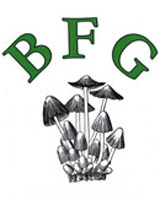Latin Masterlist Index
A B C D E F G H I J K L M N O P Q R S T U V W X Y Z
| G |
|
 |
Galerina ampullaceocystis (a rare species of Bell) Apr 18, 2023. In a very soggy part of the Mire near to some Pines at Burnham Beeches Penny came across this cluster of LBJs, recognised the genus and correctly assessed that identifying to species would probably cause problems! Once having confirmed the genus and ascertained that it had almost smooth almond-shaped quite narrow spores, cystidia on the gill edge with long very thin necks and a small blob on top, she spent several frustrating hours poring over available keys and literature without conclusion. However, sequencing has now shown it to be G. ampullaceocystis - a species of boggy areas such as this and often associating with Pine litter. We have just one previous record from similar habitat at Stoke Common, and there appear to be only 35 UK records. |
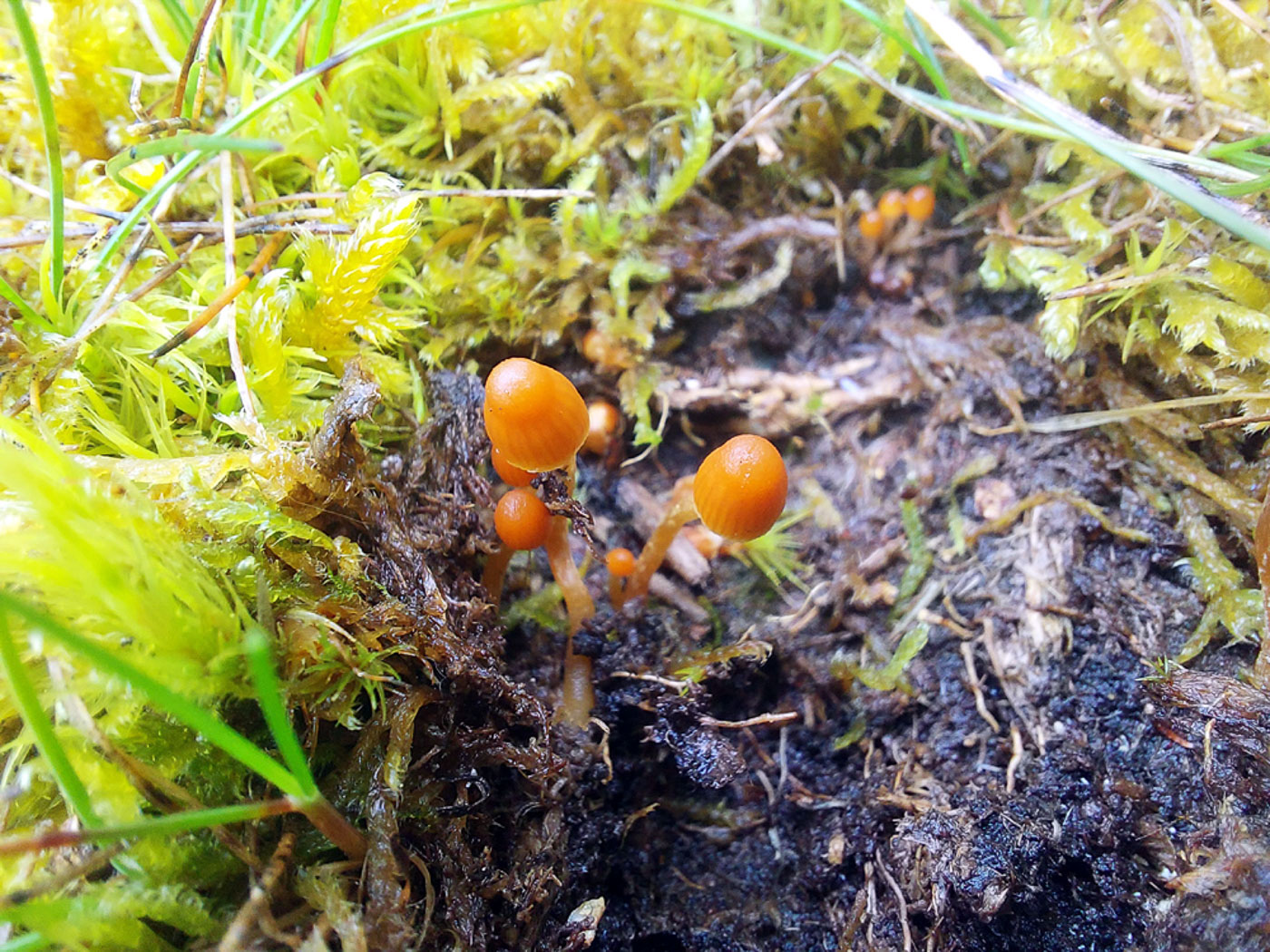 |
Galerina calyptrata (Veiled Bell) May 3, 2024. In a damp mossy patch at Burnham Beeches Jesper Launder noticed this little cluster, recognised the genus and took a specimen home to work on - always necessary with this genus which has many members, most of which look just like this! The microscopic characters were distinctive and led him straight to a couplet in the key with two similar species difficult to split.He plumped for the rare G. cerina but when dried and sequenced it was confirmed as G. calyptrata, the alternative in the couplet! Not so rare but still a nice find with only one previous county record. This a new entry for Finds. |
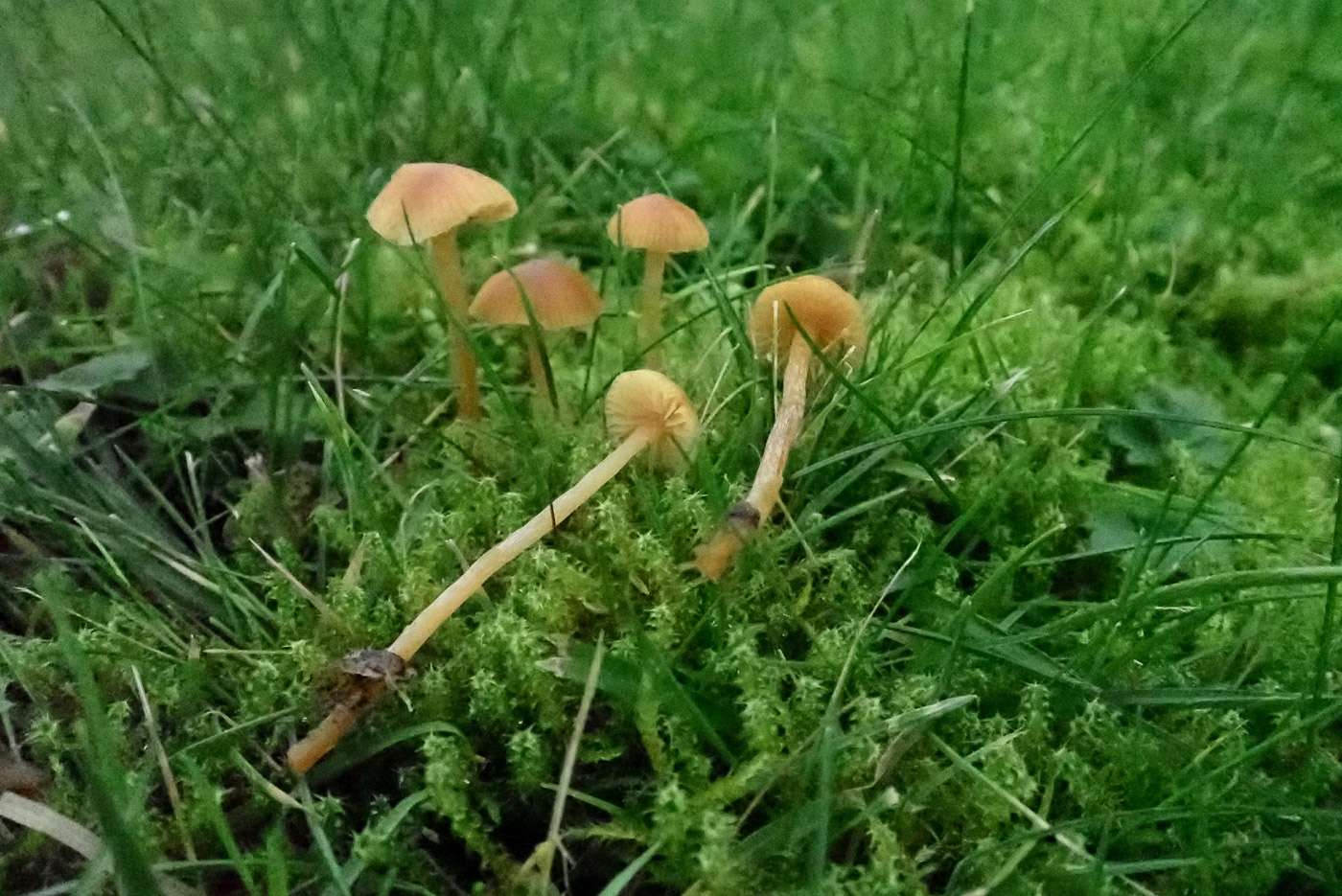
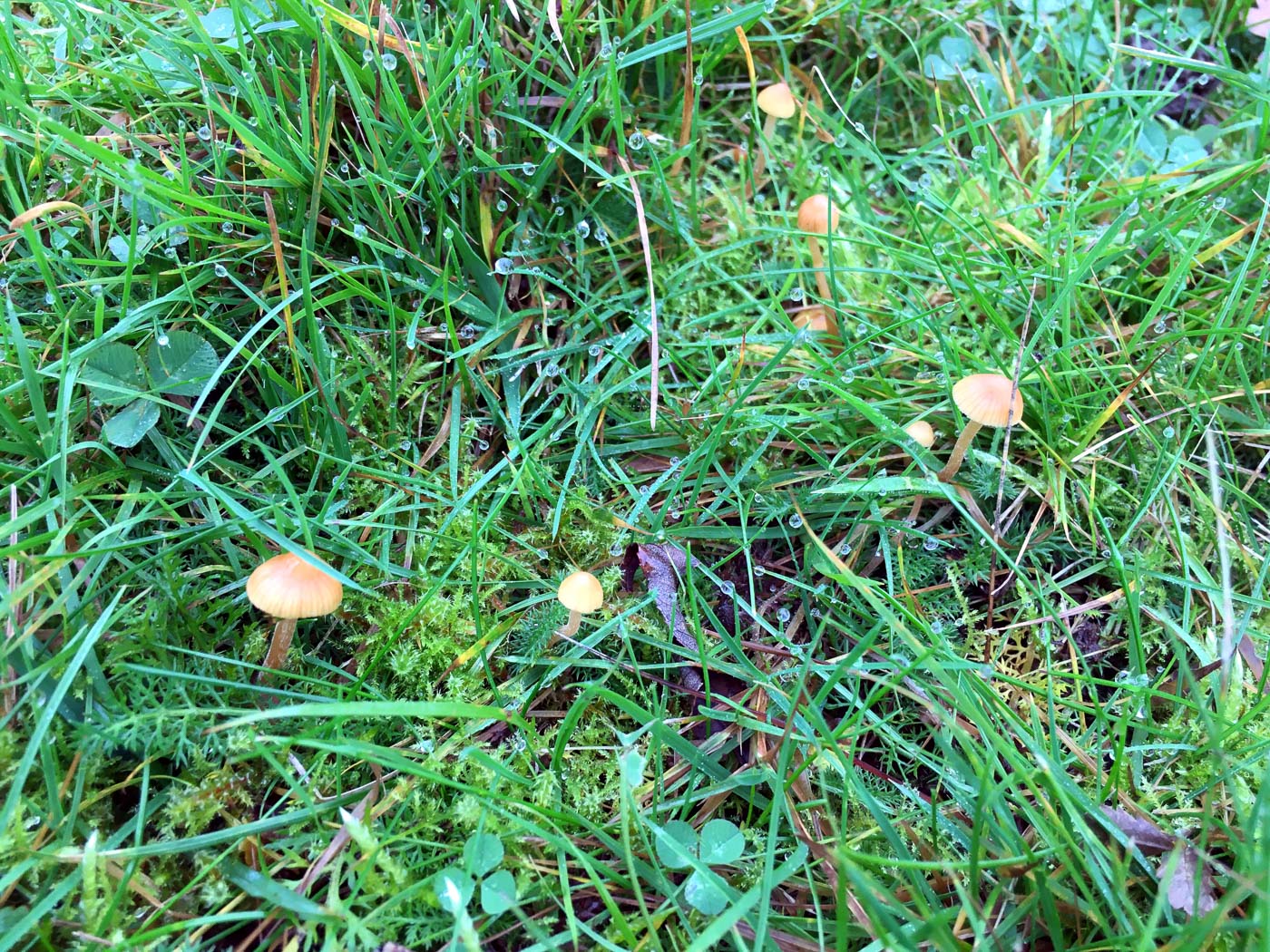 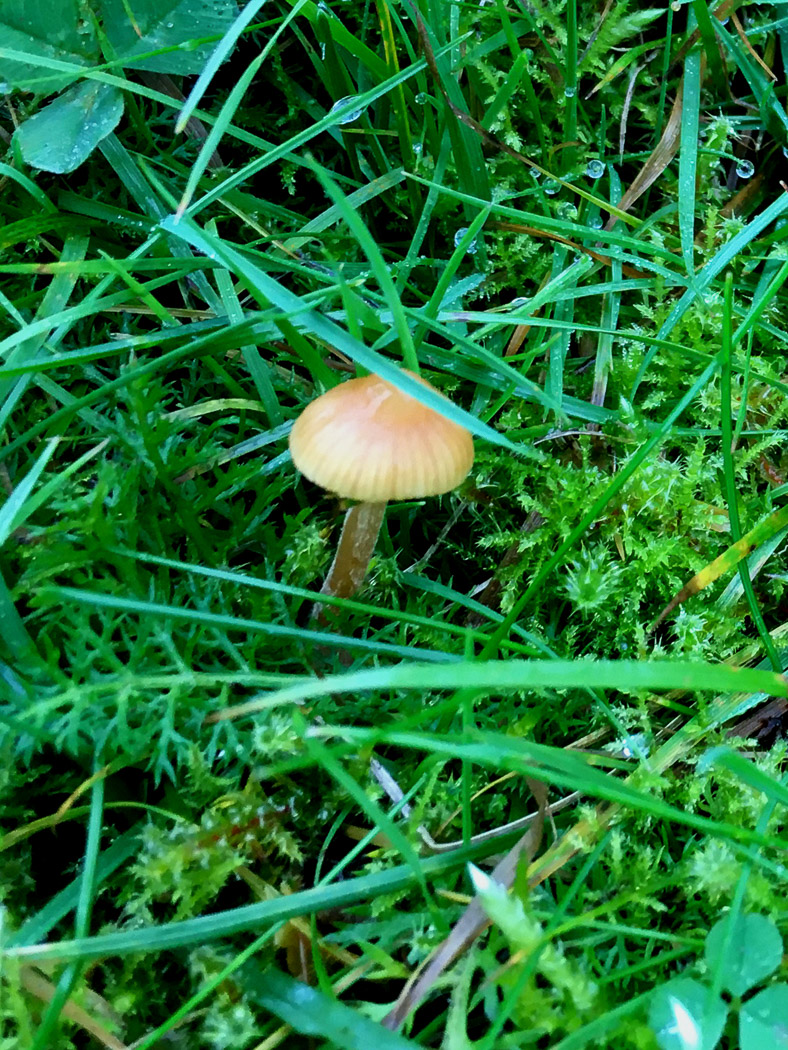
|
Galerina clavata (Ribbed Bell) Dec 30, 2021. In Bradenham Churchyard Penny found several clumps of this common Bell species, often found in grassy mossy places. Very similar to Mycena in stature, the genus is separated in the field by having pale rust coloured gills and spores rather than white and also often having translucent orange rusty bell shaped caps as here. The genus virtually always needs work at home with a scope as there are many species which look extremely similar - typical LBJs! Today's species is one of the commonest grassland species though it is late in the season to be finding them. Nov 29, 2020. Russell Ness found this dainty collection of Bells in mossy grass at Burnham Beeches. There are many Bells about in grassland at the moment - typical palish LBJs, but they always need keying out using a scope to name to species. This is one of the commonest species but its worth noting that despite its common name many other Bells display the translucent 'ribbing' effect on the cap (seen in photo 2), so this is not a character one can rely on in the field. |
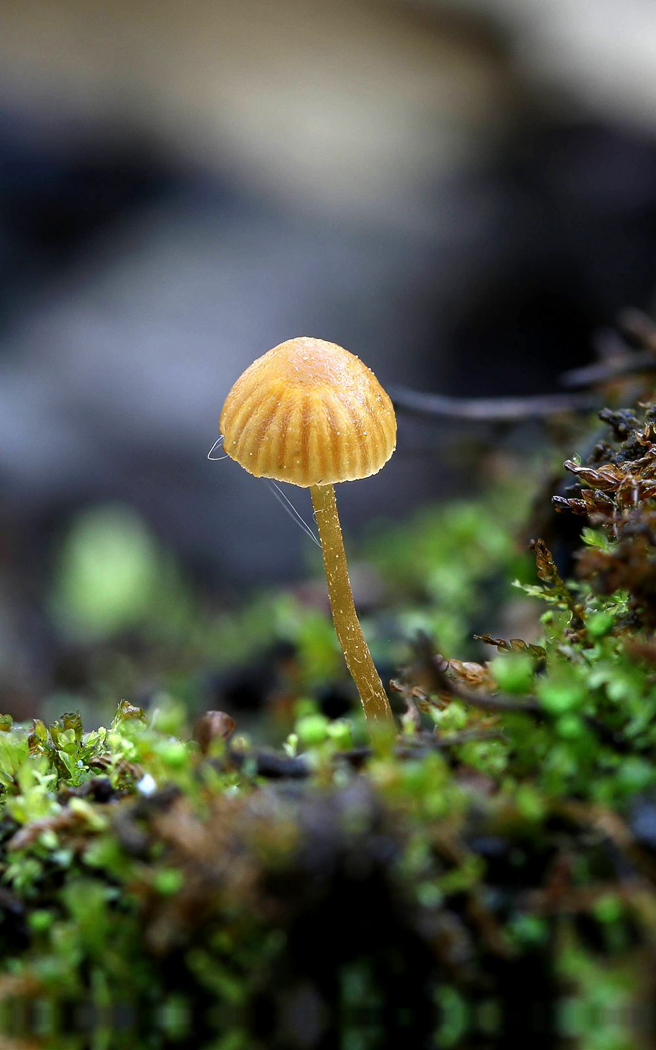 |
Galerina hypnorum (Moss Bell) May 19, 2021. At Burnham Beeches Kerry Robinson found and named this small mushroom growing on a damp mossy bank in the Mire (later confirmed by Derek at home). A sizeable genus of LBJs, Galerina always needs checking with a scope as many species are similarly bell-shaped, pale orange fawn and often slightly fluted with almost transparent thin fleshed caps - also easily confused in the field with Conocybe or even Tubaria. Today's species is one of the commonest and tends to associate with moss either on wood or soil. (Photo Claudi Soler) |

 |
Galerina lacustris (a rare species of Bell with no common name) Oct 31, 2022. On woody debris of Willow in a boggy area at Stampwell Farm Jackie Ewan found this cluster and, having collected it from this spot last year when it was subsequently identified through sequencing, she realised what it might be and checked the microscopy. So this is the second county record. Nov 9, 2021. At Stampwell Farm on woody remains of Willow in a dried up pond Jackie Ewan found this Galerina and attempted to name it but with limited resources. As the genus is one of the trickiest to identify, Penny decided to send it for sequencing with the result that we now have a Galerina not only new to the county but one with extremely few national records. The species is illustrated in Kibby vol. 3 but there seems to be confusion as to its correct name: either G. permixta or G. lacustris. For now we follow Kibby until this is resolved. This is our first exciting DNA result since the introduction of our Science Fund funded by BFG members' donations. |


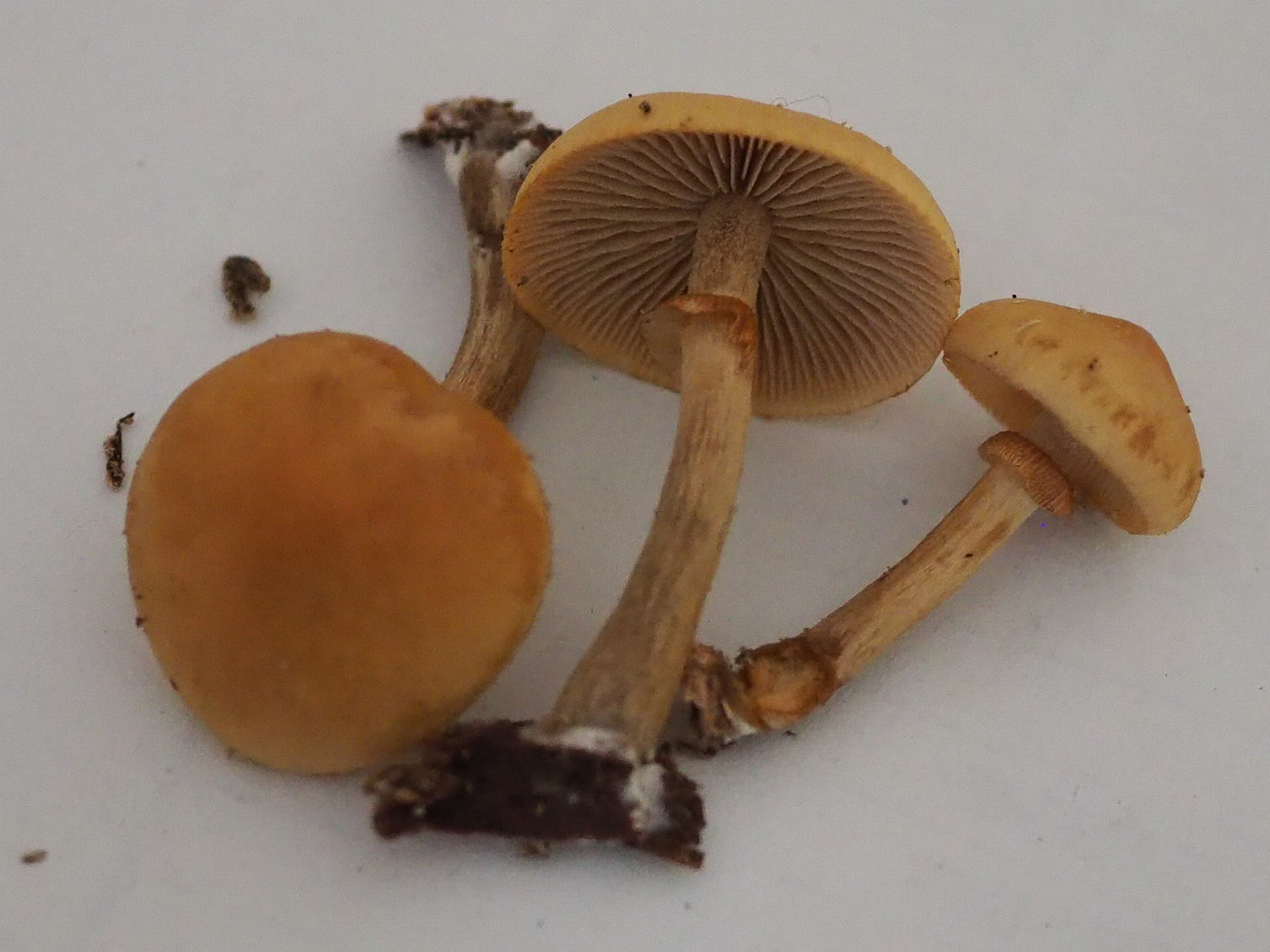
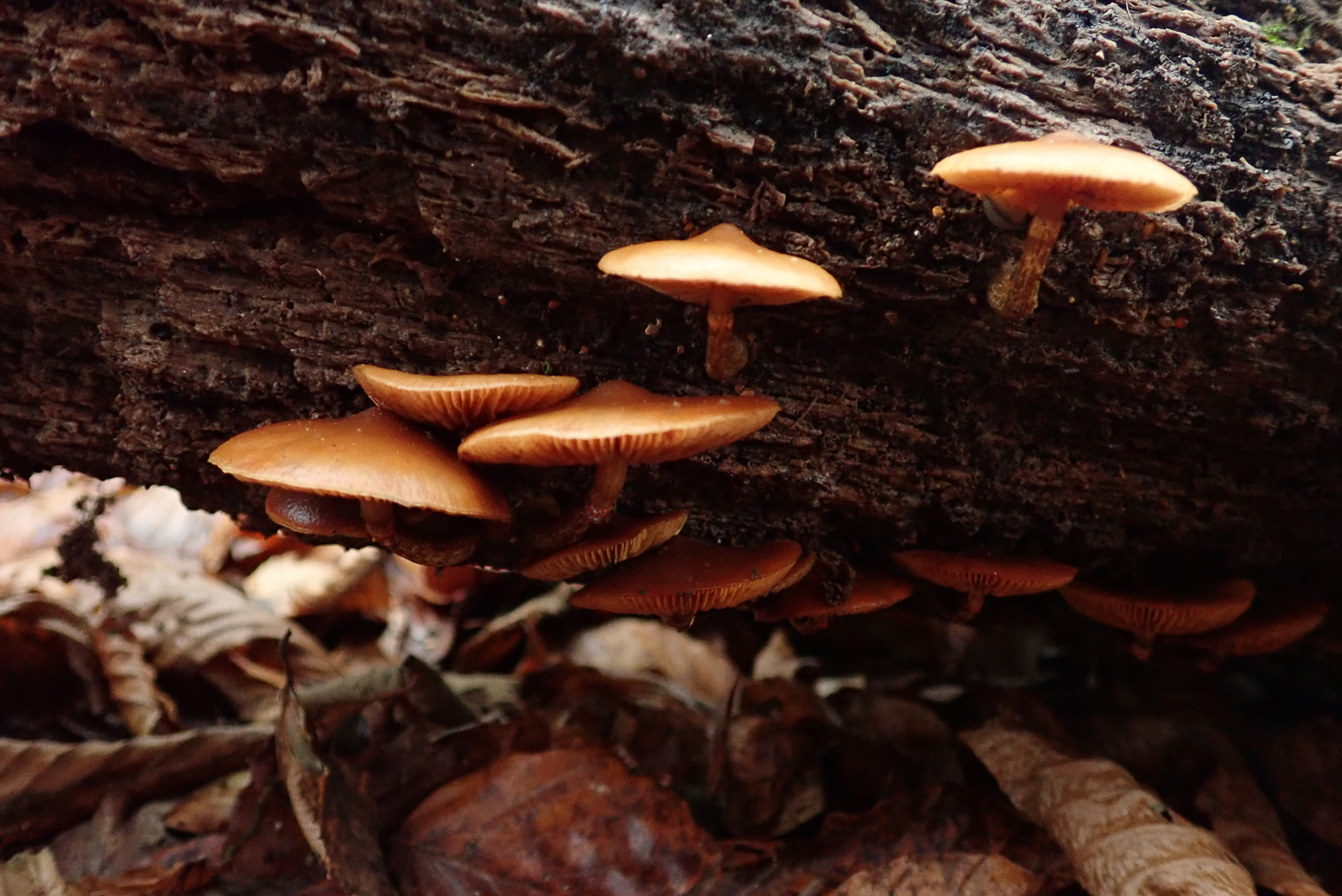
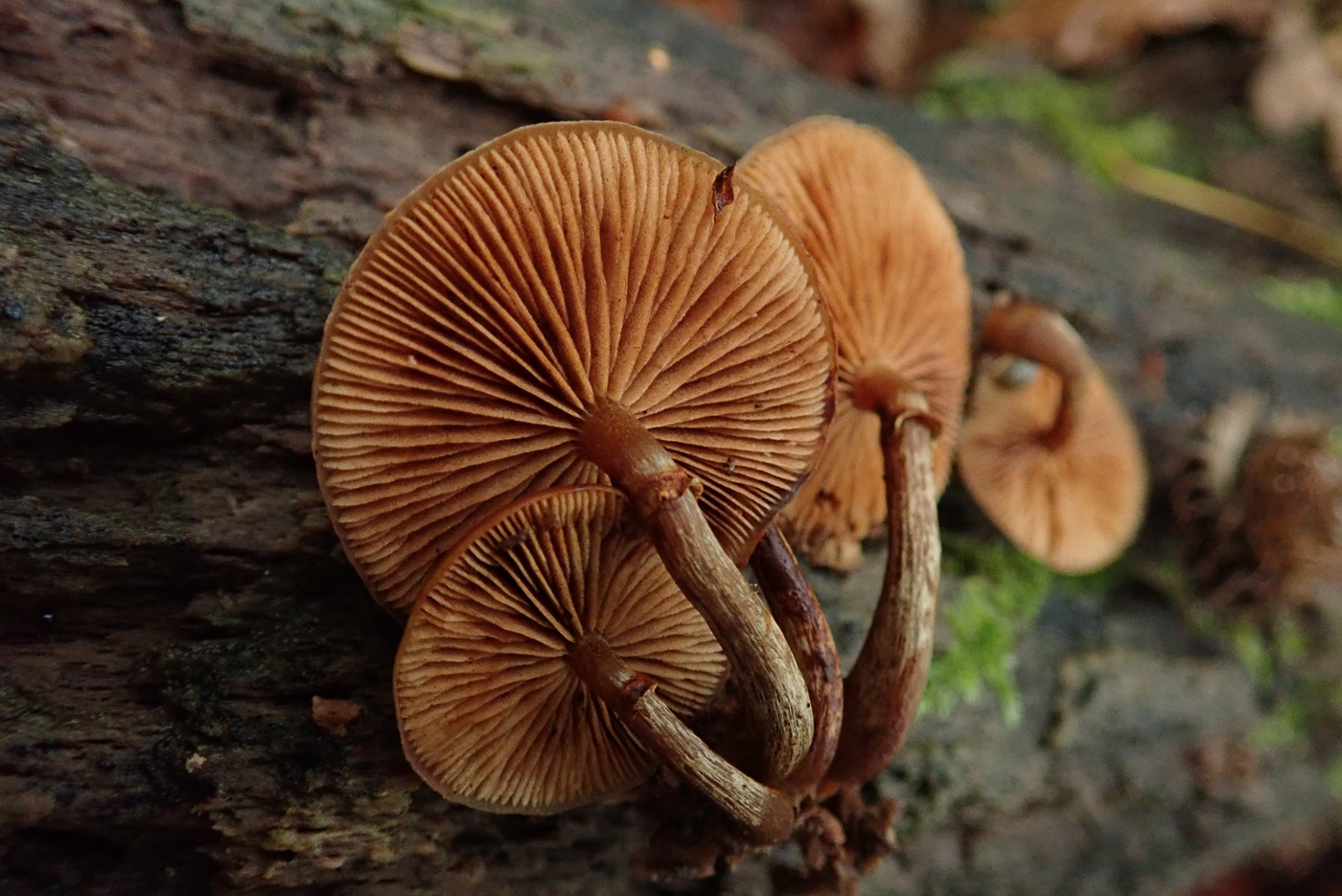
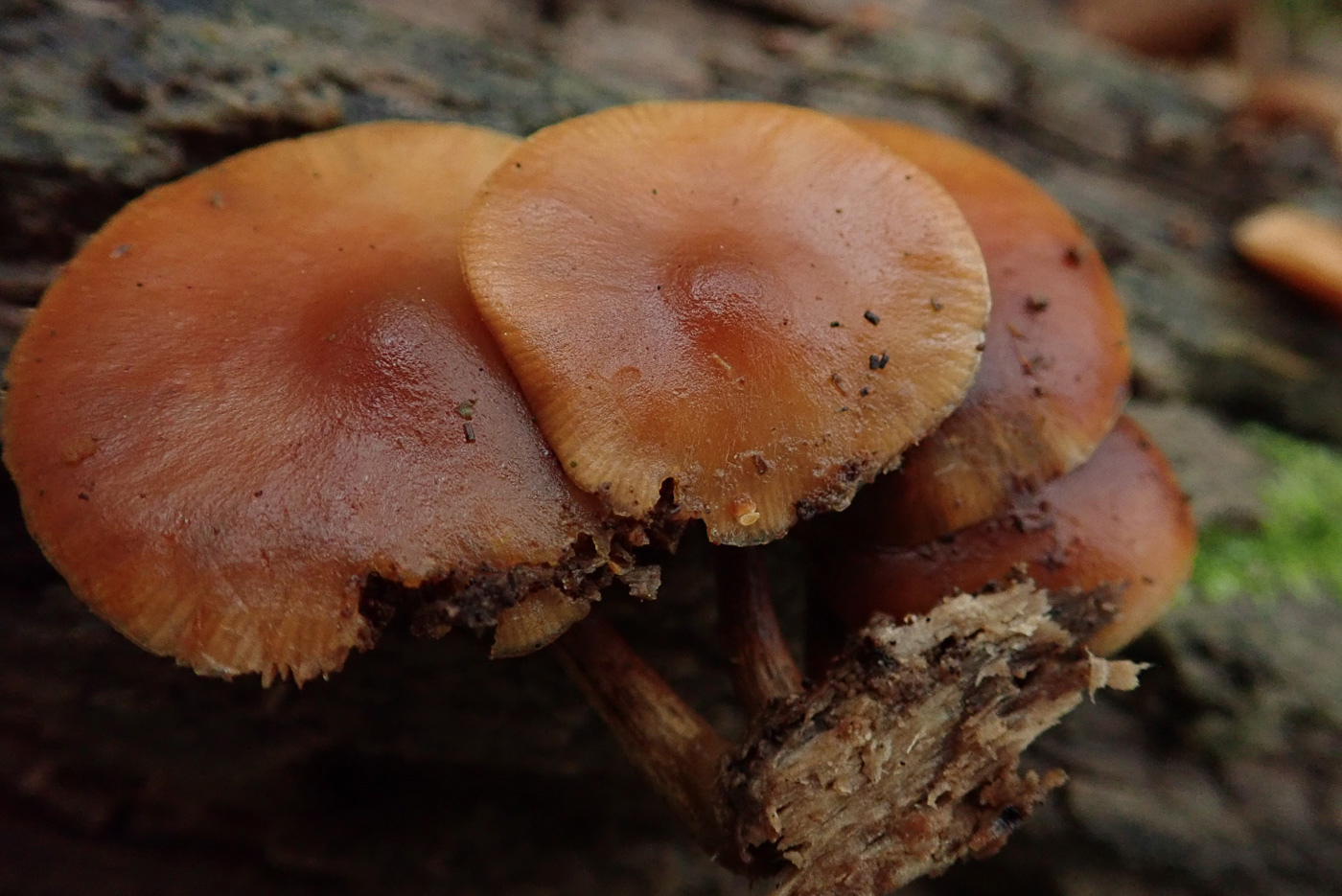
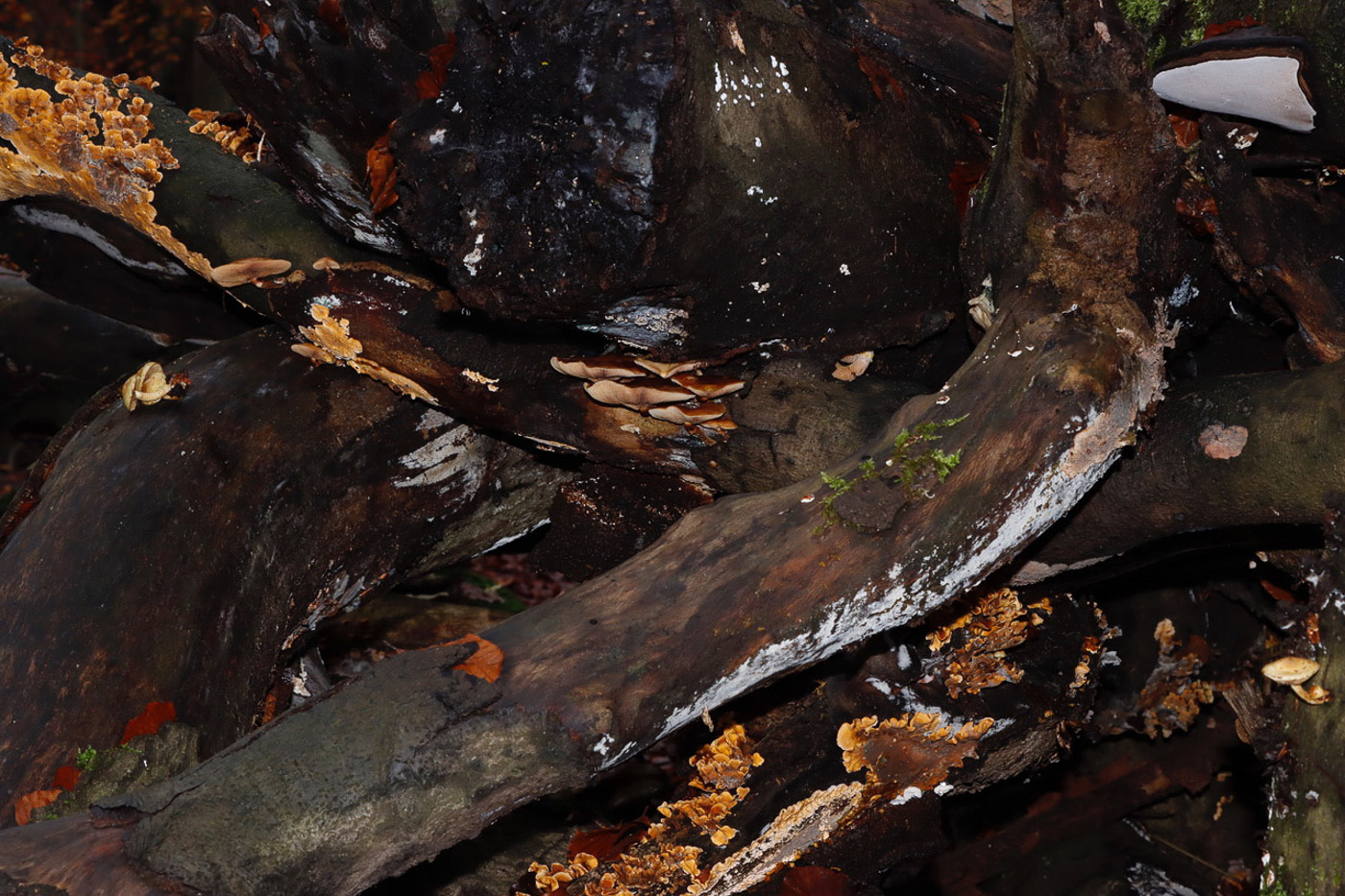
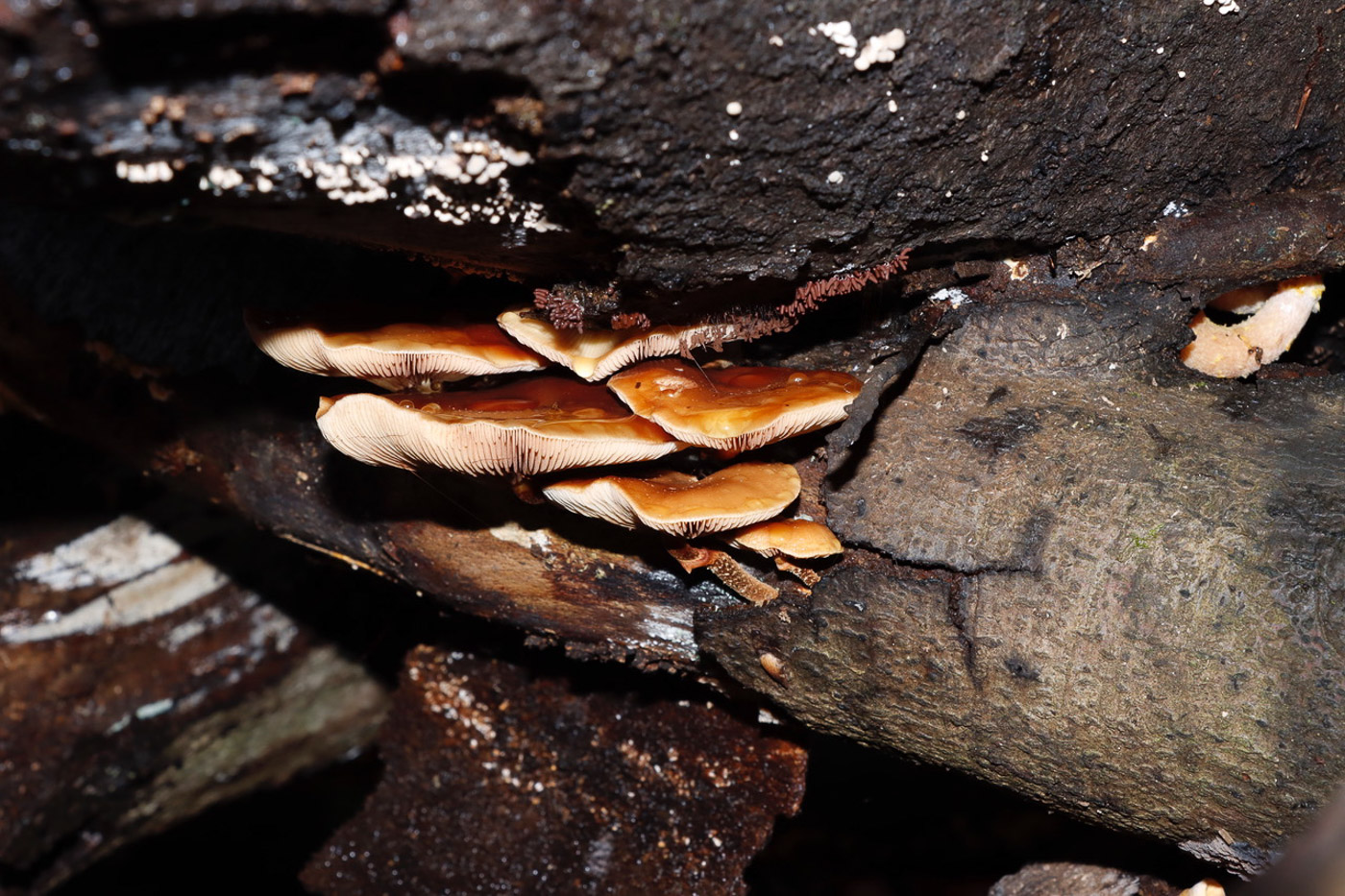
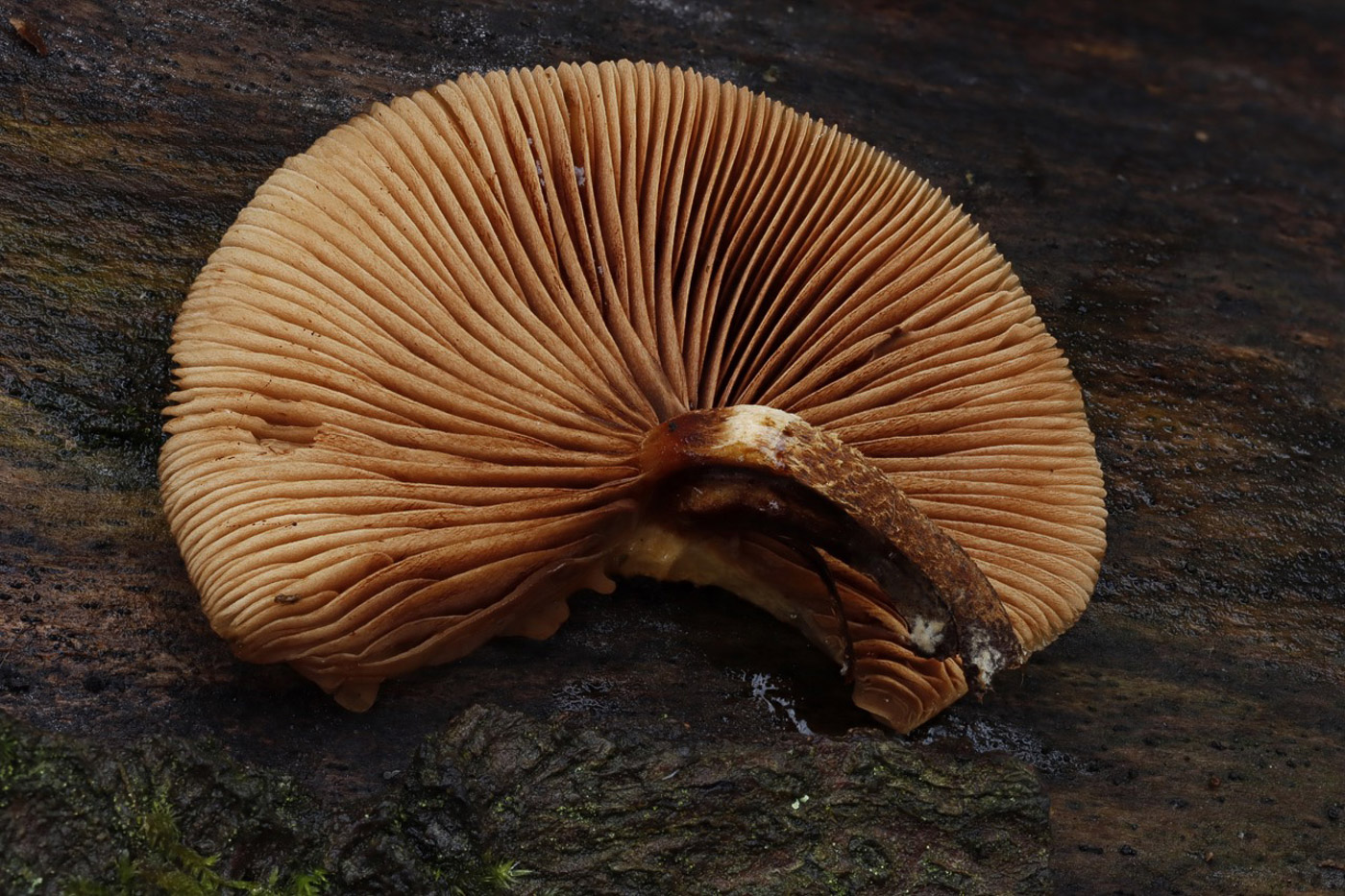
|
Galerina marginata (Funeral Bell) Nov 8, 2023. In Mousells Wood a group of us found this species on several different fallen deciduous branches. It is considered a late season fruiter so is not surprisingly around at the moment. It is a typical LBJ, found often clustered on deciduous wood, and has a distinctive ring on the stem. As it's name suggests, it is extremely toxic. Sep 20, 2022. At Coombe Hill on fallen deciduous wood John and Lesley Catterson came across this typical cluster of fruitbodies - appropriately found the day after the funeral of Queen Elizabeth II. This is a large Galerina - most species are more Mycena-like, and fruits mainly later in the season - an older name for it was G. autumnalis, its common name refers to the fact that it is extremely poisonous. It can easily be mistaken for Kuehneromyces mutabilis (Sheathed Woodtuft and apparently edible but don't try it!) which also has a ring and grows clustered on fallen wood, though that species tends to develop a two-toned cap, fading to yellow in the centre. Nov 17, 2020. This is a late season species and we have an earlier collection dated Nov 11th but of a rather inaccessible collection. These today at Turville Heath, found by Penny C., were also rather awkwardly placed on a fallen Beech branch, but were able to be extricated to demonstrate the important features which make the species nameable in the field. The caps are about 3 cm across and shiny rusty brown, the gills are concolorous and the stem has a distinct ring. These features together with the late season fruiting on deciduous wood in tight clusters should make determination possible. Nov 11, 2020. Paul Goby somehow managed to spot and photograph this well hidden collection in a large pile of fallen Beech in Naphill Common.This quite common species of Bell ( |

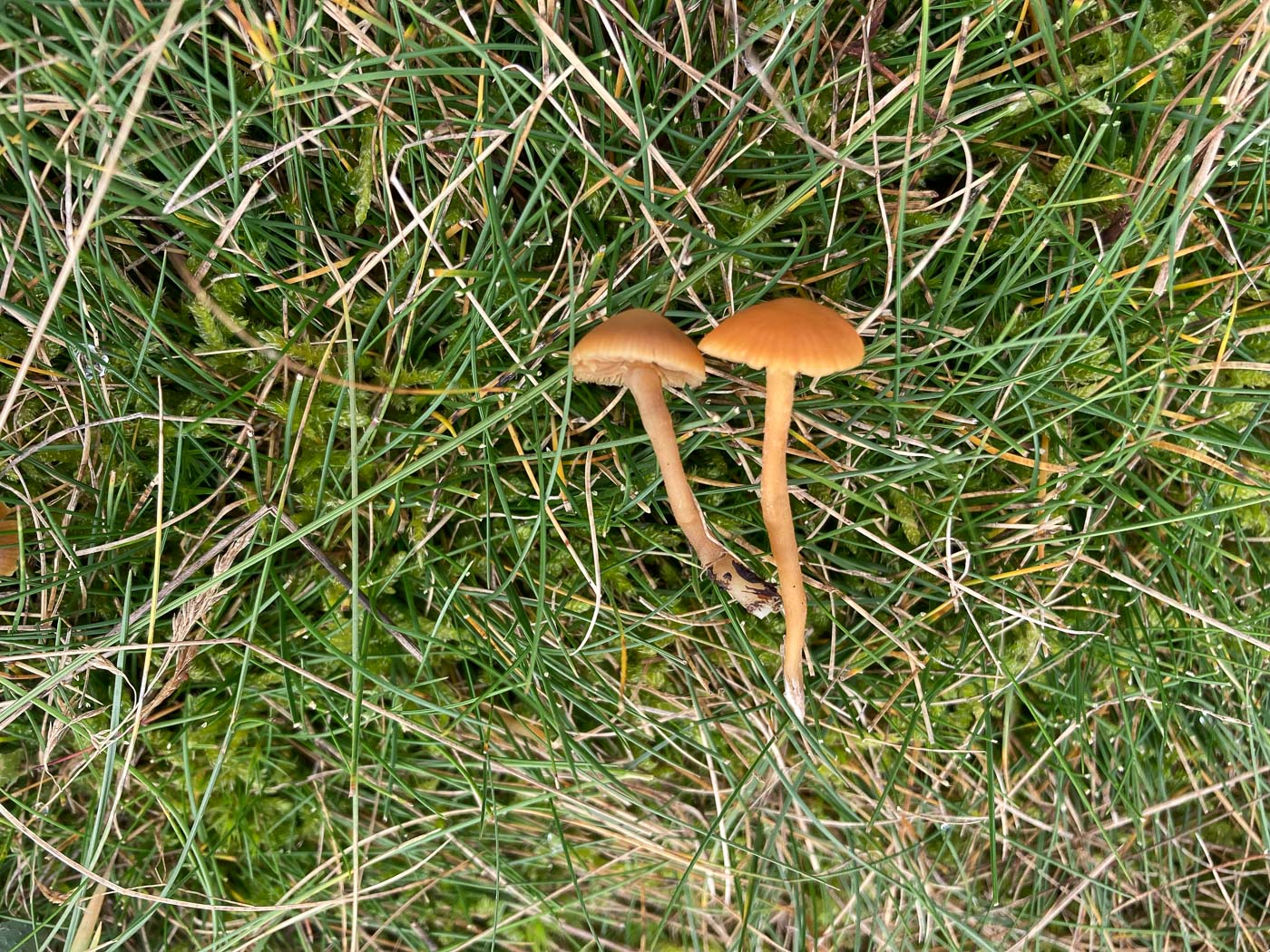
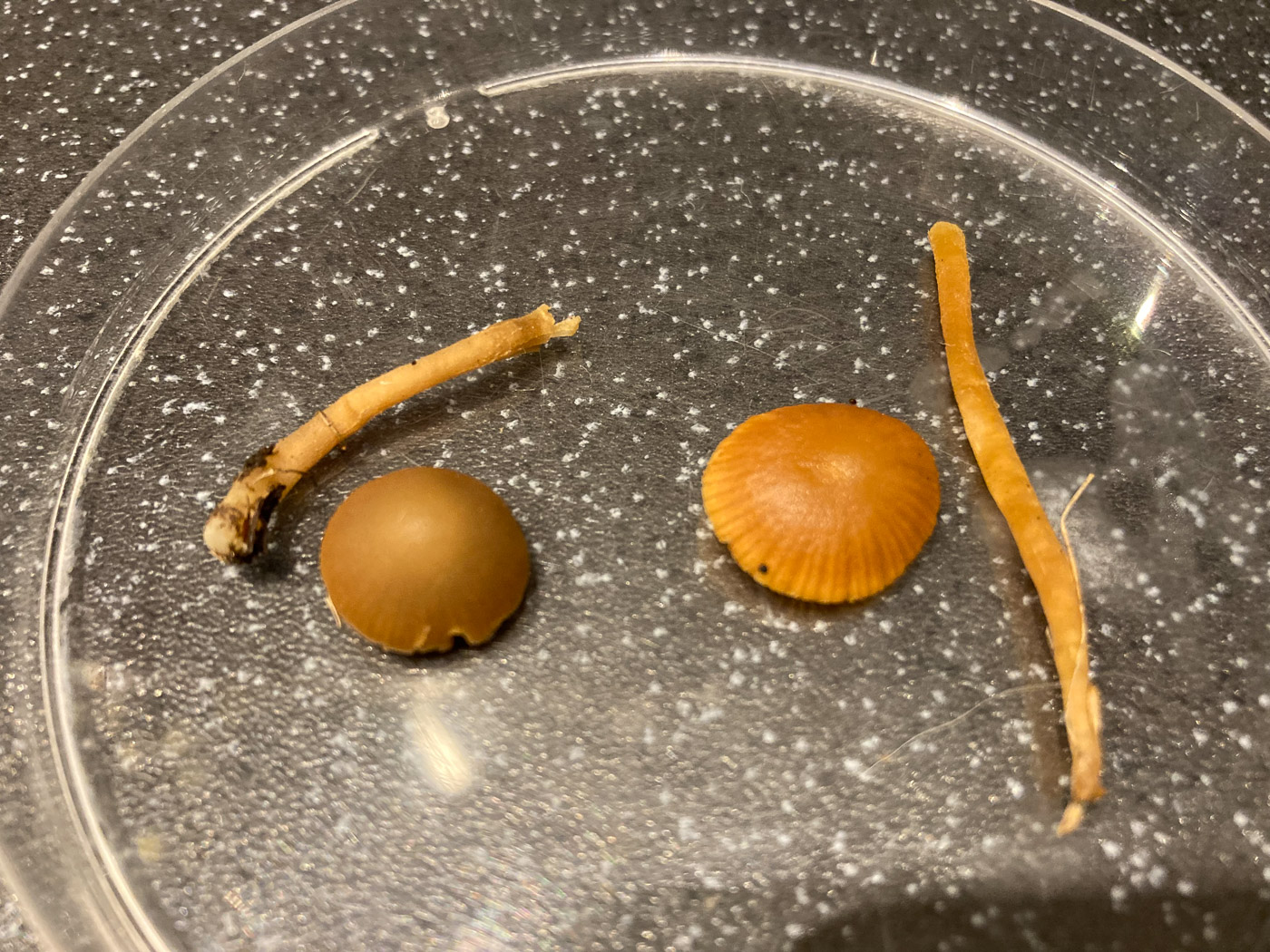 |
Galerina mniophila (no common name) and Galerina pumila (Dwarf Bell) Nov 2, 2023. In Stoke Poges Memorial Gardens Jesper Launder collected a few of these small Mycenoid mushrooms which were popping up in the grass and worked on them at home. The genus is large and most species look extremely similar - just like this one - so a scope and a complicated key is always necessary to name any collection to species. Though probably not at all rare, this appears to be only our third county record (the second was from nearby Stoke Common also ID by Jesper!), this probably reflecting the fact that those with enough skill to identify this genus will often walk past and ignore it in favour of easier and more eye-catching prey! Dec 12, 2021. Two for the price of one! In The Gore, Burnham, Russell Ness found these two Galerina specimens (typical LBJs) growing in acid grass, took their photo and collected them to work on at home assuming they were both the same. It was only later that he noticed how subtly different they looked, this confirmed by the different microscopy as well. The duller more olive tones of G. mniophila can be seen quite clearly on the left in both photos with G. pumila on the right appearing much brighter in tone and also more translucent. The spores of both are basically the same size but are different in both shade and shape, as are the gill cells. Both species appear to be new to the county though have good numbers of UK records and are not considered rare. Good detective work by Russell here! |
 |
Galerina cf pallida (a rare species of Bell with no common name) Apr 5, 2023. In Beech litter at Turville Heath Penny found these three very pale capped LBJs and took them home to work on. The details found under the scope revealed this was not a Conocybe as suspected but a Galerina with very pale rather small spores for the genus and a significantly hygrophanous cap. Keying out lead her to G. pallida - one with very few UK records, none from Bucks - but was not an exact fit, hence the doubt and the 'cf' here indicating close to but with some doubts. The collection will be dried for sequencing. |
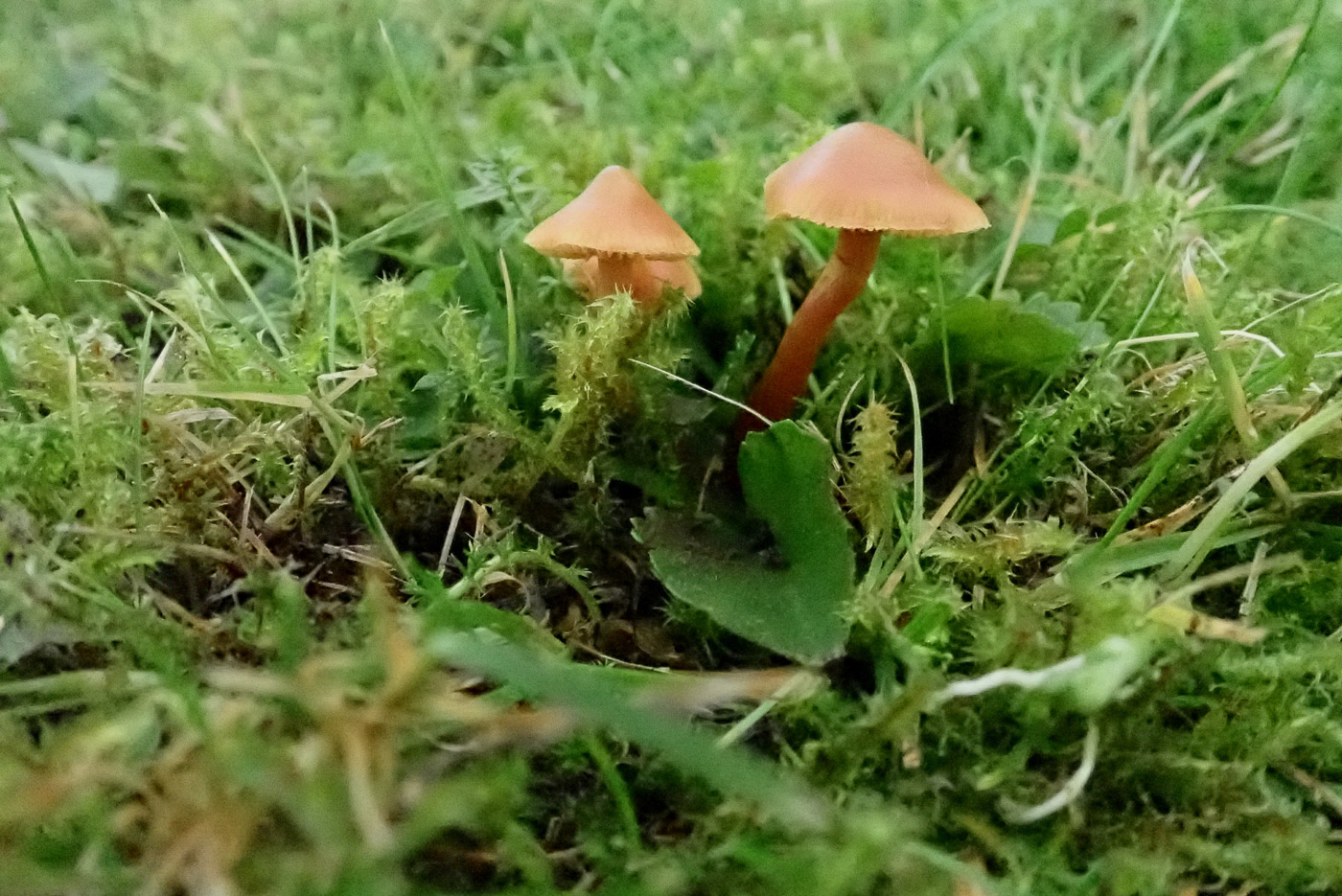
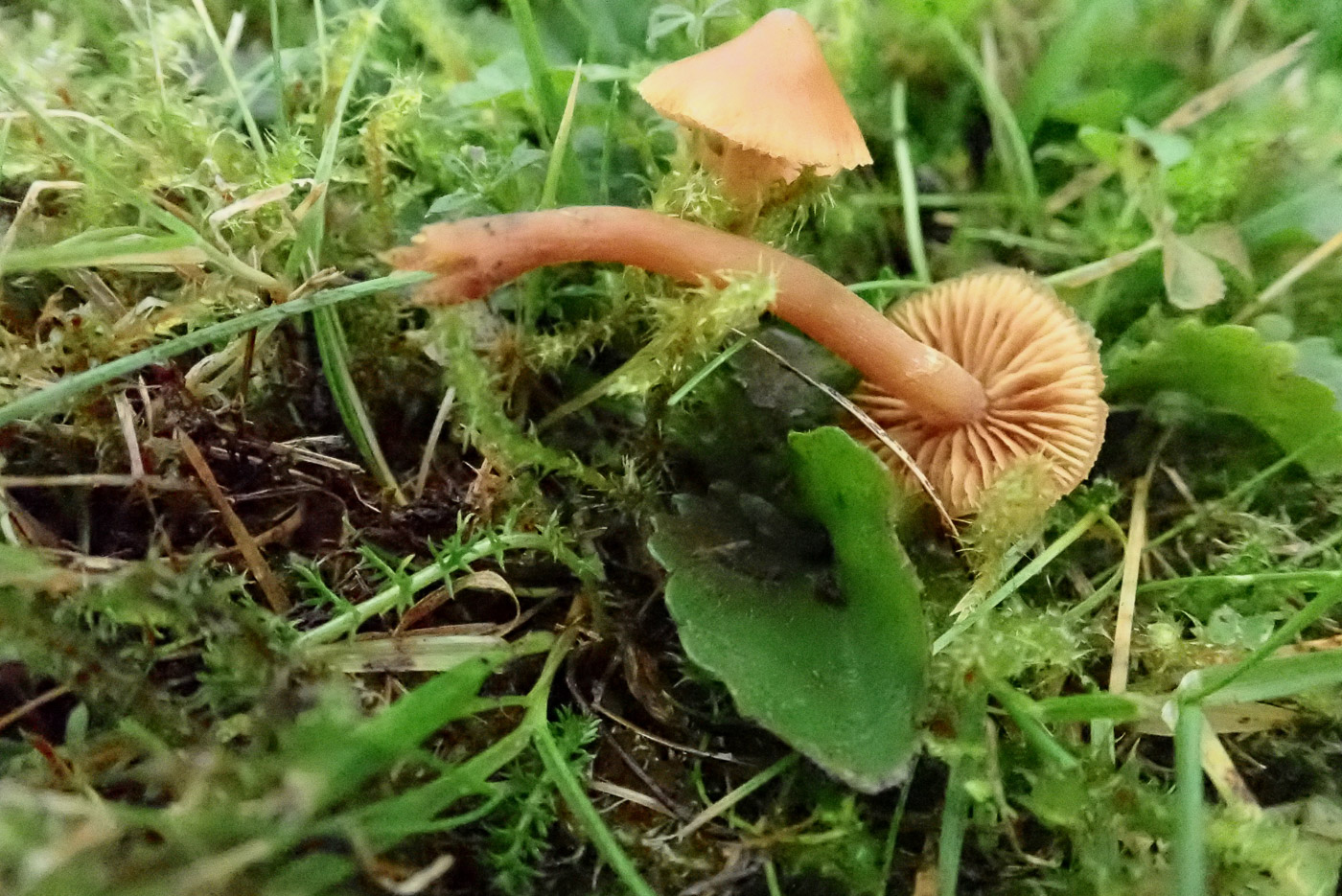 |
Galerina pseudomycenopsis (a rare species of Bell with no common name) Nov 18, 2021. In Bradenham Churchyard Penny noticed some small bright brown LBJs in short grass, took photos and collected them to work on at home. The microscopic characters together with the signs of ring zone on the stem led her to the lengthy keys for the genus Galerina and eventually to a name she'd never heard of! Doubting if the species was even British and therefore wondering where she'd gone wrong, she then discovered just 38 British records with one from 1926 from Penn Street (so presumably from the cricket pitch there) by the famous mycologist EJH Corner! The collection will be dried and sequenced to confirm. |
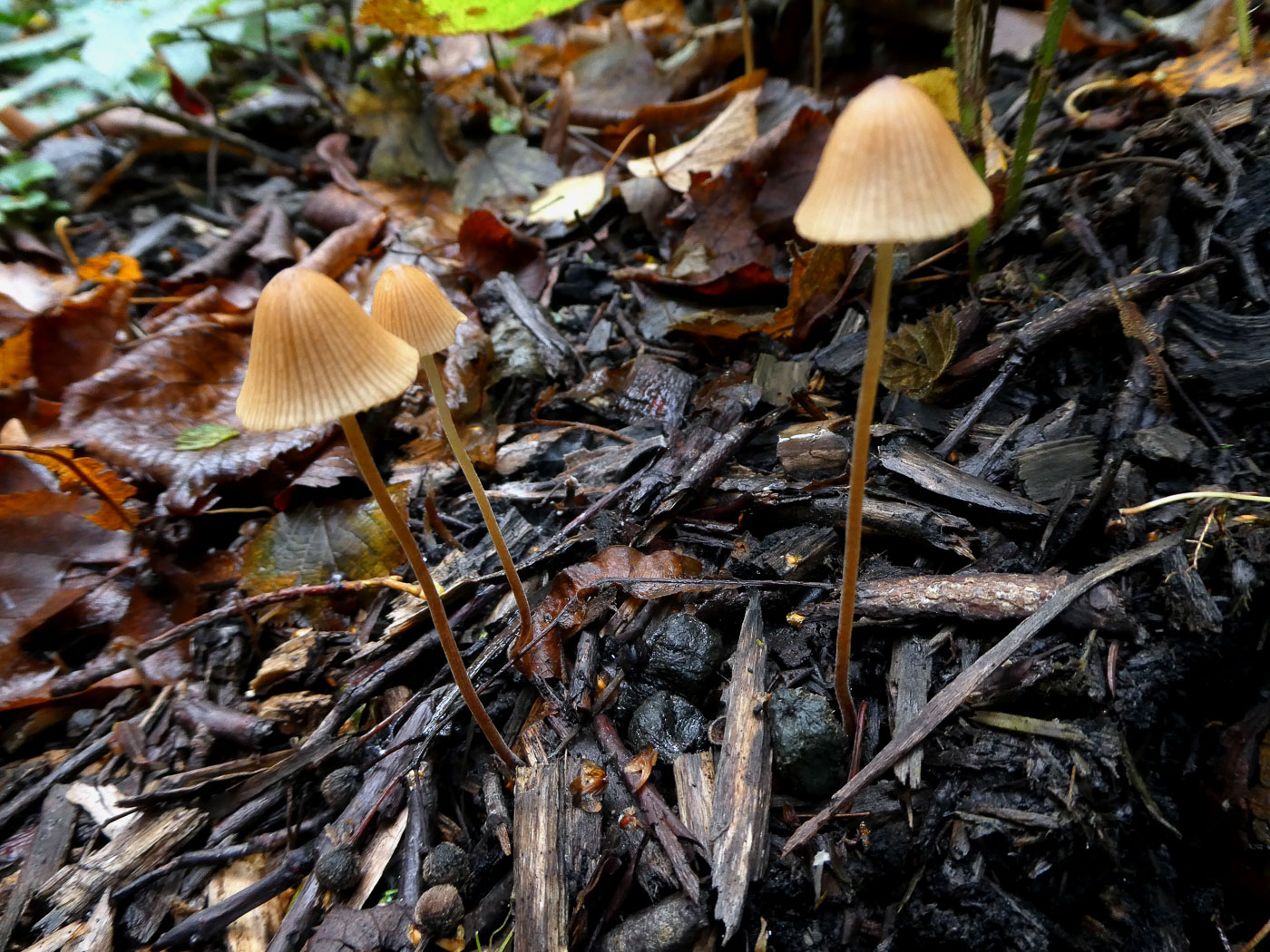
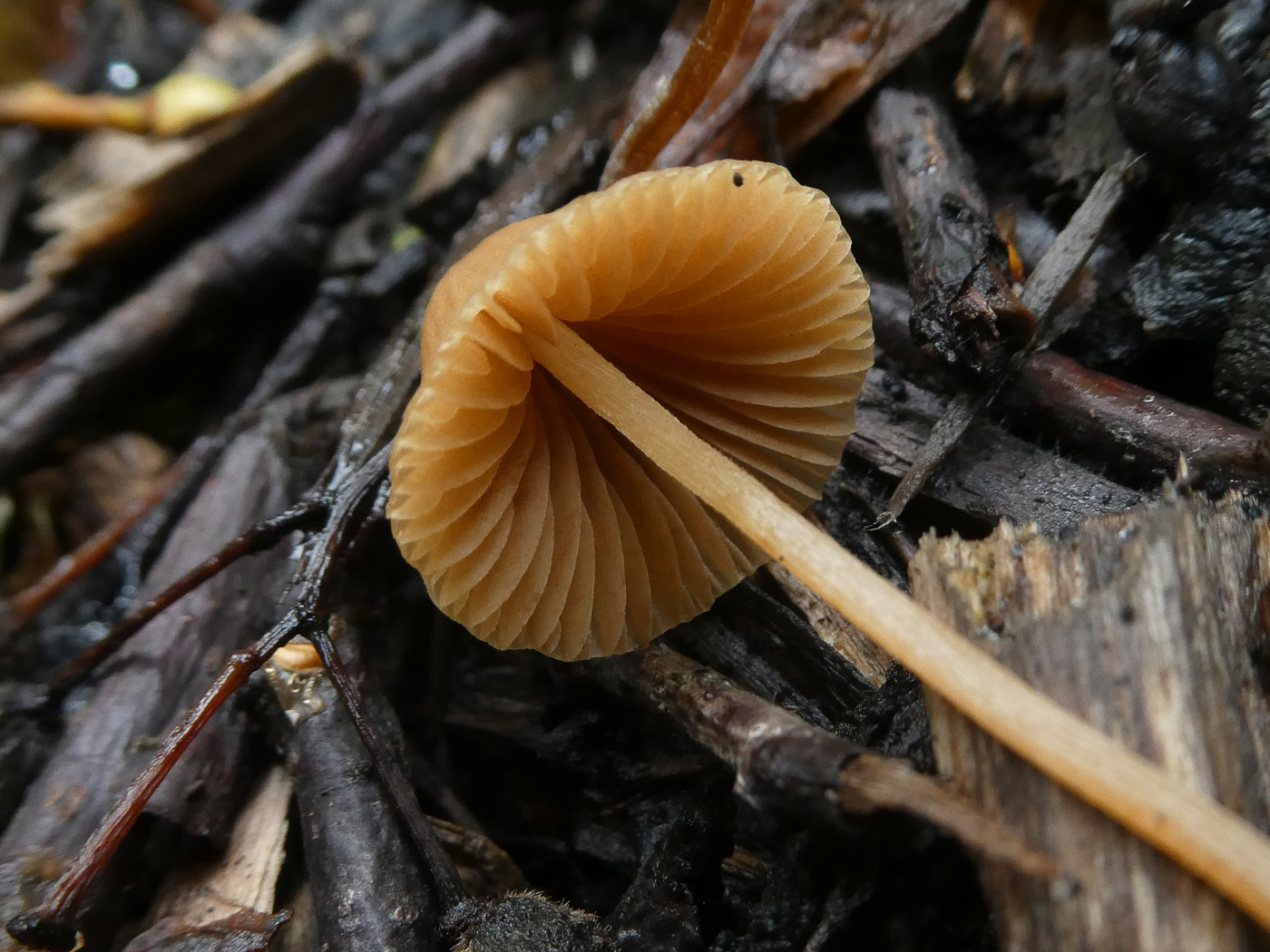
|
Galerina subclavata (a species of Bell) Oct 10, 2020. Penny Cullington only took a photo of this species to show an example of the genus, a typical LBJ (little brown job) and extremely similar to Conocybe (and Pholiotina - see photo dated Oct 08). Like a rusty smallish Mycena (Bonnet) and with rusty gills, not white as in Bonnets, the Bells tend to be very fragile with translucent slightly fluted caps and apart from one or two, they cannot be named to species without using a scope. They occur in many different habitats including grassland, on wood, in litter and most mycologists will recognise the genus and leave it at that. Today's species, just by chance, is not often recorded and we have just two previous county records. It was on the same mossy woodchip pile as our Pholiotina, dated Oct 08, in Turville Heath. |
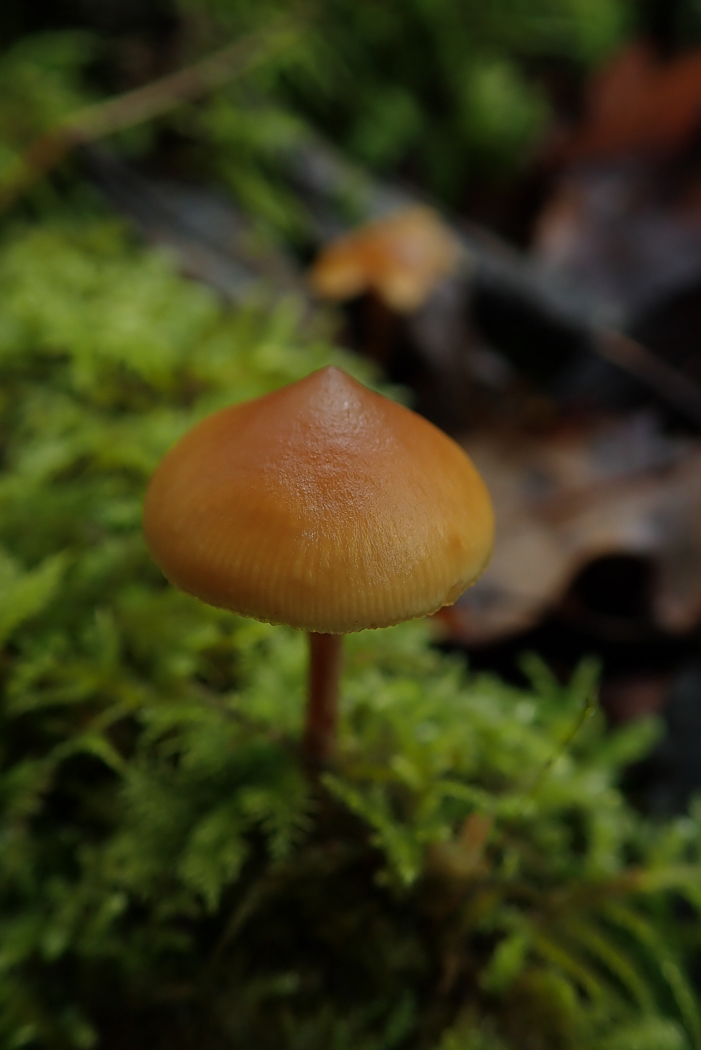
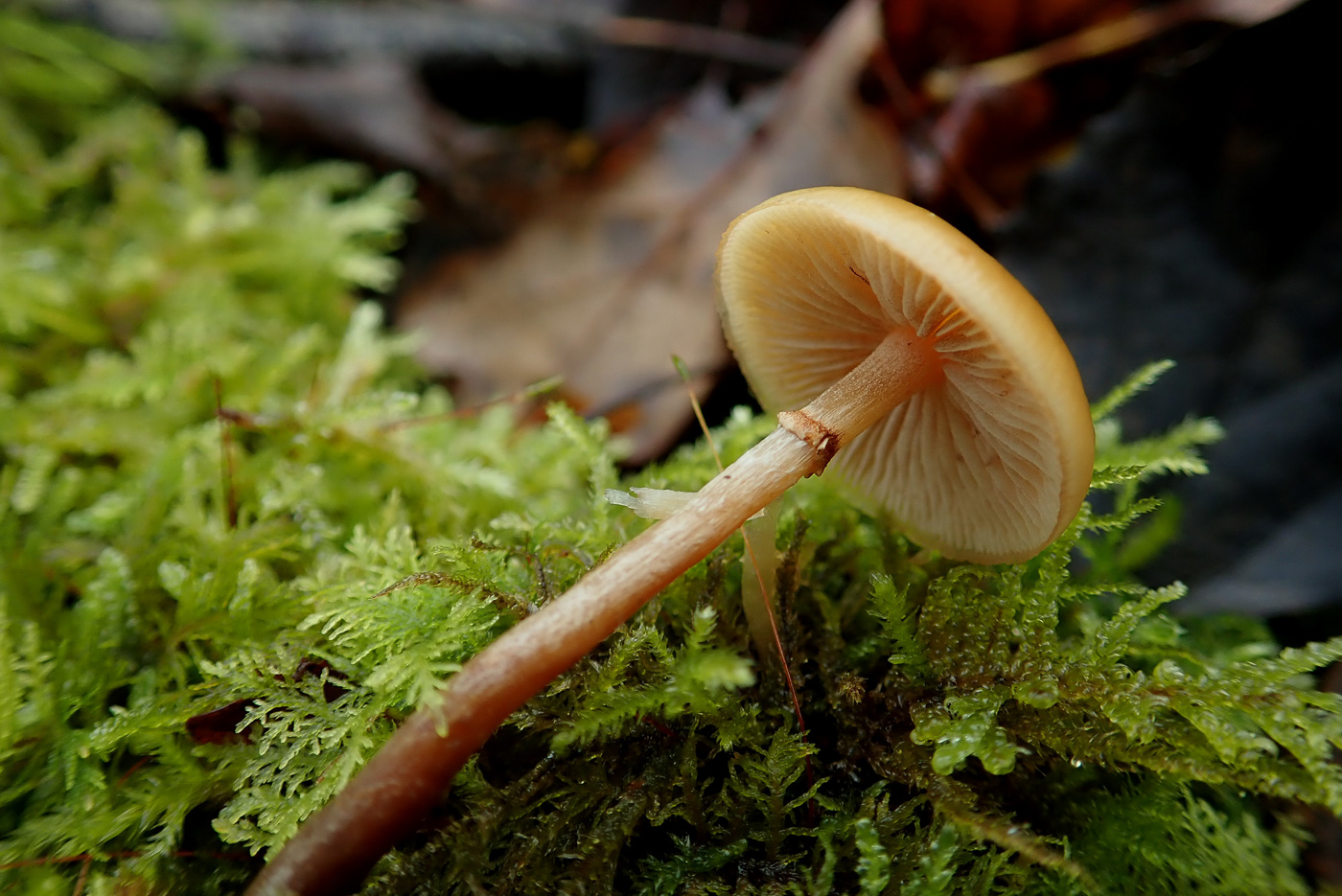 |
Galerina uncialis (a Bell with no common name) Nov 9, 2020. Penny C. found this singleton on a mossy log, probably Ash, in Rushbeds Wood. The cap was 2 cm across, umbonate, and stem about 4 cm long with a distinct ring, similar to that found in the common G. marginata which, however, grows in large numbers rather than singly and lacks an umbo. It took thought overnight and much work to sort out what this was, partly because the main key used gave the substrate as terrestrial causing me to pass it by. However, other sources gave mossy woody substrates as well as soil, and once I'd realised this everything else fitted like a glove including all microscopic details. This is new to the county and has very few British records. |
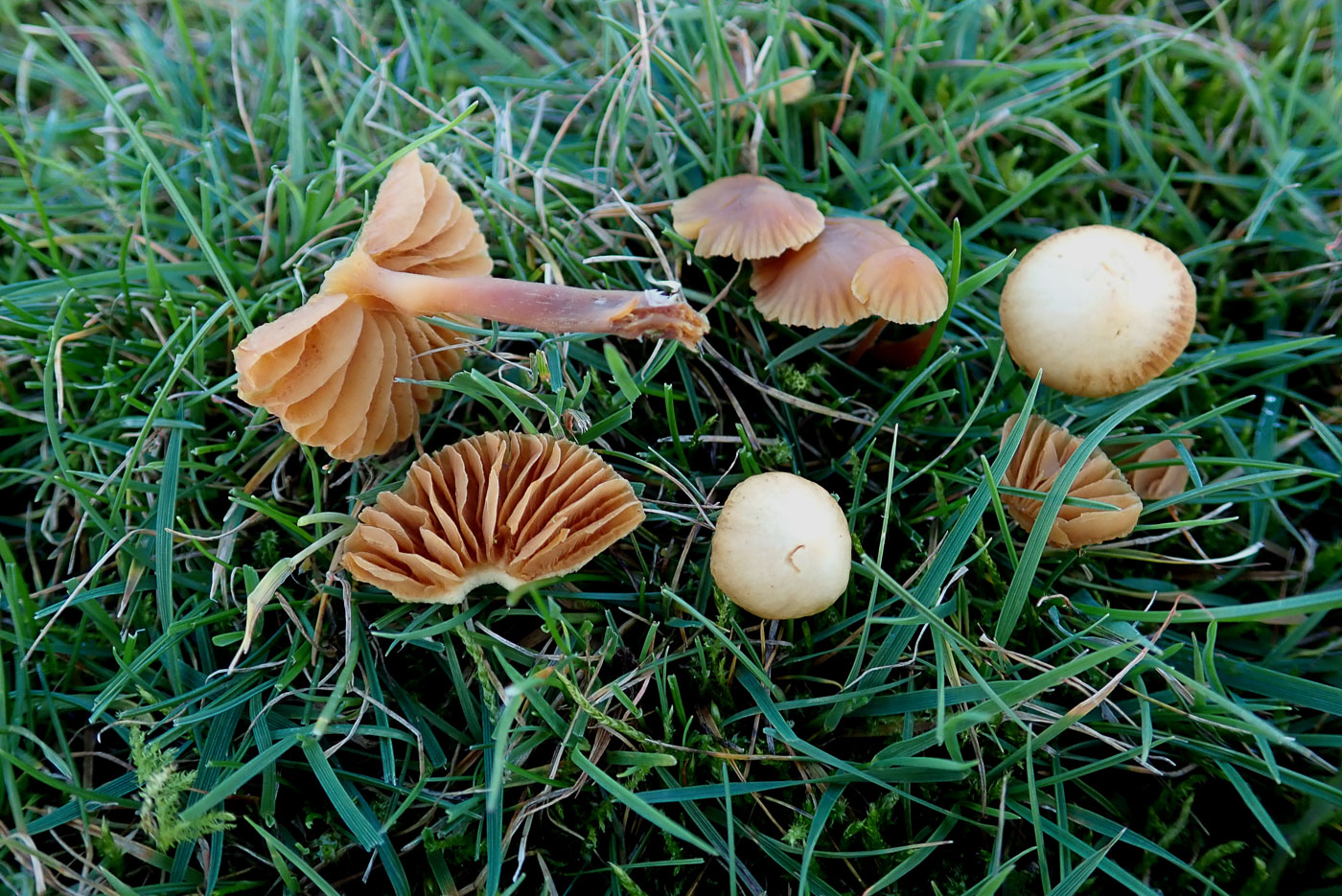 |
Galerina vittiformis (Hairy Leg Bell) Nov 12, 2020. Now the main fruiting season is clearly winding down, there's time to look at more LBJ types which still seem to be around. On the cricket pitch at Ibstone Common Penny C. found plenty of these pale rusty LBJs, some typically very faded despite the recent rain. This genus always needs to be identified with a scope because there are very many different species, most of which look exactly like today's collection! Not all are grassland species, however, and some are found in woodland either on soil or on fallen wood according to species. Today's species is one of the commonest on lawns and shortish grass and keyed out quite easily. |
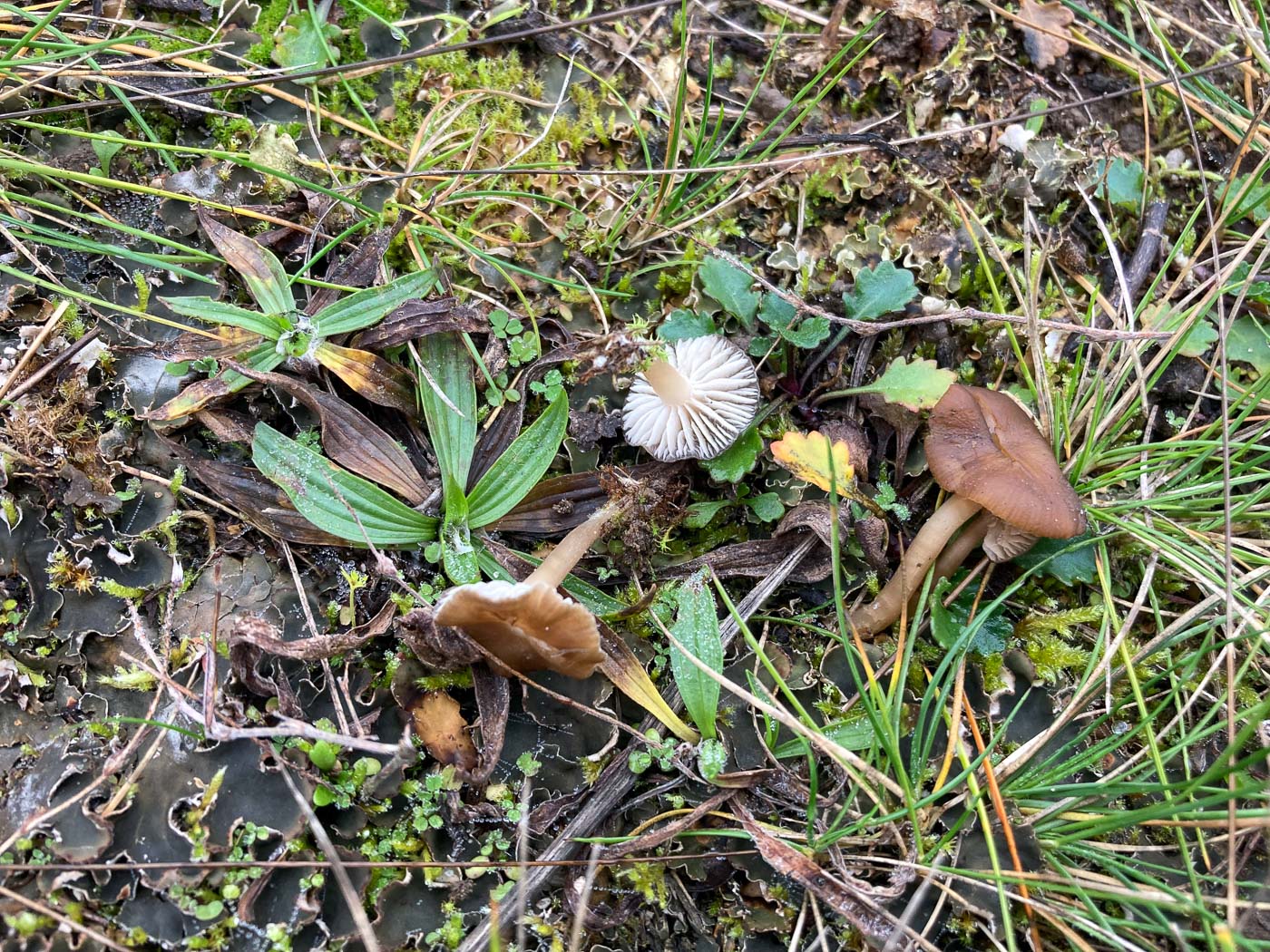
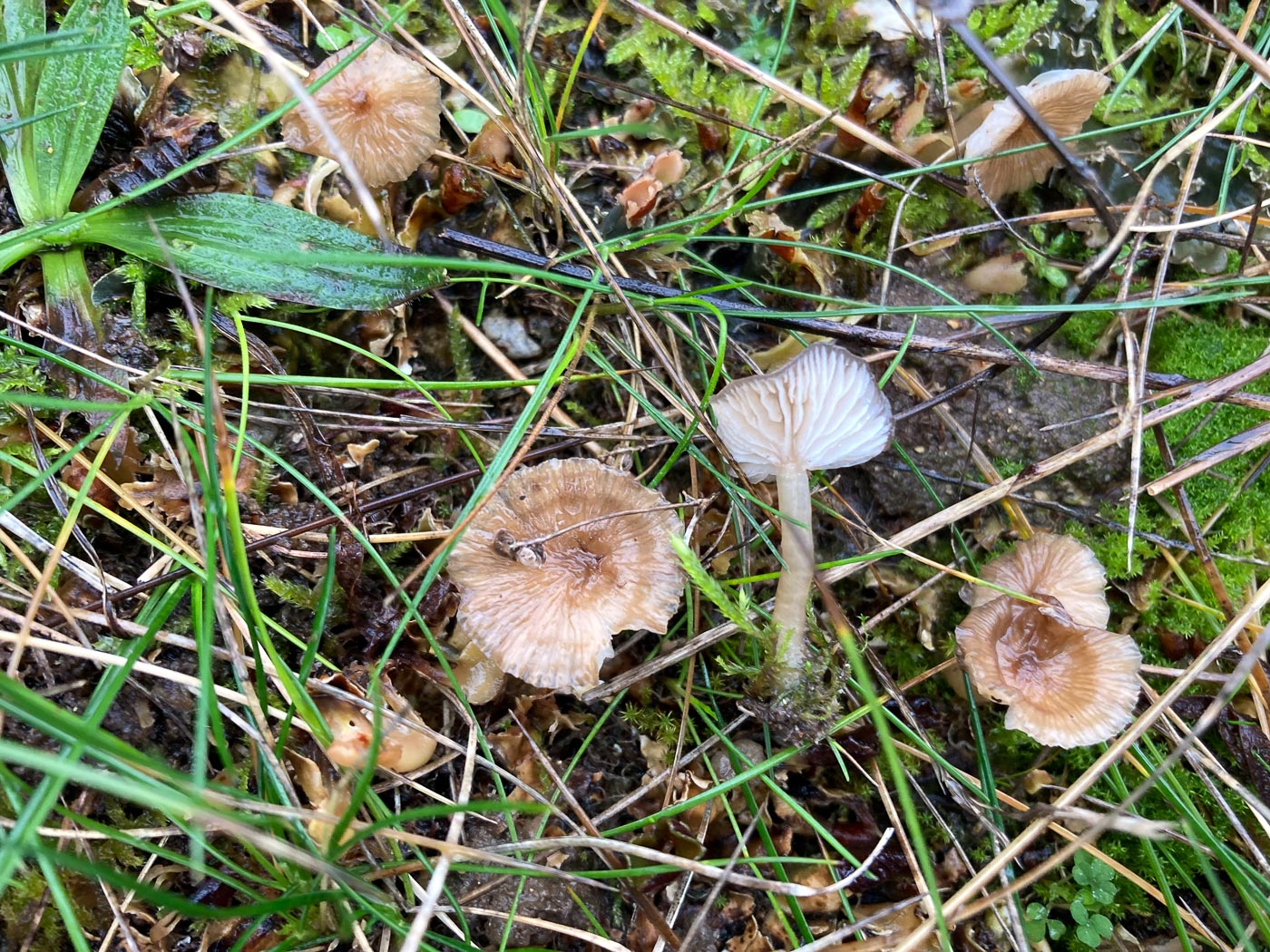
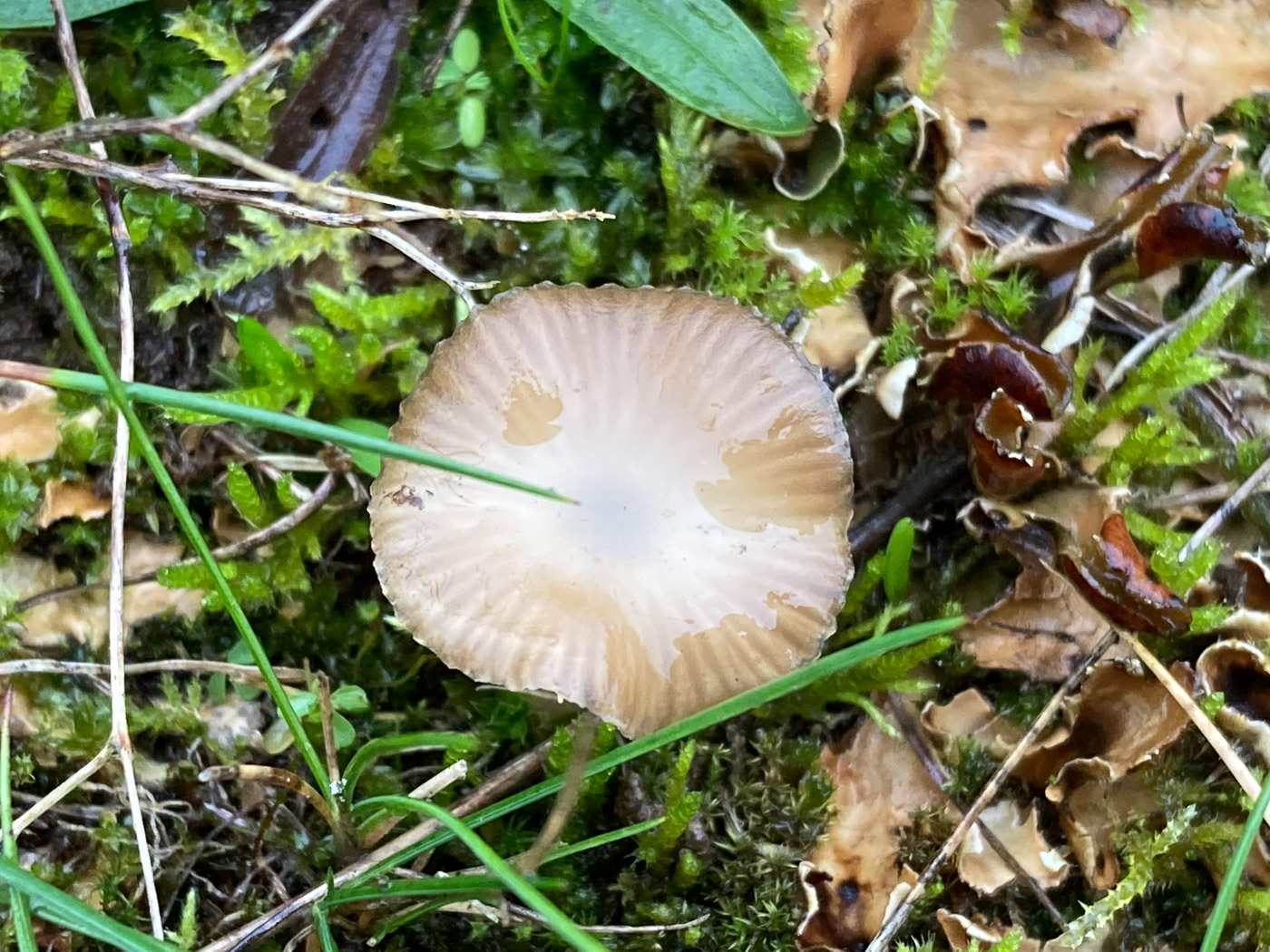 |
Gamundia striatula (Lined Meadowcap) Jan 8, 2022. In December at Dorney Wetlands Russell Ness found some interesting little mushrooms growing amongst gravelly moss and dog lichen. Working on them later he concluded they were probably this species but could not see the tiny spines on the spores necessary to confirm the identification. Finding the species again today he tried again and this time with success: viewing them x 1000 in KOH did the trick! Photo 1 is of his December collection, photos 2 and 3 are today's. This is a rare little LBJ, not often recorded and a first for the county, so an exciting find. |

 |
Ganoderma applanatum (Artist's bracket) Jul 10, 2023. In Gerrards Cross Common Jim Wills found this bracket at the base of a standing Birch - a timely find giving us the opportunity to compare two closely related species which appear more or less identical in the field (see below also). Jim looked for but did not find the fly galls (crusty dark lumps) which form on the lower surface of this species (but not on G. australe) when infected by the Yellow Flat-footed Fly - clearly this fly can distinguish between the two species with ease! However, Jim did notice some brown droplets (see photo 2) which Penny speculates may be connected to the fly? Anyway, the spores and other features confirmed Jim's ID and he'll keep an eye on this bracket to see if the galls develop. See below for a specimen showing the galls. Oct 12, 2022. At Dancersend warden Mick Jones showed a group of us a fallen Beech trunk with several of these brackets. It is only when one finds an example with the little hillocks underneath (seen here) caused by the Yellow Flat-footed Fly that one can separate this species from the much more common but almost identical G. australe in the field. Obviously the fly can do what we can't because it only resides in today's species - us mere humans need to use a scope to compare spore sizes to split the two species! This is our first image for Finds, taken by Sarah Ebdon. |
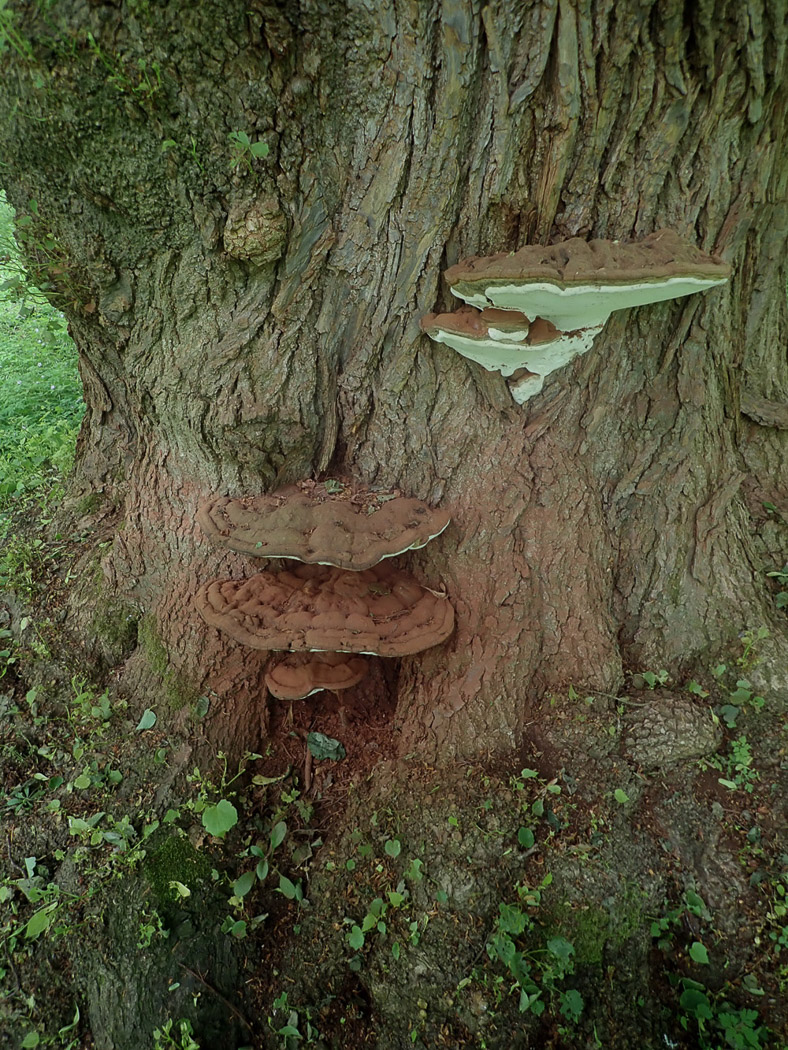 




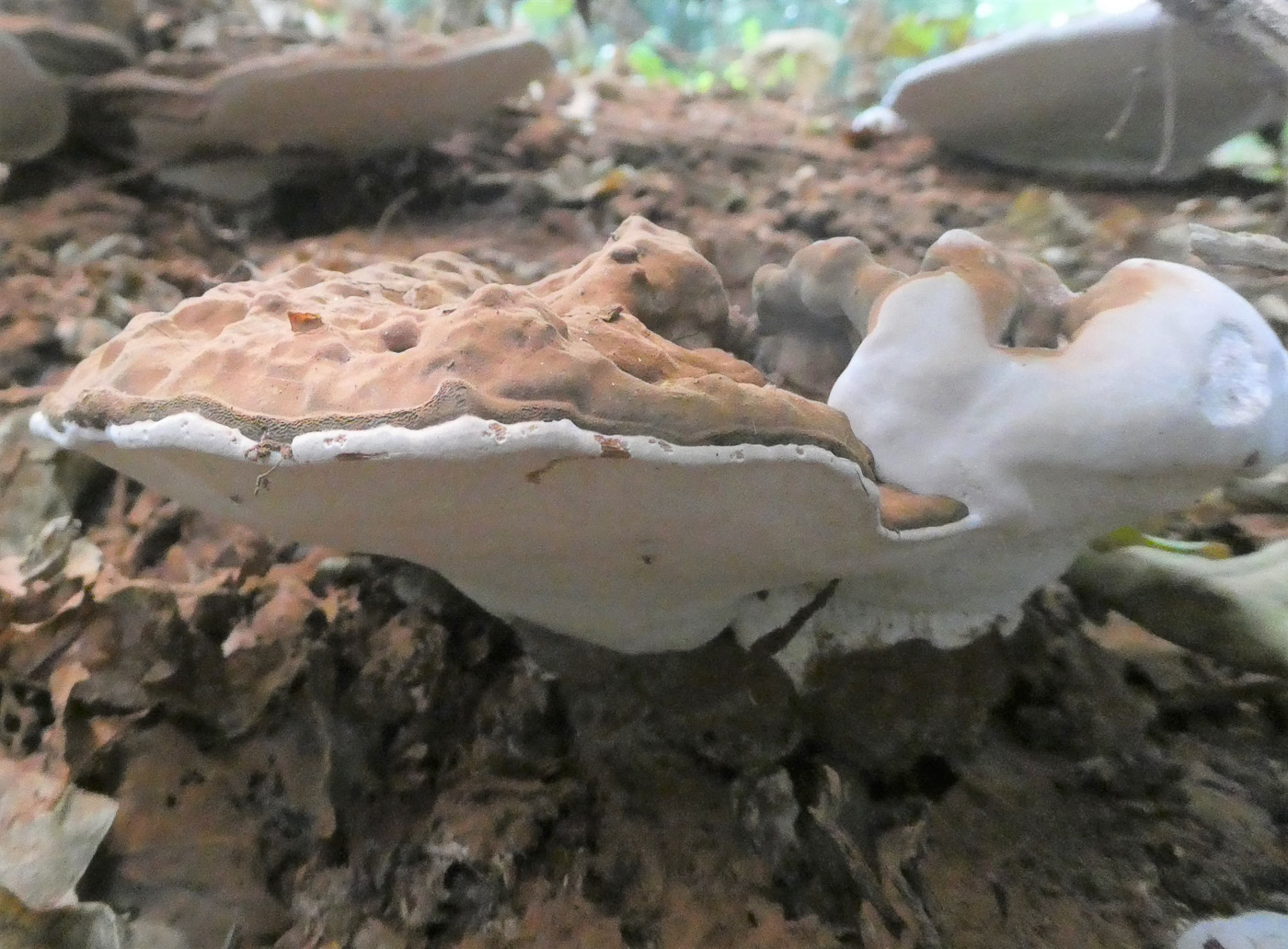
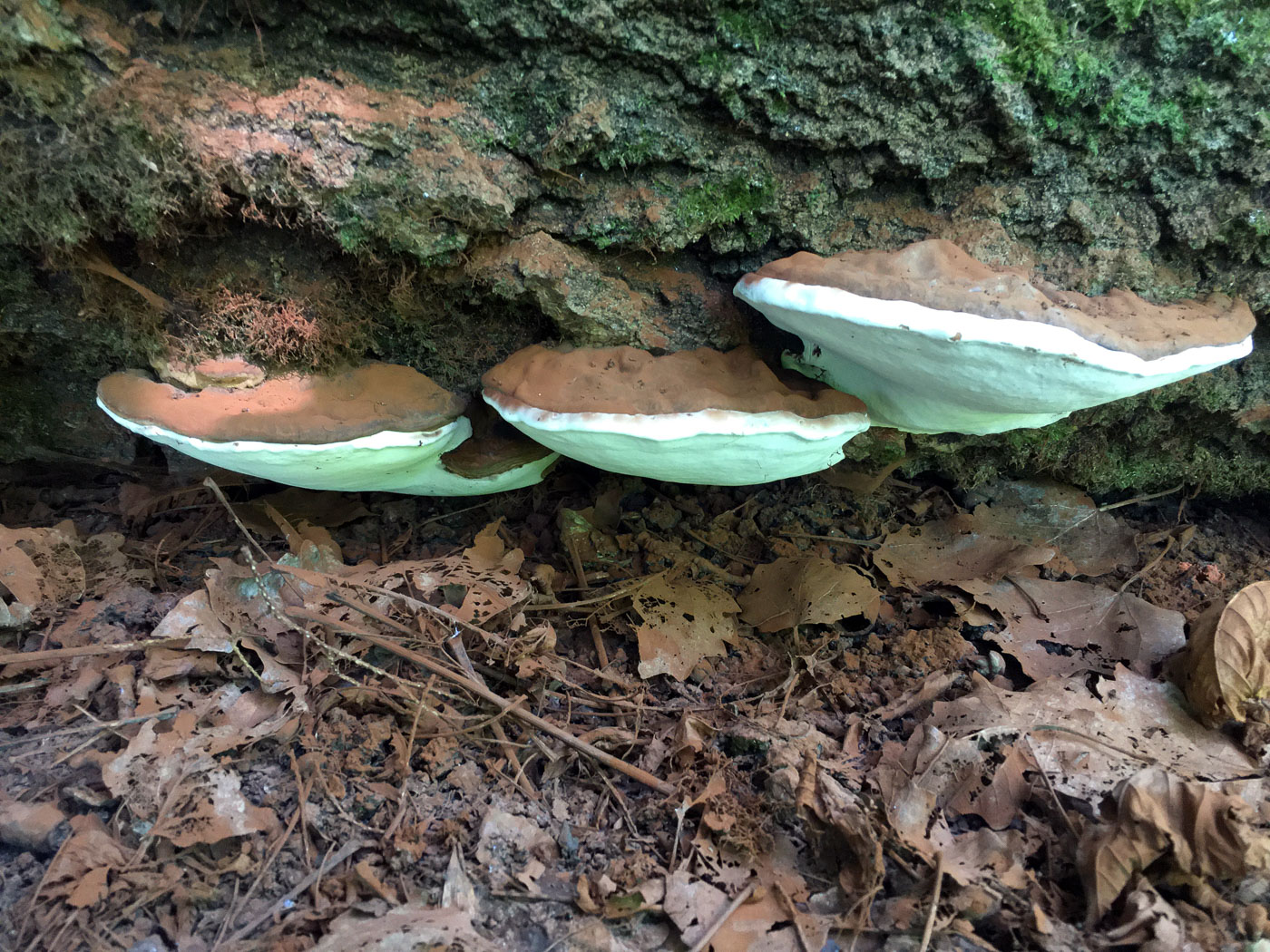
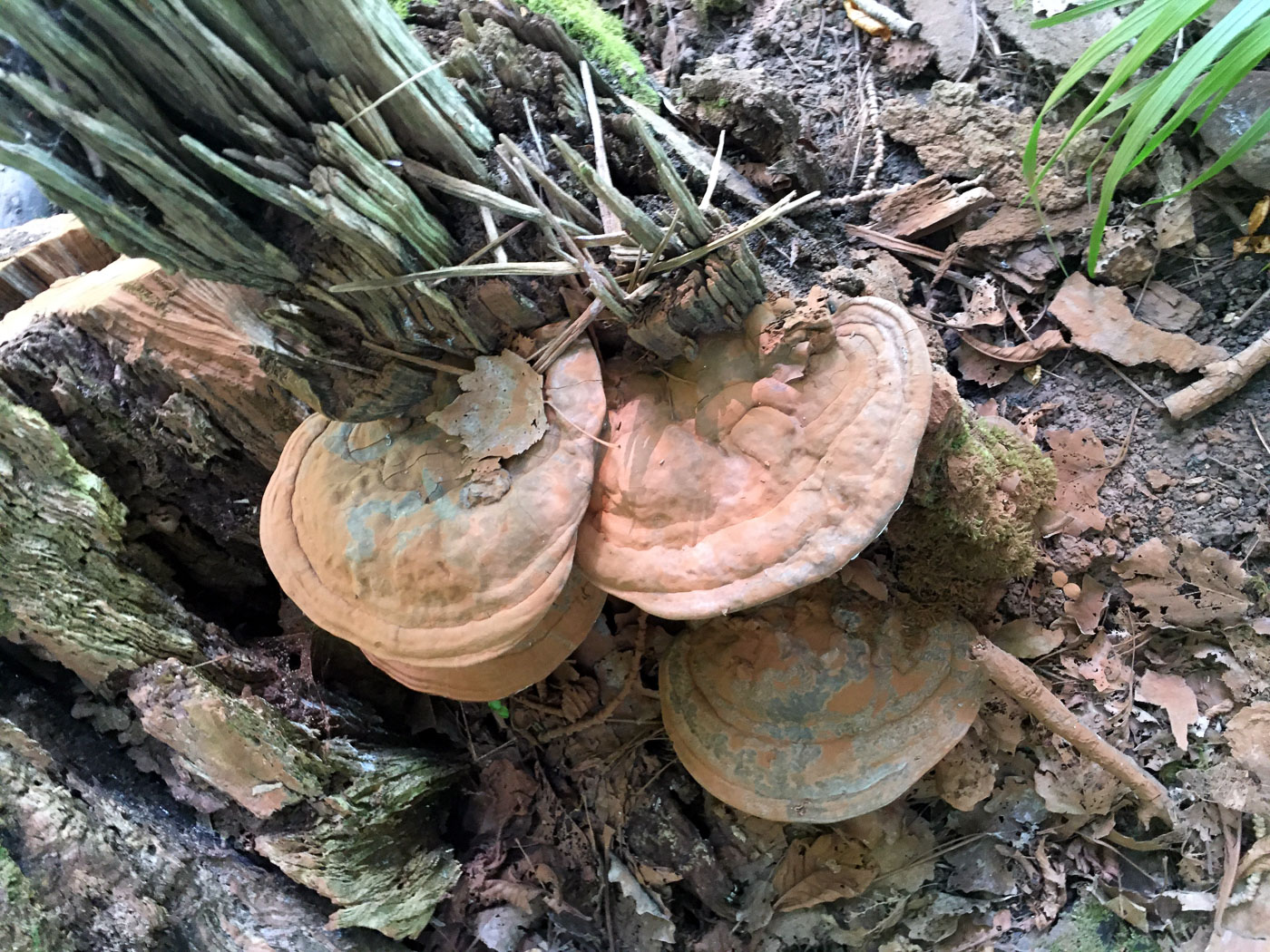
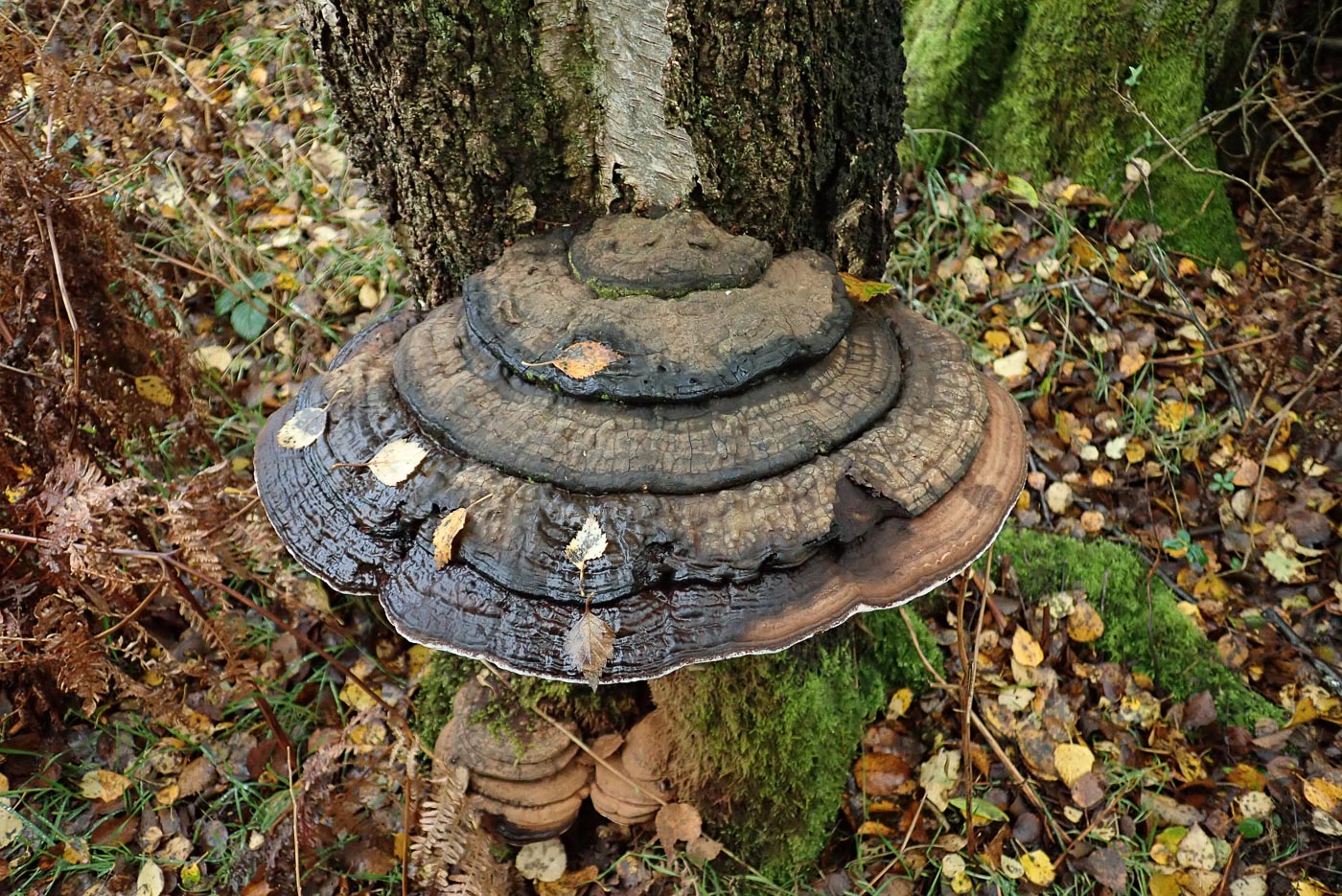
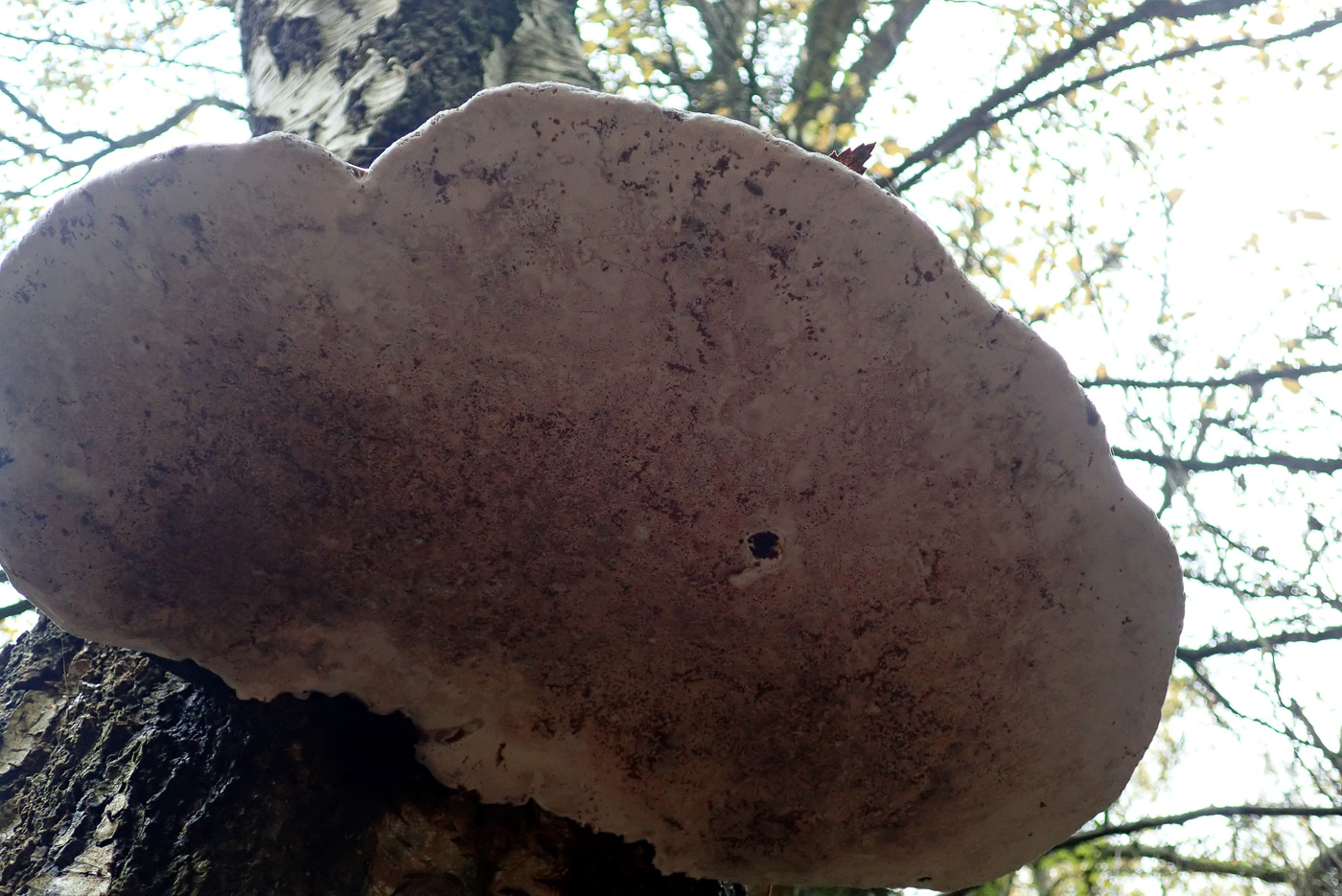
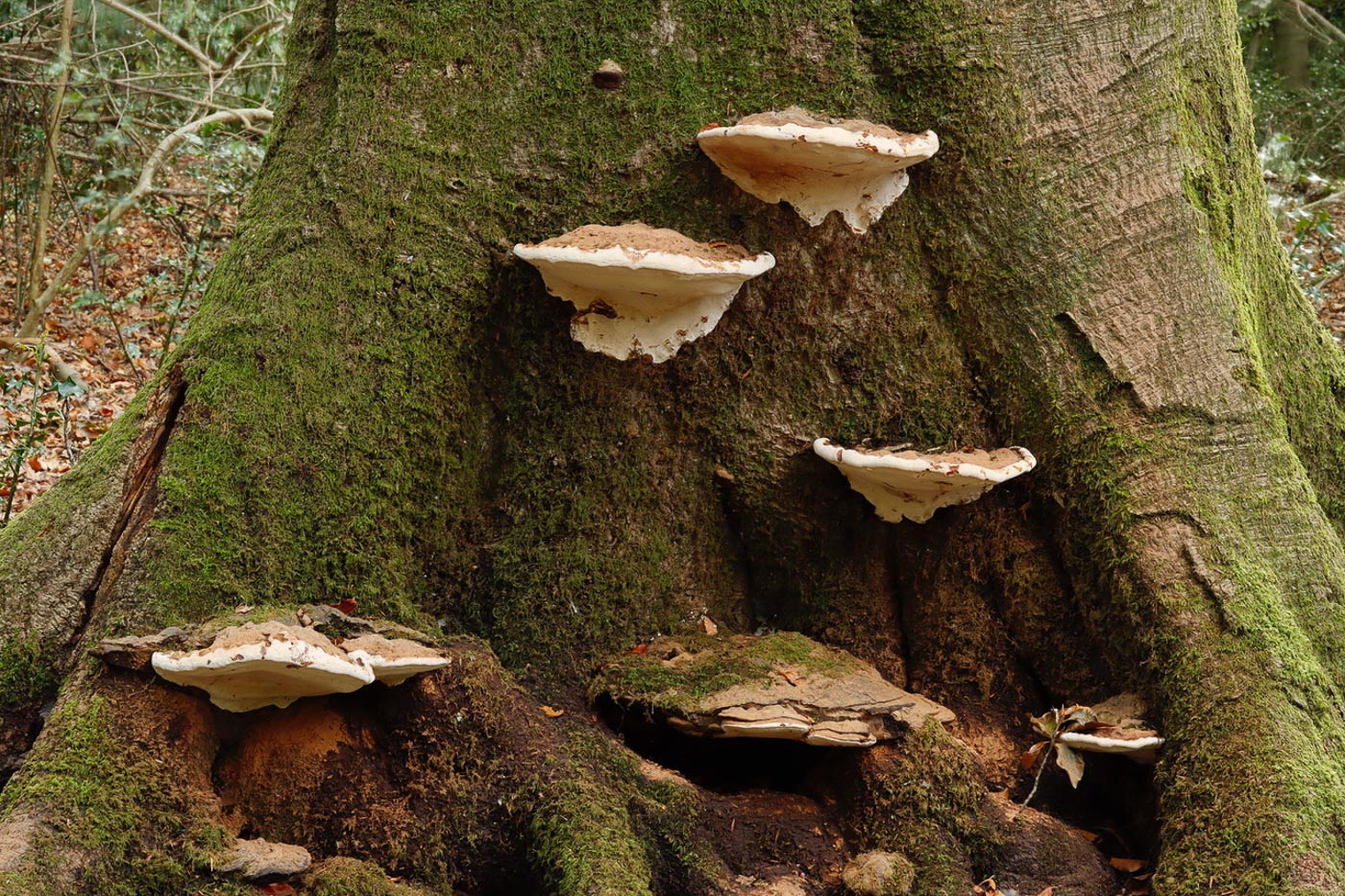
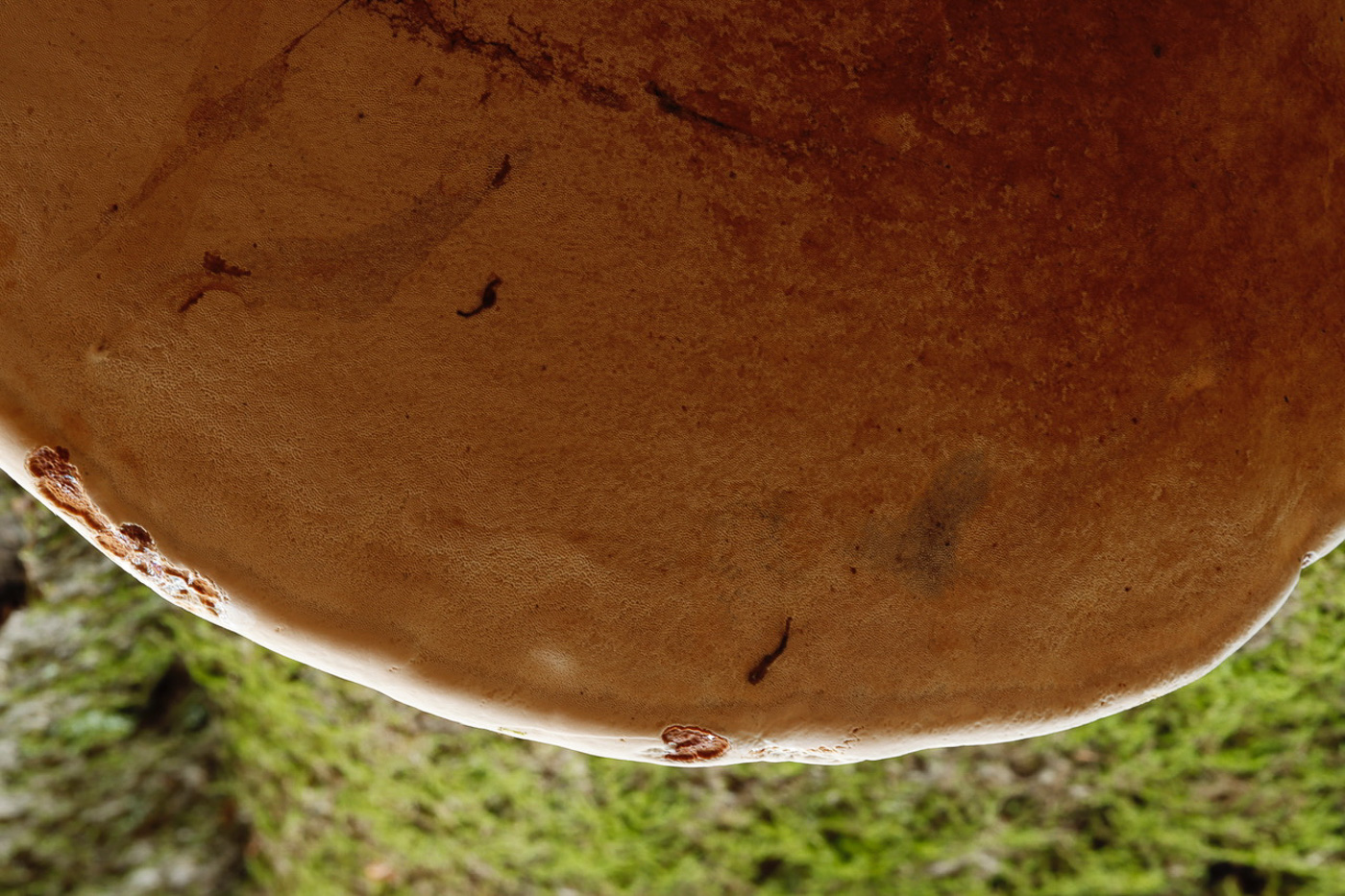
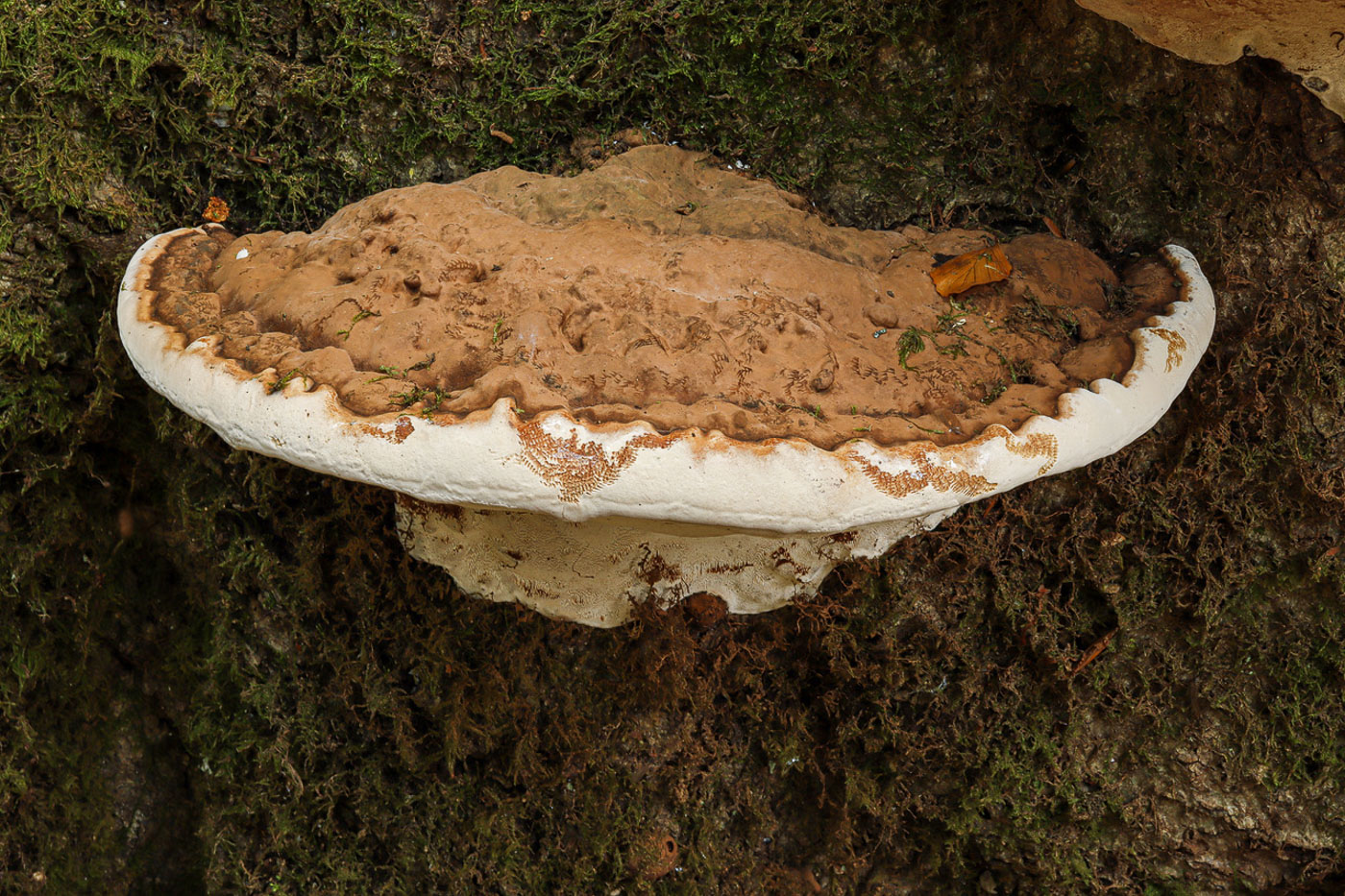
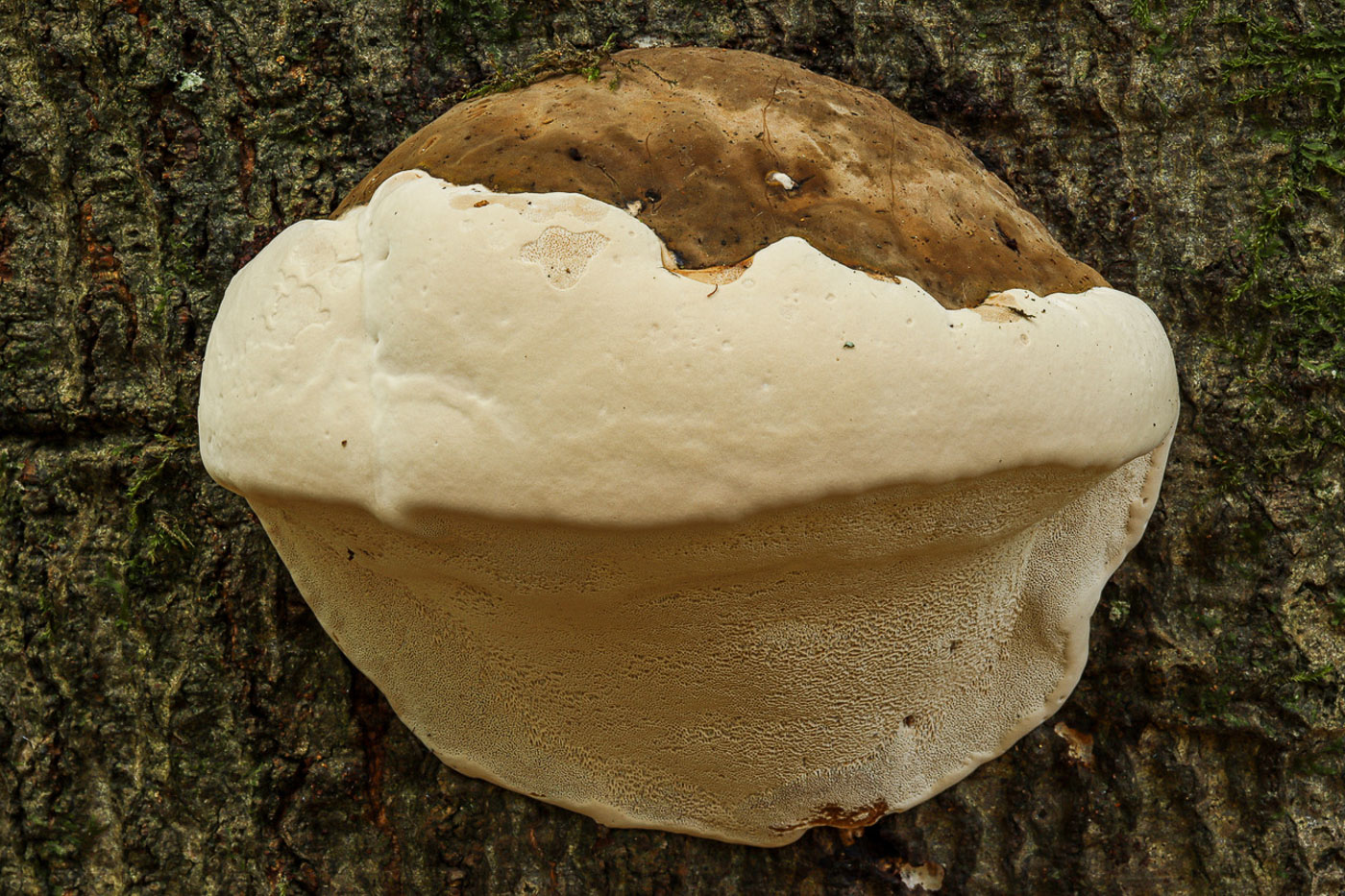
|
Ganoderma australe (Southern Bracket) Jun 1, 2024. At Turville Heath on one of the Lime trunks Penny checked out this display of brackets which she'd noticed here last August. It was clearly active again with a deposit of chocolate spores adorning the surrounding area. She collected a suitably coated piece of debris to take home and check that the spores matched her ID - this is the best method to use thus leaving the fruiting body undamaged, also the safest way to separate G. australe from its lookalike G. applanatum. (There is ongoing confusion as to whether the correct name for this common bracket is G. australe or G. adspersum but for now we follow Species Fungorum in continuing with the former.) Aug 12, 2023. Low down on Lime at Turville Heath Penny noticed these fresh though a bit atypical examples of a common bracket clearly busy sporulating all over the adjacent foliage and covering it with cocoa–powder spores. The somewhat pale and rather thick margins together with the unusual host tree for the species led Penny to check the spores later at home, which however matched perfectly thus confirming the ID. Jul 10, 2023. This impressive bracket - about 15 inches across - was at the base of a standing Beech in Gussett's Wood, found by Penny. Photo 2 shows a closer view of the cocoa powder spores coating the surrounding vegetation, often observed with this species and providing the handiest way to determine whether you have this species or its lookalike G. applanatum (see above). Penny collected a coated leaf then at home scraped off some spores onto a slide to examine with a scope. Spores greater than 10 microns long = the very common G. australe but less than 10 microns long = the much less common G. applanatum. Aug 5, 2022. In Austenwood Common, Chalfont St. Peter, Jim Wills noticed this bracket on an old Birch stump, recognised it as Ganoderma, then checked the spores (with his newly acquired microscope!) to determine whether it was G. australe or C. applanatum. The two are extremely similar and very difficult to split in the field, especially if the telltale signs of fly galls (which often occur on the underside of G. applanatum) are absent as they are here. Jul 22, 2021. On felled Poplar in Wotton Park Estate Joanna Dodsworth saw these nice examples of one of our commonest brackets. Each bracket was about 15 cms across and they show the brown lumpy upper surface, white border around the rim and finely pored white underside - all typical features. Note also (particularly in photo 2) the chocolate spore deposit liberally coating not just the fungi but also the surrounding vegetation. G. applanatum (Artist's Bracket) is extremely similar and can often be separated in the field by the presence of telltale insect galls on the underside - clearly not seen here. The safest way to split them, however, is by spores size. Oct 23, 2020. We do have a photo of this species dated Sept 25th but this large bracket, found on a dead Birch trunk in Ashridge by Penny C., clearly shows 5 years of growth. This genus produces perennial brackets and this one was 1 ft across. More brackets of the same fungus can be seen underneath, coloured cocoa brown from the spores dropped from the one above. Rather than damage the specimen by cutting into it, I collected a leaf from below, also liberally coated with spores, in order to check the spore size to confirm this was G. australe rather than its look-alike G. applanatum. Photo 2 shows the pale fine pores underneath. Sep 25, 2020. Paul Goby found this very common bracket on living Beech at Naphill Common. This is one of two extremely similar species which cannot with any certainty be separated without measuring their spores (not done in this case, so no guarantee of accuracy here). This is normally by far the commoner of the two in question - the other being G. applanatum (Artist's Bracket), but at Naphill Common we often find G. applanatum, proven by the tell tale presence underneath of the galls of a fly which (it appears) only occur on that particular species. As these galls are not visible on the pores of Paul's collection I've therefore guessed that this must be G. australe. Note that though the pore surface is pale, the spores are cocoa brown, in fact visible in the photo 1 where the wood / bark beneath each bracket has changed colour due to the spore deposit. Photo 2 is a close-up of the pores also coloured by the spores. |


 |
Ganoderma carnosum (a rare bracket with no common name) Feb 20, 2024. A friend of Sarah Ebdon's, Matt Vaughan, an arboriculturist, sent her a photo of a bracket (photo 1) found in Cublington (near Leighton Buzzard) on Feb 5th fruiting on Yew, suggesting that it might be this rare species of Ganoderma. Unfortunately there were no in-situ images taken at the time but he sent Sarah a sample which she was able to use for microscopic study and, consulting various keys etc, she was confident the ID was correct. She also sent detailed photos to tree / fungus expert David Humphries who confirmed her thoughts. This species is one of the shiny red resinous Ganoderma species which we come across far less frequently than the common and familiar G. australe and G. adspersum which lack this shiny surface. Its occurrence on conifer including Yew helps to distinguish it from the very similar G. lucidum - most often found on deciduous trees though apparently occasionally on Spruce. Of the under 50 records on the national database, all but one are on Yew and all but one Scottish record are in southern England counties. Luckily when the site was revisited today another bracket was discovered, hence photos 2 and 3.This is an exciting find and new to Bucks. (The photos are Matt Vaughan's) |
 |
Ganoderma pfeifferi (Beeswax Bracket) Apr 6, 2024. On a mature Beech in Chalfont St. Peter Jesper Launder saw this substantial bracket which from its shape, colour and pale pores which bruise brown was clearly some sort of Ganoderma. Suspecting that the cuticle on the upper surface had the waxy resinous coating which would bubble and melt if flamed, he tried this which then confirmed his ID. The cuticle of G. resinaceum also reacts in this way but in our area is more often found on Oak whereas G. pfeifferi is more often on Beech. Both species occur on mature trees but neither are very common. |
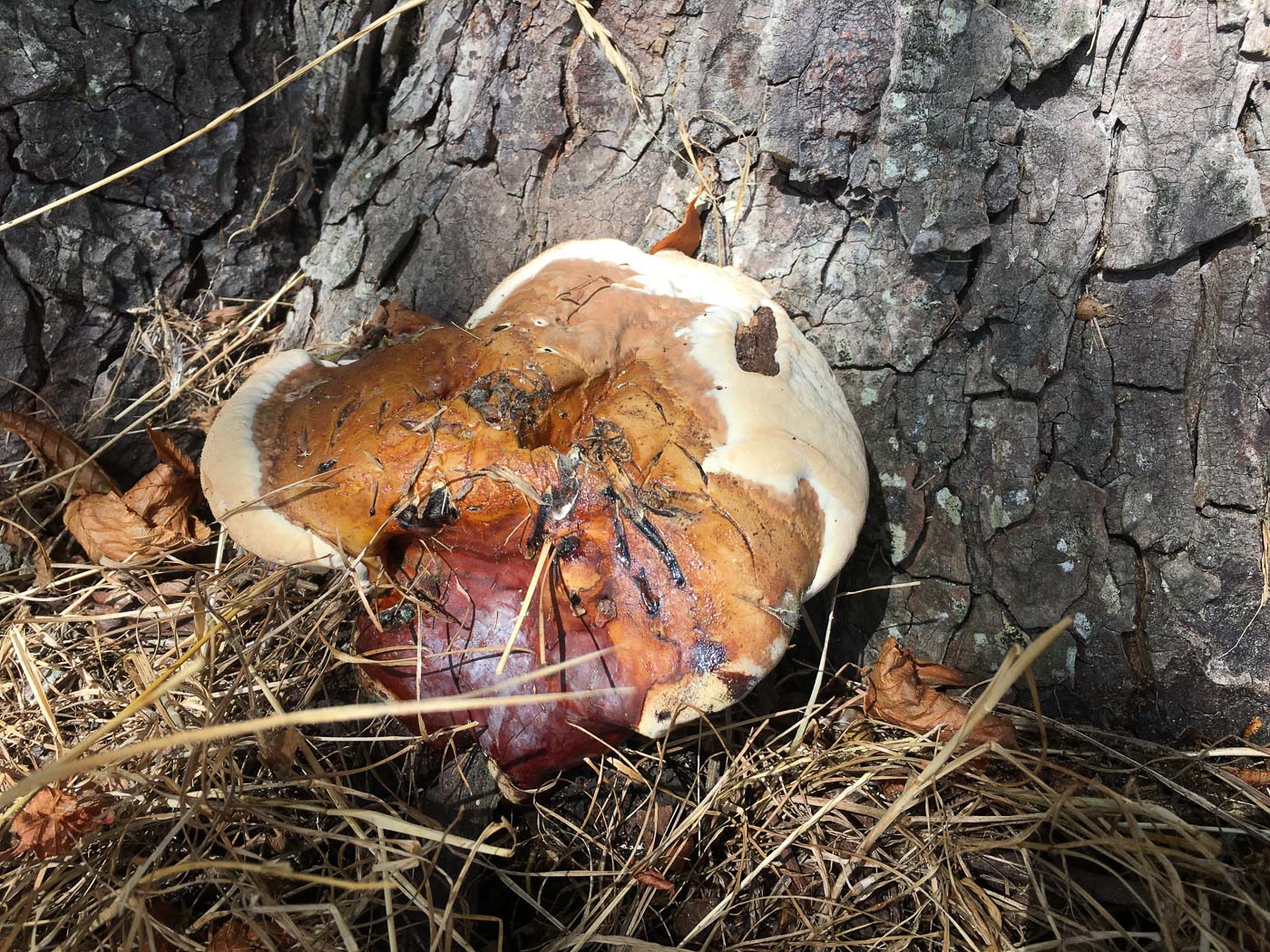
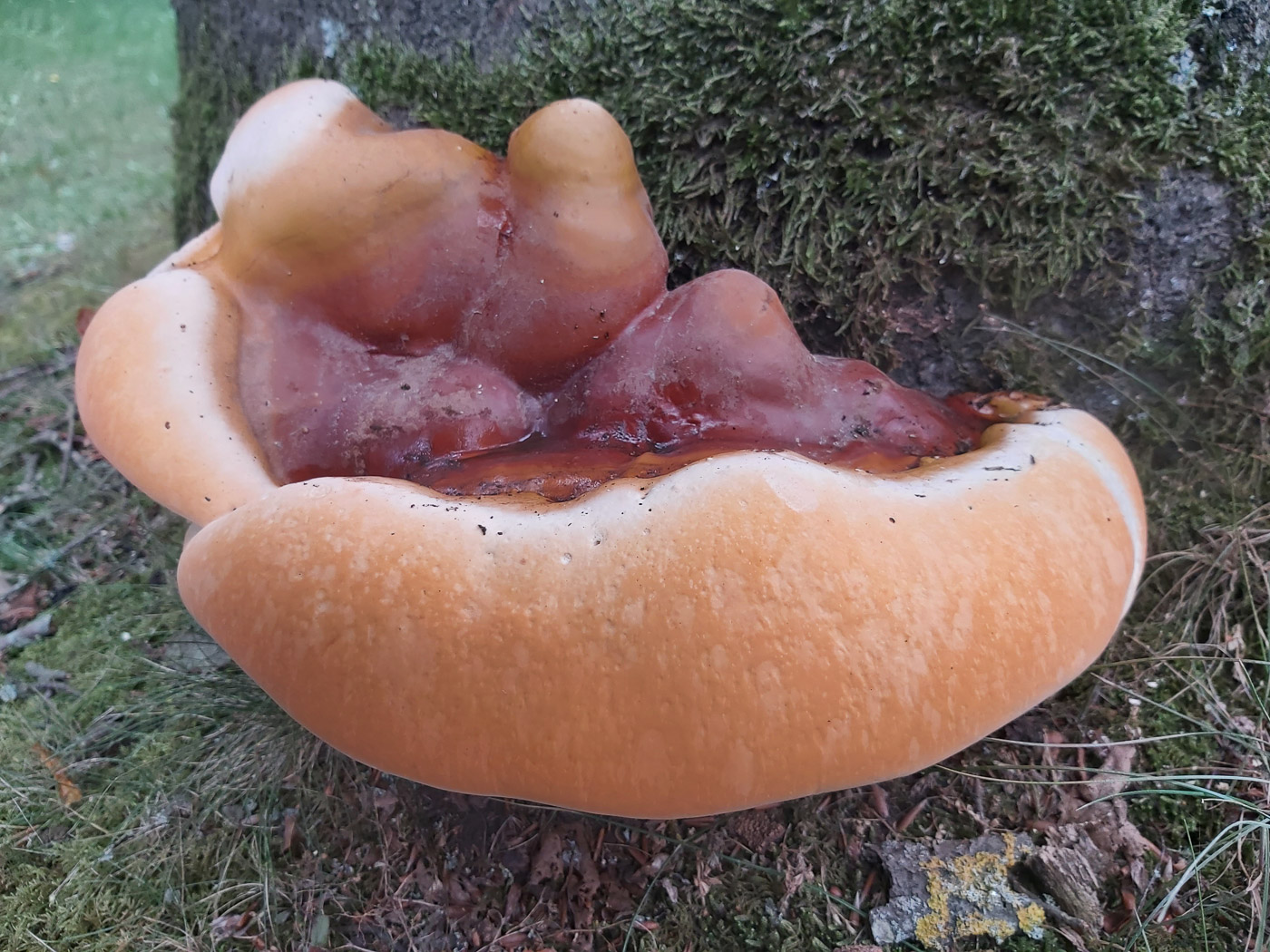 |
Ganoderma resinaceum (an unusual bracket with no common name) Aug 19, 2022. In Wotton Park Estate Joanna Dodsworth found this bracket fruiting at the base of a particular Horse Chestnut trunk where we've recorded the species on and off for the last 14 years, first identified by Martyn Ainsworth (Kew) - hence the certainty of its determination from a photo. Both this species and the somewhat similar G. lucidum (Lacquered Bracket) differ from the much more common pair, G. australe and G. applanatum, in having a shiny upper surface but share the same fine pale pore surface underneath which marks indelibly dark brown when scratched (hence the name Artist's Bracket for G. applanatum). They all occur on deciduous wood, most commonly Oak and Beech. Jul 28, 2021. On a large Beech in Chalfont St. Giles Jesper Launder spotted this quite unusual bracket, one closely related to the Southern Bracket and for some known as Lacquered Bracket (though that name is officially alotted to the very similar G. lucidum). This is an immature specimen and at this stage the red brown, crusty almost varnished upper surface is very different from the common Southern and Artists's Brackets which are both rough and bumpy, though all Ganoderma species have white pores beneath but chocolate brown spores. |




 |
Geastrum britannicum (Vaulted Earthstar) Feb 14, 2024. On a bank in a lane near Bourne End Derek Bourne noticed these unusual Earthstars, thought they looked interesting and was surprised to find them fruiting at this time, so sent the photo to Penny for ID etc. From his photo (photo 1) it was clear that this was no common species and close to G. pectinatum with its arched rays, distinct neck and plicate central opening (from which the spores are expelled). Noting the presence of a small but distinct collar-like structure - the apophysis - joining the central 'puffball' to its neck and clearly visible on two of the fruitbodies in photo 1, Penny made the assumption that this was likely to be the rare G. striatum, especially as she could see no sign that the base of the rays were attached to a mycelial cup. (If this cup was present, however, it would eliminate both species mentioned. Penny was acting purely on Derek's photo with no examination of the material - a dangerous thing to do, as it proved!) Ten days later Jesper Launder sent in his photos of a Geastrum he'd collected in Chalfont St. Peter and worked carefully on. Though not obvious at first, he'd found a mycelial cup present (photo 5), measured the spores which were very small for the genus, and this together with all other features led him to the even rarer G. britannicum – a species only described in 2015. Penny then started to doubt her ID of Derek's collection which appeared so similar, so asked Derek to collect another sample from the original site for proper examination. Sure enough she then was able to extricate the vital mycelial sack lurking at its base and measure the tiny spores, thus eliminating her initial ID. This was not G. striatum as shed' thought but was also G. britannicum, and as such new to the county. A sample will be sequenced to confirm. The moral of this tale: identifying purely from photos can be misleading and unsafe, emphasising the importance of microscopic examination especially where rare species are involved. |
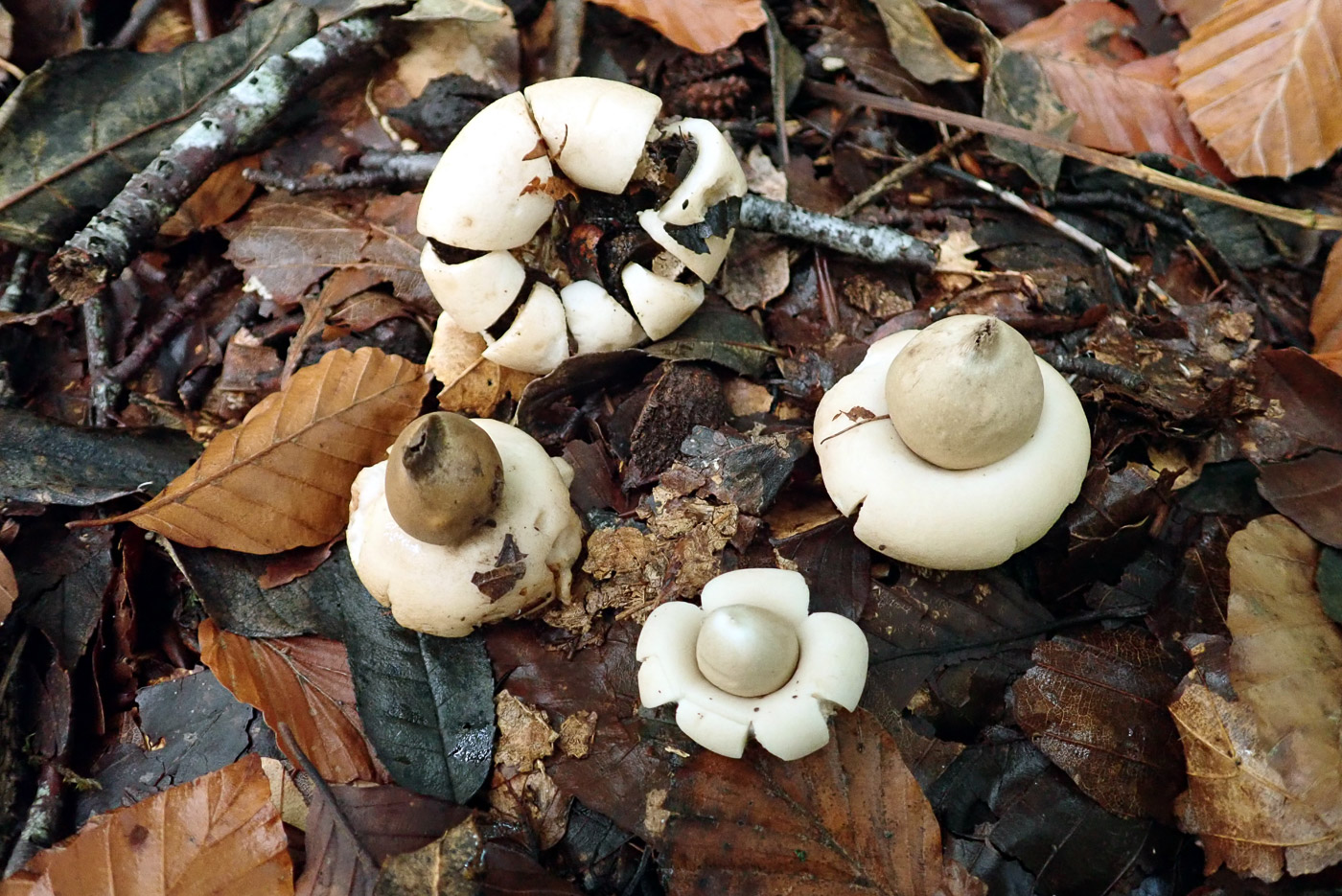
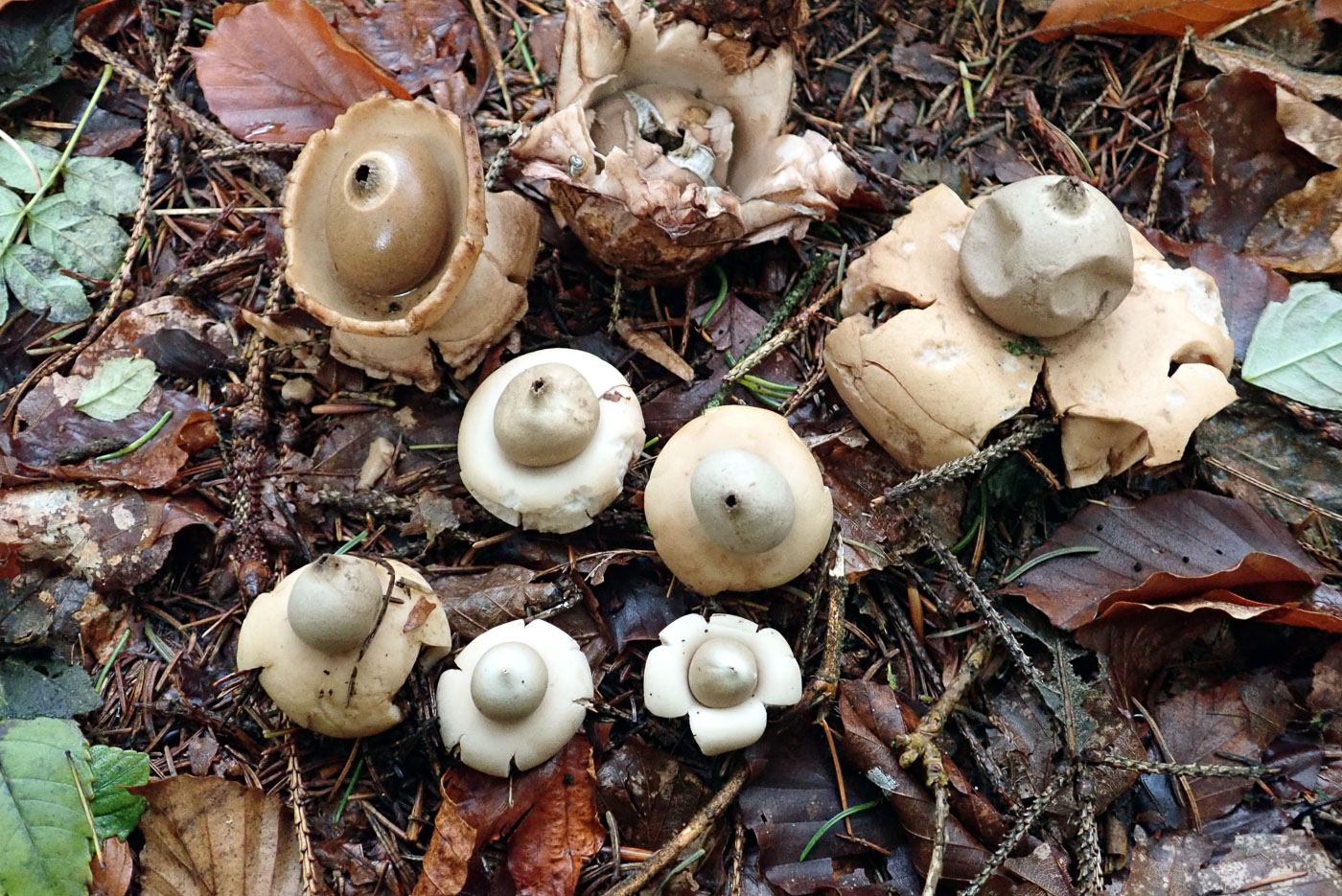 |
Geastrum fimbreatum (Sessile Earthstar) Oct 13, 2020. Penny and Paul Cullington found good numbers of these enchanting little Earthstars under mixed conifer and deciduous trees at Pulpit Hill. The largest fruit body, upturned at the top left in photo 1 to show the underside, was only about 3.5 cms across, so this delicate species is considerably smaller than the common G. triplex (see also photos dated Oct 04 & Sept 03). We then came across both these two species growing together so took the opportunity to compare them side by side, photo 2, with G. triplex above and G. fimbreatum below. Note the collar in one G. triplex but absent an another, also the collarless and white fruit bodies typical of G. fimbreatum. |
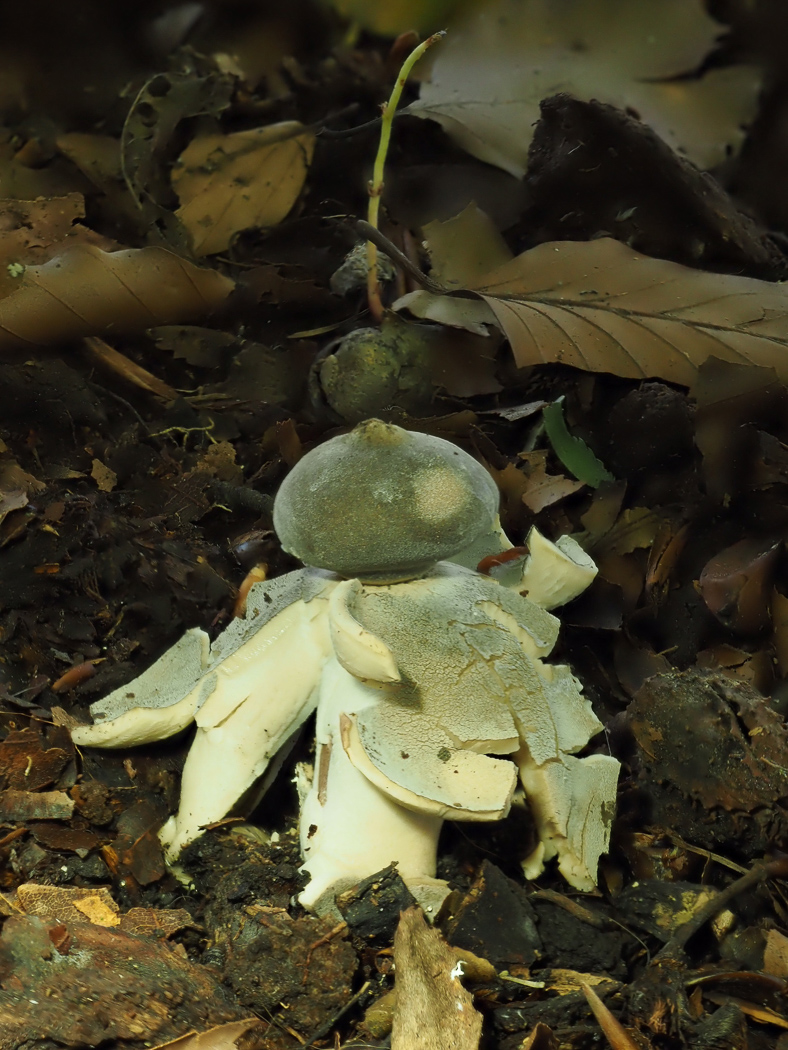
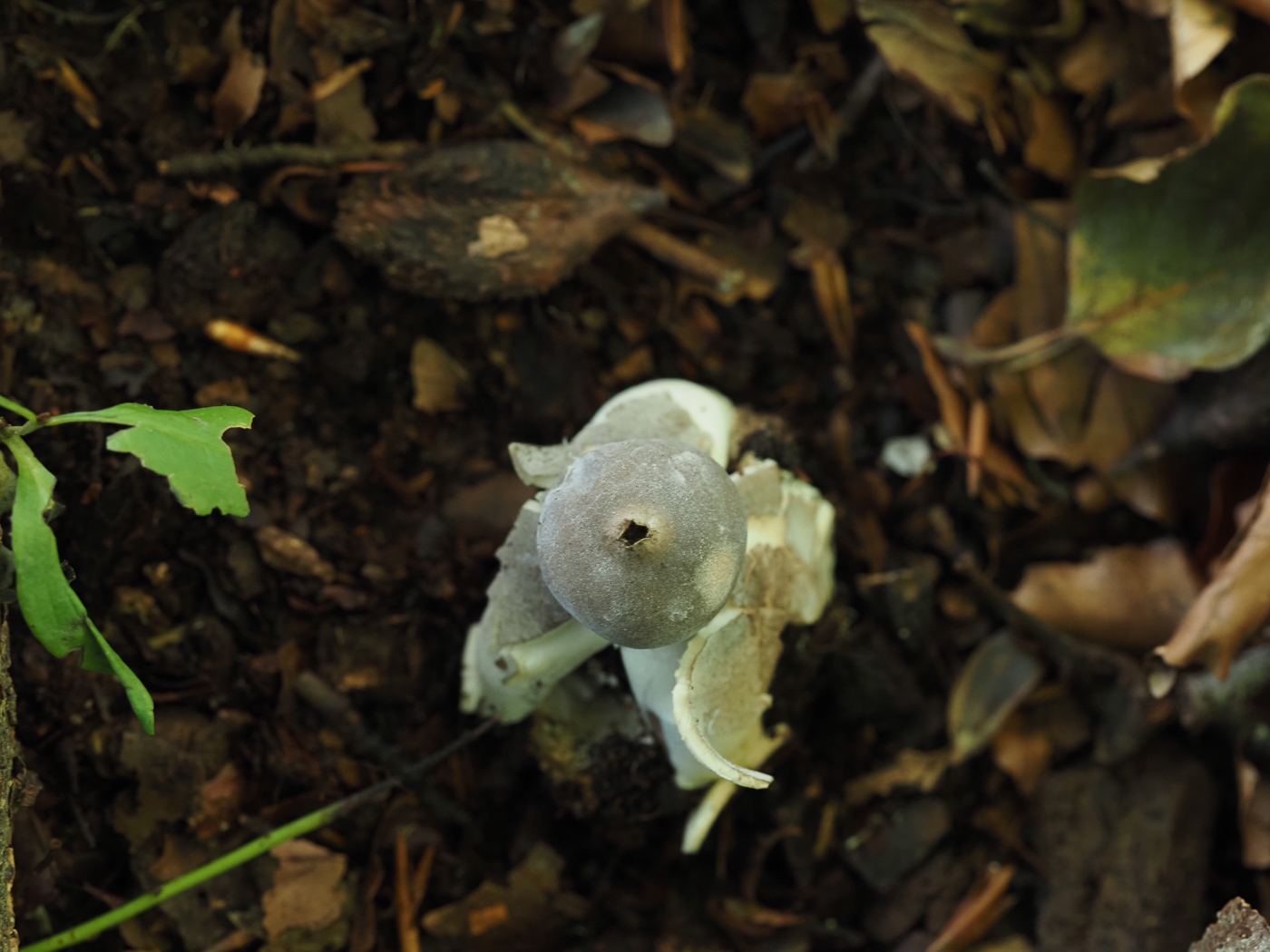
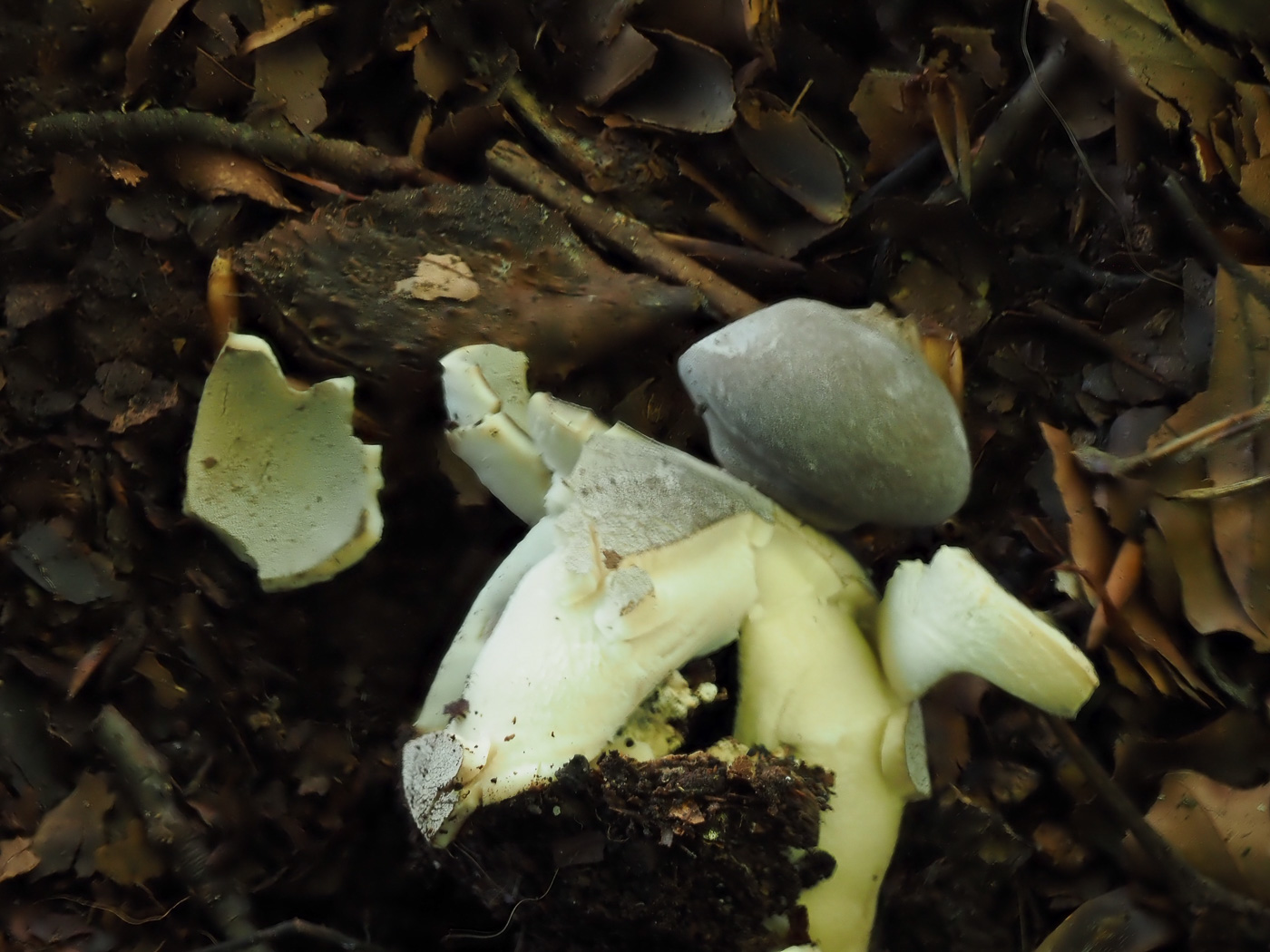
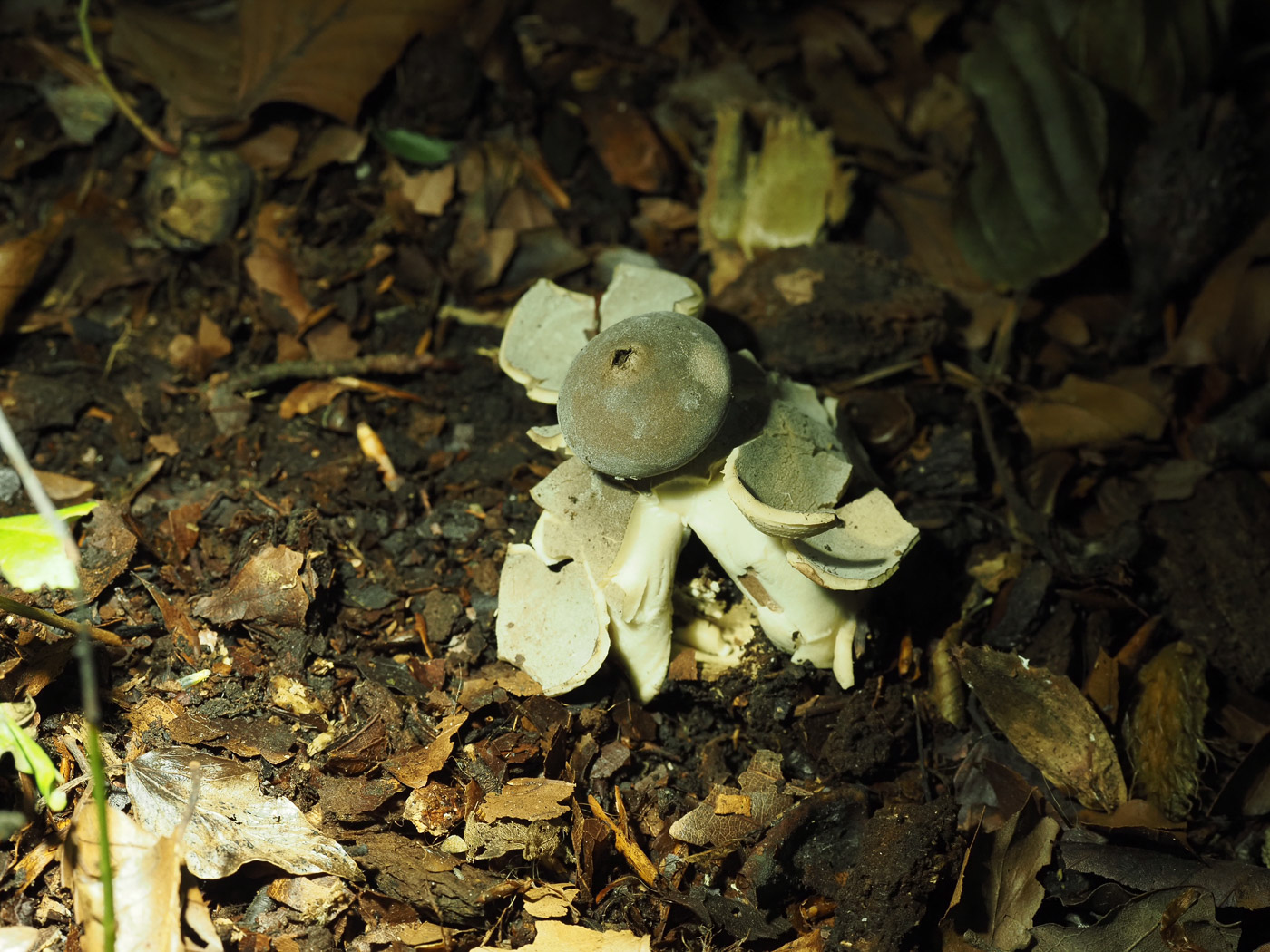 |
Geastrum fornicatum (Arched Earthstar) Oct 1, 2021. In Disraeli Woods, Downley, Claire Williams found this singleton specimen in the woody litter and realised it was considerably smaller than the common Collared Earthstar with which she was familiar. The peridium (puffball centre) was rather grey with a 'pruinose' coating and a torn opening at the top and it was standing rather proud supported on only a few rays (legs), all features pointing to either G. quadrifidum or G. fornicatum. This is not a genus Penny feels overconfident at identifying, especially just from photos, but two experienced mycologists have now determined it as G. fornicatum. We have only one previous county record dating back to 1934 so this is a notable find and we hope the specimen can be retrieved with a view to getting it sequenced to confirm. |



 |
Geastrum pectinatum (a rare Earthstar with no common name) Nov 2, 2023. In Broomhill Woods, Milton Keynes, Justin Long came across an amazing patch of these beautiful Earthstars in deep litter under Redwood. His range of photos show all the diagnostic features including the plicate peristome (pleated top opening), the neck, the smooth fertile puffball-like part, and the cream coloured rays beneath. Justin reported about 20 fruiting bodies here - what a sight! We have just two previous county records and this is a new entry for Finds. |


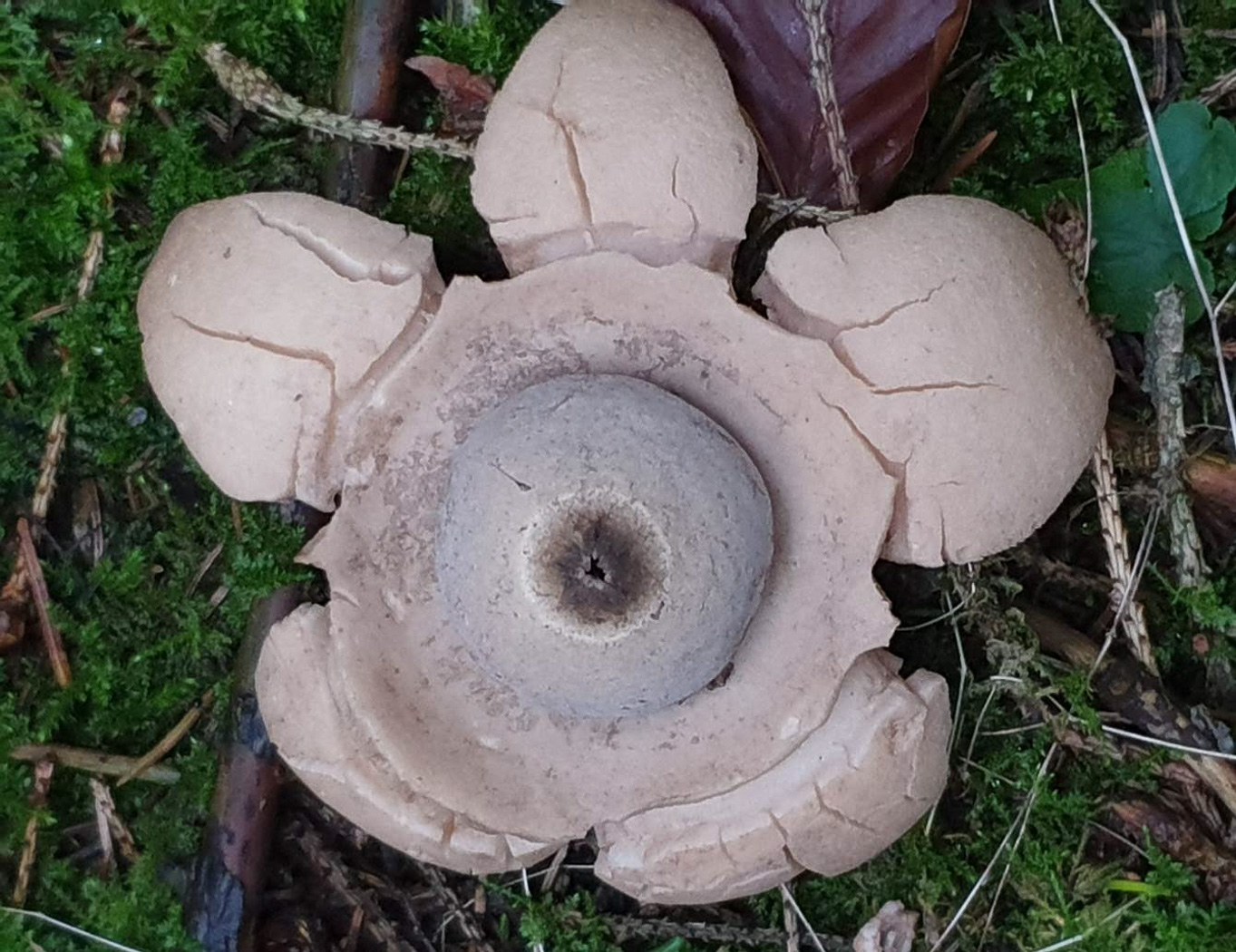
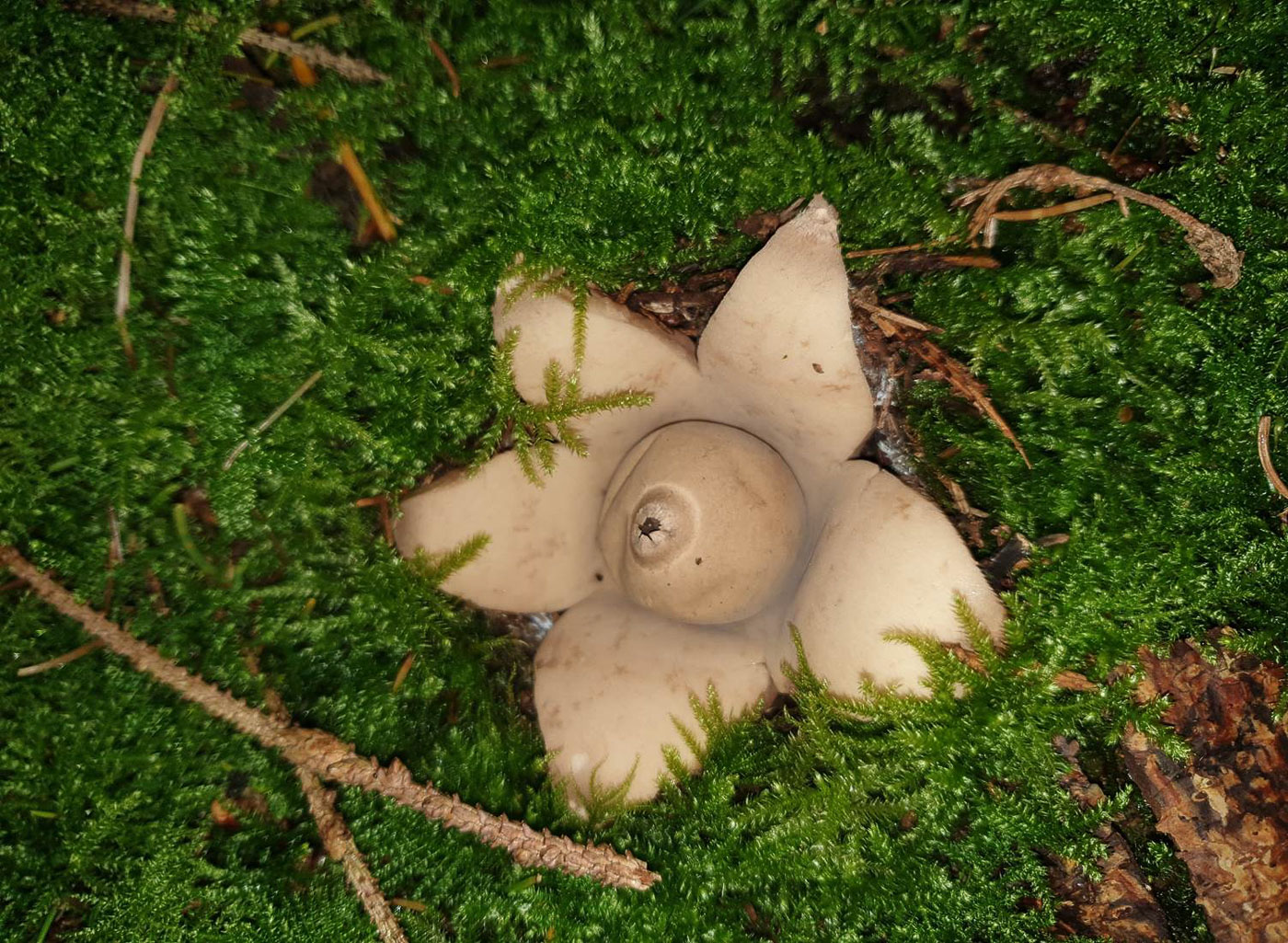
 (DSCN4638 (2).jpg)
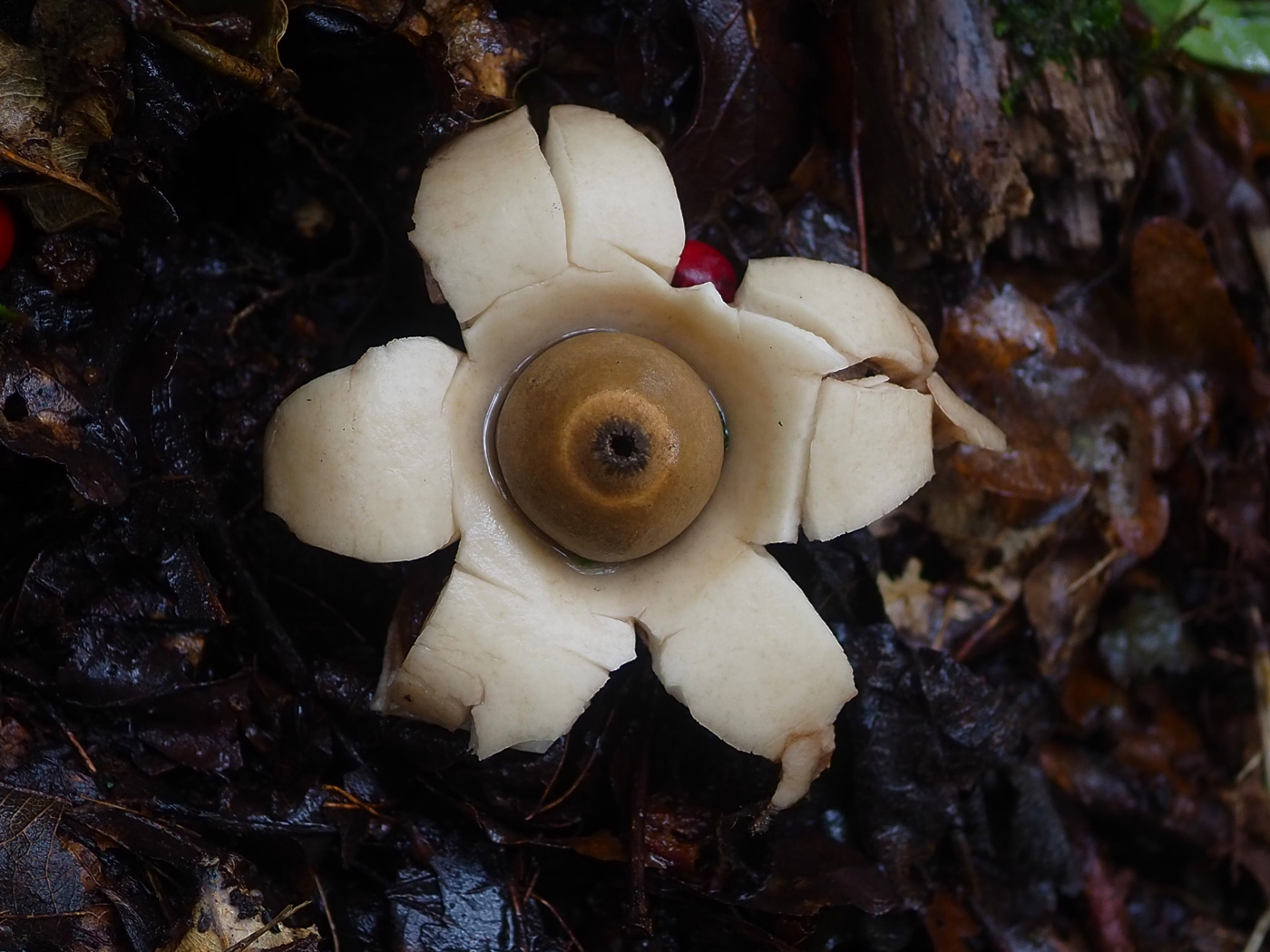
|
Geastrum triplex (Collared Earthstar) Oct 3, 2023. In Captains Wood near Chesham Greg Douglas found this nice display in deciduous litter. The close up shows how the stellate 'wings' in this species tend to crack radially, thus leaving the inner section appearing as a separate collar. When this doesn't happen it makes it harder to be sure of ones determination and can confuse. All our images in Finds are from 2020 and so far this season we've seen the genus undeveloped before it splits open to form the typical 'star' shape, so it's one to look out for now. Nov 8, 2020. Jackie McKenzie-Dodds and Justin Warhurst found two perfect examples of this species in Cadsden and although we already have photos (see dated Sept 04 and Oct 03) these illustrate well how it can be found both with and without the collar referred to in the common name. Photo 1 clearly shows how the collar is formed as the rays expand and split, leaving the so called collar. In photo 2, however, the rays are all in tact, thus no collar. Earthstars once matured last a long time in the field so now is a good time look out for them in litter, both conifer and deciduous. Oct 3, 2020. John Catterson found this singleton at Downley Common in woody litter. We have another rather damaged example (dated Sept 04), but it's worth comparing the two because the earlier one has a clear collar around the central part whereas today's has no typical collar at all - often the case! This does not mean it's a different species but note how the five rays are beginning to split radially - this is how the 'collar' if present is formed. Sep 4, 2020. Margaret Bolton noticed this fungus in a roadside verge near Frieth. A woodland species, this is one of the larger Earthstars and also probably the commonest. This particular specimen has a distinct collar but that feature is not always obvious or even present which can confuse identification. |
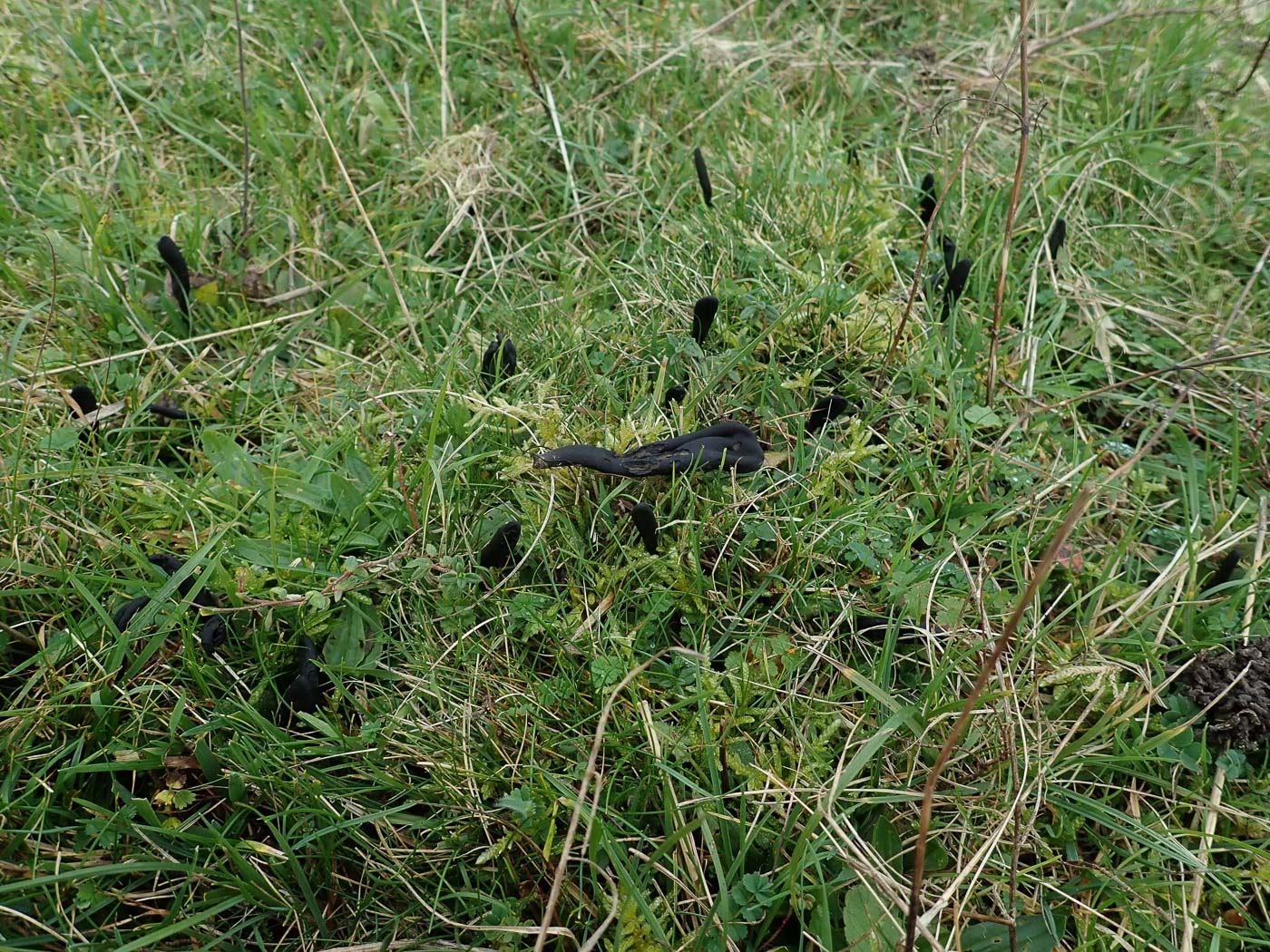
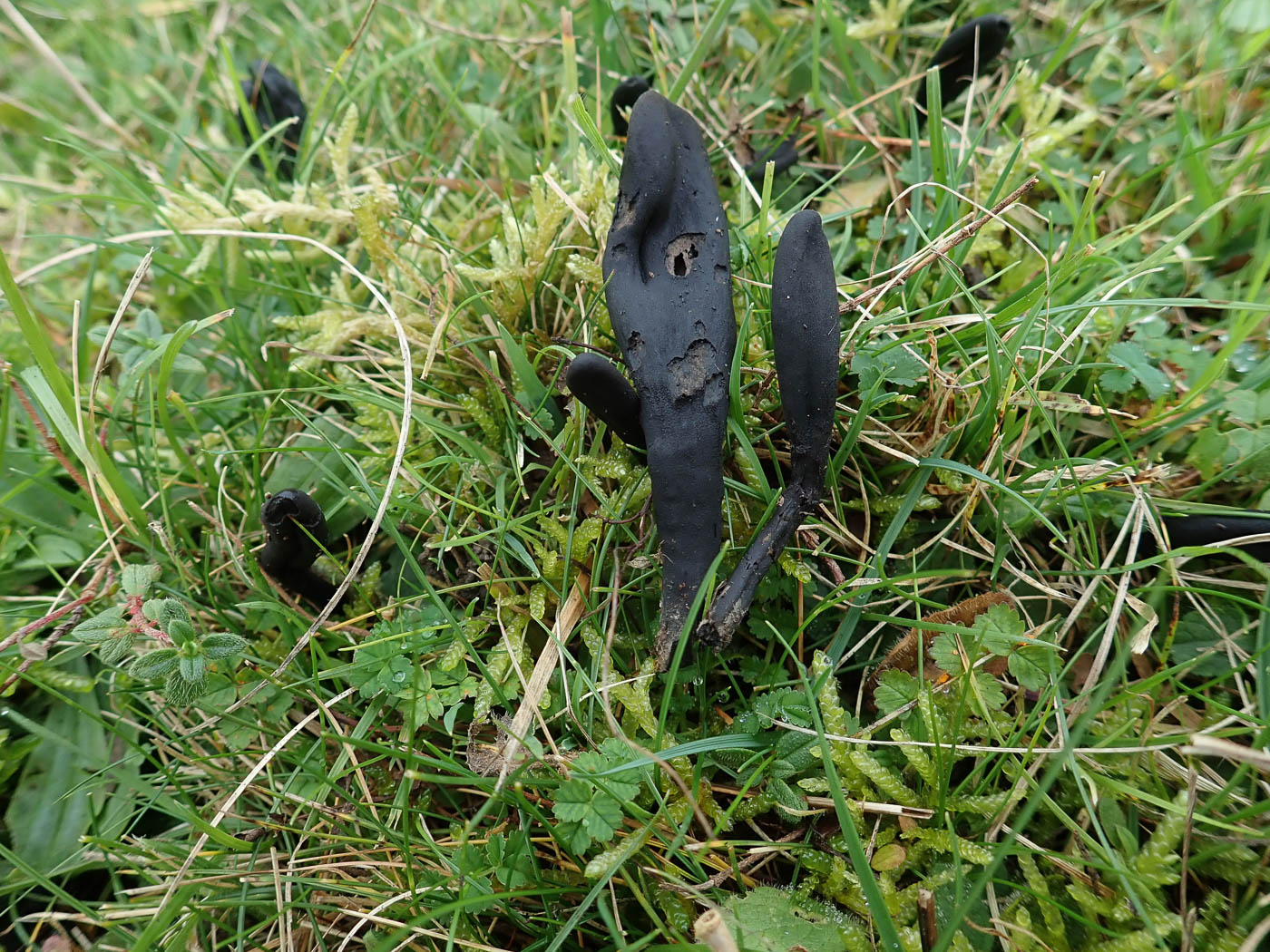 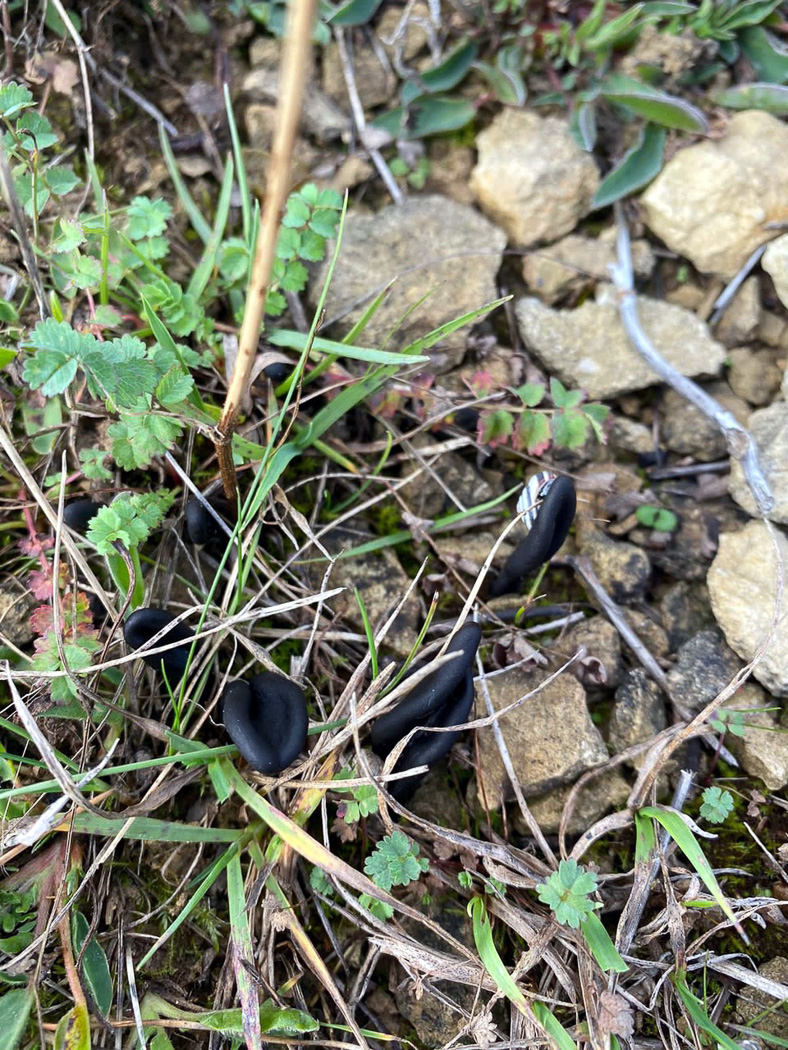
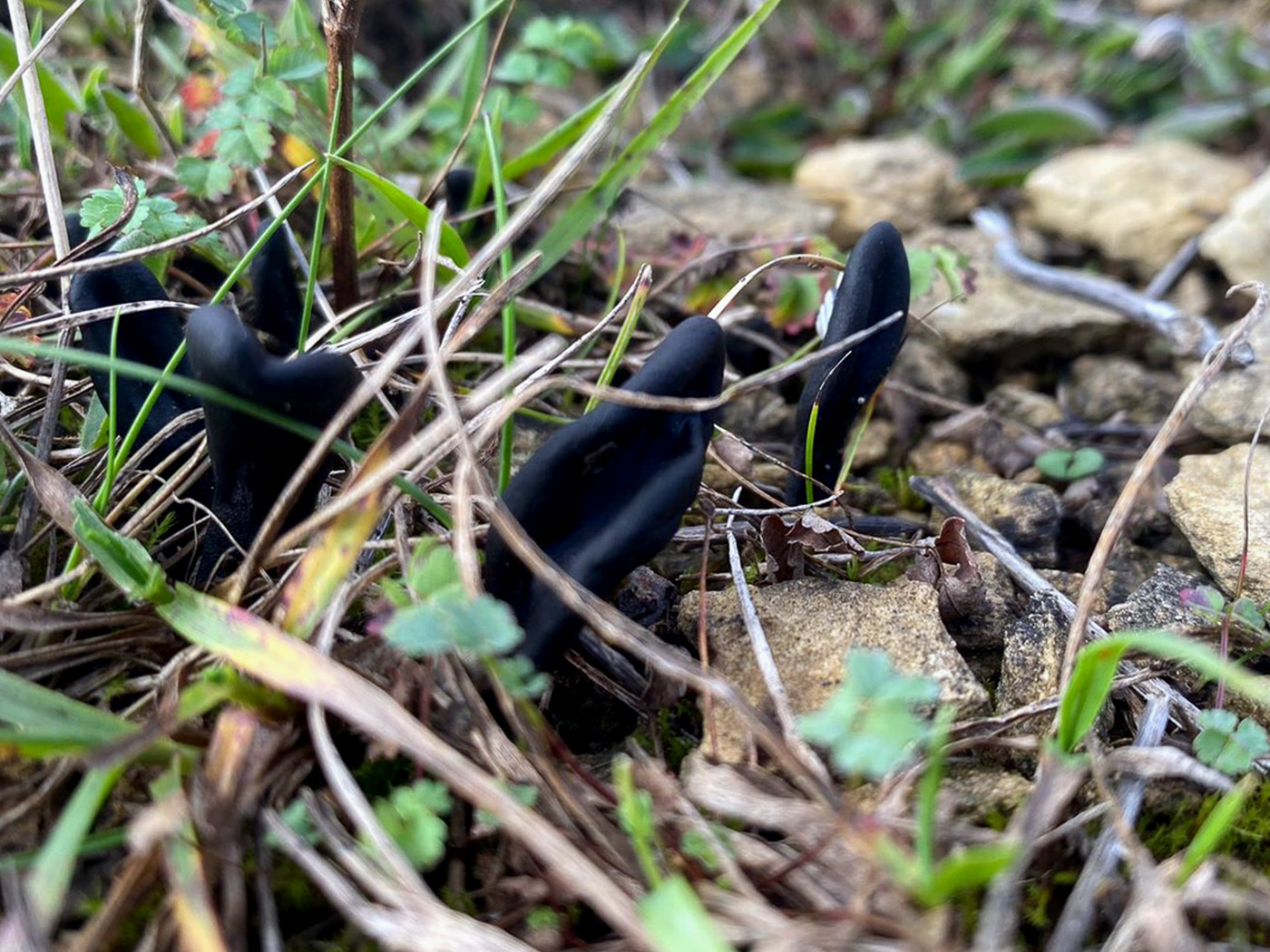 |
Geoglossum cookeanum (an Earthtongue with no common name) Nov 14, 2024. As Penny stepped onto the Helianthemum-covered escarpment at Coombe Hill the first fungi she saw was a large patch of black clubs near the main path. Not having seen this genus here before she took one home to identify, following the key and counting the number of septa in the amazing long spear-like spores and taking note of the shape of the paraphyses (cells which lie between the spore-containing asci). Having worked out the species name, she then found that it had been seen here back in 2001 when identified by Steve Kelly (it being one of his favourite genera). We have quite a few records from elsewhere and this is not considered a rarity. Nov 1, 2020. Our first Earthtongue was found by Rebecca Hiorns at Stonepit Field, Gt. Linford near Milton Keynes. This is another grassland species and the genus superficially resembles the much commoner Clubs apart from being black (and easily overlooked!). Identifying to species with safety needs a scope so naming this particular collection is not by any means 100% secure, but the smoothness and shape of this collection makes it likely to be G. cookeanum, possibly the commonest and most regularly recorded species. |

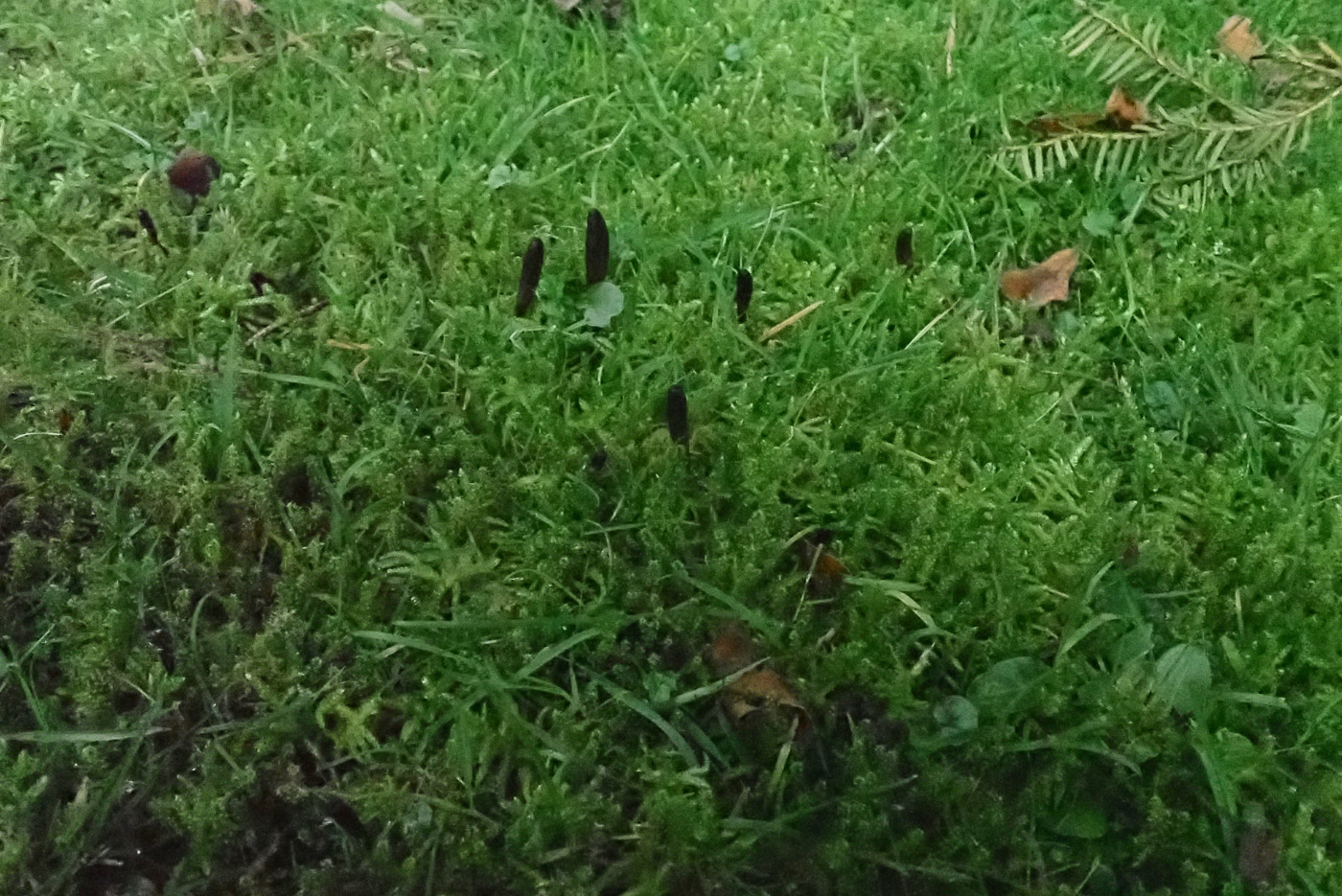
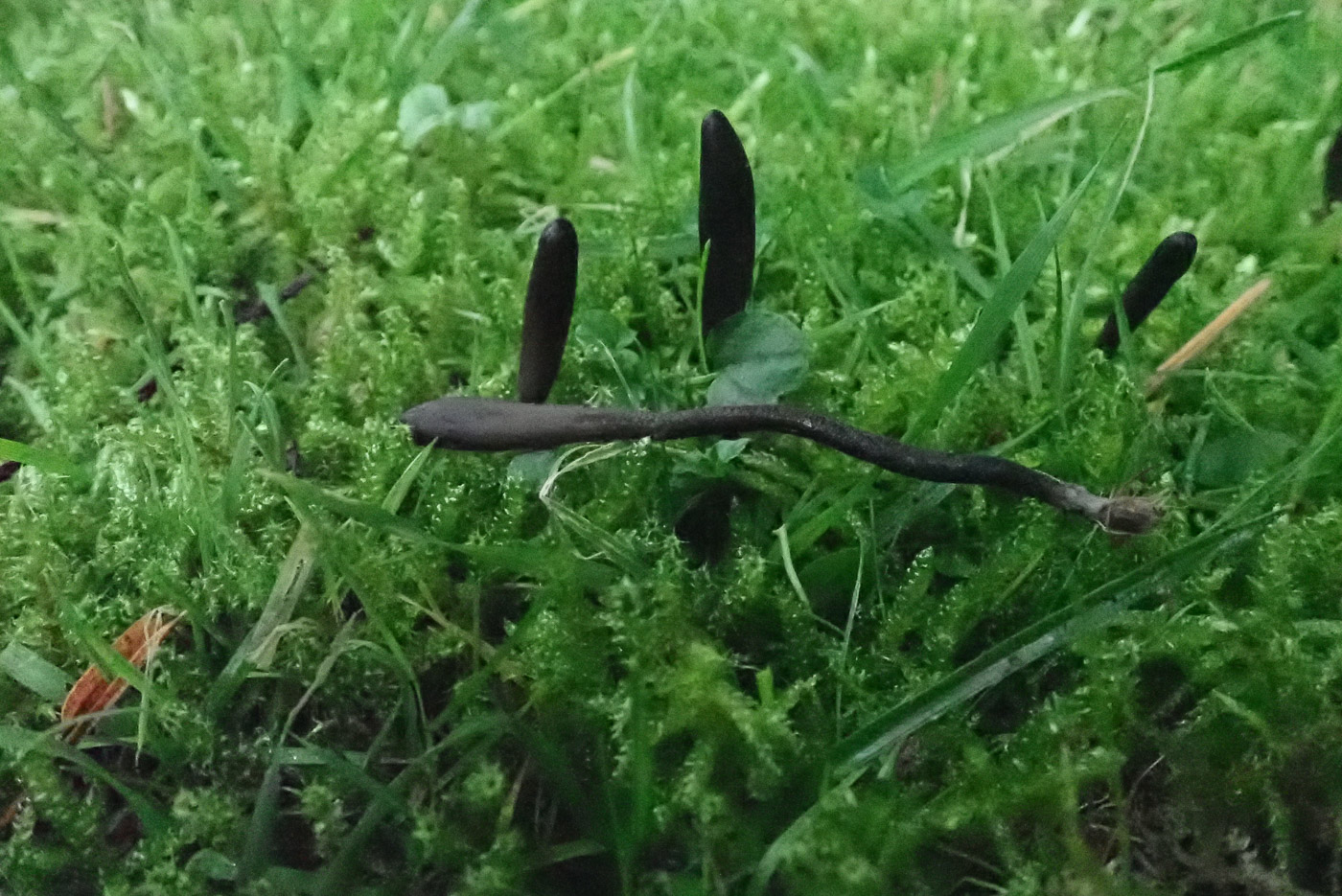
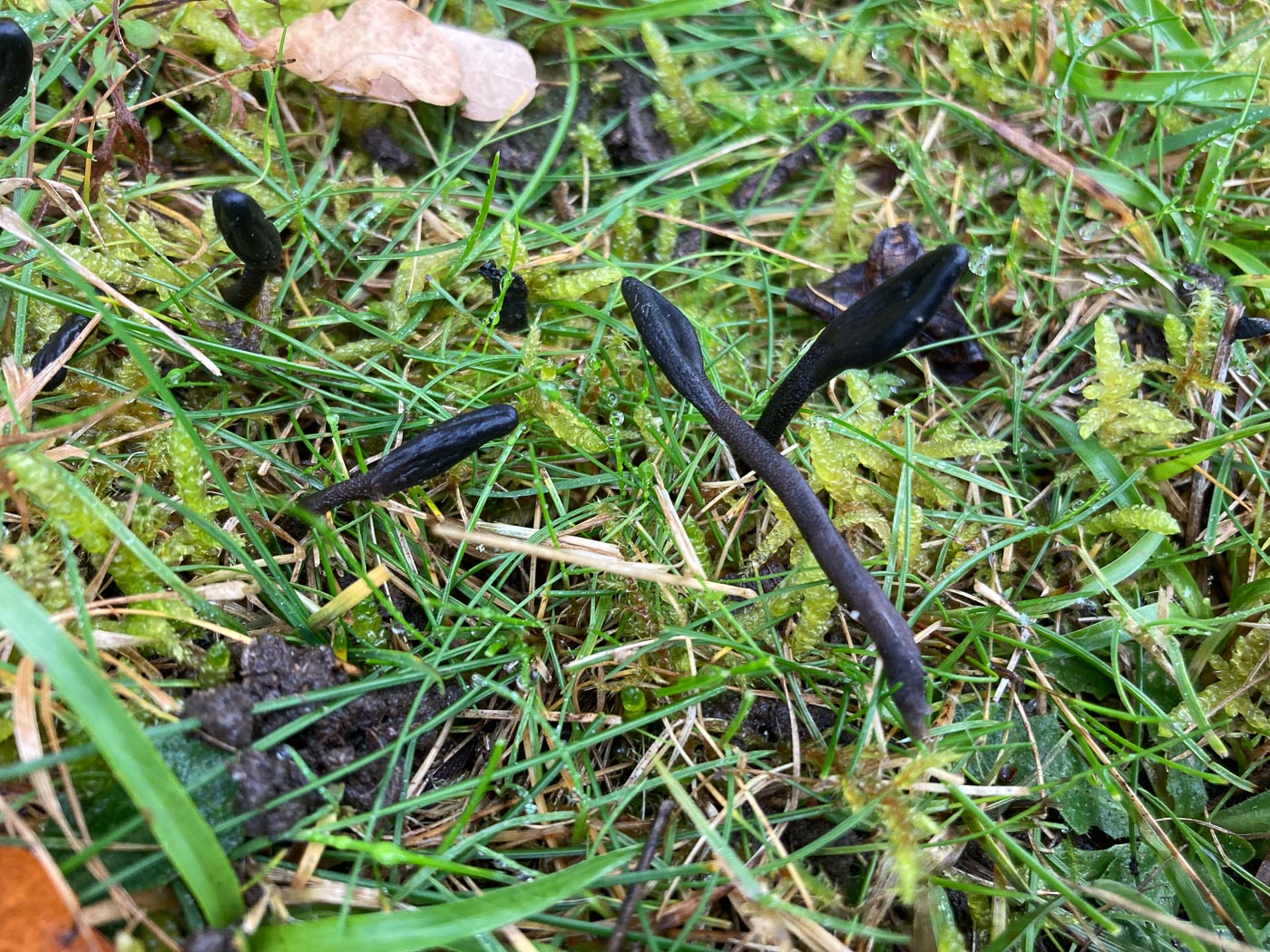
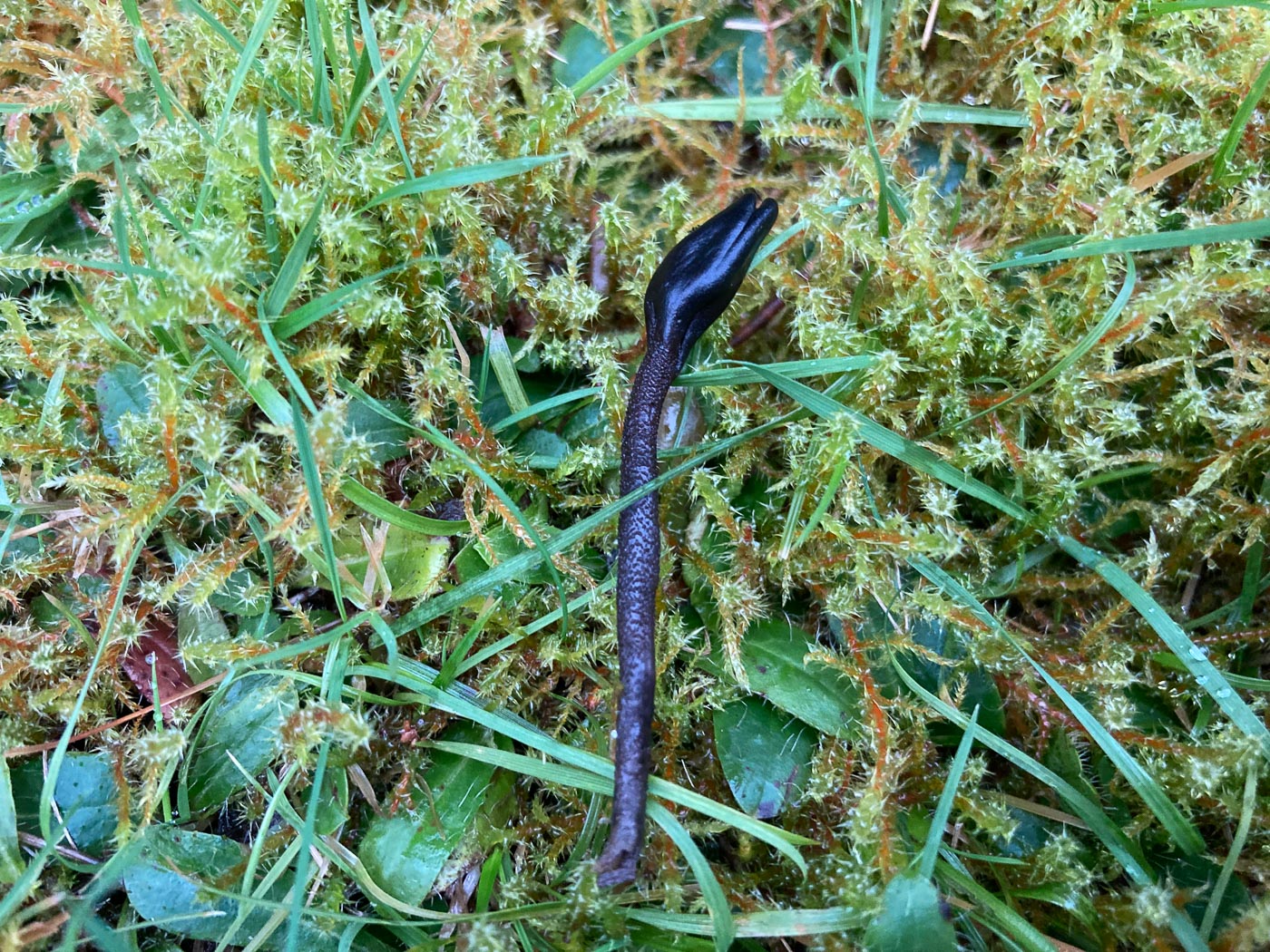
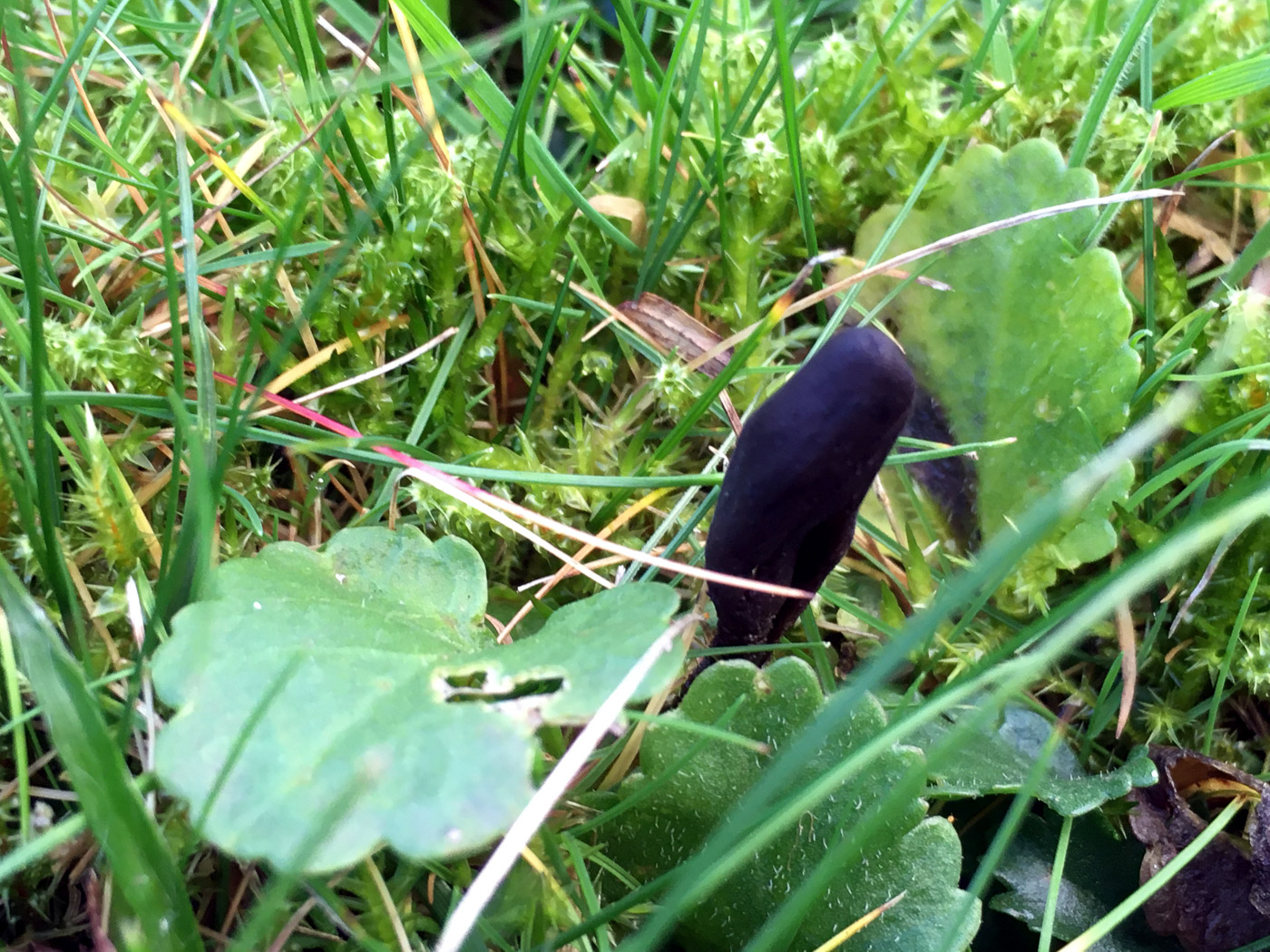
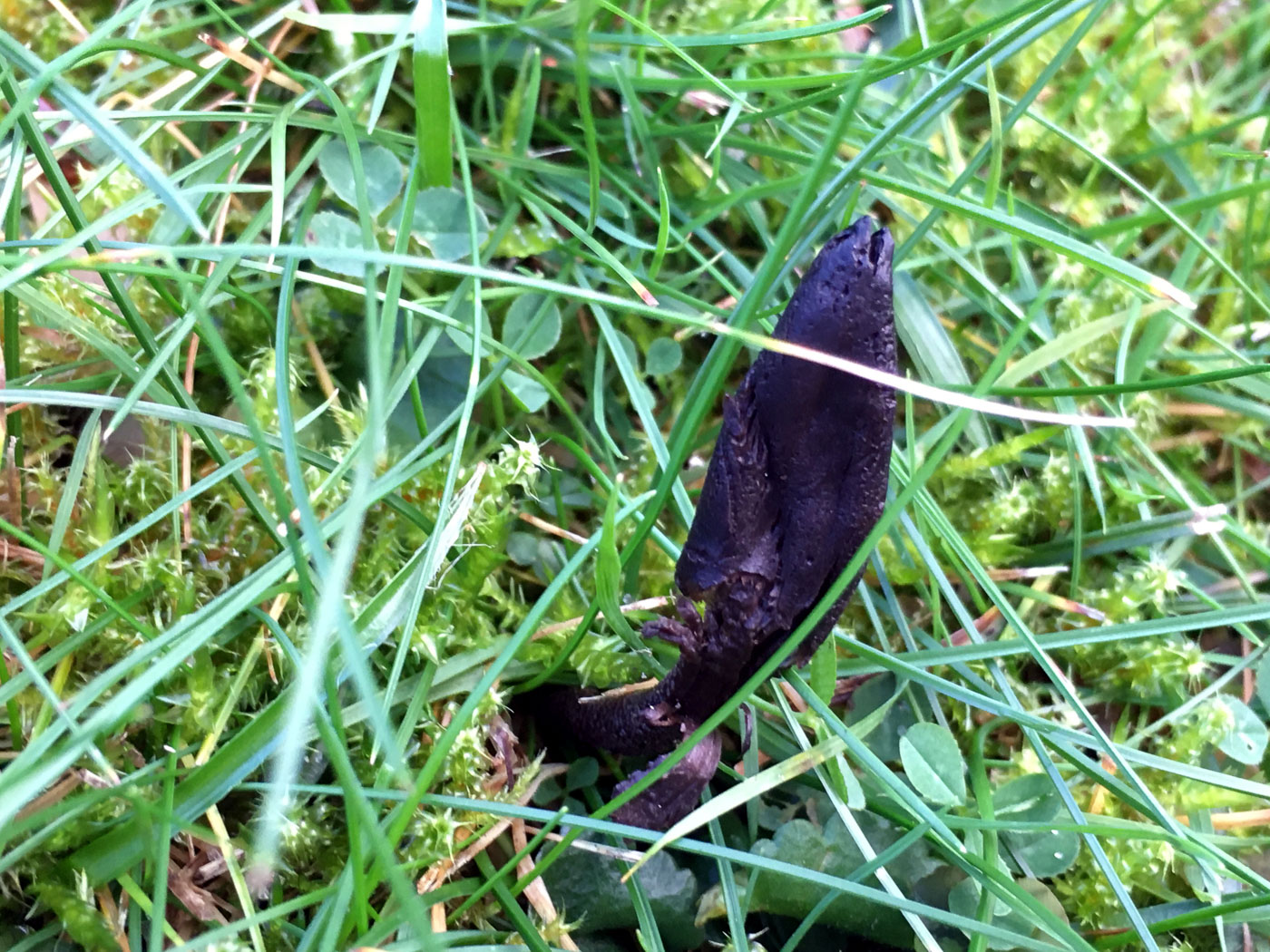
|
Geoglossum fallax Dec 10, 2023. In moss under Yew in Prestwood Churchyard Sarah Ebdon found just a few of these Earthtongues and worked on them at home to reach this ID using an online key together with the microscopic characters - always essential with this genus. In fact though we have only a handful of county records, two are from the same spot at this site which helps to confirm the accuracy of the IDs made independently. Dec 30, 2021. In Prestwood Churchyard under Yew Penny was pleased to find half a dozen of these which appear to be new to the site. It is considered one of the commonest Earthtongues (see also dated Dec 3rd) though none are found very often in the county. Today's specimens were decidedly brown, particularly on the stem which has a roughened dry surface. Dec 3, 2021. In grass in the grounds of Cliveden Estate Russell Ness found two different Earthtongues, both of which we have just a handful of previous sites recorded. See notes for G. glutinosum for more information and comparison. Nov 21, 2020. In Prestwood churchyard Russell Ness found this singleton Earthtongue in the mossy grass. These black beauties are not identifiable to species without careful work using a key and a scope, and once supplied with the necessary information Russell was able to work out which species he had. Despite the lack of common name this is apparently one of the commonest Earthtongues though only our second county record! |

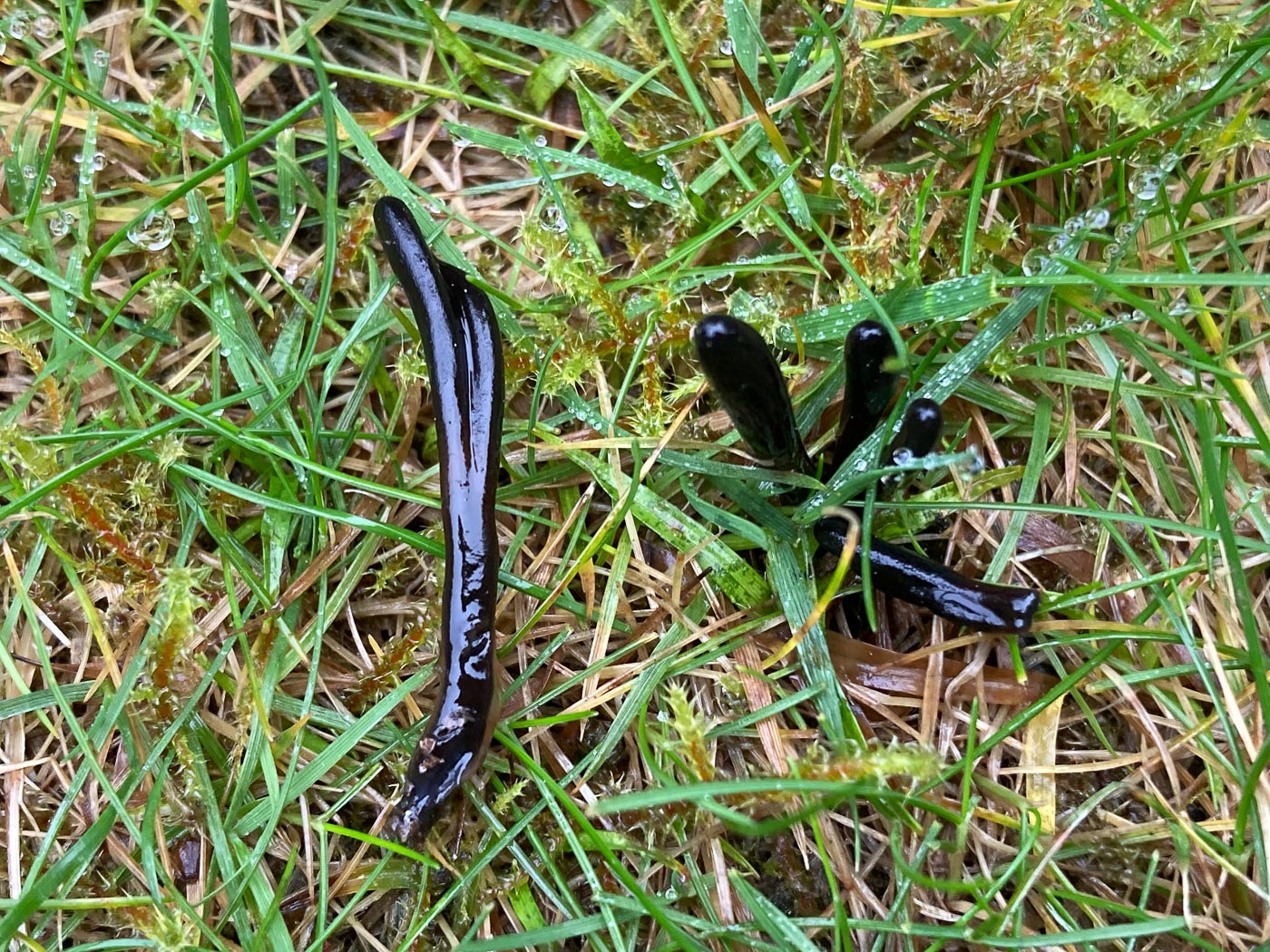
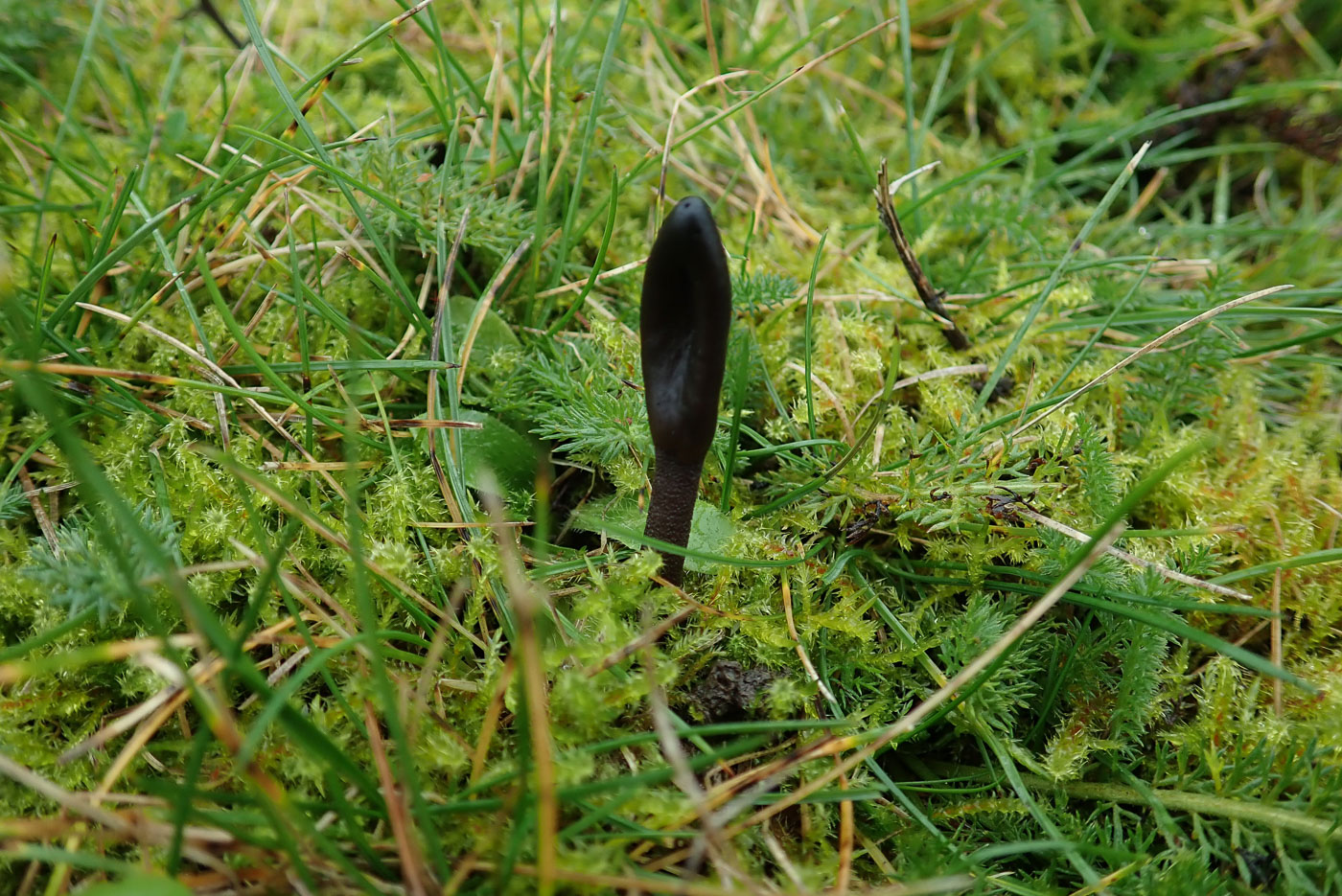
|
Geoglossum glutinosum (an Earthtongue with no common name) Dec 3, 2021. In grass in the grounds of Cliveden Estate Russell Ness found two different Earthtongues growing quite close together and therefore needing care to identify. (It is all too easy to make mixed collections when they are found growing like this if one doesn't observe subtle differences and check later with a scope!). The recent rain made the slimy smooth surface of this species obvious, in contrast to the dry scurfy stalks of G. fallax found nearby. Nov 20, 2020. Having moved from the adjacent churchyard into Stoke Poges Memorial Gardens, Penny C. found a singleton Earthtongue in a small patch of lawn and assumed that it was likely to be the same species as just found in the churchyard. Not so! Not only was the stem brownish and sticky, but a scope soon revealed very different spores and accompanying cells with no hairs present as in the Trichoglossum from the churchyard. The key was complicated but she was reasonably sure of the determination. We have only one previous county record but this probably reflects the lack of finders because it is a common species. Now is obviously a good time to look out for Earthtongues. |


 

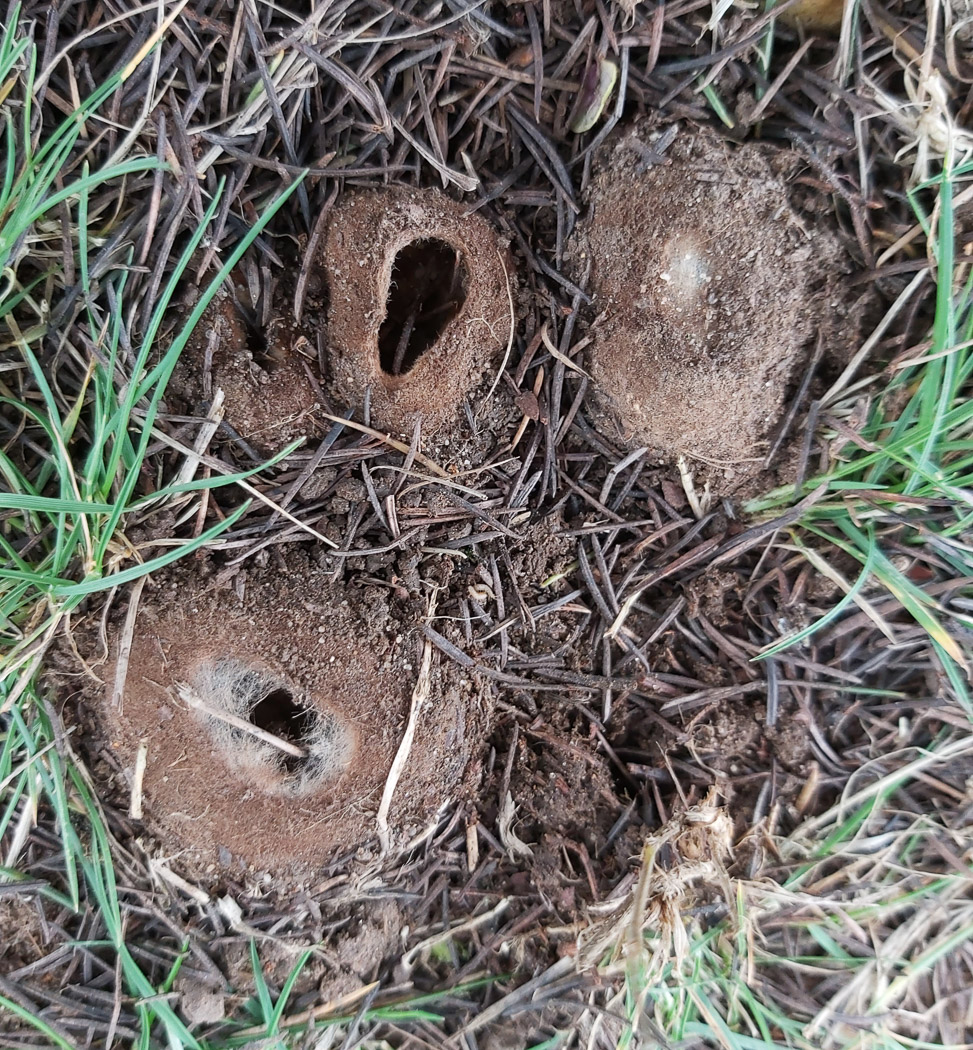
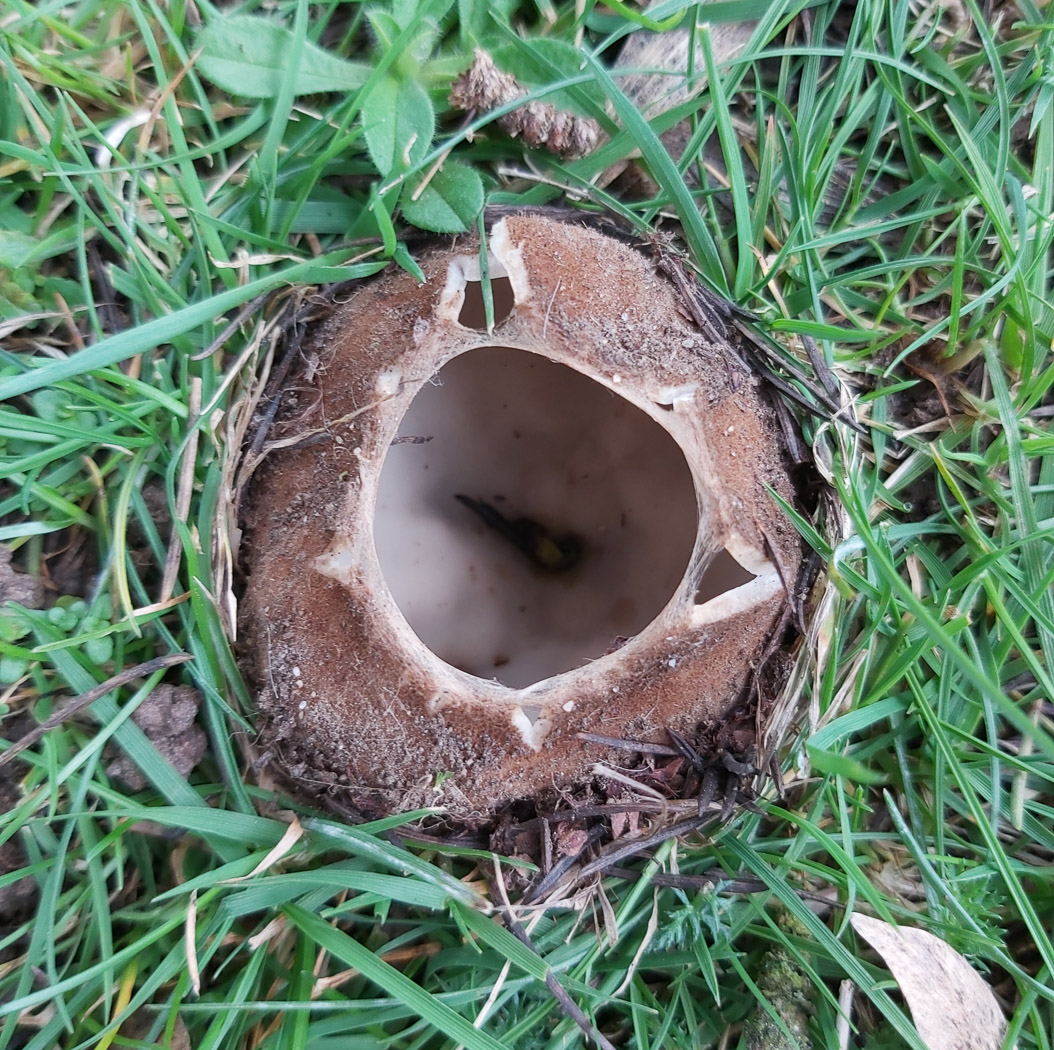 |
Geopora sumneriana (Cedar Cup) Feb 4, 2024. In Gerrards Cross under a Cedar tree not previously noted for hosting this unusual 'semisubmerged' species of Cup, Jesper Launder was surprised to find it fruiting so early in the year. A few days later he checked under another Cedar in Gerrards Cross where he'd found it before and sure enough there it was. We have under 10 county records though all are from mid to late March or April, so this is one to look out for now under Cedar. Apr 1, 2023. In Jordans Village Jesper Launder found this unusual springtime species 'going nuts' - his description! - under Cedar. These cups, distantly related to Peziza, are only found under Cedar, always partly submerged in soil, have a hairy exterior to which debris attaches and can get to as much as 7 cm across. They tend to split starlike as they expand. We only have a handful of county sites reported but it is likely to be much more common than this would indicate. It is clearly fruiting prolifically at the moment. Mar 21, 2021. Under a mature Cedar in Jordans village Jesper Launder has been on the lookout for this uncommon Ascomycete which apparently fruits here regularly. This is a springtime species, appearing from February to May, and is mycorrhizal with Cedar though Jesper comments that it is fruiting three weeks later than usual this year but now coming up in sizeable numbers (40+)! An earlier genus name for the species was Sepultaria, describing its habit of remaining submerged in soil and not showing above the surface until the brown hairy sphere splits open in a starlike fashion to reveal the pale cream spore bearing inner surface. Fruit bodies can get to about 6 cms across. We have just four previous county records but the species is probably much more widespread than this would indicate but just overlooked. So one to look for now if you live near a mature Cedar. |
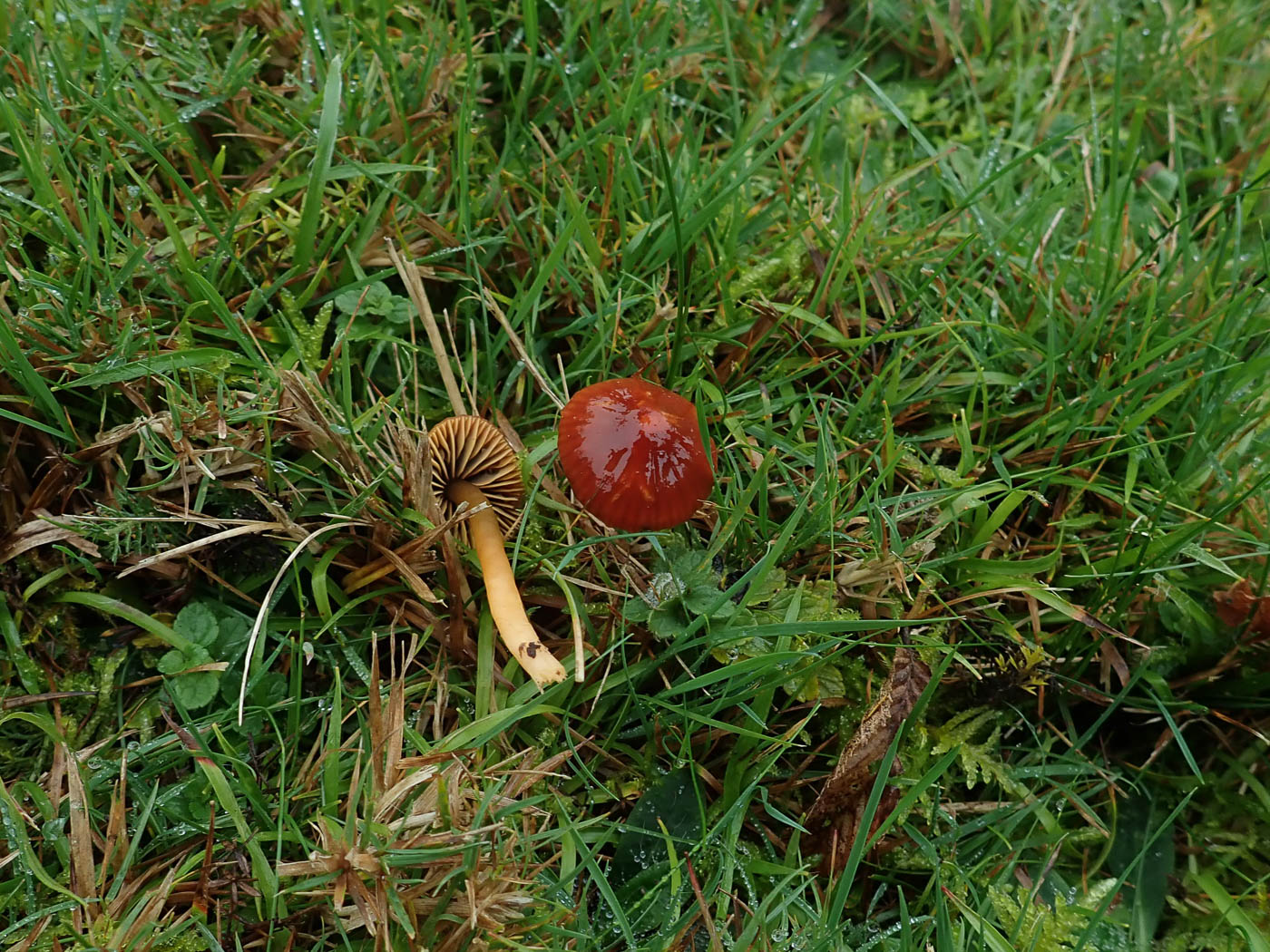 

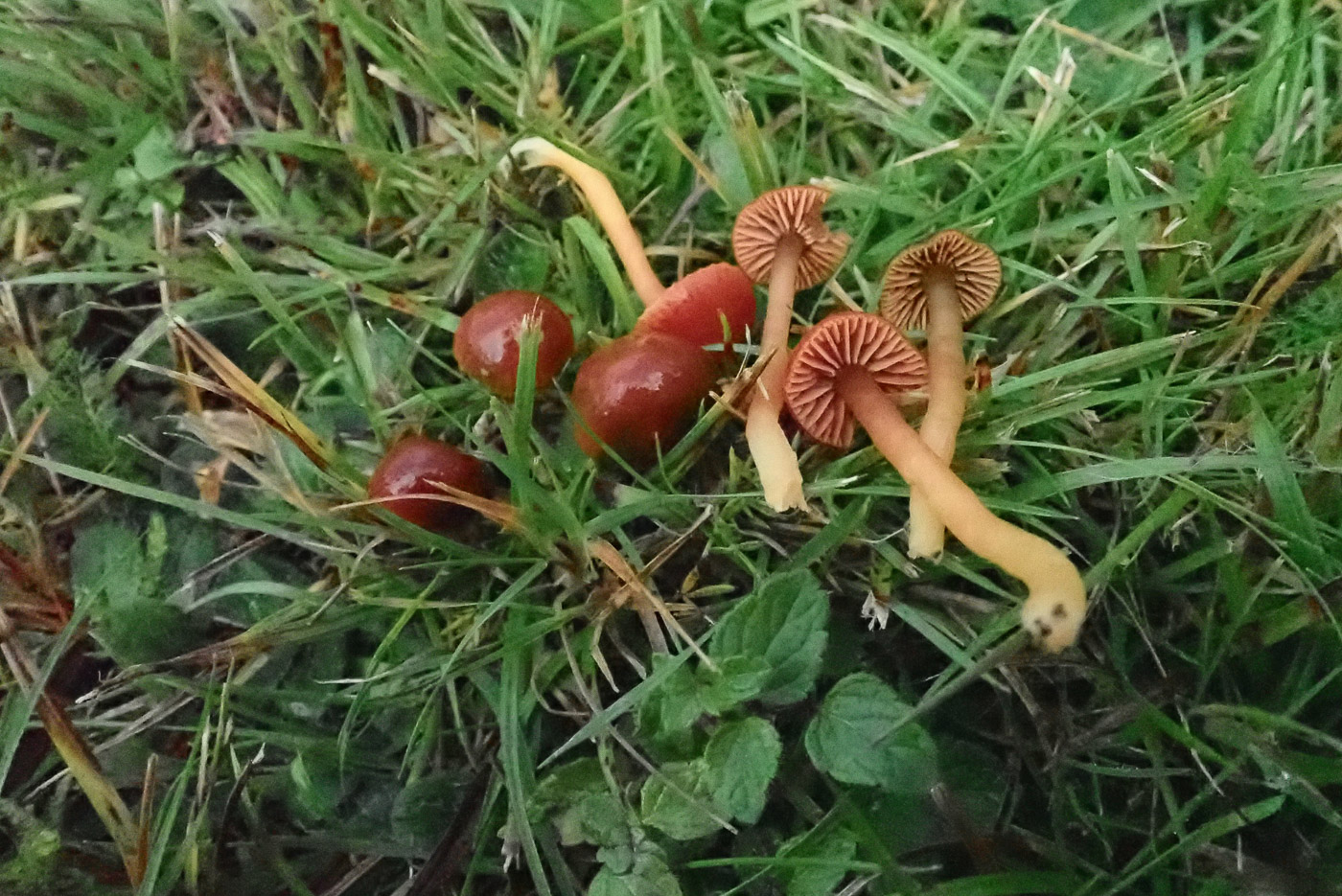
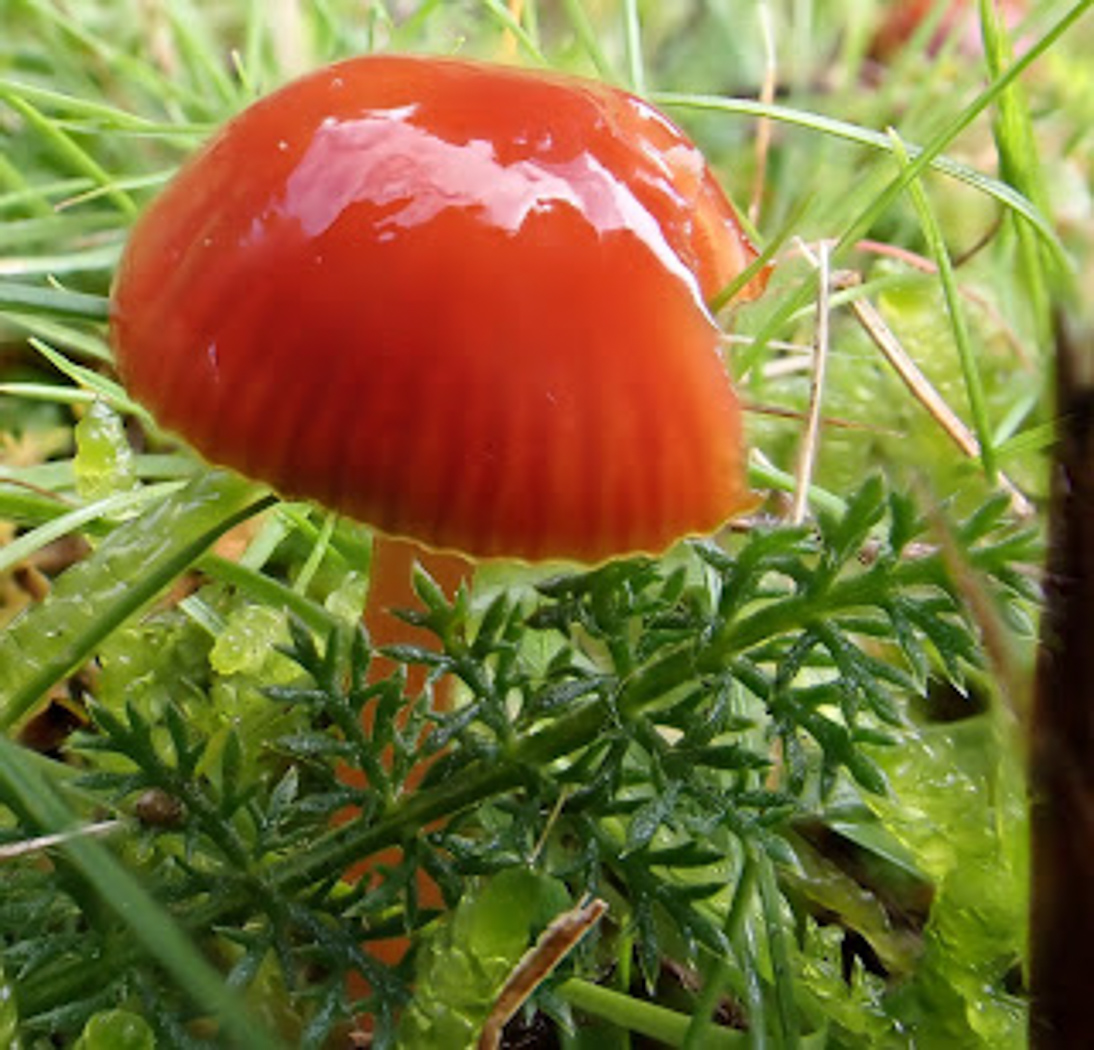
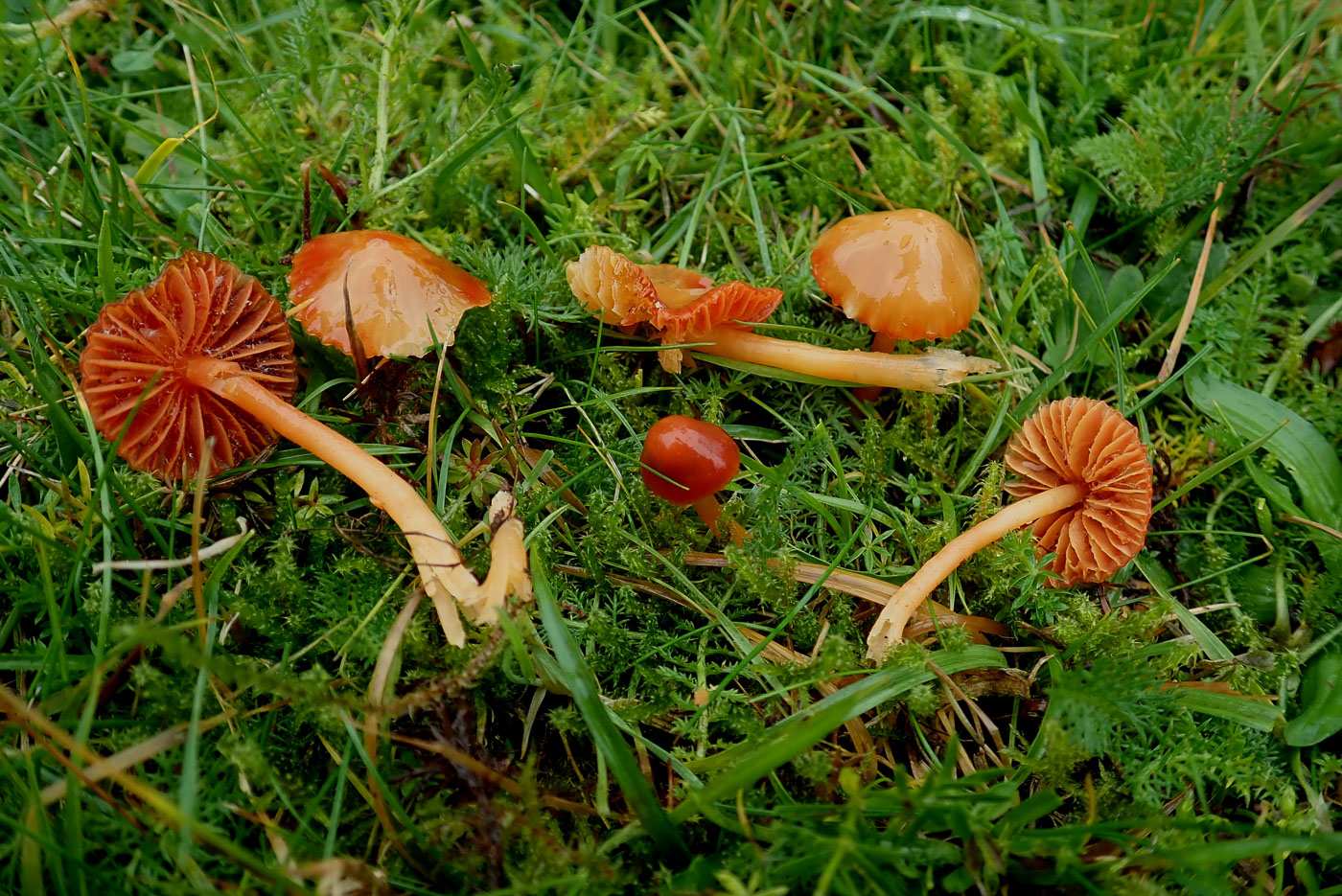
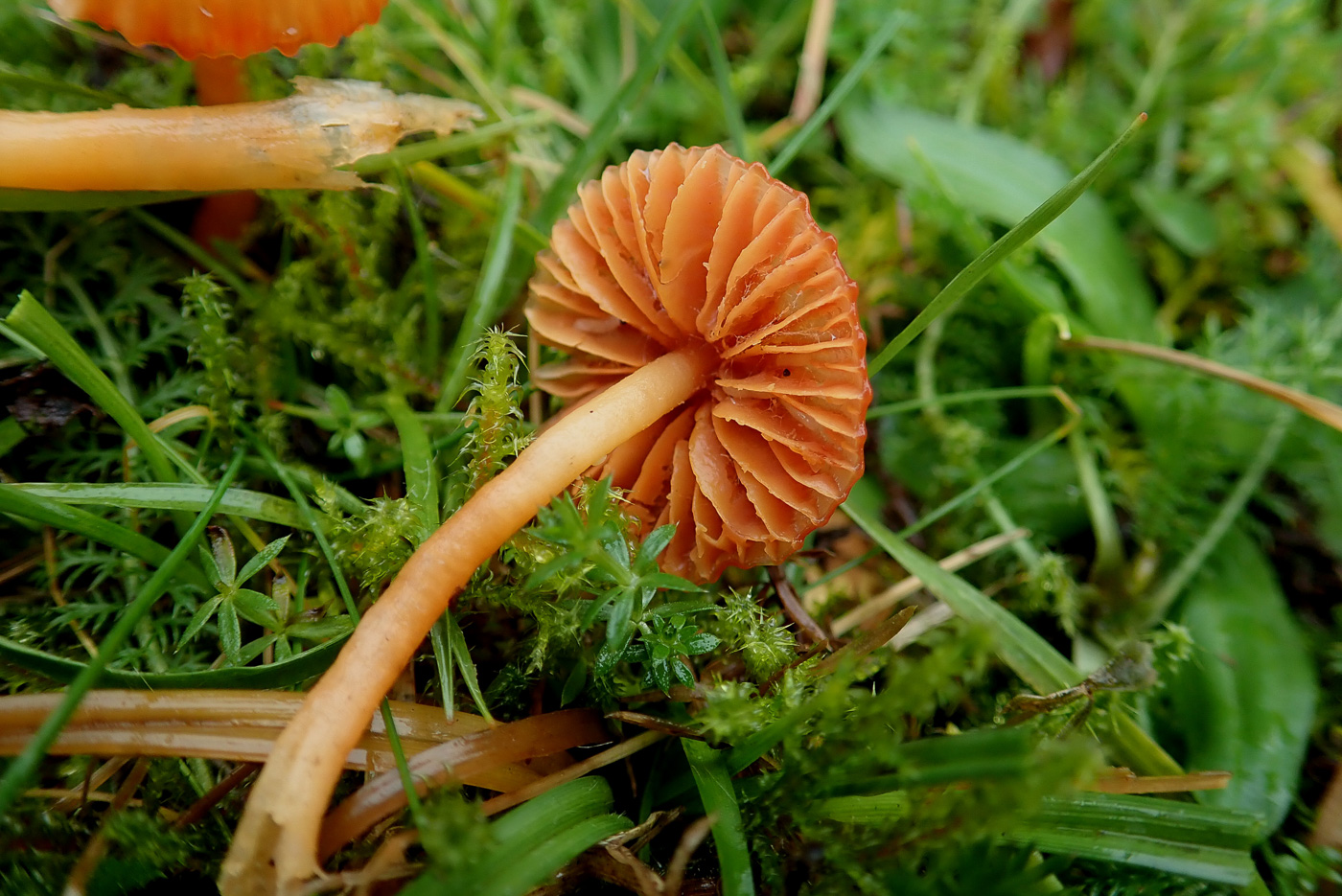
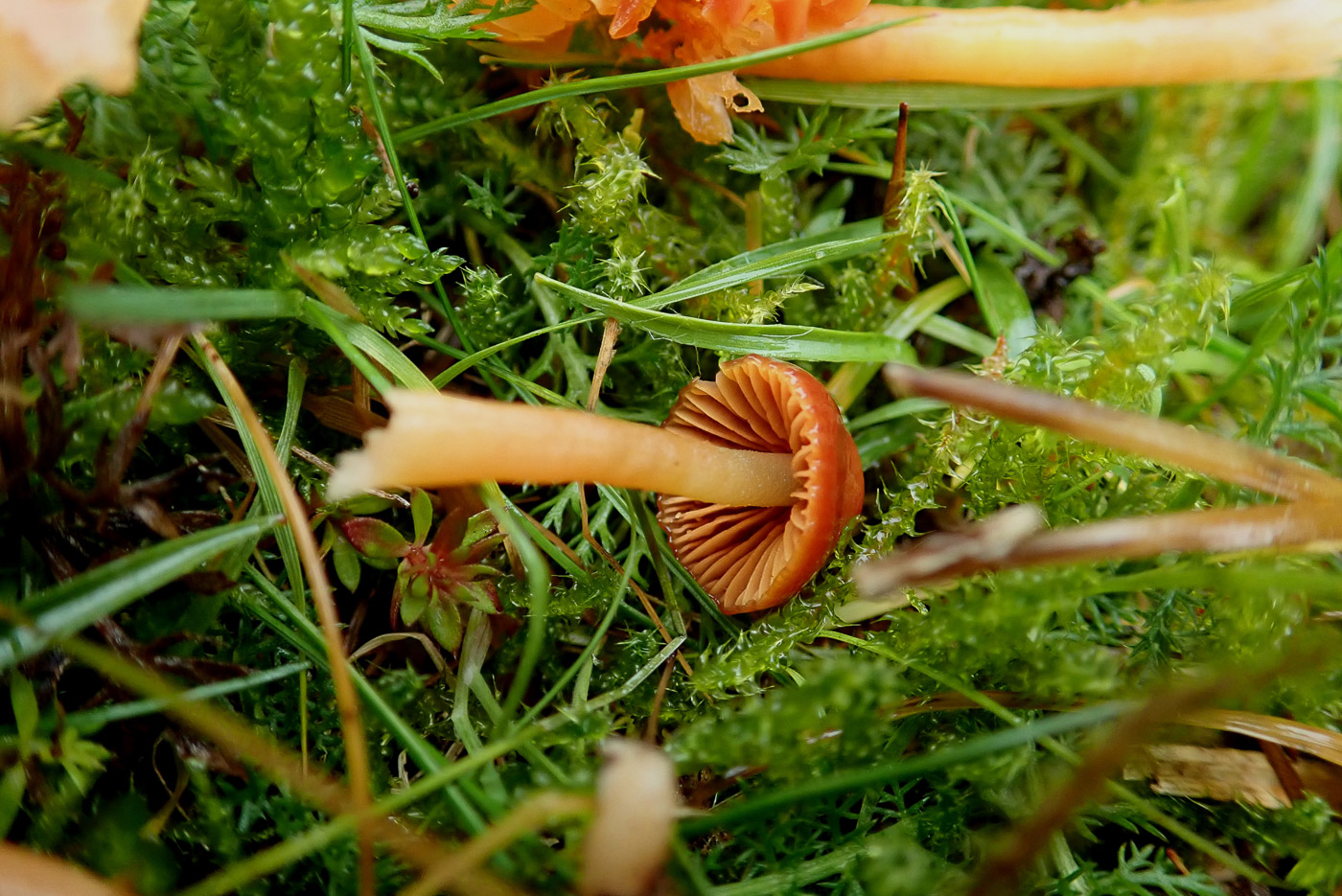
|
Gliophorus aff. europerplexus (Butterscotch Waxcap) Nov 7, 2024. In St Giles Churchyard Stoke Poges, Penny went to check if this rare species - found here several times in the last few years - was by any chance fruiting at the moment. Success! There were just these two unmistakable and slimy fruitbodies showing their distinctive colour in cap, gills and stem though there was just a hint of green in one of the caps shedding a little doubt because it is thought that the 'psittacina'-like green should be absent. However, Jackie Ewan has also found this same species at Stampwell Farm showing hints of green and we'll get both samples sequenced to aid Martyn Ainsworth at RBG Kew in his research to determine whether this UK species is the same as those found in Europe or maybe a unique as yet unnamed Waxcap. Watch this space! Nov 2, 2023. When Penny visited St. Giles churchyard Stoke Poges last week she was thrilled to find this species fruiting here again. See her entry (October 24th) for more details. Luckily it was still in evidence here today when our large group were able to see and admire it. The rusty copper colour is unique within the genus. The photo is Claire Williams's. Oct 24, 2023. In St Giles Churchyard (adjacent to Stoke Poges Memorial Gardens) Penny was delighted to find this distinctive species fruiting in the same spot where she first found it back in 2020. Having checked with Martyn Ainsworth at RBG Kew, she finds that this species - known to be close to G. psittacinus (Parrot Waxcap) though with the appearance of G. europerplexus but not with a matching DNA sequence to that species - is still to be officially described. Therefore for now it remains G. cf. europerplexus but is known from only a very few UK sites. Oct 25, 2021. In St Giles Churchyard, Stoke Poges, Penny's target species was this distinctive little Waxcap which she found here last year, and we were lucky enough to find it in exactly the same spot! Illustrated in Kibby vol1 p18 as G. sciophanus (apparently an invalid name) it is one of the psittacina complex - still in the process of being unravelled with DNA at RBG Kew. Similar to but different from G. europerplexus, its cap colour is vivid rusty red and it lacks any green tints which are always present in G. psittacina at the stem apex if nowhere else, but like all in this genus it is slimy all over. This is definitely one to look out for now in churchyards or unimproved grassland. Photo one is Penny's; photo 2 is Stephen Plummer's Nov 20, 2020. In St Giles Churchyard Stoke Poges, Penny C. found amongst many Waxcaps a collection which was unfamiliar to her and an unusual colour. All but one specimen were somewhat deteriorating but it was clear that the smallish bright cinnamon rusty orange conical caps with outer half slightly translucently striate were very slimy, as were the stems. She wondered about Gliophorus laetus as a possibility but the adnate gills lacked the glutinous edge of that species; she also noted that there was no hint of green which would have pointed to G. psittacinus. At home the spores were similar to those of G. psittacinus, however, and turning to the descriptions of that species she was reminded of the two rare varieties which were raised to species level in 2014. Today''s collection appeared a good match for one of these: G. europerplexus, but confirmation by DNA sequencing was clearly called for. However, the resulting sequence (received in Jan 2021) showed a close match to G. sciophanus, another extremely rare species in the psittacinus complex and not yet established as on the British list. |
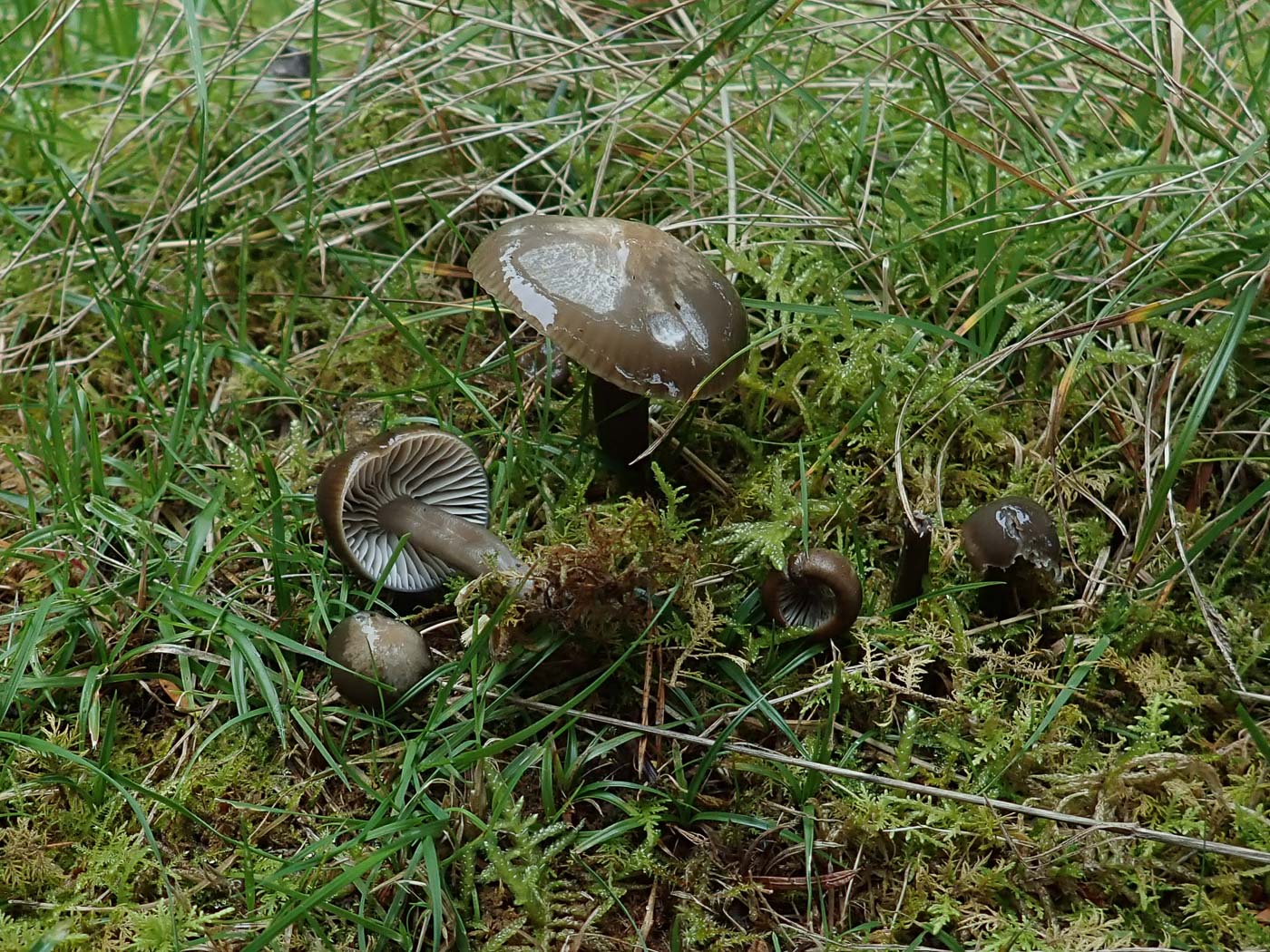 

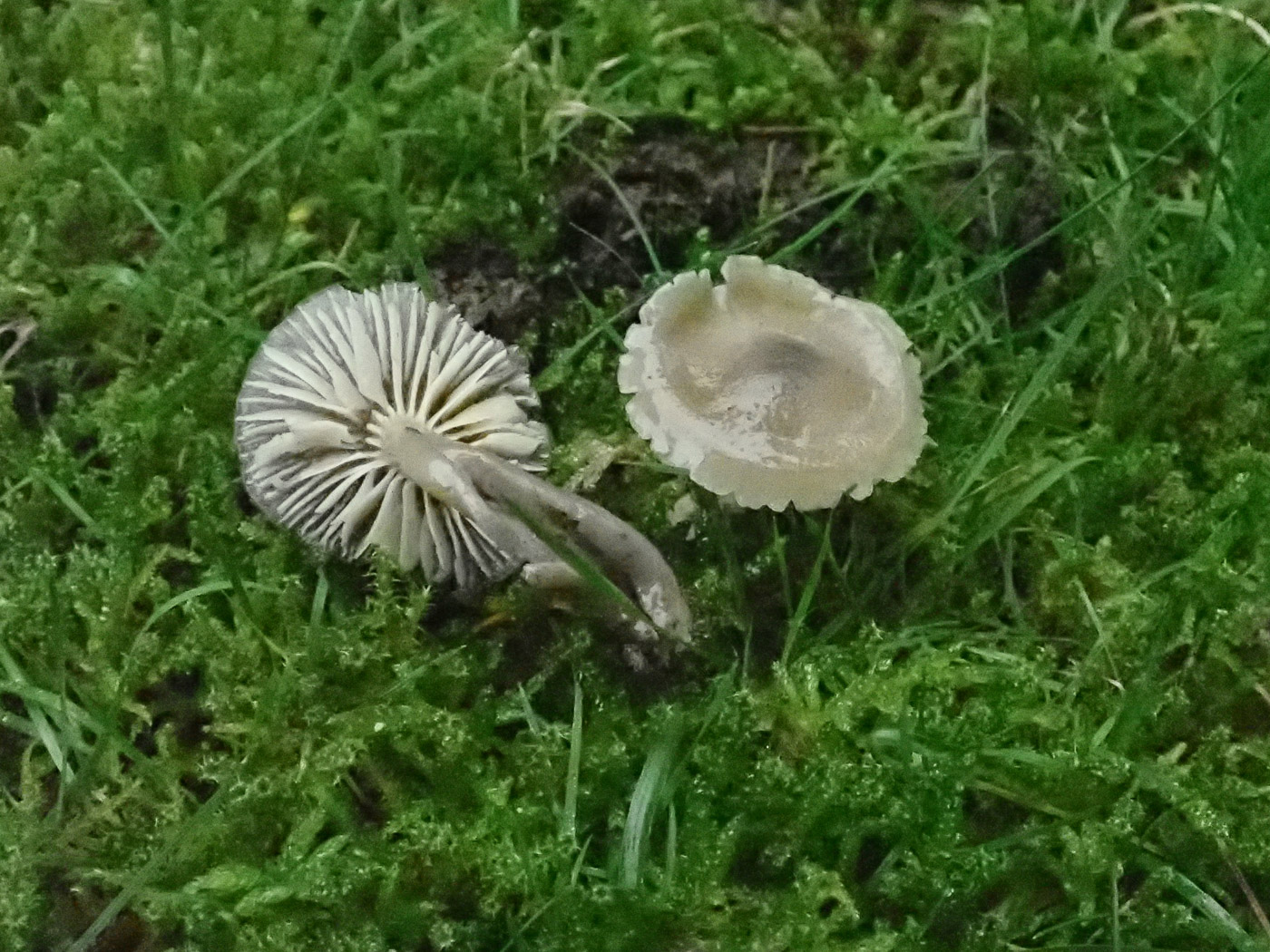
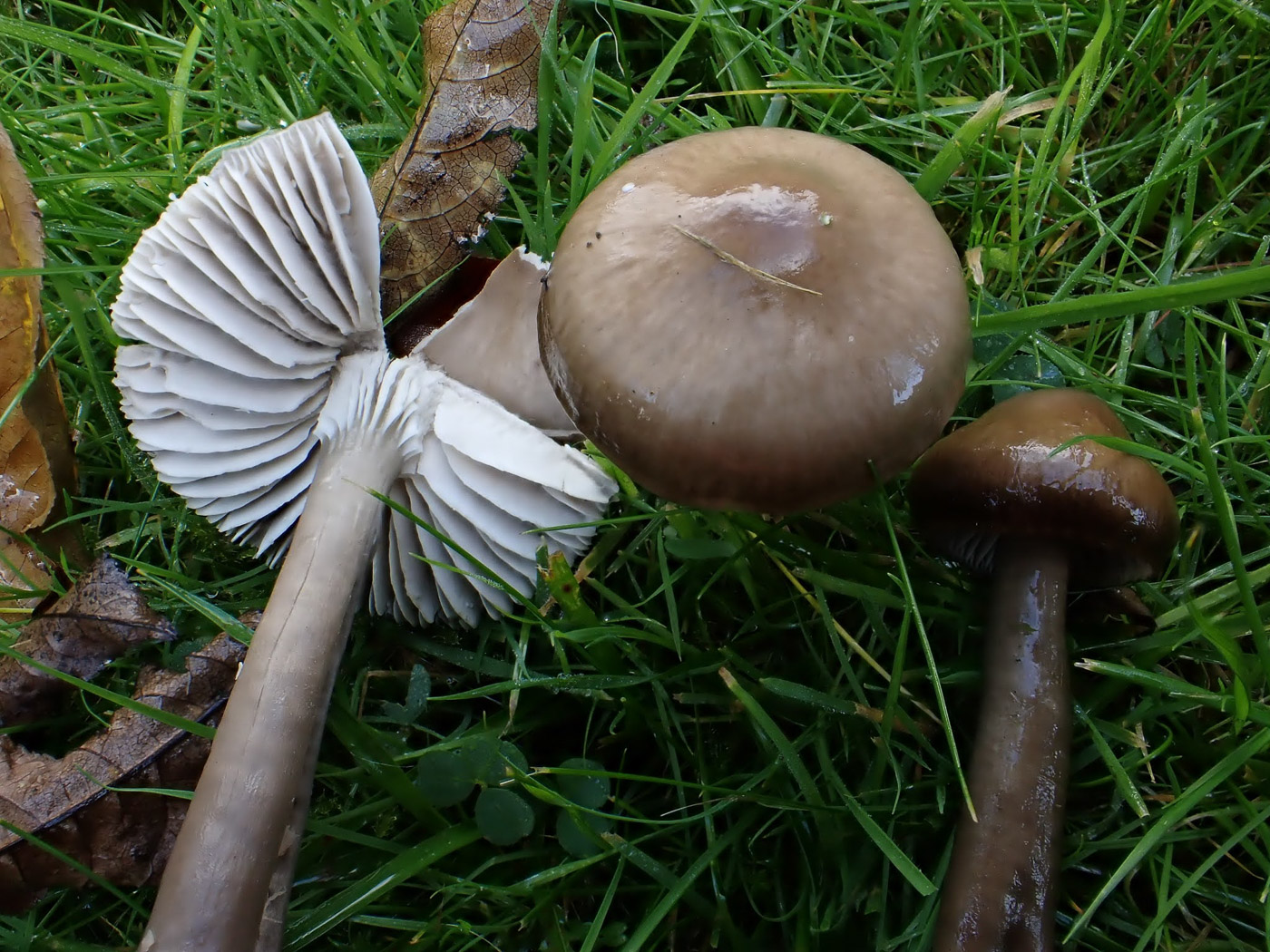
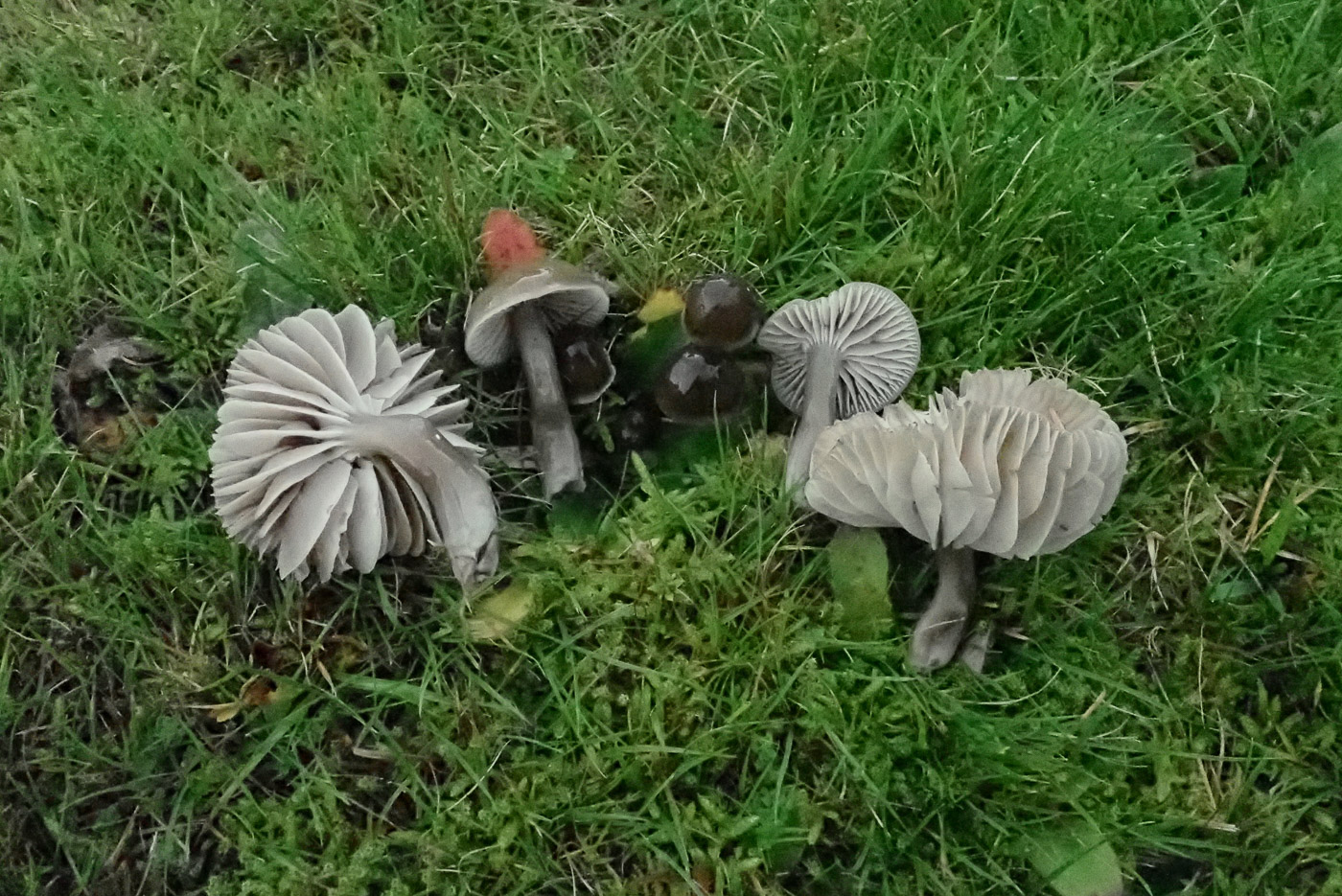 |
Gliophorus irrigatus (Slimy Waxcap) Nov 5, 2024. At Prestwood Churchyard Penny and Sarah found several patches where this extremely slippery species was coming up. It may be dull grey brown in colour but what it lacks in brightness it makes up for in sliminess, proving difficult to collect as even the stem resists on gripping it! All the waxcaps now residing in this genus have slimy caps and stems but this one really deserves its English name. Oct 24, 2023. In longish grass at Stoke Poges Memorial Gardens Penny found several of these dull grey-capped and very slippery Waxcaps - so slippery it was tricky to pick them up! The species is by no means alone having this trait: all members of this relatively newly created genus of Waxcaps have slimy caps and stems though perhaps these are the slipperiest after rain. Photo 2 is of a collection made three weeks later from Prestwood Churchyard where this species is amazingly common. Dec 30, 2021. In Prestwood Churchyard Penny also found this Waxcap still fruiting (more familiarly known as Hygrocybe irrigatus) though only just these two fruitbodies were found. In the last couple of months it has been quite prolific at this site which is now well known in the area for fungal interest. Oct 25, 2021. In St Giles Churchyard, Stoke Poges, a group of us found several nice Waxcaps including this species, previously known as Hygrocybe irrigata. It is entirely slimy, both cap and stem, especially after rain when it it hard to pick up! When older it fades and loses some of the stickiness. Photo 1 is by Stephen Plummer. Photo 2 is of a further collection made at Prestwood Churchyard by Penny on Oct 30th. |
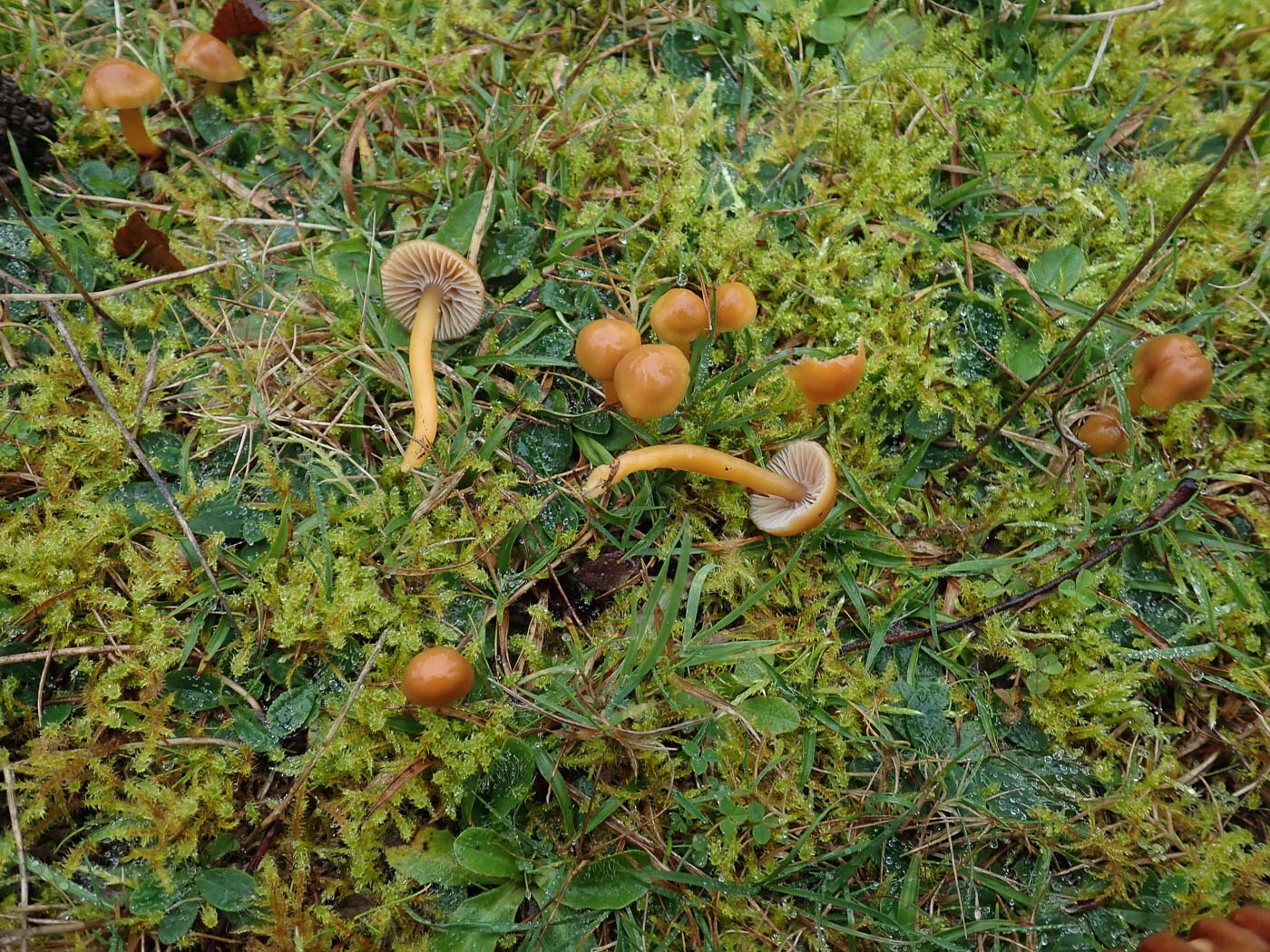
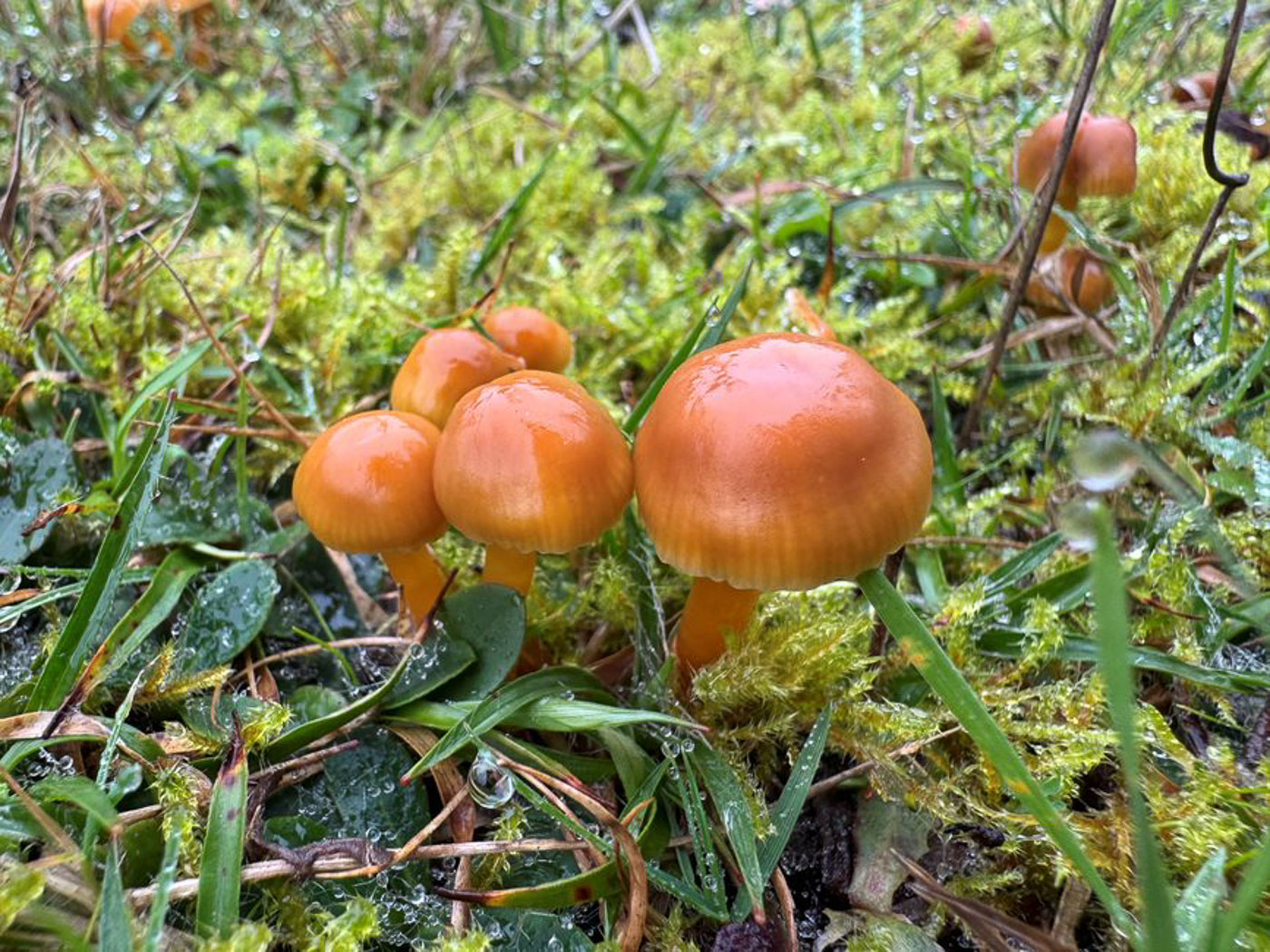 
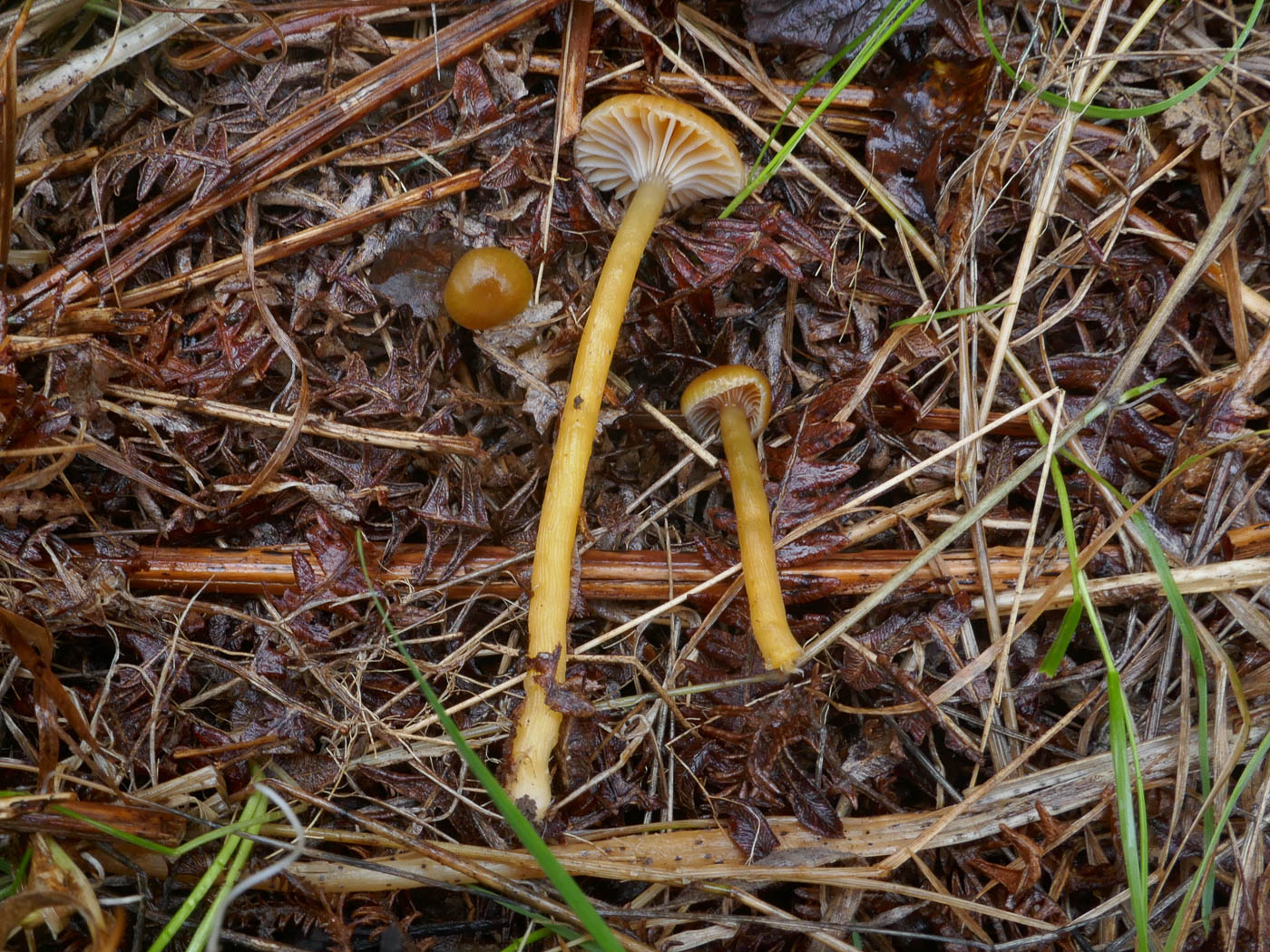
 |
Gliophorus laetus (Heath Waxcap) Nov 7, 2024. At Stoke Poges Memorial Gardens our large group were pleased to see this species, new to the site, coming up in good numbers. Similar to G. psittacinus (Parrot Waxcap) which we also saw here today, it is slimy all over but lacks any green - even at the stem top - as in that species and also has a gelatinous coating on the gill edge which with care can be lifted away from the gill with a pin. (Sadly Penny didn't have a pin to hand!). The species is uncommon and though we have quite a few county records these are only from two or three other sites. Photo 1 is Penny's, photo 2 is Leguih McMahon's. Nov 25, 2023. At Stampwell Farm Jackie Ewan found this unusual Waxcap still fruiting - this one was not on show when BFG visited in late October. This site sports a lengthy list of Waxcaps and this is one of the less common species here. Previously in genus Hygrocybe, like others now moved to genus Gliophorus it has a layer of slime over both cap and stem but uniquely has a gelatinous line along the gill edge which with care can be removed intact with a pin! If in doubt this is a useful diagnostis character. Oct 27, 2022. At Stampwell Farm - though we missed this species on our walk there the week before - this quite unusual grassland species is now just beginning to appear, found by Jackie Ewan. We only have a few sites where it is known, this being one of them where it seems to be a regular now. See the Masterlist for more images. Oct 8, 2021. At Stampwell Farm in a grassy area Jackie Ewan found this quite unusual Waxcap (previously in the genus Hygrocybe). It is similar to the familiar G. psittacina (Parrot Waxcap) having both a slimy cap and stem, but lacks green shadesand also has a gelatinous layer along the gill margin which with care is removable with a pin! |
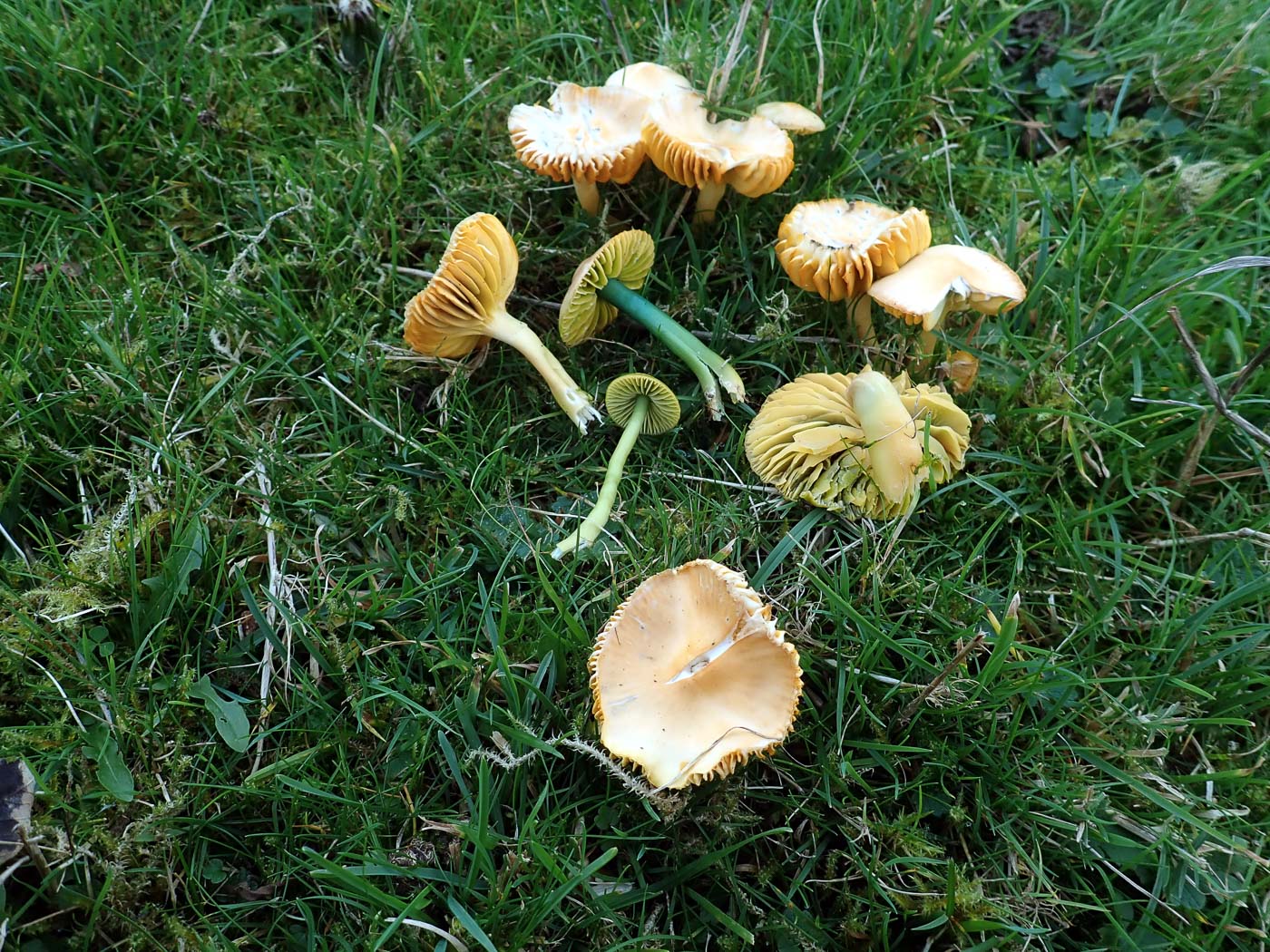 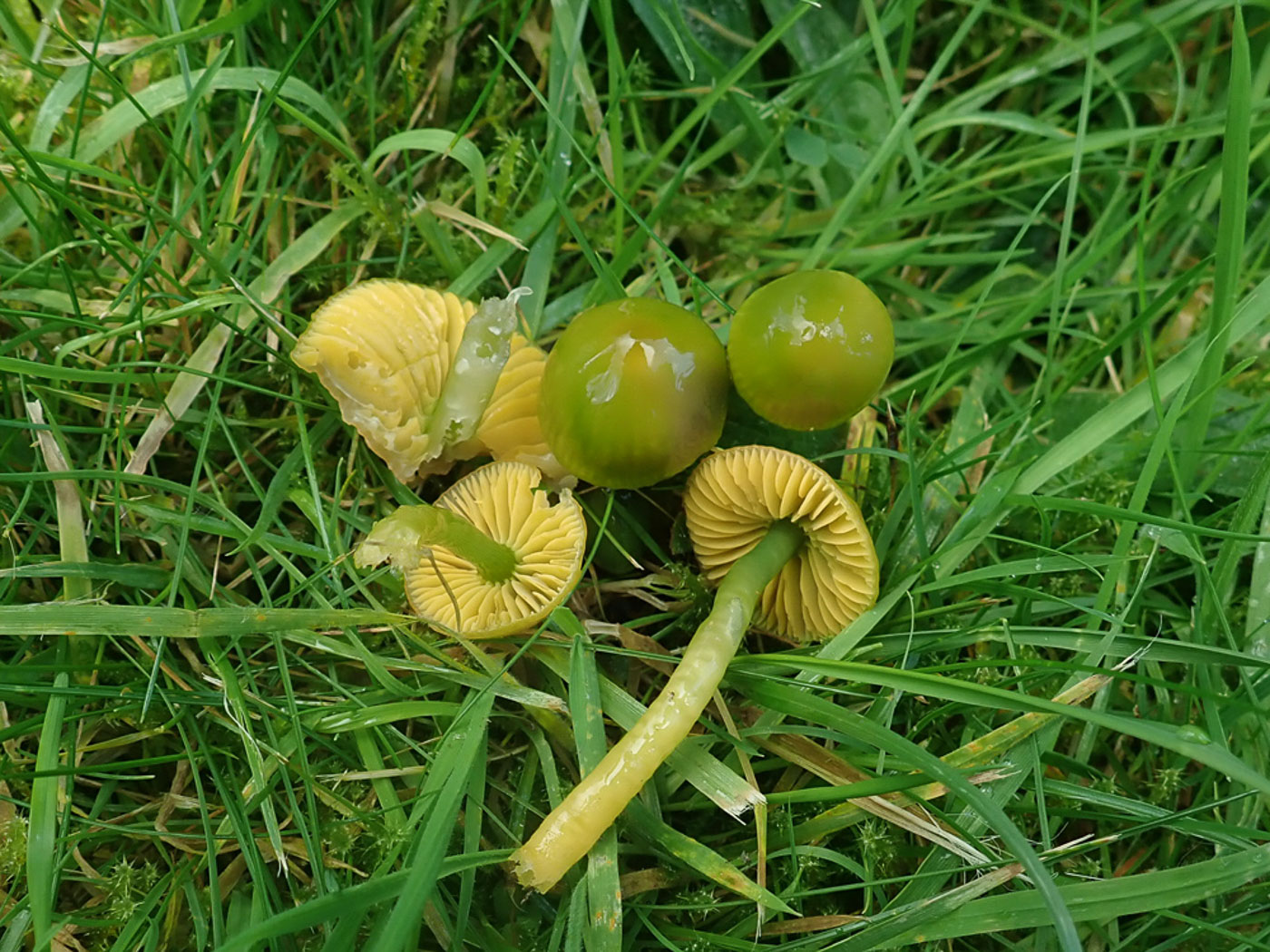 
 




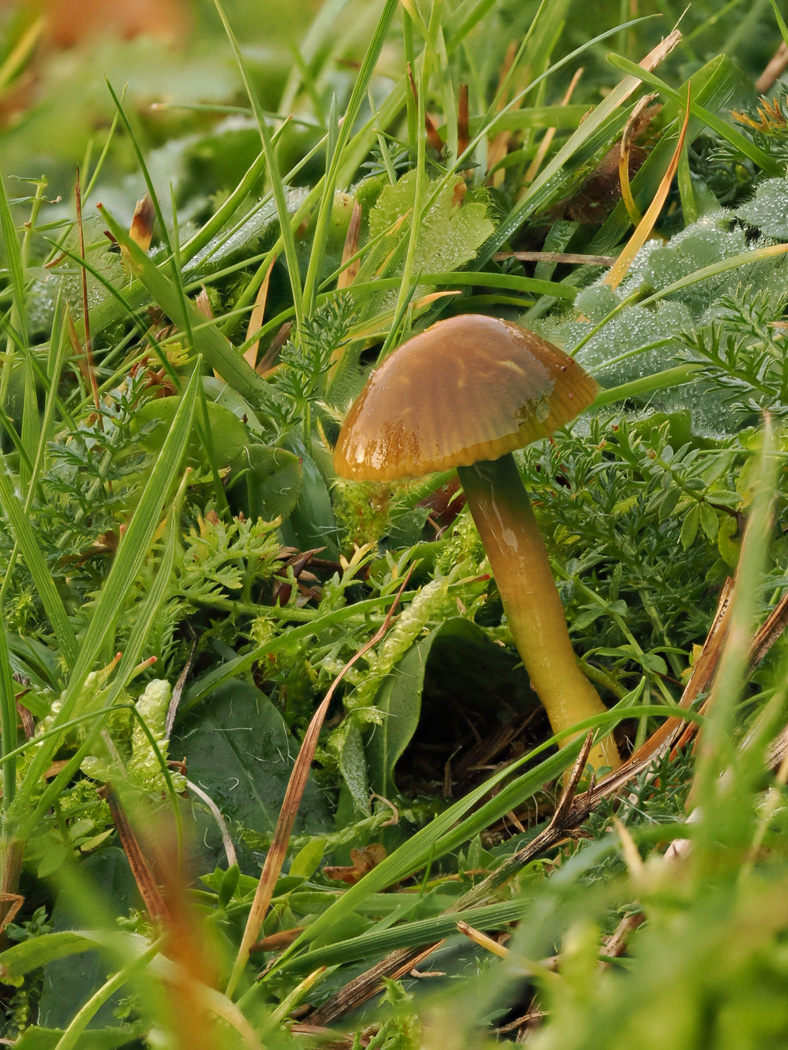
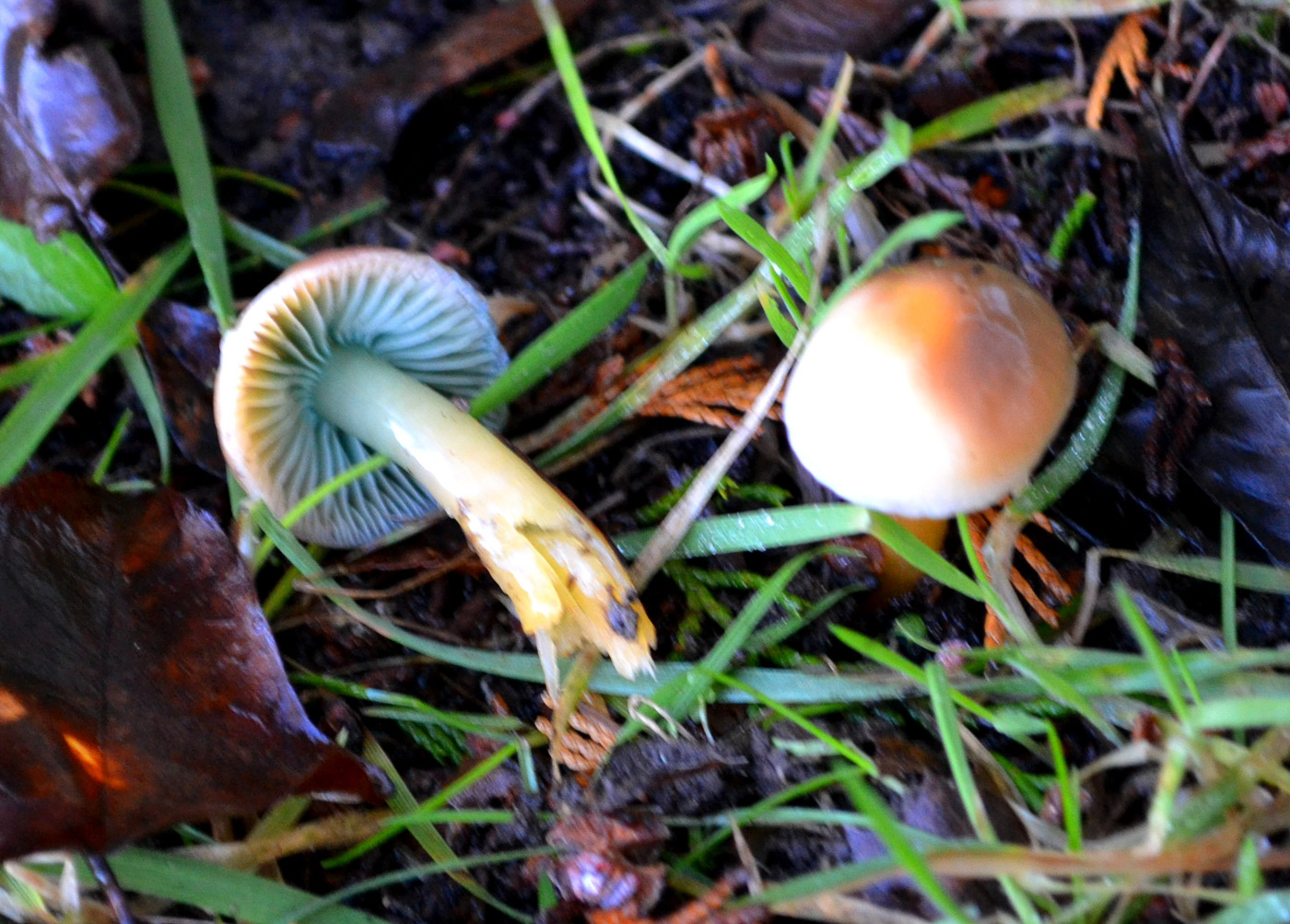
|
Gliophorus psittacinus (Parrot Waxcap)
Nov 14, 2024. Near the monument at Coombe Hill Penny noticed these large yellow caps (4-5 cm across) which proved to be Parrot Waxcaps - a common species but what was unusual about them was their size and the lack of green even at the stem apex on several specimens. They were suitably sticky and enough of them were indeed showing the typical green to remove any doubt but she felt it was worth including here as an example of how varied the species can be. Oct 7, 2024. At Prestwood Churchyard this nice fresh collection was one of several waxcaps found here by Penny today. It was suitably slimy after a recent shower and the green caps and stem apices left no doubt as to its identity - one of our commonest but most pleasing grassland species to find. Mar 26, 2024. If we in Finds used another colour to indicate entries of species fruiting out of season we'd have a veritable rainbow here! This is yet another that would qualify, found by Jackie Ewan at Stampwell Farm - a site now renowned for its Waxcaps, but not in March, furthermore she found Hygrocybe ceracea here a couple of week ago (see Finds March 16th). Remarkable! Oct 17, 2023. In grass at Prestwood Churchyard Penny found various groups of this charismatic Waxcap - one it's difficult to resist getting the camera out for! The caps were somewhat varied in colour, as they often are, but the distinctive grass green even if missing from the cap is always apparent in the top half of the stem to confirm if there's doubt over its ID. Furthermore, like all waxcaps now moved to genus Gliophorus, it is slimy all over. Apr 18, 2023. Jesper Launder was somewhat surprised to come across this Waxcap in a damp grassy verge in Gerrards Cross - not what you'd expect to find at this time! We have the odd record for January (presumably hanging on from the end of the Autumn season), also one for July (presumably starting early for the next Autumn), but nothing for the intervening months. Photo 2 is of yet another collection made on May 8th at Gt. Brickhill Churchyard by Justin Long. We have quite a few nice images of this species (previously in Hygrocybe) in Finds - see the Masterlist. This is surely a sign of our seasons getting much more interchangeable and unpredictable with the resulting confusion amongst many organisms - we live in strange times .................. Dec 6, 2022. Having failed to find this common Waxcap in the adjacent Stoke Poges Memorial Gardens, Penny and Claire Williams moved into St Giles Churchyard where Claire found just this single rather brown specimen. The green tints at the stem apex left no doubt as to its identity, however. Jan 1, 2021. On his daily walk around Prestwood Tony Marshall noticed these fresh but frosted specimens but had no camera at the time! Returning the next day for the photo he found them thawed but now very faded, as often happens when Waxcaps are frosted - they're colours can change radically adding to the difficulty of identification. |


 

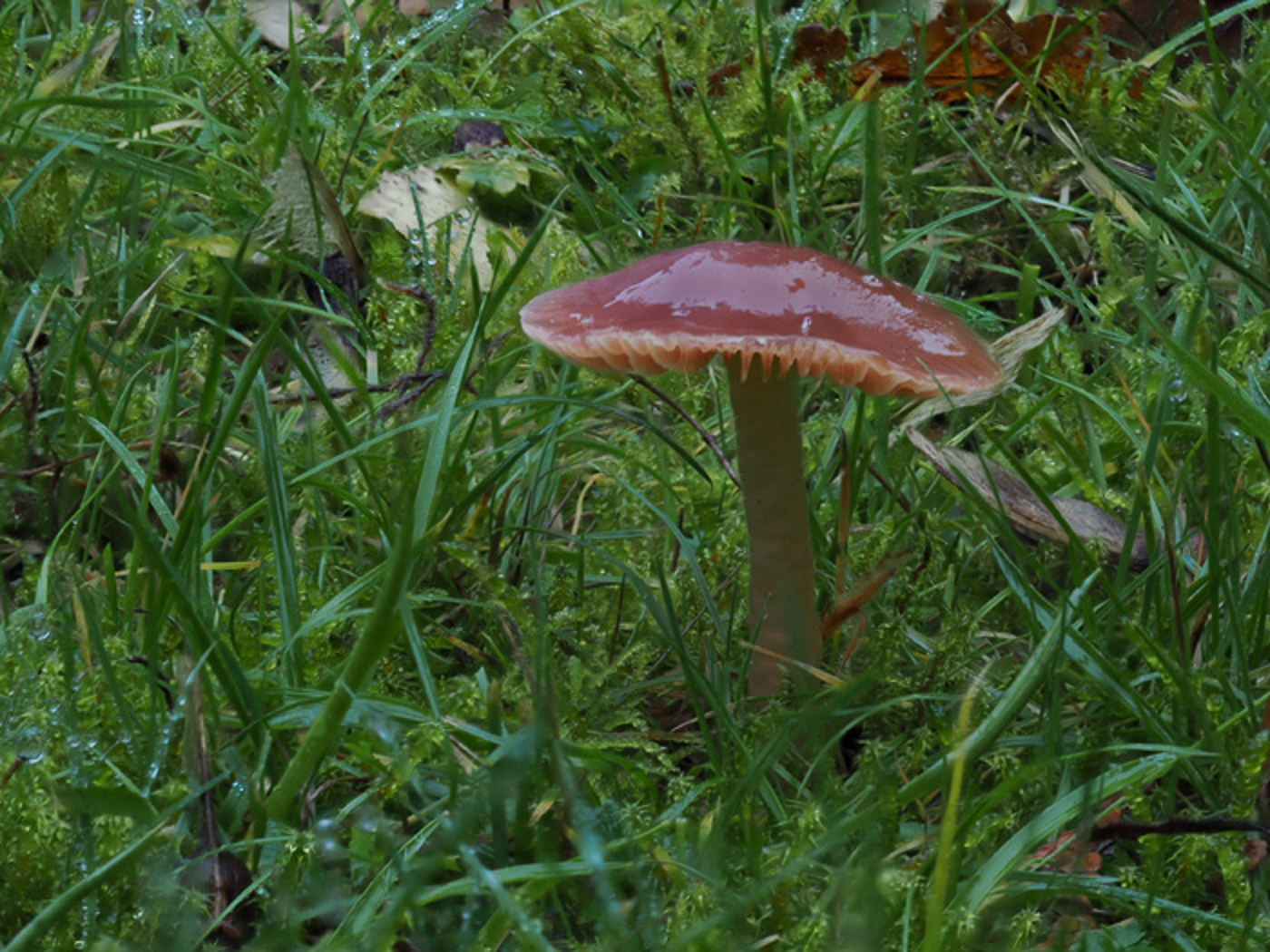

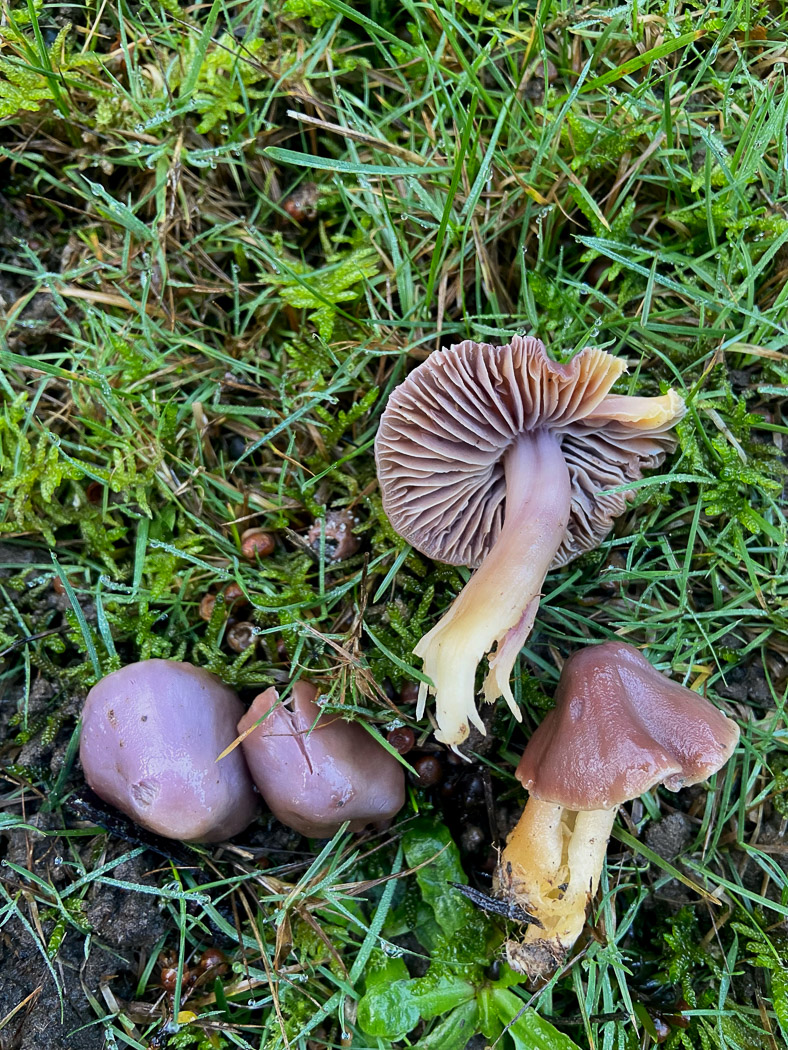
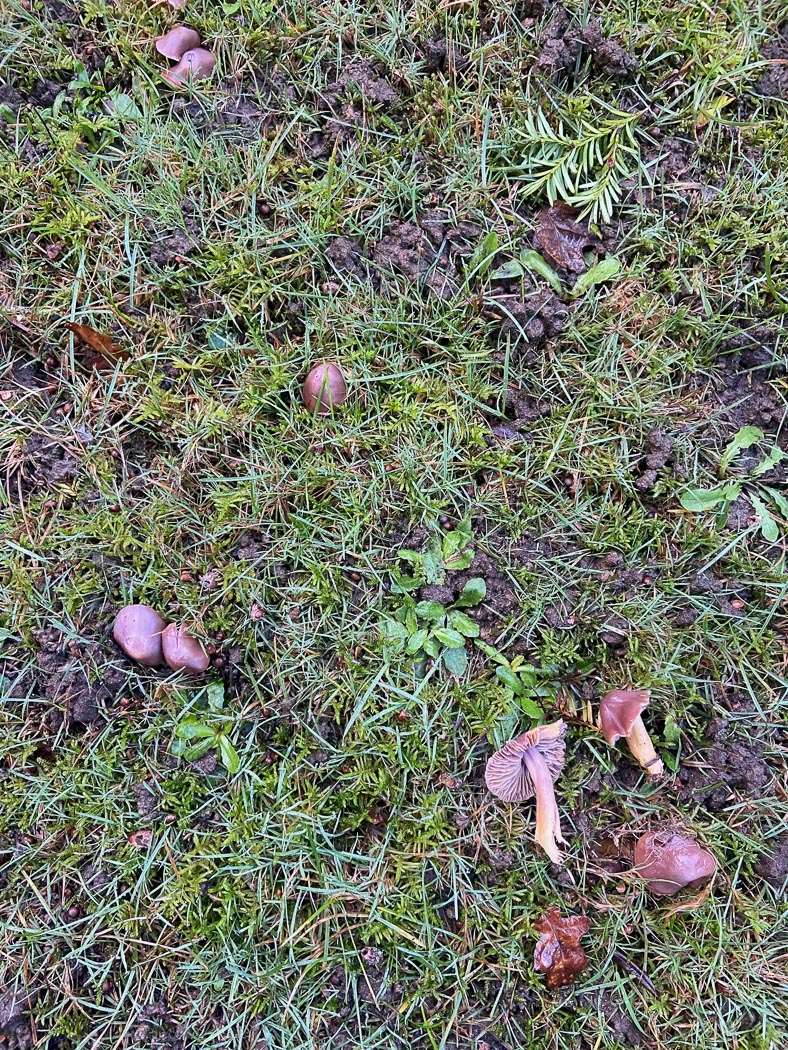
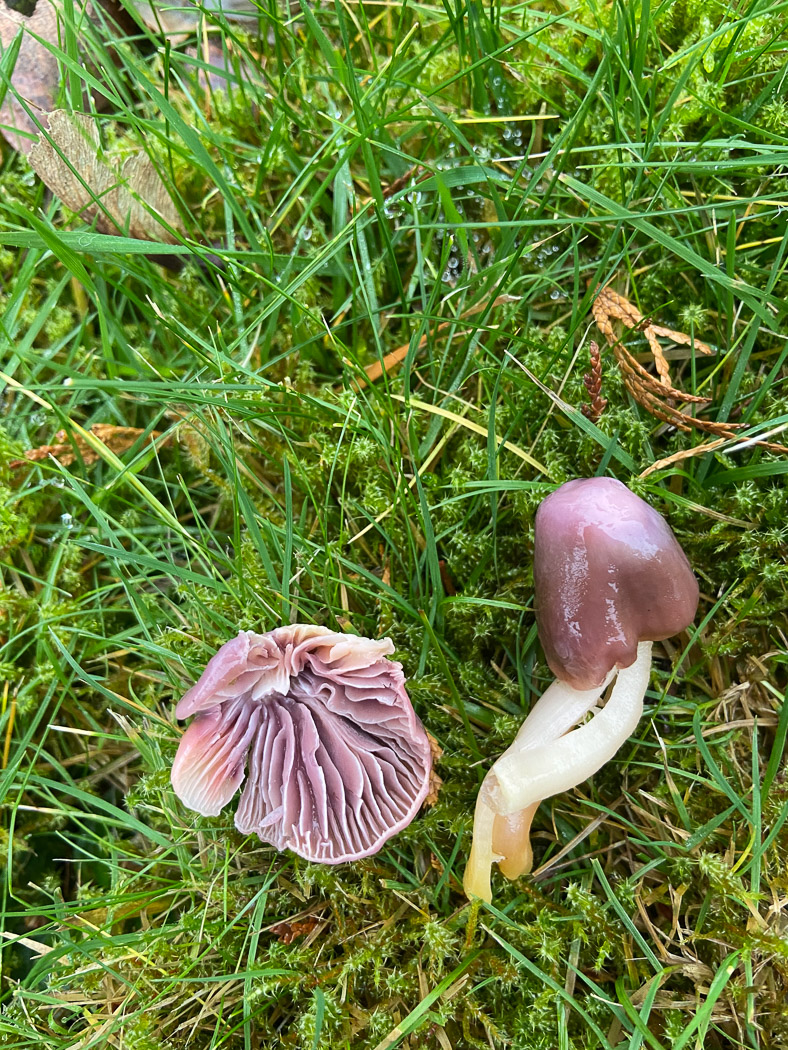
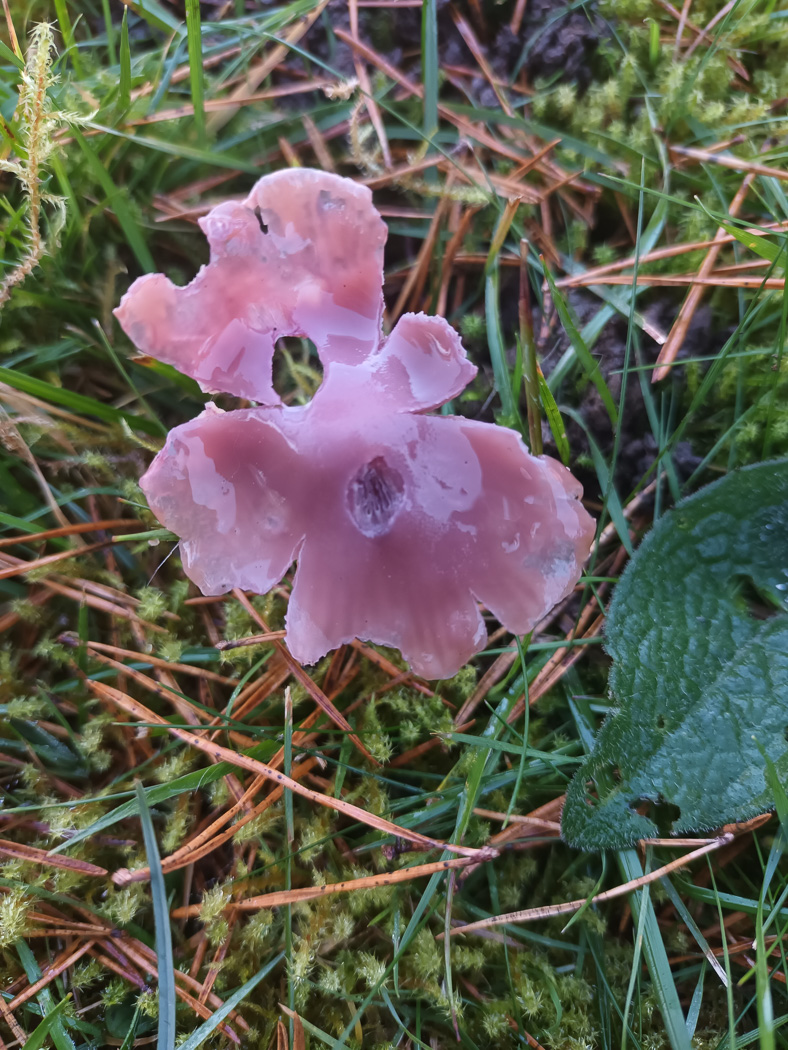 |
Gliophorus reginae (Jubilee Waxcap) Mar 20, 2024. In Lacey Green churchyard Sarah Ebdon (who knows this species well from this site) was somewhat surprised to find a singleton up at this time. Though rare, this poorly known Waxcap - named in honour of our late Queen's jubilee - first turned up here in December 2021 and has fruited here every year since though late in the year and once into January. But March?! This is now our second Waxcap within the week, and bearing in mind the several other unseasonal recent finds it is clear that something unusual is going on at the moment presumably as a result of our mild winter / climate change? See previous notes on Finds for more about this species. Dec 7, 2023. In Lacey Green Churchyard Sarah Ebdon has been keeping an eye out for this very rare Waxcap which she has recorded here since 2021. It appears to be a particularly late season fruiter, sometimes appearing into January but this year Sarah found it first on November 6th (photo 1), then November 25th when distinctly frosted (photo 2), and now again today (photo 3). Though not looking its best in any of the photos, this is a distinctive species and typical of its genus - ie sticky and slimy all over - but with no hint of green anywhere as in the much more common G. psittacinus (Parrot Waxcap) of which it was thought originally to be a variety when first discovered. That species is indeed extremely variable and particularly after frost can have pink or even purple colours in the cap, but always retains some green even if only at the stem apex. G. reginae was so-named in honour of the late Queen's jubilee celebrations. Nov 30, 2022. In Lacey Green Churchyard Sarah Ebdon had been hoping for the appearance of this rare Waxcap which she found fruiting here in good numbers last winter. She and Claire Williams were delighted when it did so! It is closely related to G. psittacinus (Parrot Waxcap) but only in recent years established as a species in its own right, having no sign of green even at the stem apex and sometimes with a sign of yellowing at the stem base (though this was not very clearly in evidence today - photo 3). If you have a local patch where Waxcaps are found, this is definitely one to watch out for now. (Photos 1 and 2 are Claire's, photo 3 is Sarah's.) Jan 12, 2022. In Lacey Green Churchyard Sarah Ebdon was excited to find maybe ten specimens of this very rare Waxcap (closely related to G. psittacinus) pushing up through the mossy ground. On hearing about this and never having seen it before, Penny couldn't resist coming to see it and was suitably impressed. This was in fact the third spot in this churchyard where Sarah's found it in the last few weeks (see also Finds 2021 December 15th). When Kew expert Martyn Ainsworth (co-author of the species when described 10 years ago in honour of the Queen - another Jubilee year!) was informed by Penny of today's remarkable crop of fruitbodies, he responded 'It doesn't seem to mind winter as much as some of its relatives ........ it was often seen after Christmas in the field which became the type locality and it was late Jan when I first saw it there for myself.' The photos here are all Sarah's, the final two are of a further collection from a fourth spot at this site made on January 17th. Dec 15, 2021. In Lacey Green Churchyard Sarah Ebdon was thrilled to find for herself this rare and very special Waxcap - one that was new to the county from Prestwood Churchyard just a few weeks ago on November 23rd (see under that date for more). One character which was not visible on that first collection shows nicely here: the yellow stem base is useful to note in the field and helps to confirm the identification as well as the very sticky cap and stem, though the cap colour can clearly be similar to that of Porpolomopsis calyptriformis (Pink Waxcap). Penny is green with envy and has never seen this species! Nov 23, 2021. In shortish grass in Prestwood Churchyard Jesper Launder found this singleton Waxcap and instantly suspected it was this rare species having become familiar with it from more northern areas of the country. Closely related to G. psittacinus (Parrot Waxcap), it was raised to species level as a result of a molecular study of this complex undertaken by Martyn Ainsworth at RBG Kew and named to honour the Queen's jubilee. Its violet pinkish colour is distinctive, having no hint of green, but it should not be confused with Porpolomopsis calyptriformis (Pink Waxcap) which has a greasy conical cap and dry stem in contrast to today's species which is somewhat slimy all over. This is new to the county. |



|
Gliophorus sciophanus (previously placed in synonymy with G. psittacina) (a Waxcap with no common name) Nov 20, 2020. In St Giles Churchyard Stoke Poges, Penny C. found amongst many Waxcaps a collection which was unfamiliar to her and an unusual colour. All but one specimen were somewhat deteriorating but it was clear that the smallish bright cinnamon rusty orange conical caps with outer half slightly translucently striate were very slimy, as were the stems. She wondered about Gliophorus laetus as a possibility but the adnate gills lacked the glutinous edge of that species; she also noted that there was no hint of green which would have pointed to G. psittacinus. At home the spores were similar to those of G. psittacinus, however, and turning to the descriptions of that species she was reminded of the two rare varieties which were raised to species level in 2014. Today''s collection appeared a good match for one of these: G. europerplexus, but confirmation by DNA sequencing was clearly called for. However, the resulting sequence (received in Jan 2021) showed a close match to G. sciophanus, another extremely rare species in the psittacinus complex and not yet established as on the British list. |
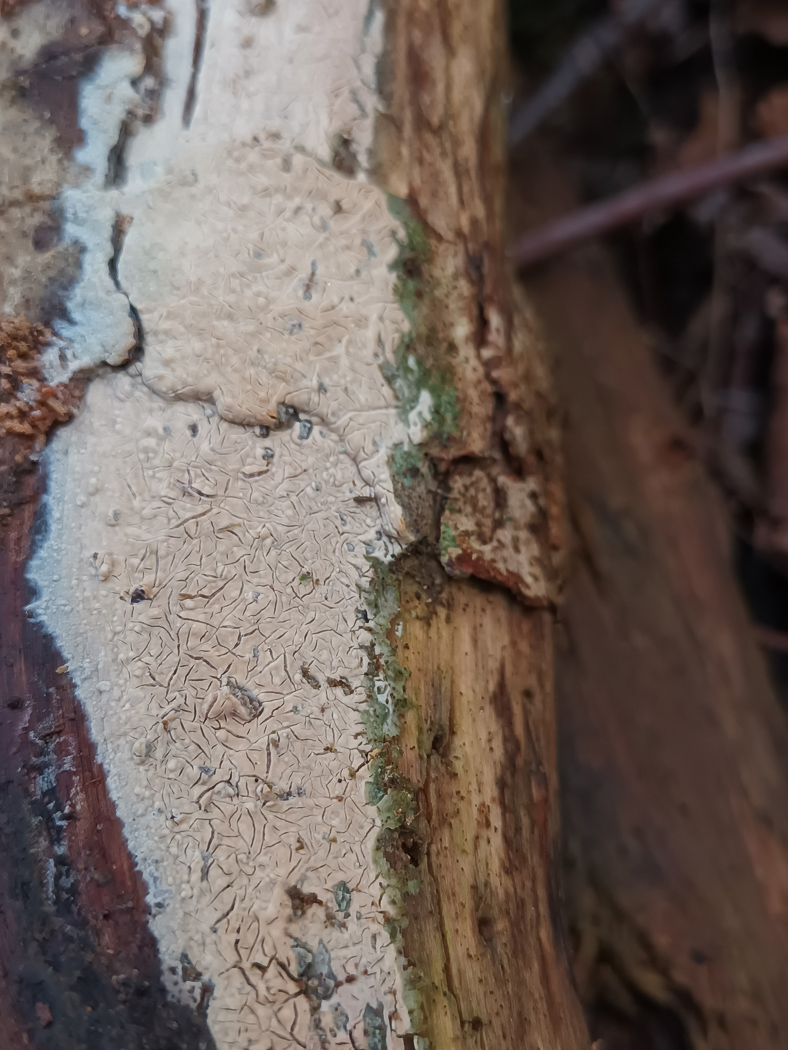 |
Gloeocystidiellum porosum (a corticioid with no common name) Jan 29, 2022. In woodland near Jordans Village Jesper Launder picked up this slightly pinkish flat specimen on an unidentified deciduous stick and took it home to identify. When fresh it is whitish cream and has a smooth waxy texture then becomes pinkish buff and cracked as here as it ages, and though it looks similar to many other such species, the microscopic characters are very distinctive. It is considered common and occurs on many different deciduous woods but we have only three previous records. |






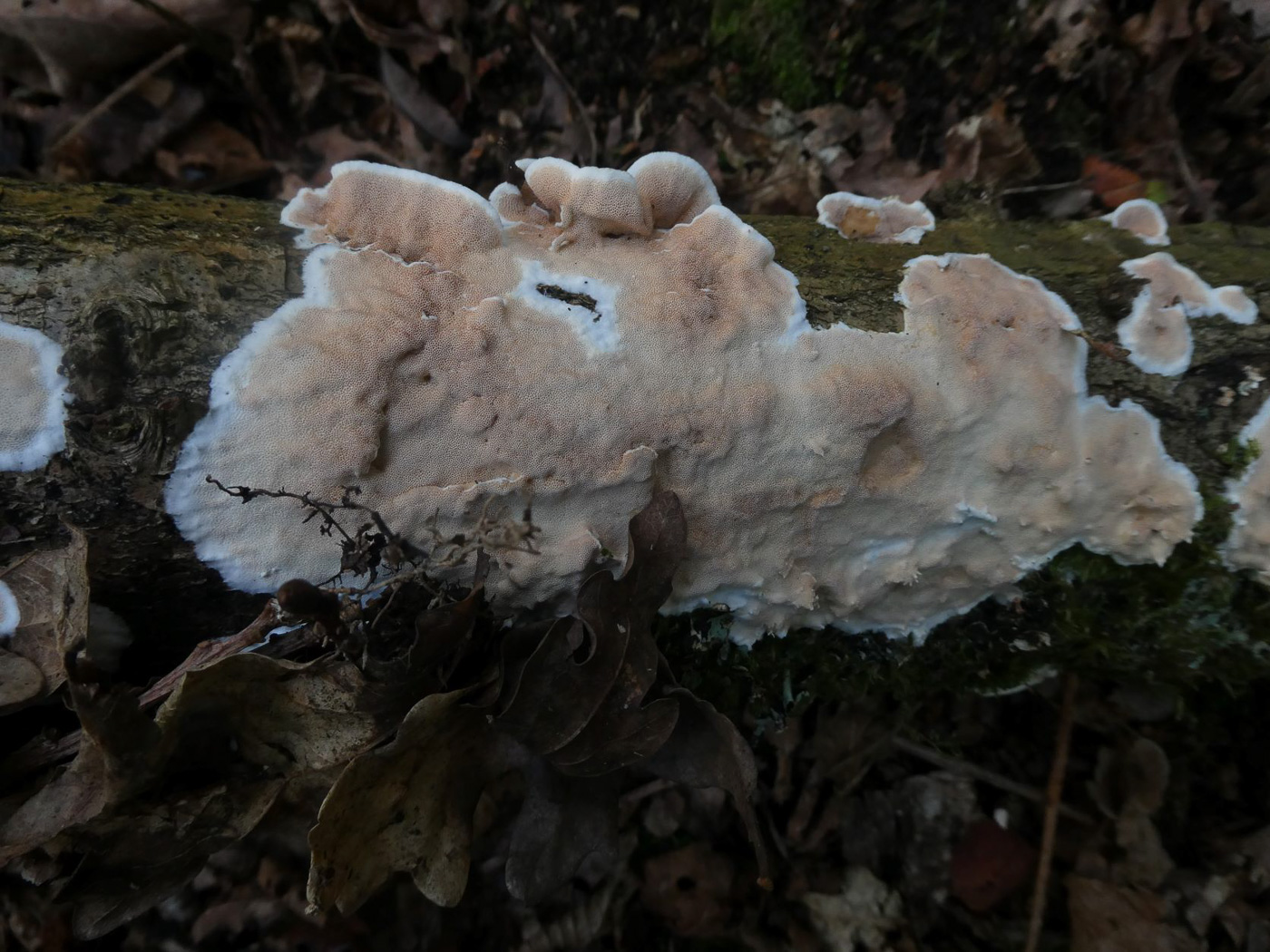
 |
Gloeoporus dichrous (Bicoloured Bracket) Apr 14, 2023. In Gerrards Cross Jesper Launder spotted fresh material of this unusual 'semicorticioid' species, reportedly here on rotting Oak (though to Penny the photos look like Birch?). See also Finds 2023 January 17th for more notes on the species which is unusual in having a rubbery tube layer which can be loosened from the flesh. (Both photos show the distinctive underside of the species.) We have just a handful of sites in the county where it's been recorded previously though it's not rare and is known to occur on both Oak and Birch. Jan 17, 2023. During several visits to Stoke Common spread over a week or so Jim Wills noticed this unusual 'semi-corticioid' species fruiting on various bits of fallen Oak, recognising it from his find in Gerrards Cross (see Finds 2022 September 28th). A fairly unobtrusive species and therefore probably overlooked, it is quite soft, the tube layer being removable from the flesh - an unusual feature. The 'bicolour' in the common name refers to the apricot pores contrasting with white rim and white top surface, though this combination also occurs in the similar Skeletocutis amorpha which, however, occurs on fallen Pine and remains fully resupinate thus unlike today's species which forms part brackets. Sep 28, 2022. On a fallen deciduous branch in Gerrards Cross Common Jim Wills noticed this distinctive 'semicorticioid' species, and having just acquired a specialist book which covers such fungi he took it home to work on. The spores of this rare species are quite distinctive as well as the pink finely pored surface which has a white border, and Penny is happy to accept his determination. We have just 5 previous county records, so this is a nice find and a sample will be retained for sequencing. |
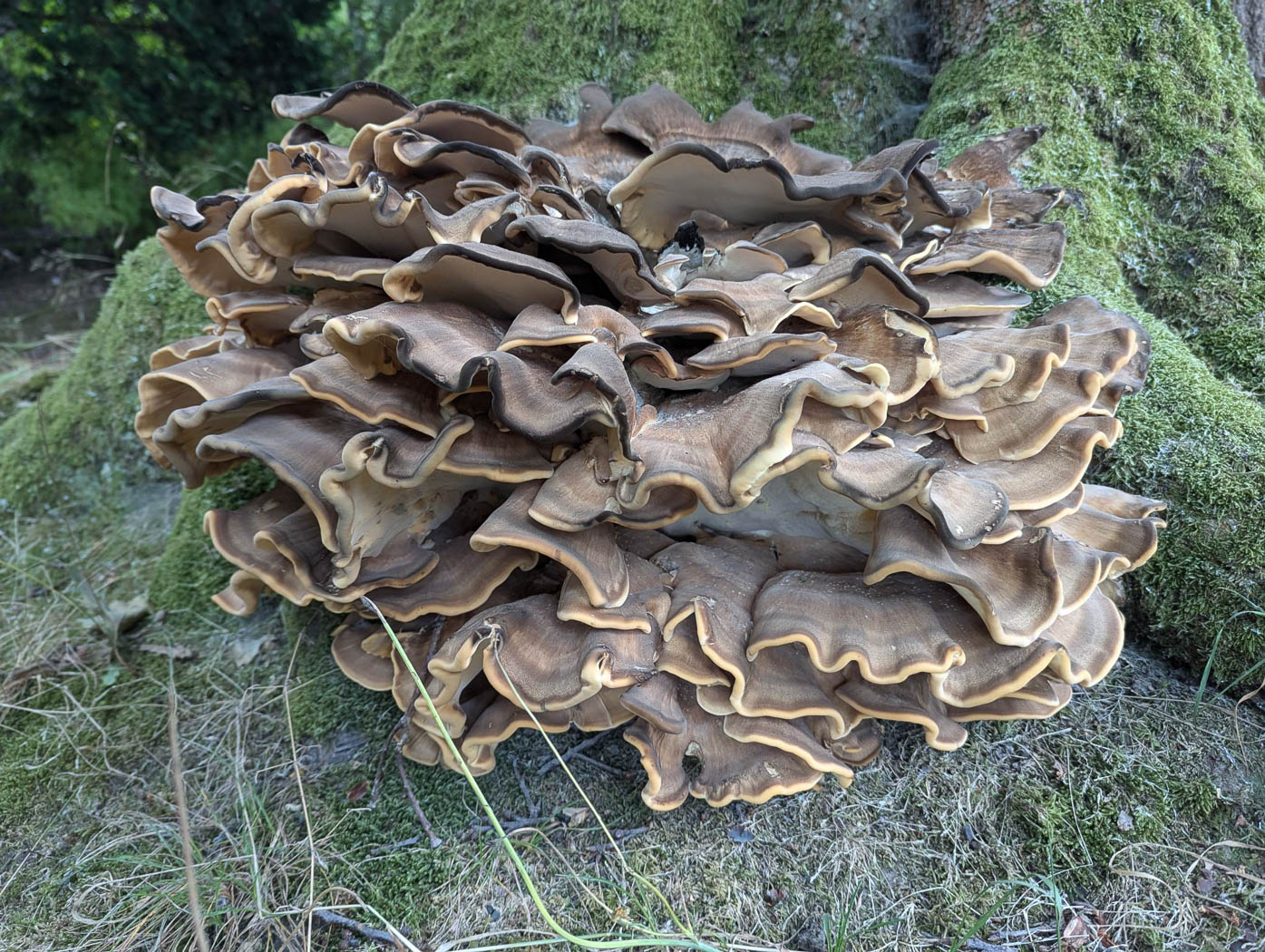 
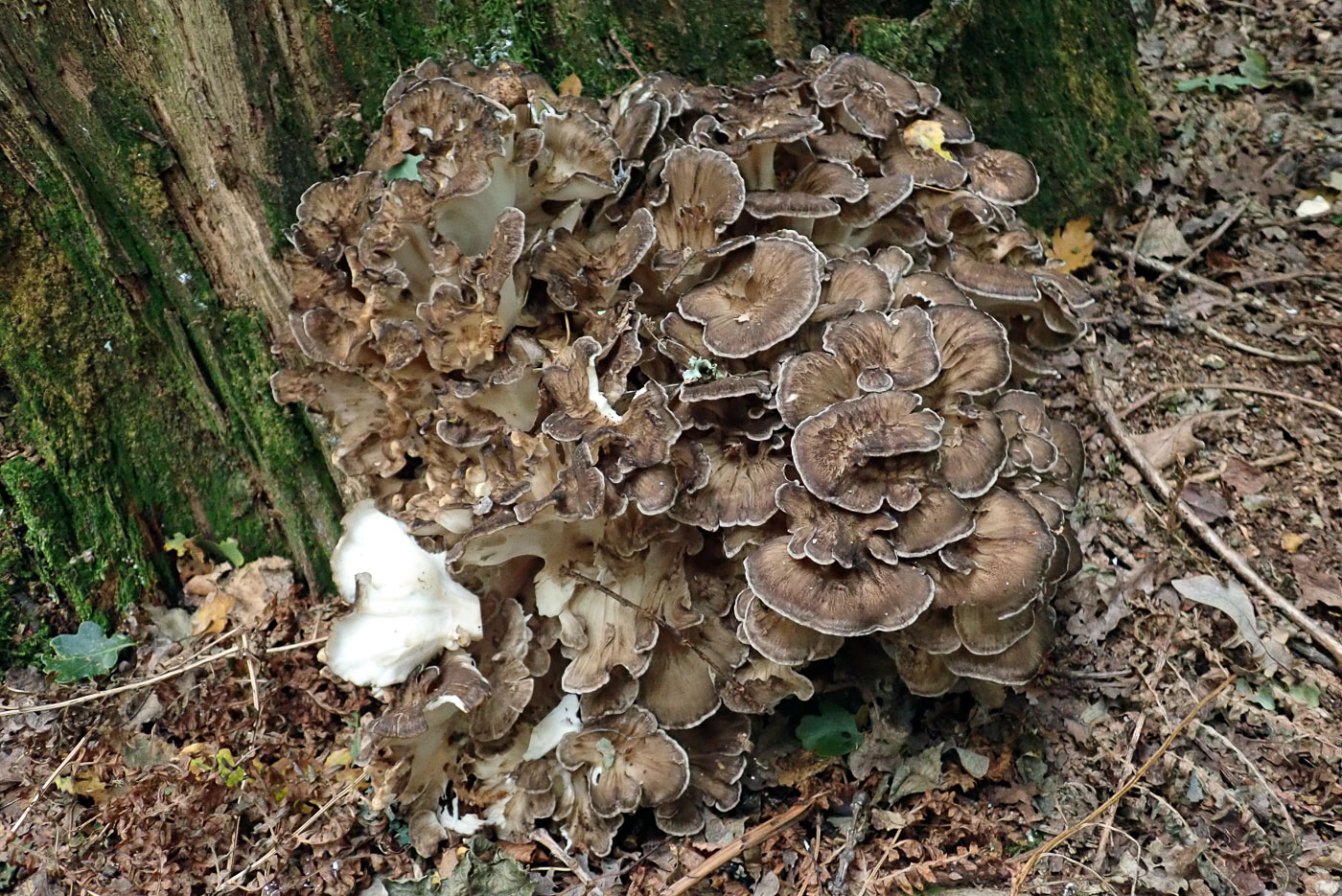
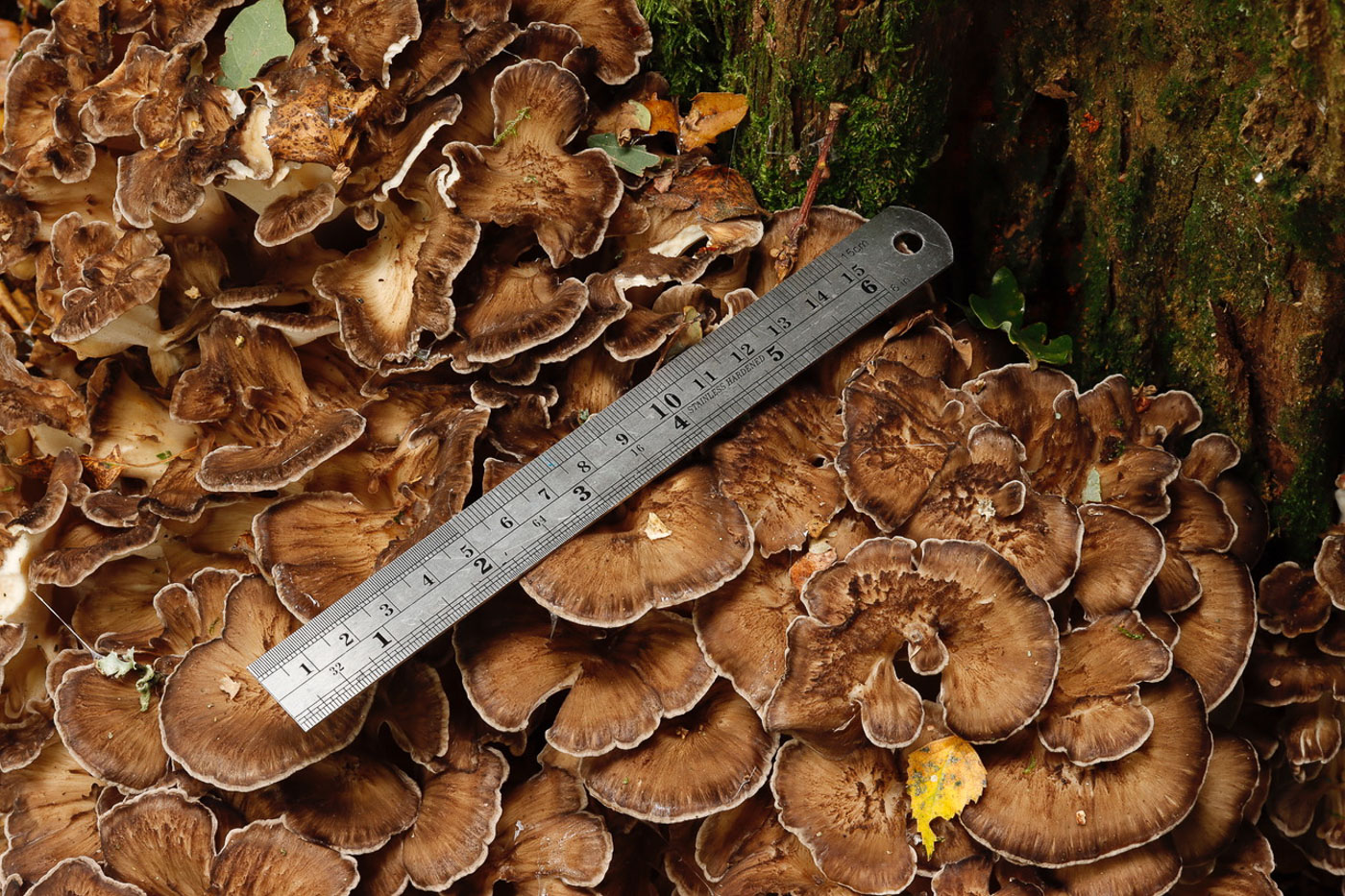
|
Grifola frondosa (Hen of the Woods) Aug 19, 2024. In Stoke Poges Memorial Gardens Gill Ferguson spotted this stunning fungus at the bottom of a trunk (but was so busy admiring it that she didn't notice the host tree!). It is a distinctive tiered bracket fungus, not that common and usually at the base of either Oak or Beech. New to the site, we have quite a few records though Penny's not seen it since the earlier Finds entry in 2020. See comments on that entry for a bit more information. Oct 12, 2023. In Bernwood Forest Chris Grimbly found this quite unusual and attractive tiered bracket with its typical overlapping sections. In its early stages Meripilus giganteus (Giant Polypore) can look quite similar though G. frondosa never gets anywhere near the size of that enormous species when mature. If in doubt a piece broken off the Meripilus will start to turn black within a few minutes, not so with a piece of the Grifola. It grows on living Oak or Beech. Sep 26, 2020. This impressive bracket was found in Naphill Common on an old Oak trunk by Penny Cullington and (separately the same afternoon by) Paul Goby, his being the photo + ruler. An occasional species, it was new to the site last year. The tiered tightly formed fronds are typical and the only species with which it might possibly be confused is young Meripilus giganteus (Giant Polypore) before it has grown to be enormous when unmistakable as anything else. If in doubt, break off a piece and keep it 30 minutes or so. If it starts to blacken then you have the Meripilus as G. frondosa does not change colour. |
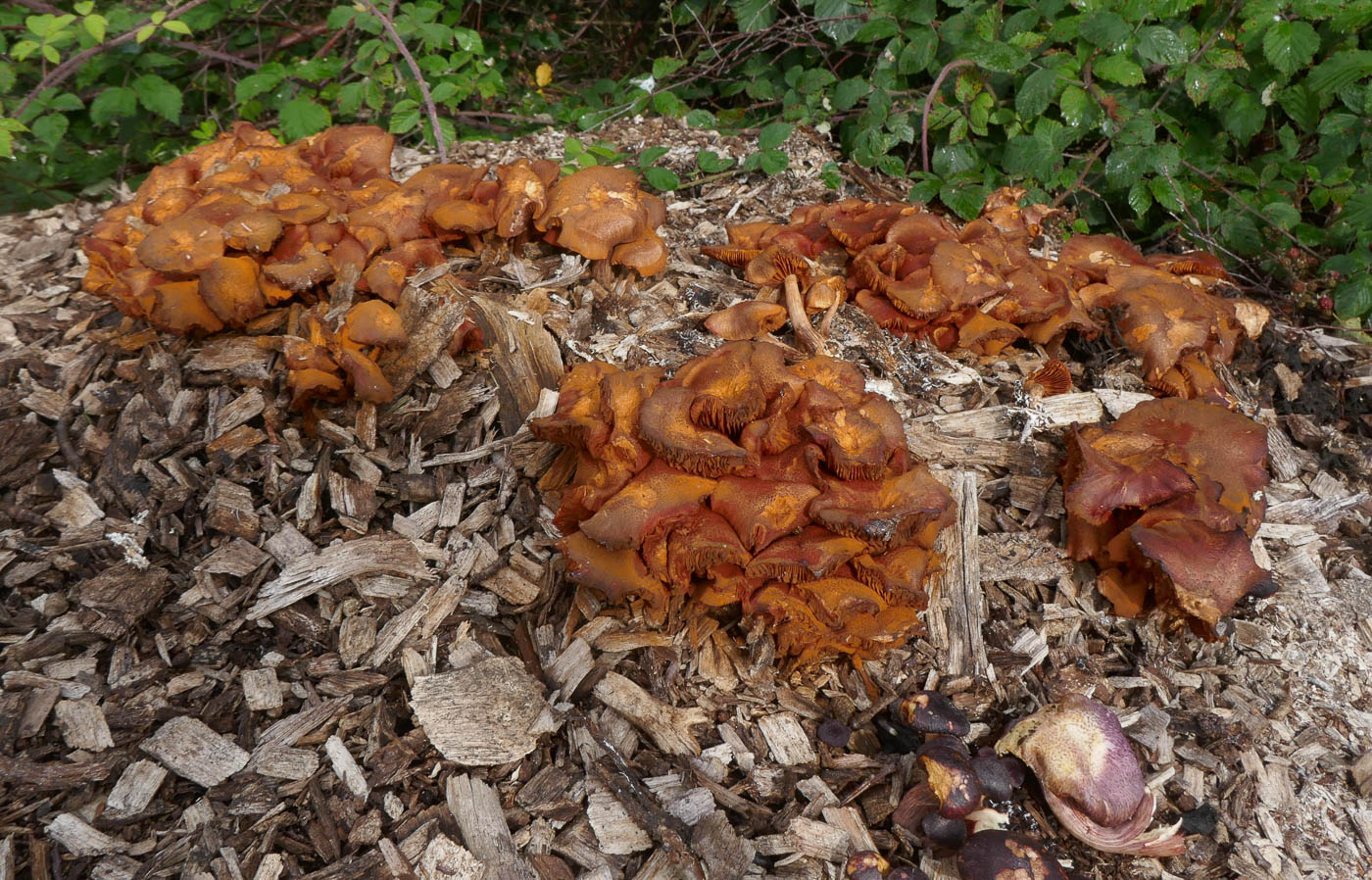
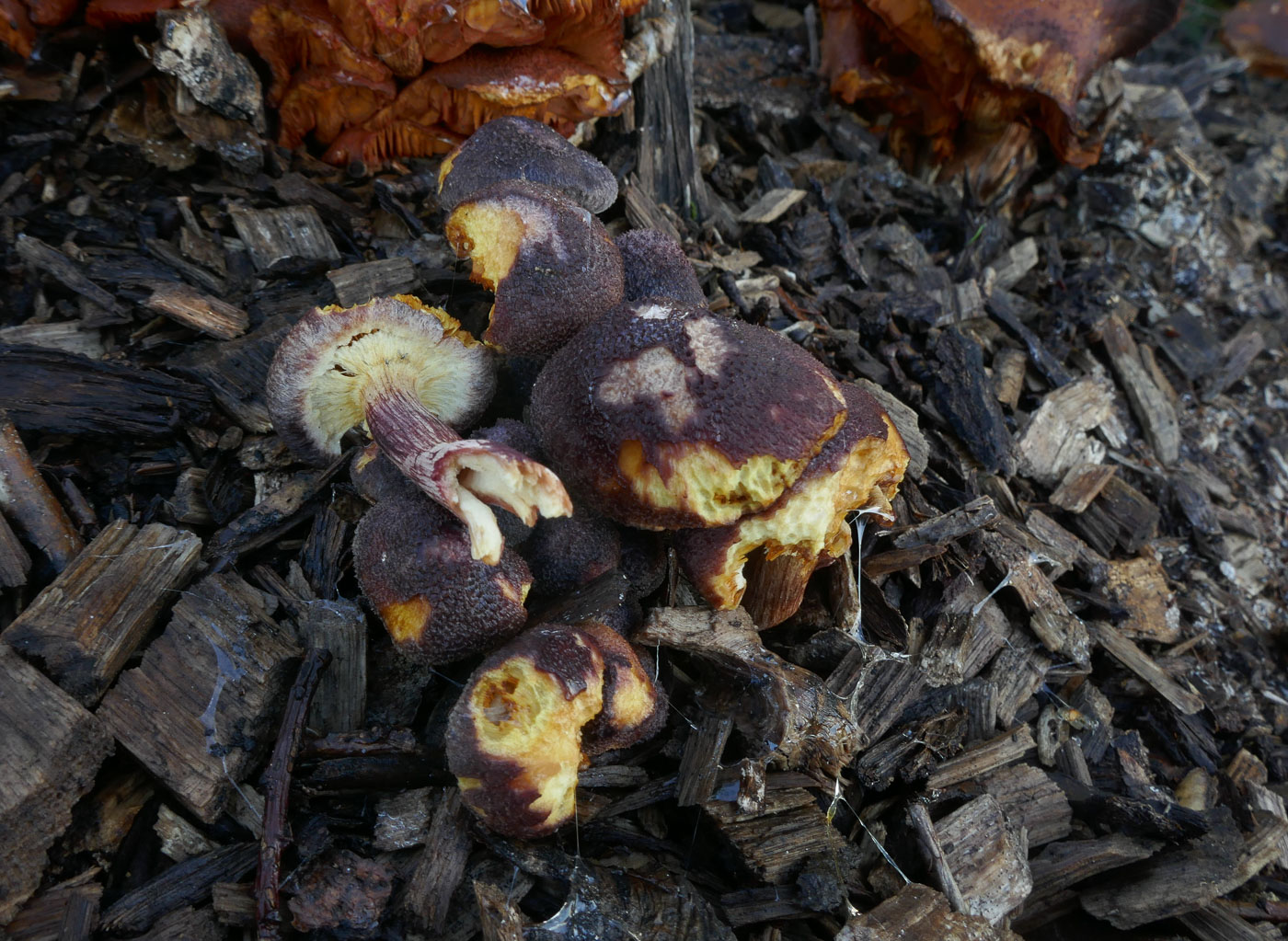
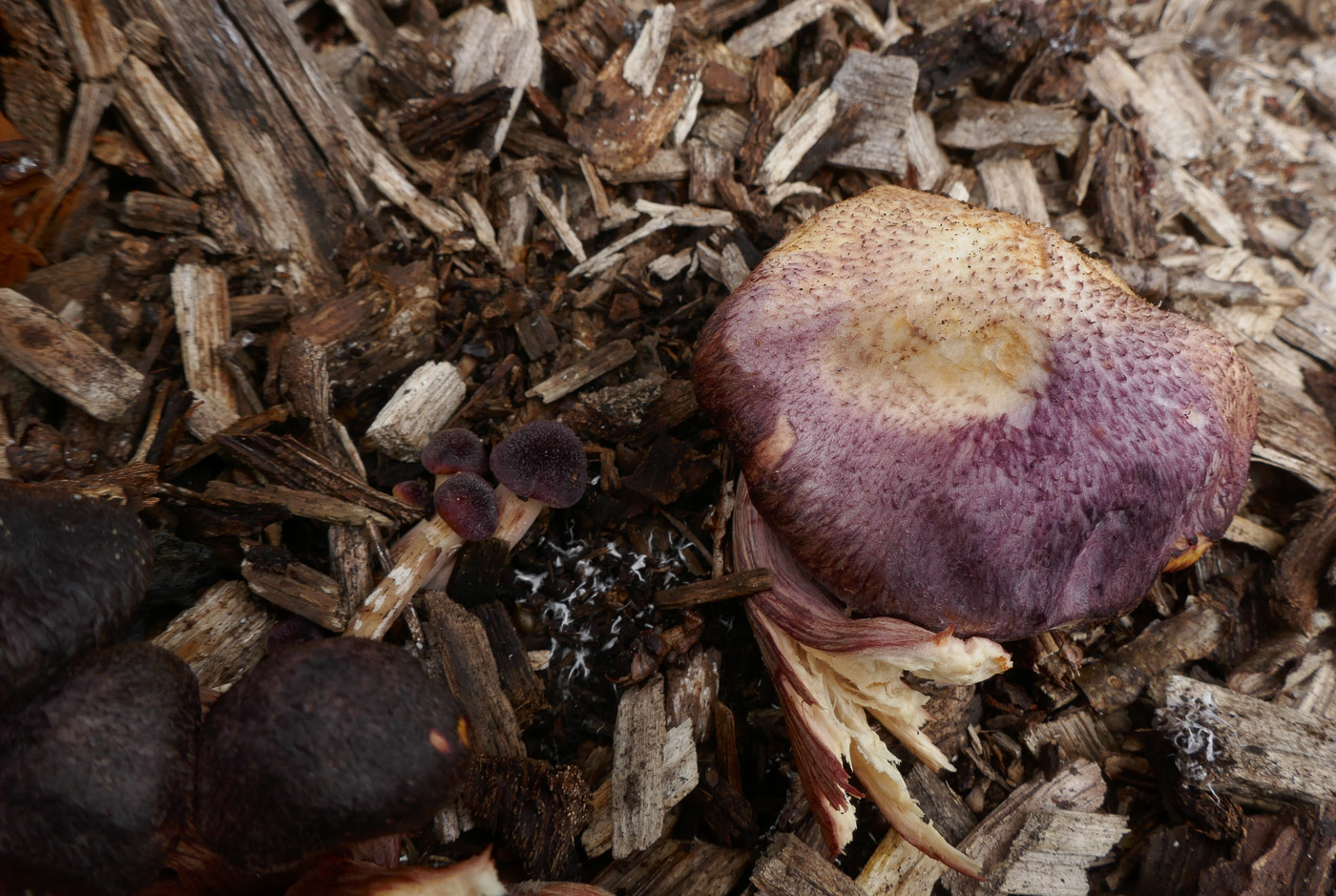
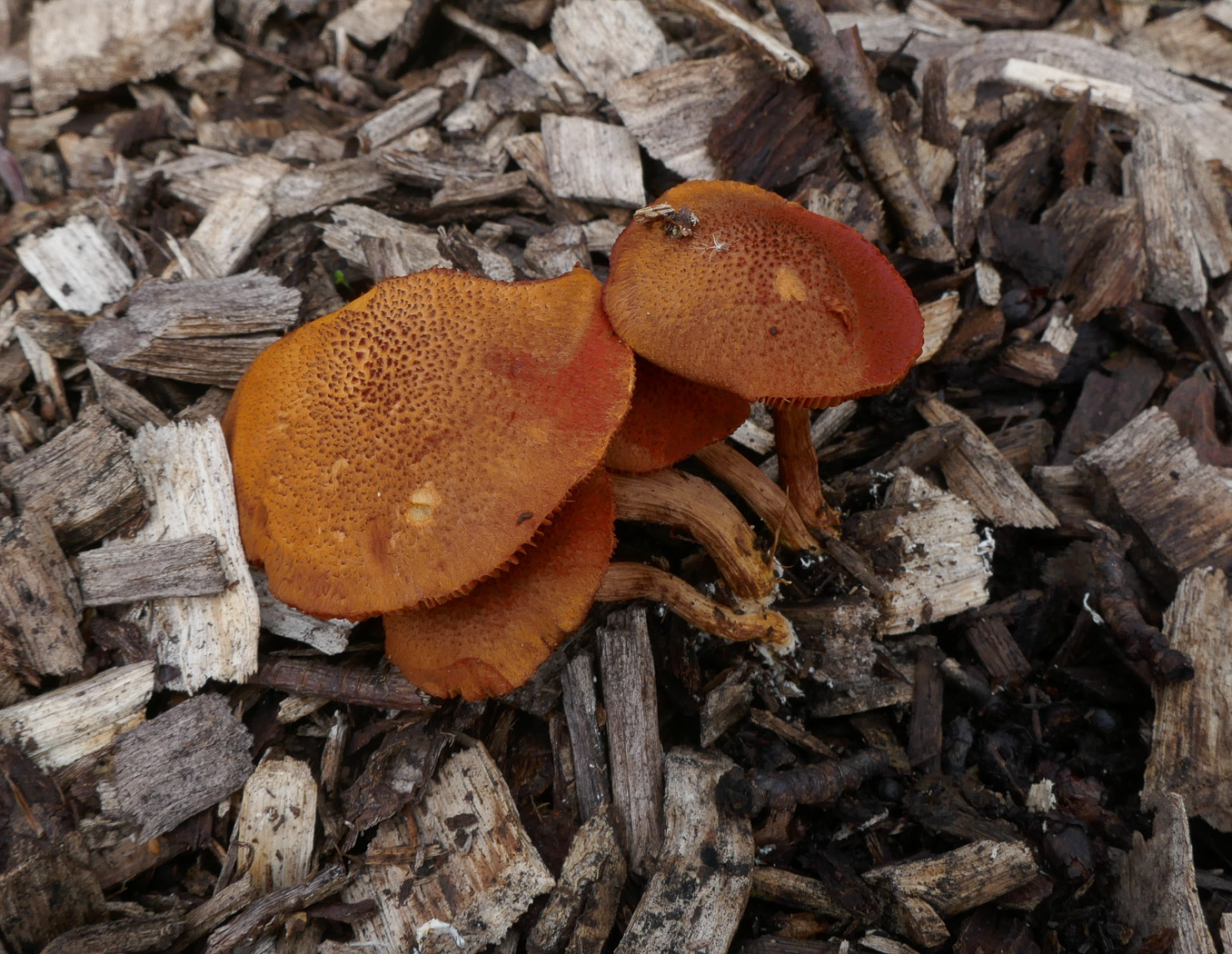
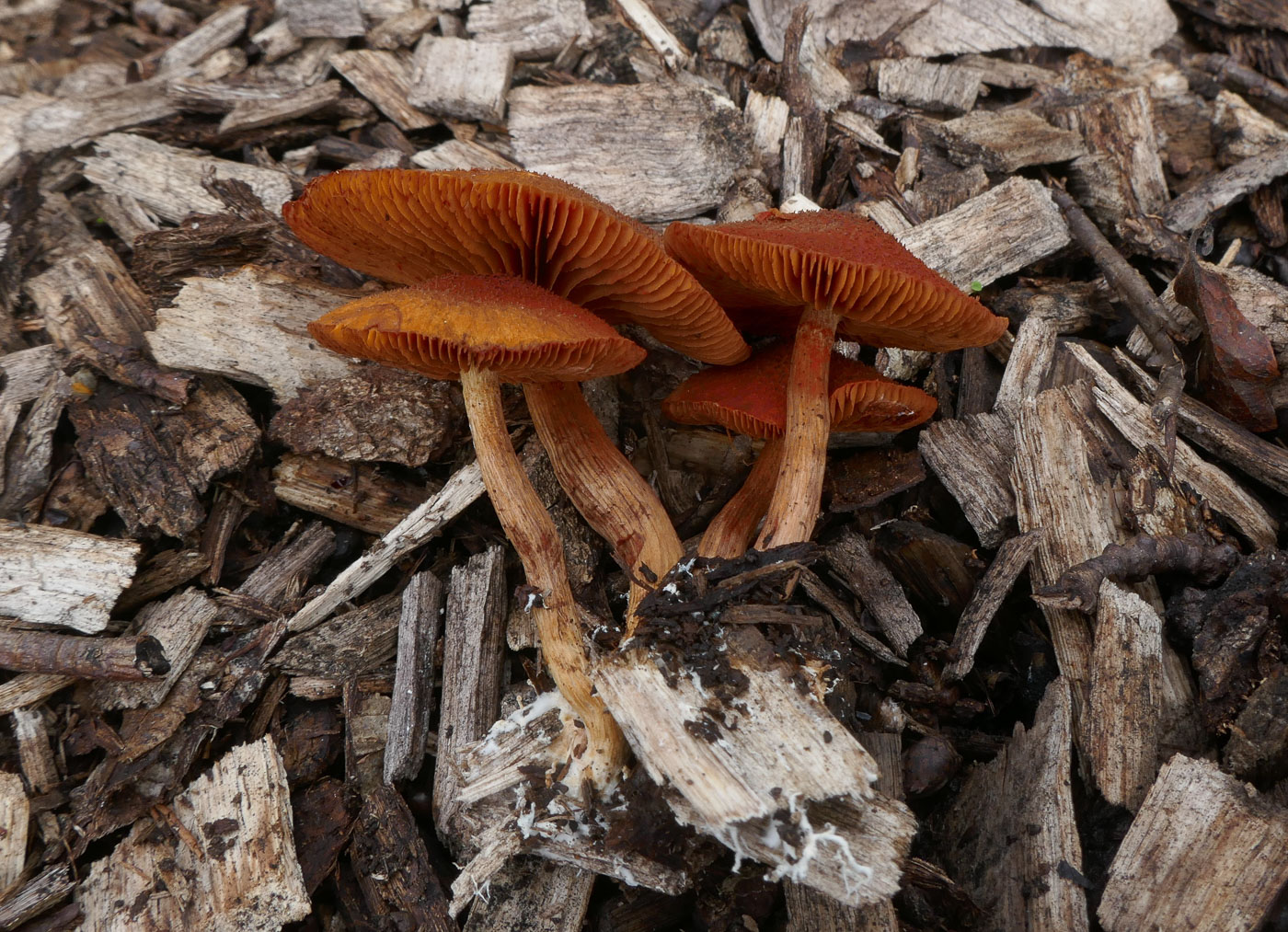
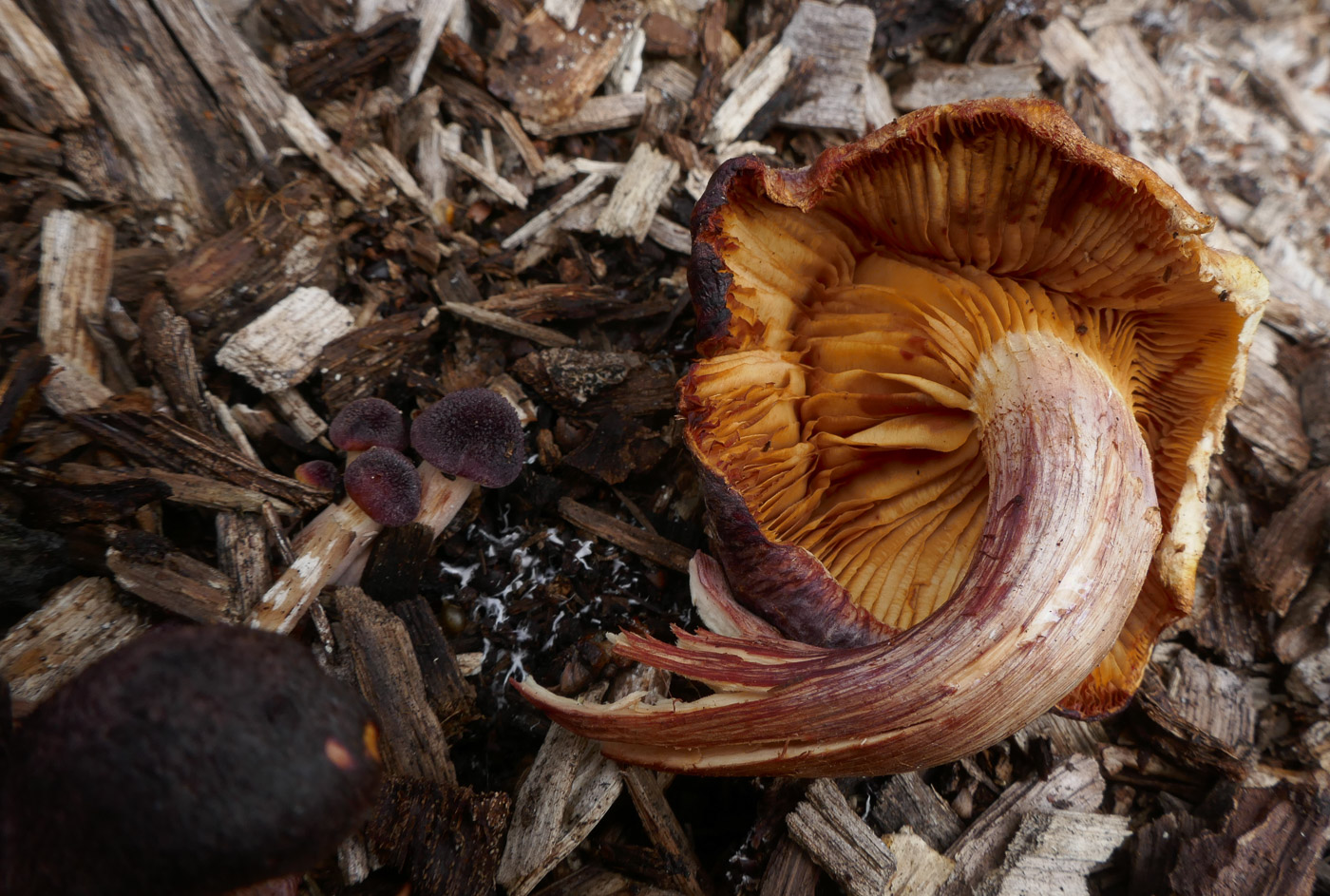 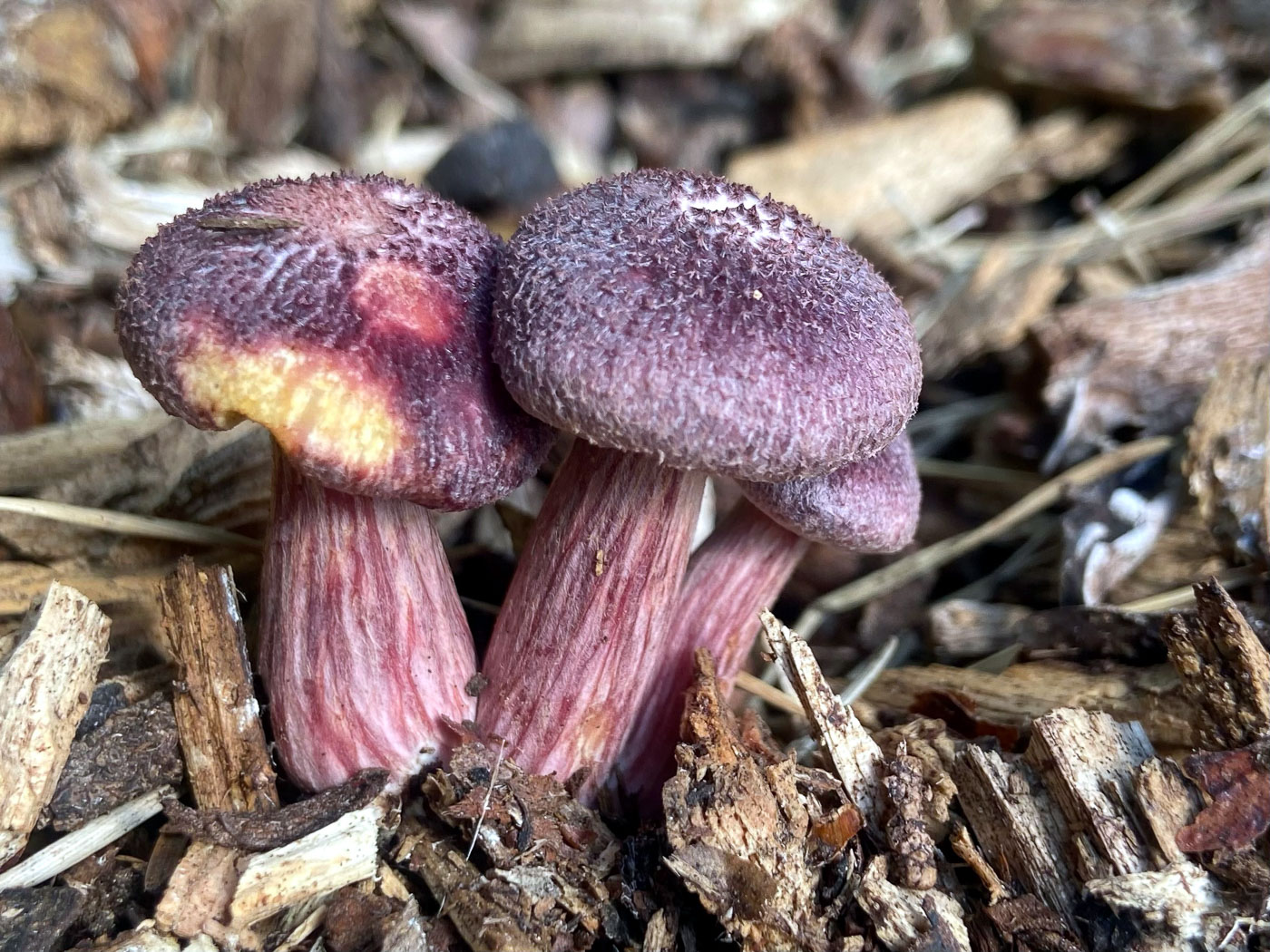
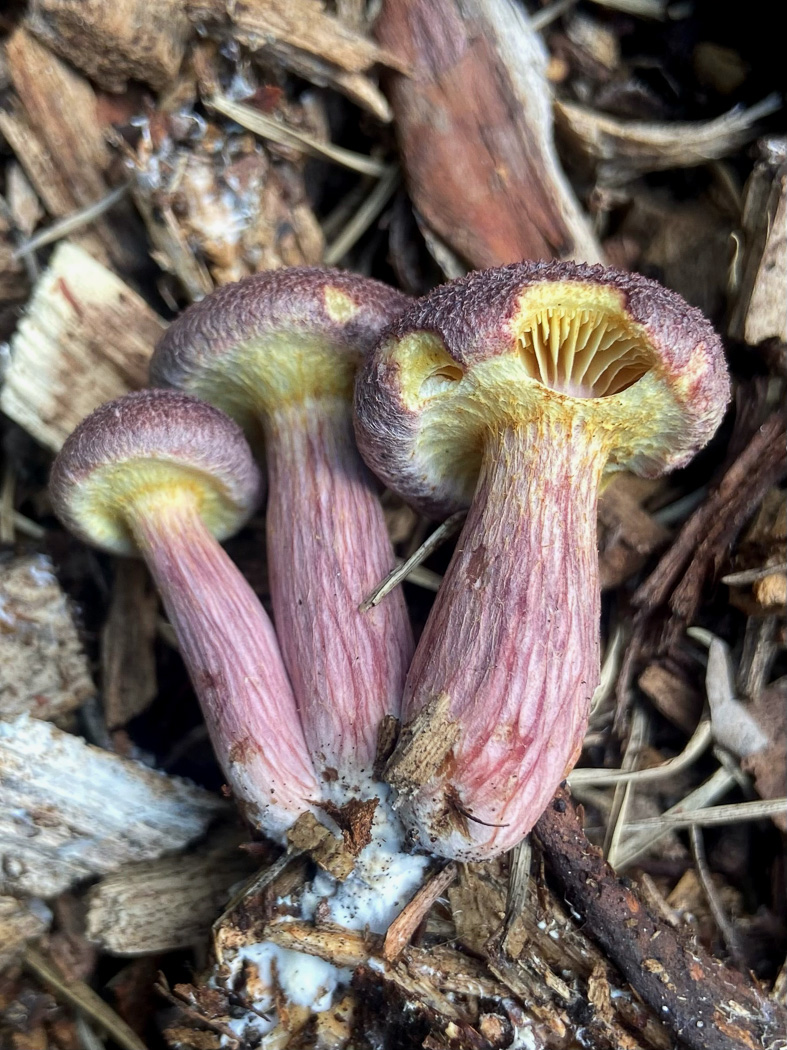
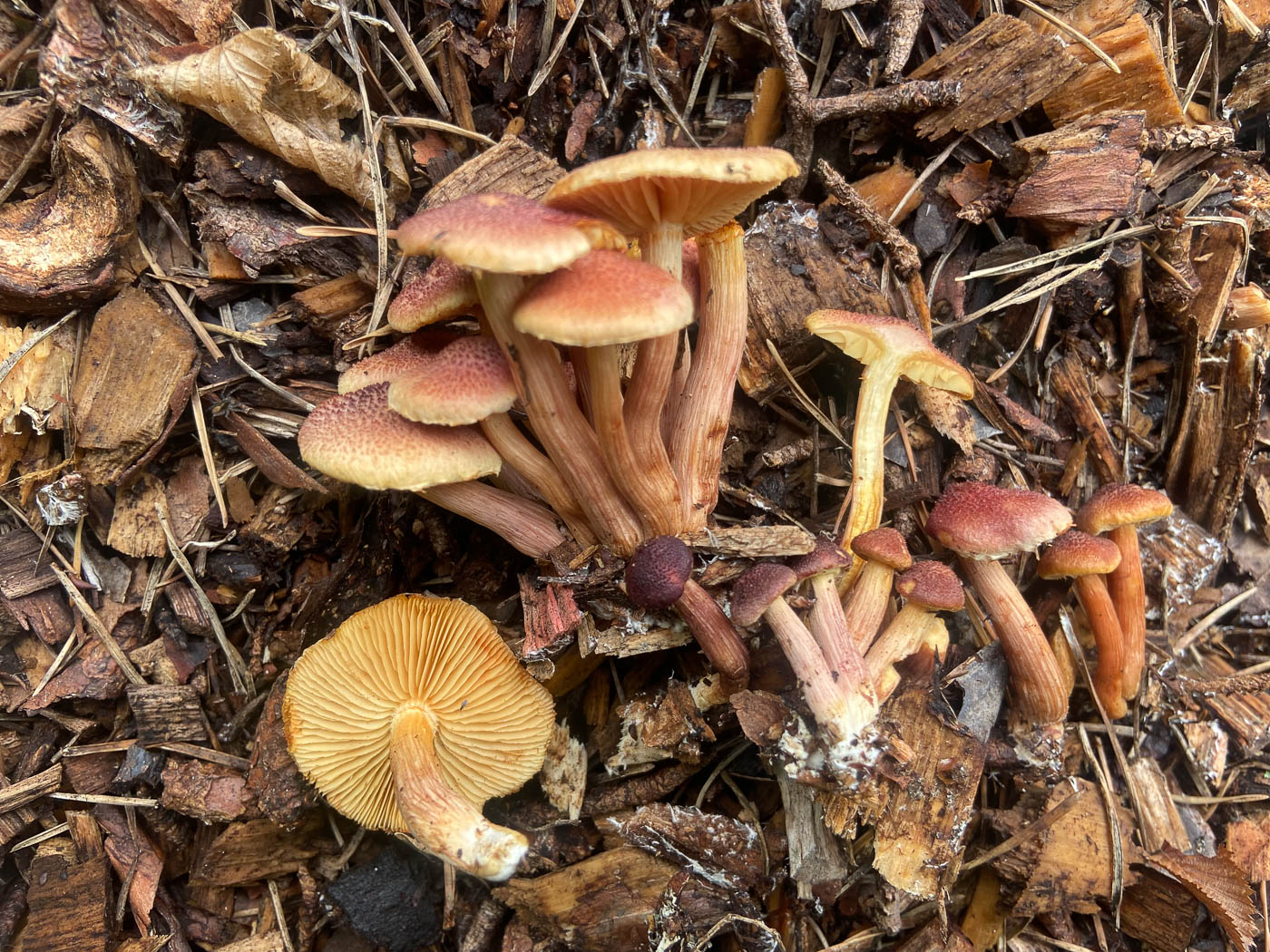 |
Gymnopilus dilepis (Magenta Rustgill) Sep 11, 2024. In a large pile of well rotted woodchip at Stampwell Farm Jackie Ewan watched good numbers of this species developing over a few days and eventually realised what the species must be. This is an unusual Rustgill which first made an appearance in the UK in 1995, probably introduced on some imported woodchip, and by the time we first found it in Bucks (at Stoke Common) in 2010 there were about 30 UK records, all from the south of England. Though still uncommon, when it fruits it seems to appear in large numbers as seen here, and this was also the case at Stoke Common and at our only other site when found in Naphill Common in 2022. This is a distinctive species with an unusual magenta cap colour (not unlike that of Tricholomopsis rutilans - Plums and Custard) when it first appears though it becomes mush rustier as it matures. Usually recorded on conifer woodchip, Jackie reports that it was on the chips of a mix of different deciduous woods here. Aug 30, 2022.On a large Pine woodchip pile in Naphill Common Sarah Ebdon was amazed to see some small brightly coloured mushrooms just emerging despite the drought. Identifying them, however, was not at all easy and she suspected they belonged to genus Cortinarius - one with quite a few species having purple colours and also yellowish gills as seen here. Penny suspected not, however, when hearing that the substrate was woodchip - Cortinarius being mycorrhizal and therefore emerging from submerged roots / soil. On seeing the photos she recognised it as this unusual and distinctive species of Gymnopilus, recalling her similar struggle to identify it when it appeared on Pine woodchip in Stoke Common back in 2010 when new to the county. Sarah returned two days later and took photo 3 showing the now larger and slightly fading specimens, looking less Cortinarius-like and more Gymnopilus-like. The species is an alien, one of several fungi introduced into the country (probably on imported woodchip) and first recorded here in 1995; though gradually spreading on this medium it is still somewhat uncommon and Sarah's find is only our second county record. It appears to thrive on well fermenting conifer chips so the conditions here were perfect! |
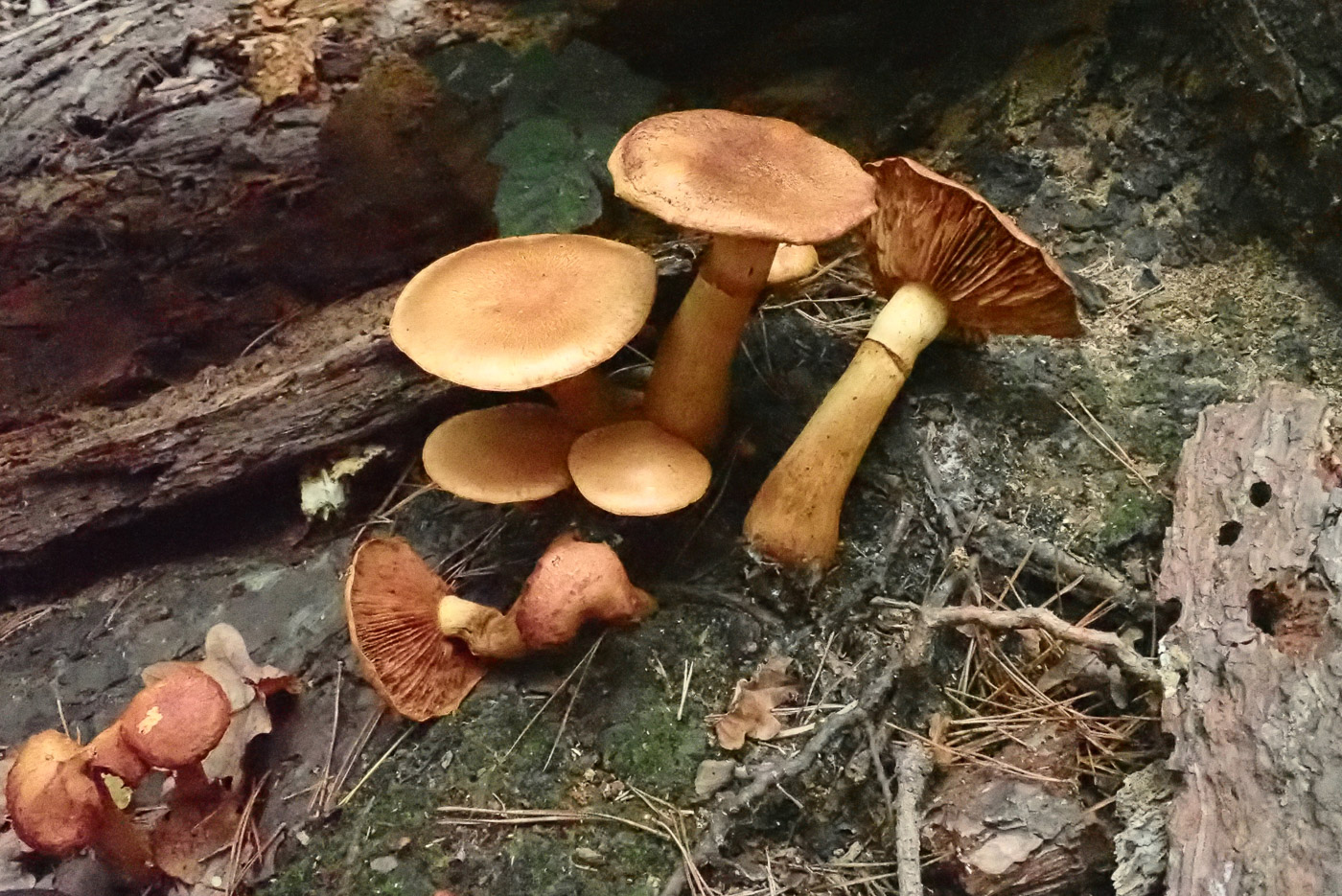 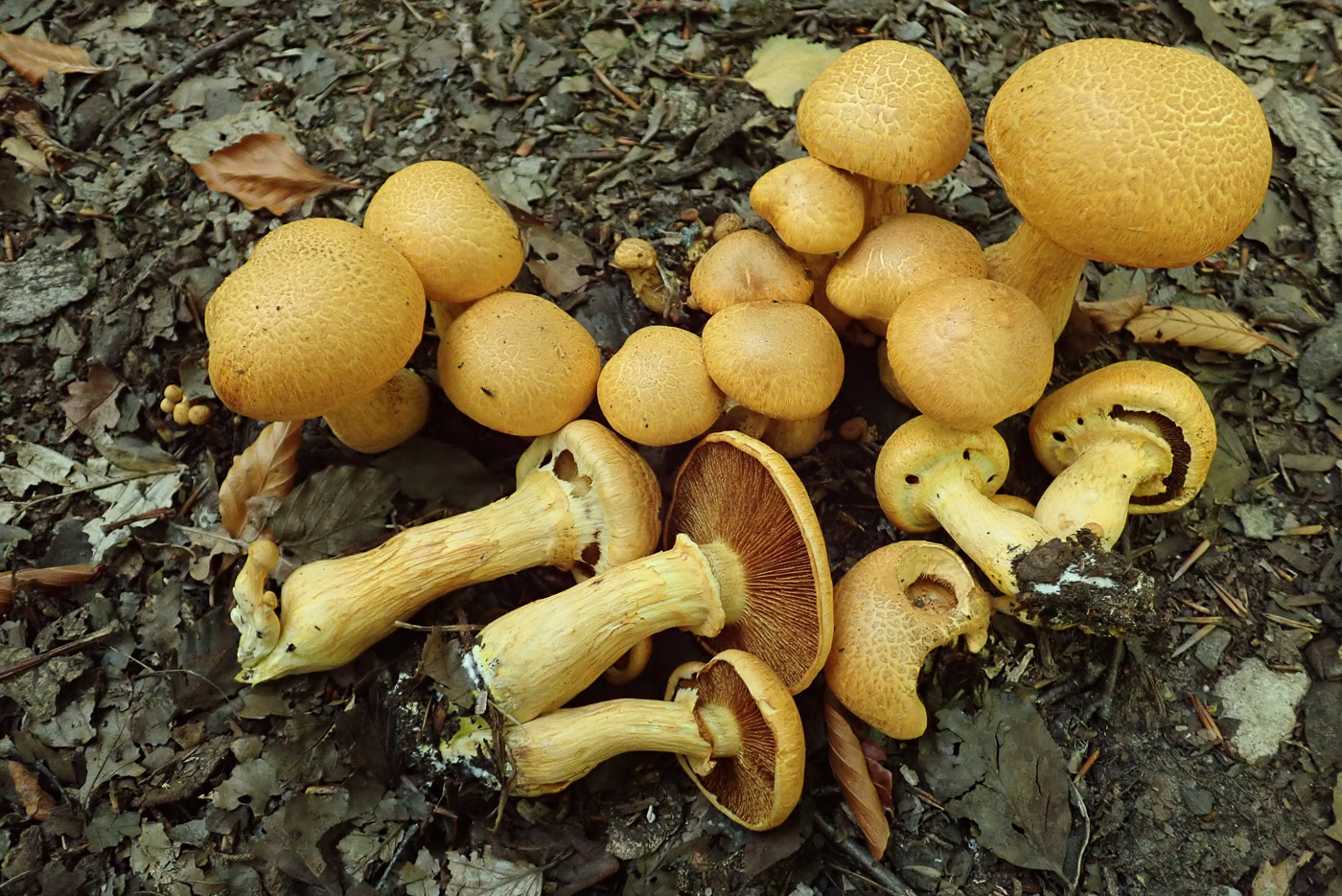
|
Gymnopilus junonius (Spectacular Rustgill) Oct 27, 2021. At Stoke Common Penny found many clusters of this impressive species just coming up at the base of various different decaying deciduous trees, but the collection here was on a fallen Pine. As the common name suggests, it can get to a good size - the largest caps here being about 12 cms across, and the whole fruitbody is a rusty colour though the stem is paler above the distinctive ring and it forms loose or tight clusters. Sep 18, 2020. Paul Cullington found this beautiful fresh young cluster growing on submerged roots of Beech in Hodgemoor Wood (photo Penny Cullington). The largest cap here was about 4cm across but when fully expanded the cap can get to 15cm or more. Note the rusty gills and very distinctive ring on the stem, also the lack of really distinct scales on the cap which if present would point to the similar genus Pholiota, often large and fruiting in clusters at the base of trees. This species occurs on dead wood or roots of deciduous trees. |
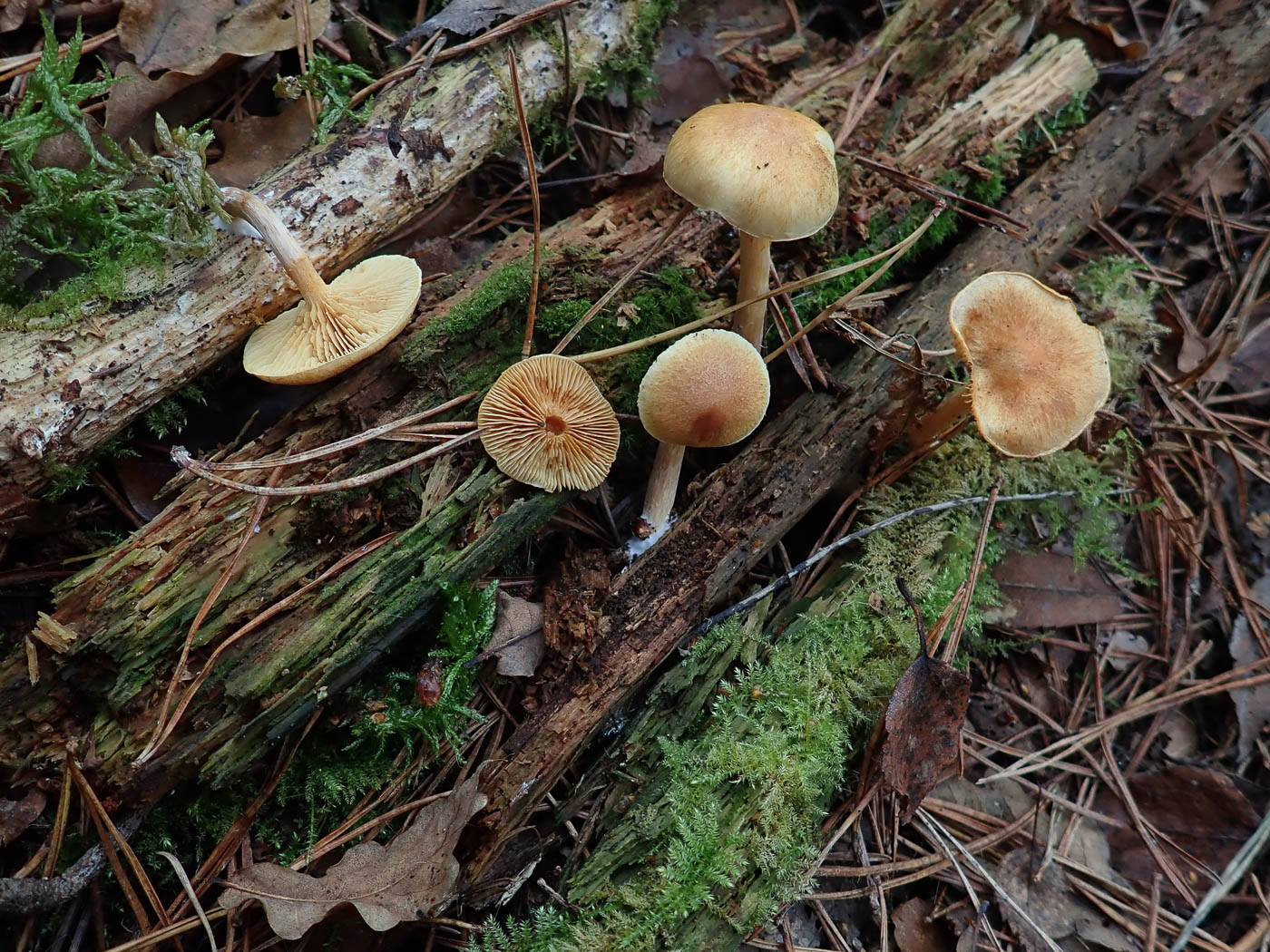 |
Gymnopilus penetrans (Common Rustgill) Nov 4, 2024. Under Pine at Burnham Beeches Penny was pleased to find this normally common woodland mushroom fruiting on fallen wood and debris. It is always on fallen wood and favours conifer though also occurs on deciduous wood, and is recognised by its yellowish gills take on a rusty look as it ages |
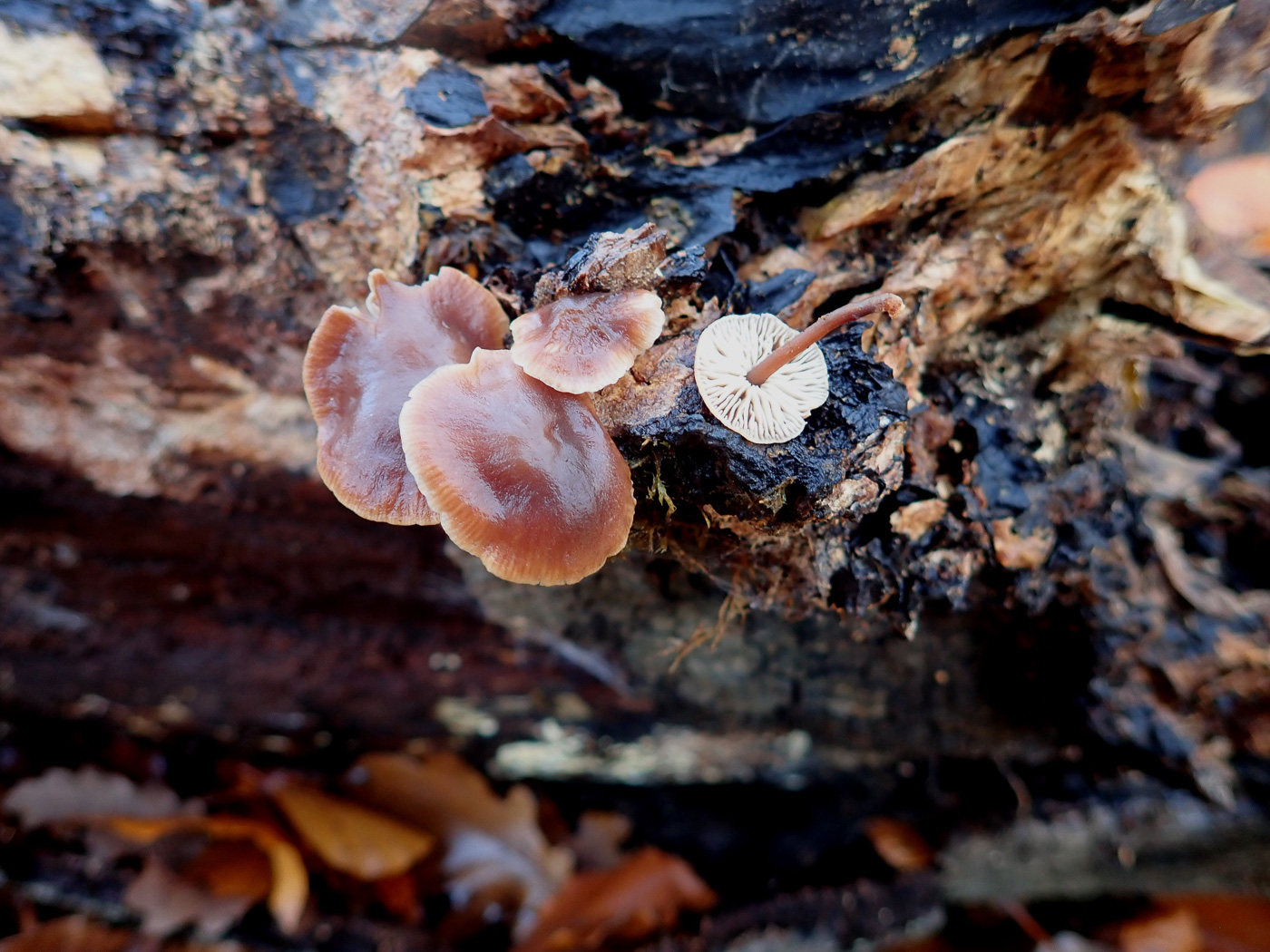
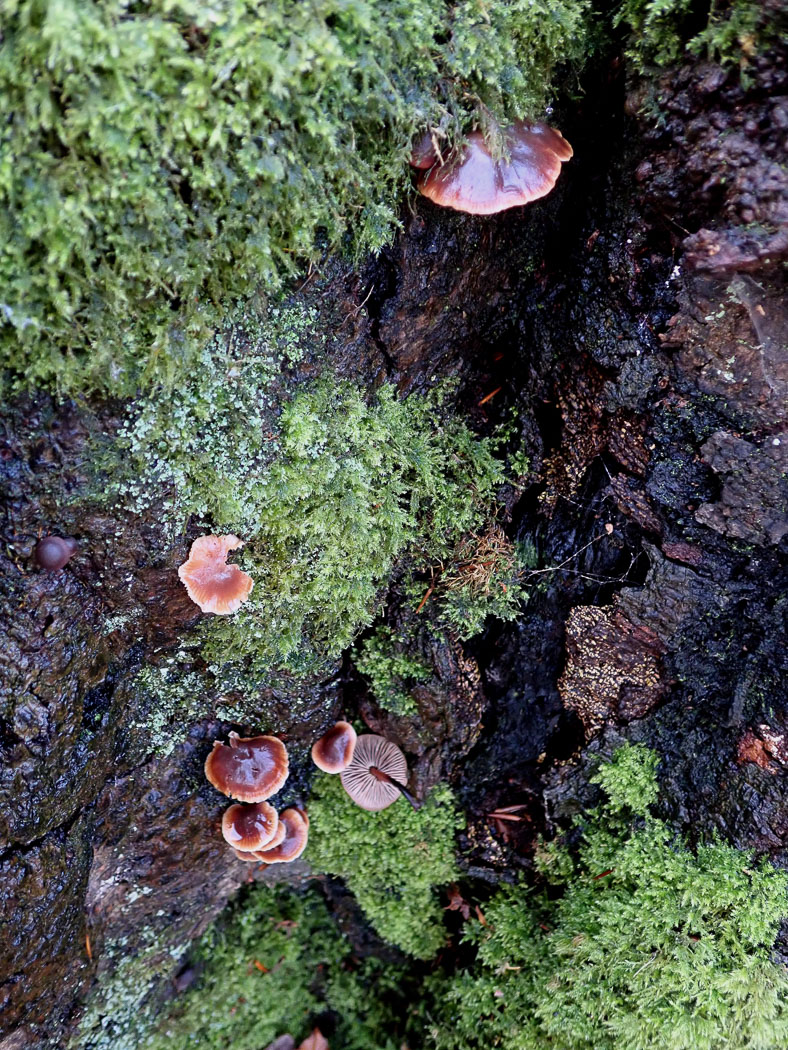
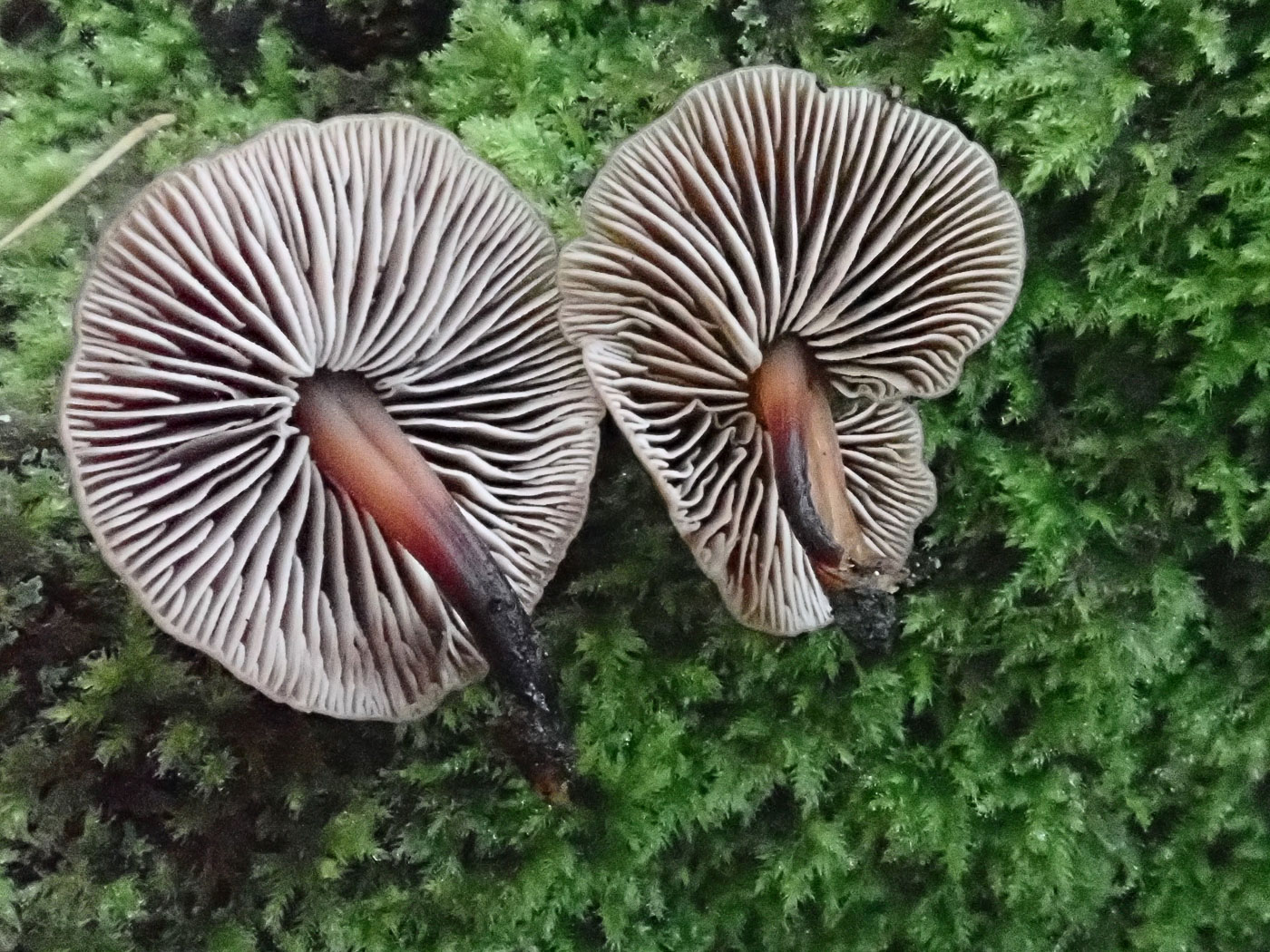
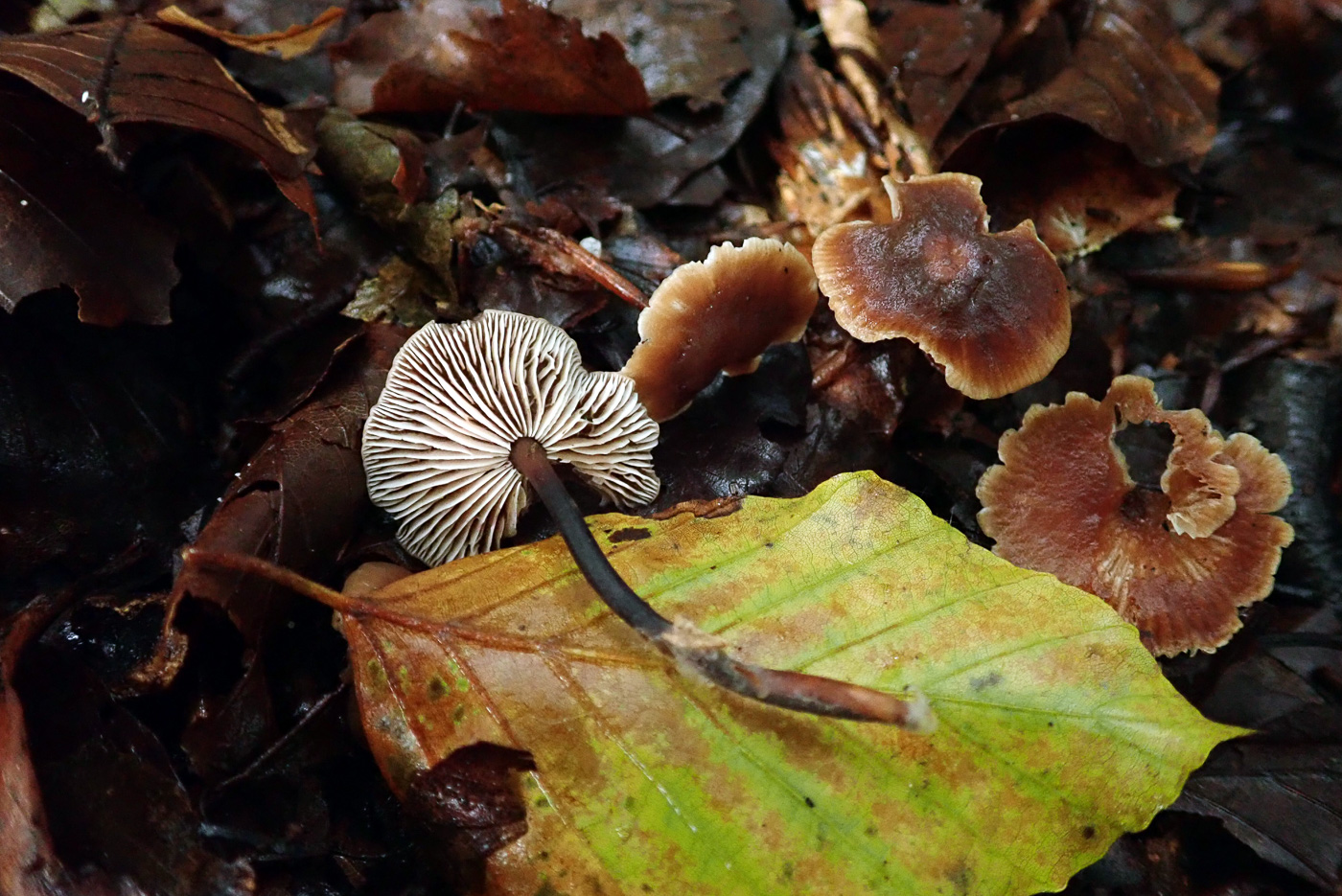
|
Gymnopus brassicolens (Cabbage Parachute) Nov 25, 2022. In Egypt Woods on a fallen Beech stump Penny and Sarah Ebdon found two separate collections of this quite unusual and very smelly species! First impressions before picking one were that it was a Mycena, maybe M. haematopus, but on turning one over and putting it to her nose, Penny immediately knew it had to be one of two extremely similar species which have this very unpleasant pervasive smell of overcooked cabbage mixed with garlic! Both previously in genus Micromphale, the two are now placed in separate genera but remain a challenge to distinguish between. The other species, now Marasmiellus foetidus, luckily has larger spores and a spore print therefore was taken and confirmed Penny's ID today. However, both species look and smell much the same and can be found on sticks, twigs, woody litter, or actually on a stump as here. See also in Finds 2020 October 14th. Oct 14, 2020. The smell of this small species packs a punch! Previously in the genus Micromphale (and possibly about to move to Marasmiellus) it was found by Penny Cullington in Beech litter in Kings Wood. Caps are only about 2 cms across but are bright red brown with a pale rather frilly rim; gills are crowded but shallow; the stem is dark red to black and almost woody. Put it to your nose for a whiff of overcooked school cabbage mixed with garlic - unmistakable. |
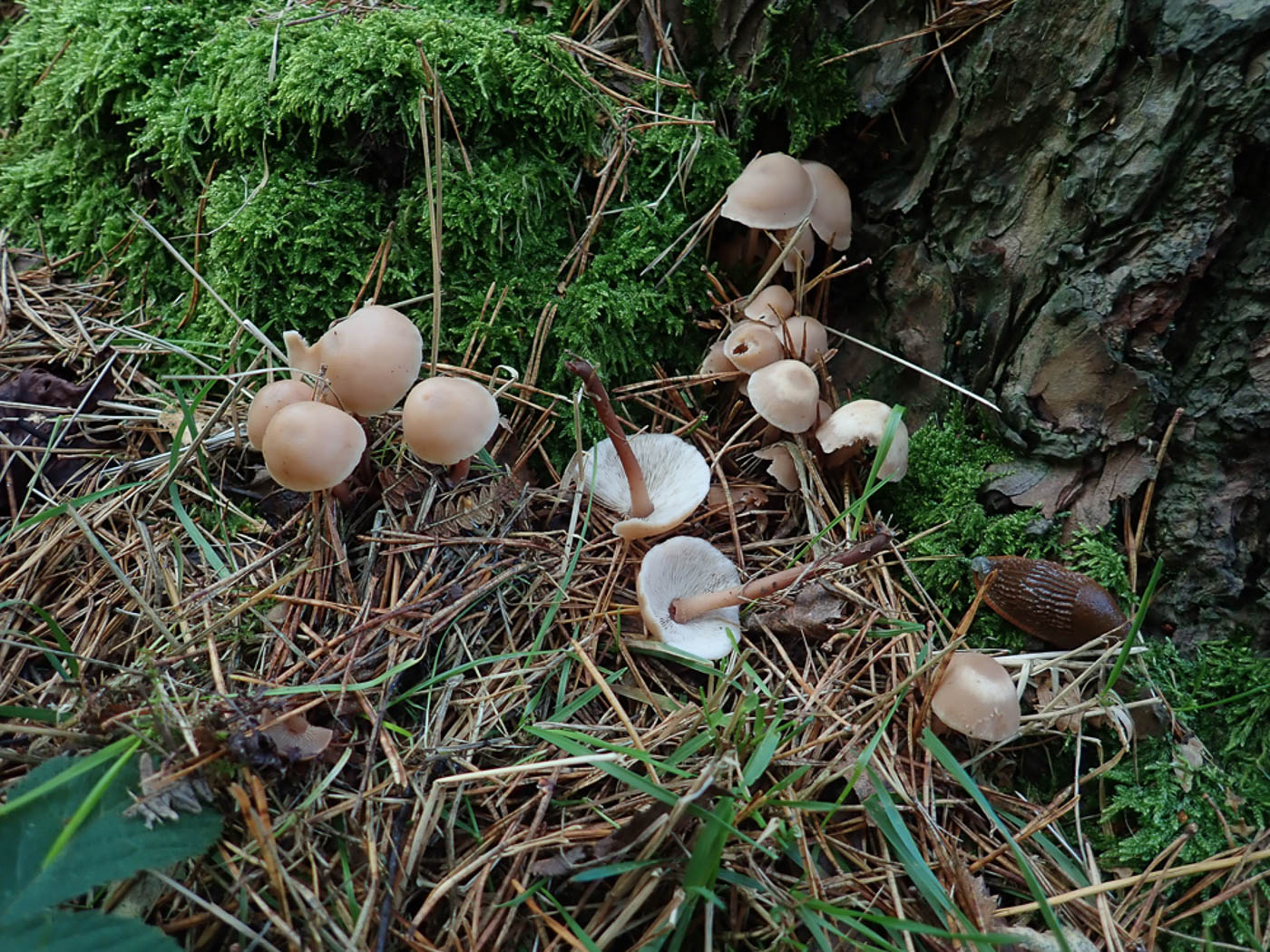 





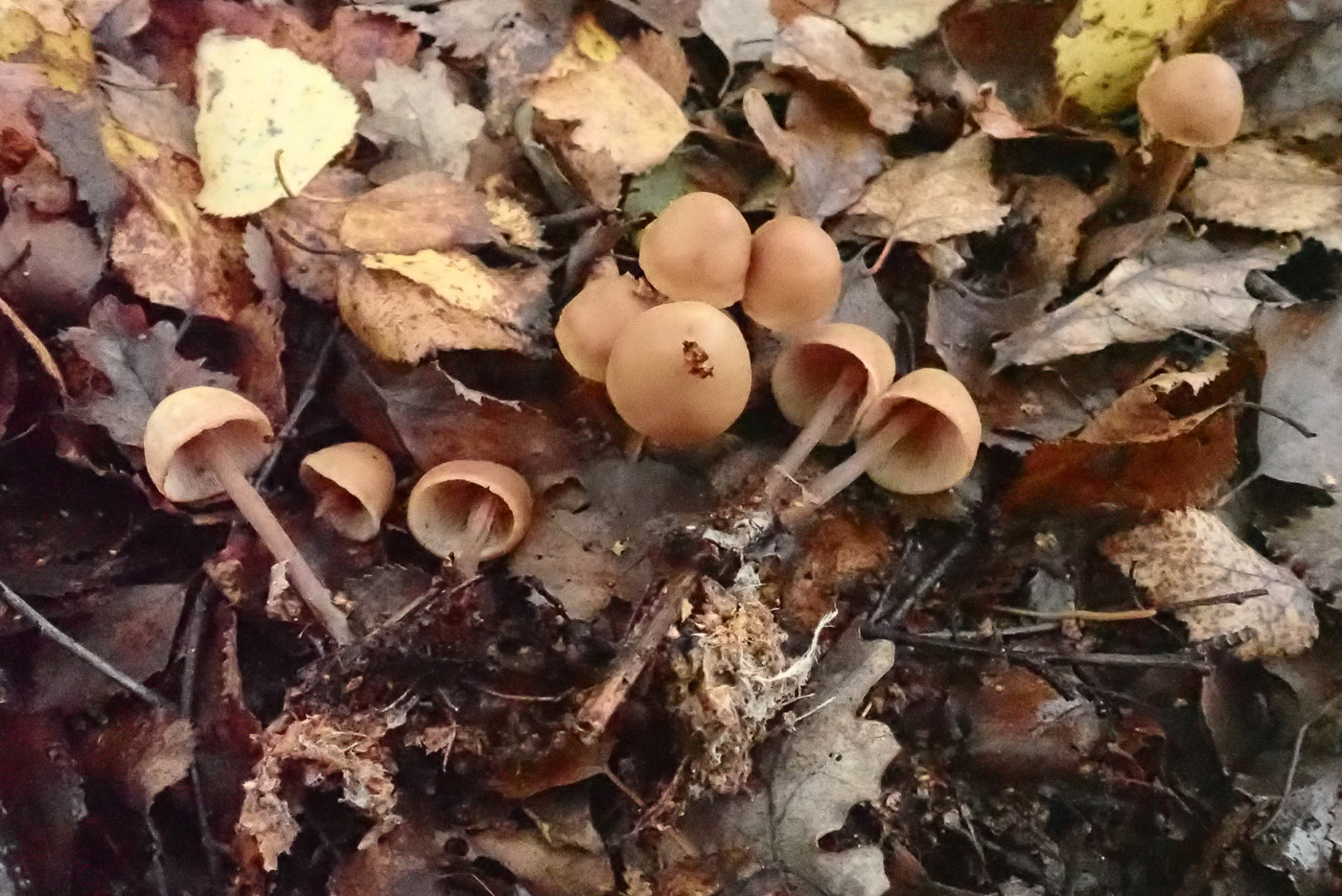
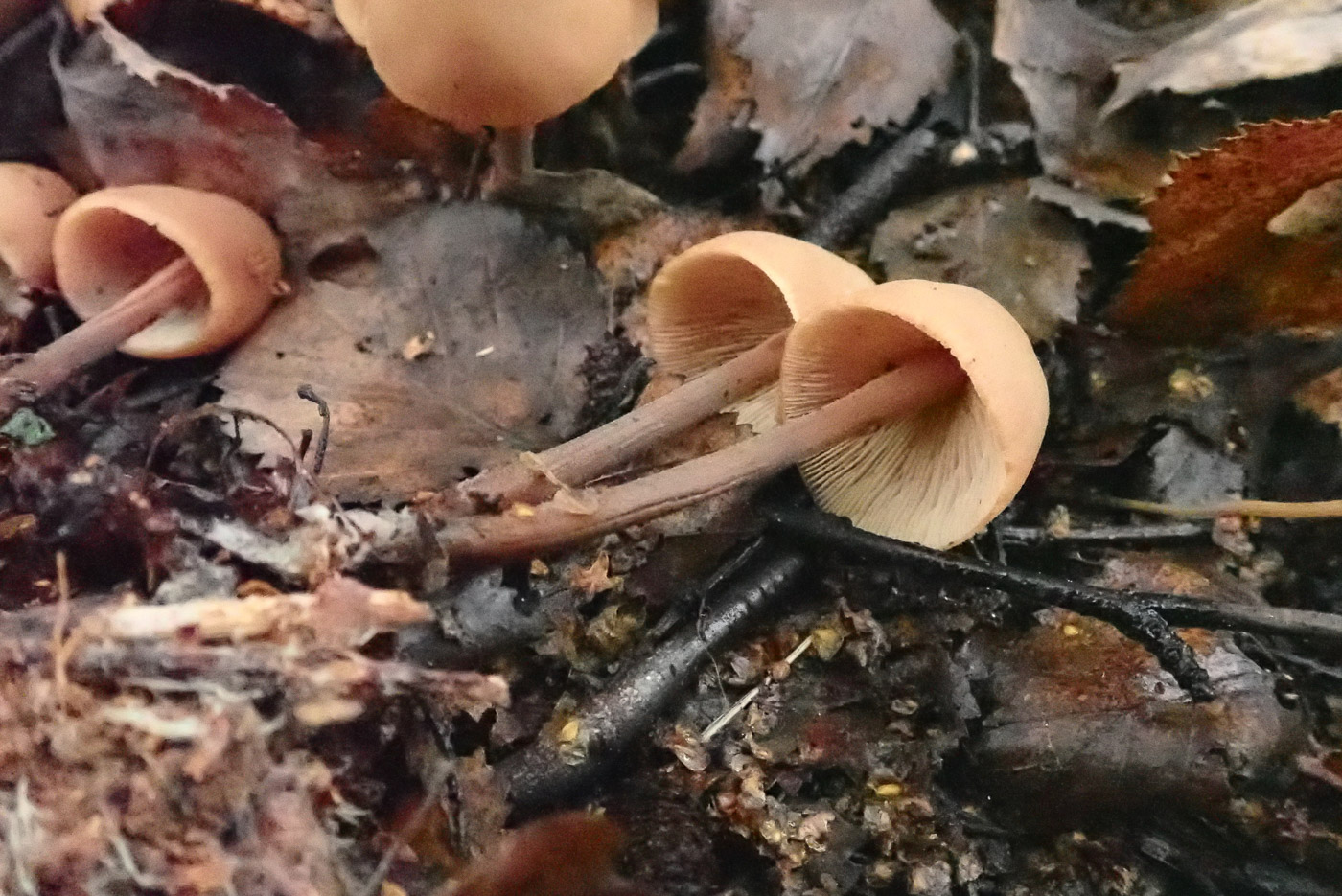
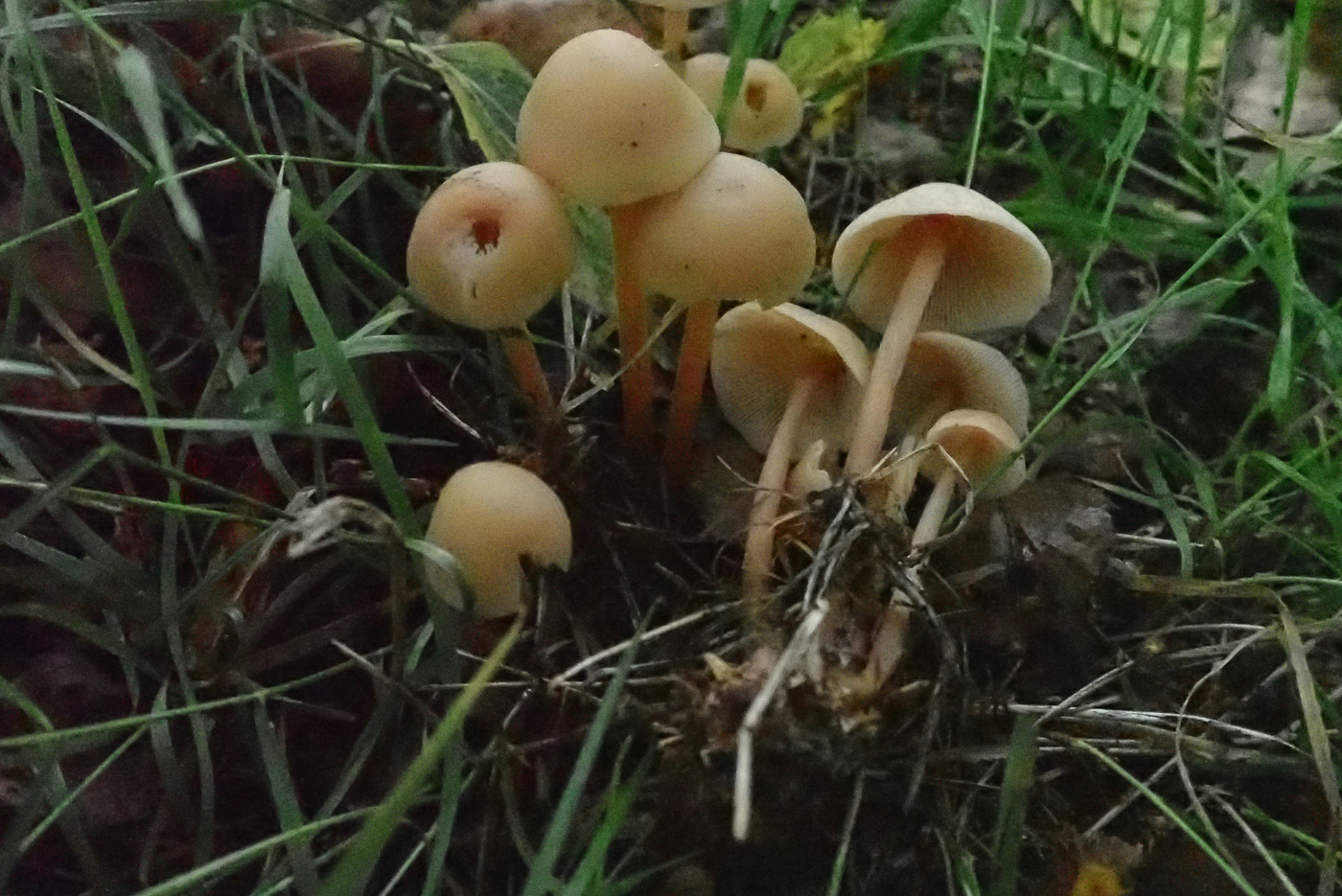
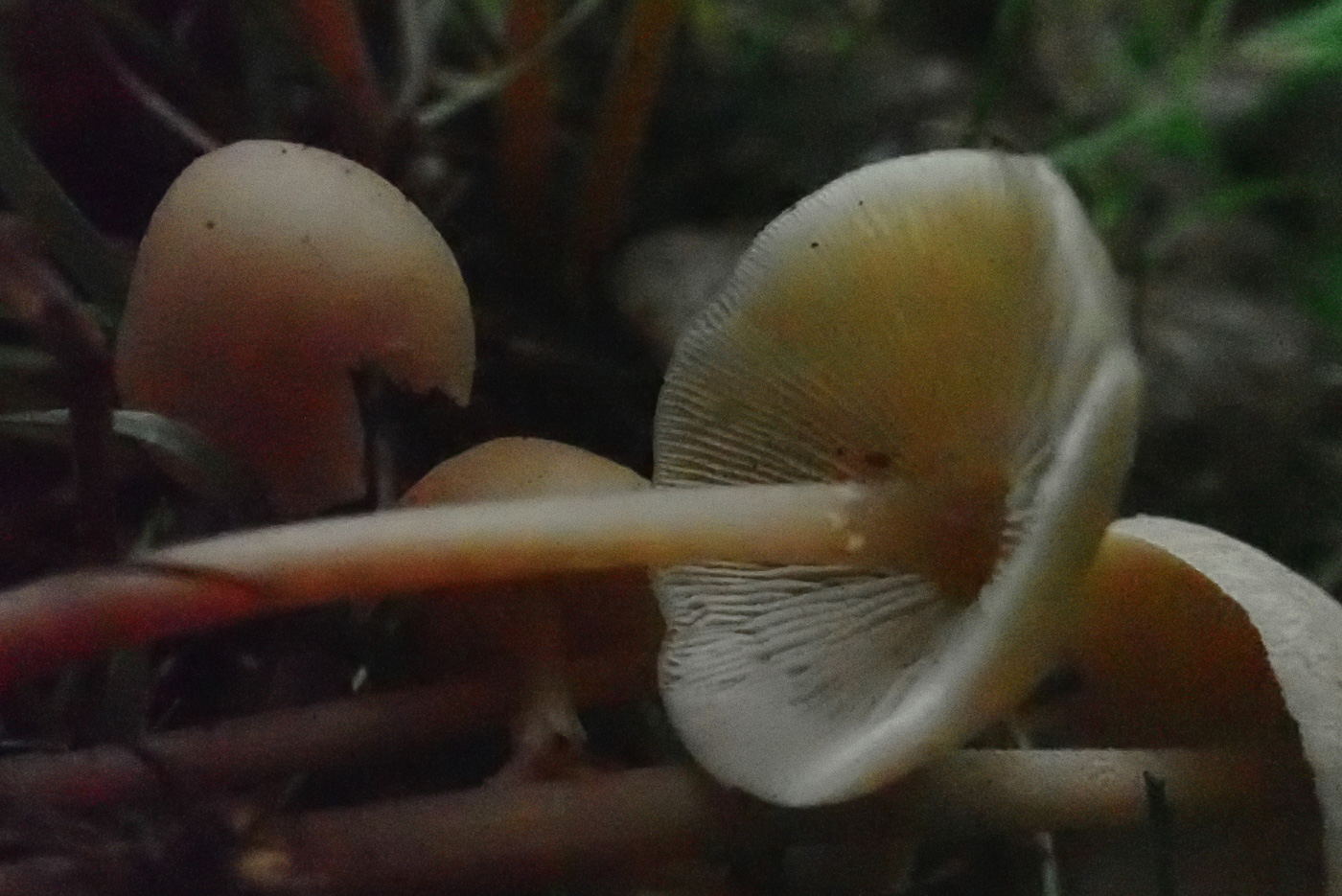
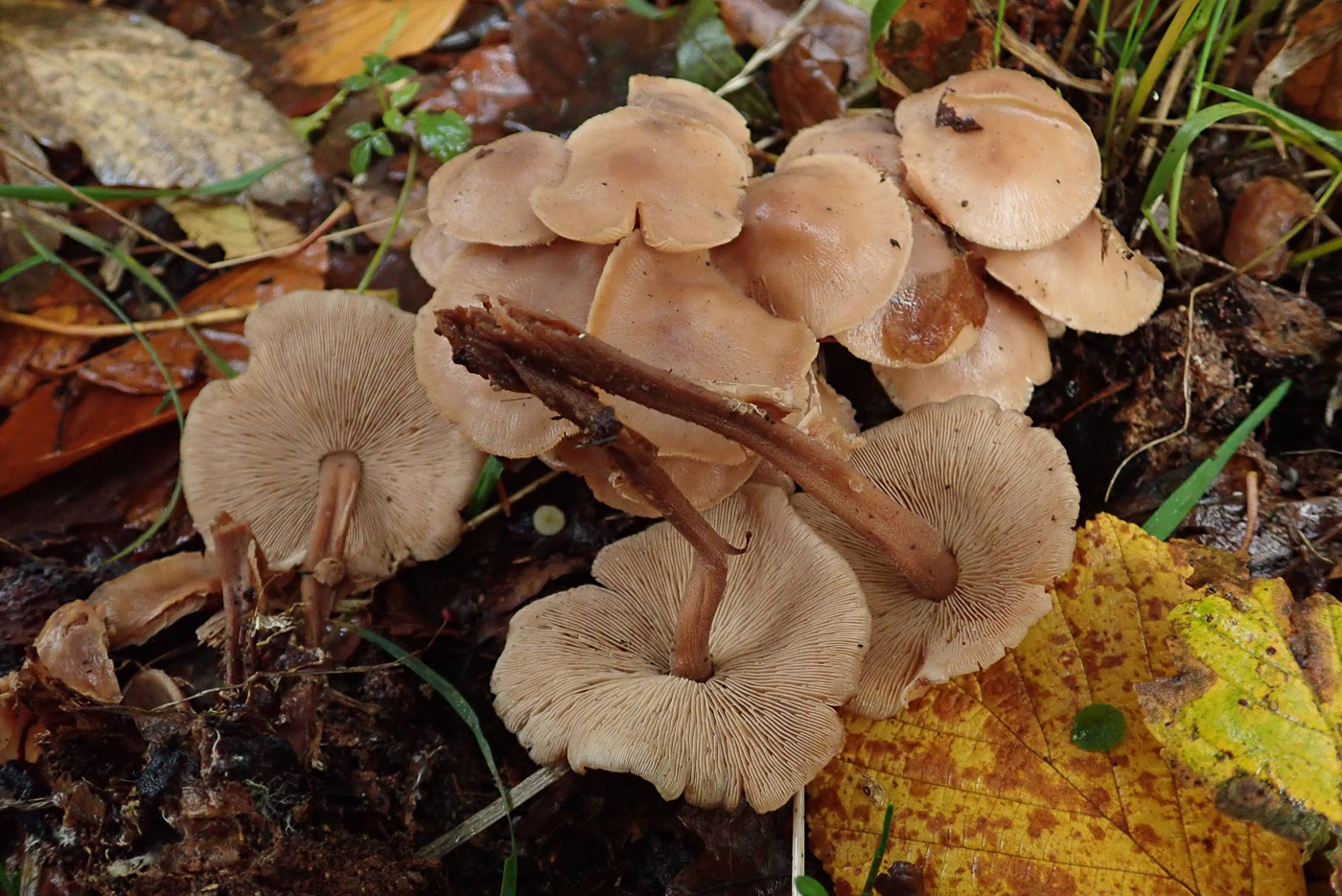
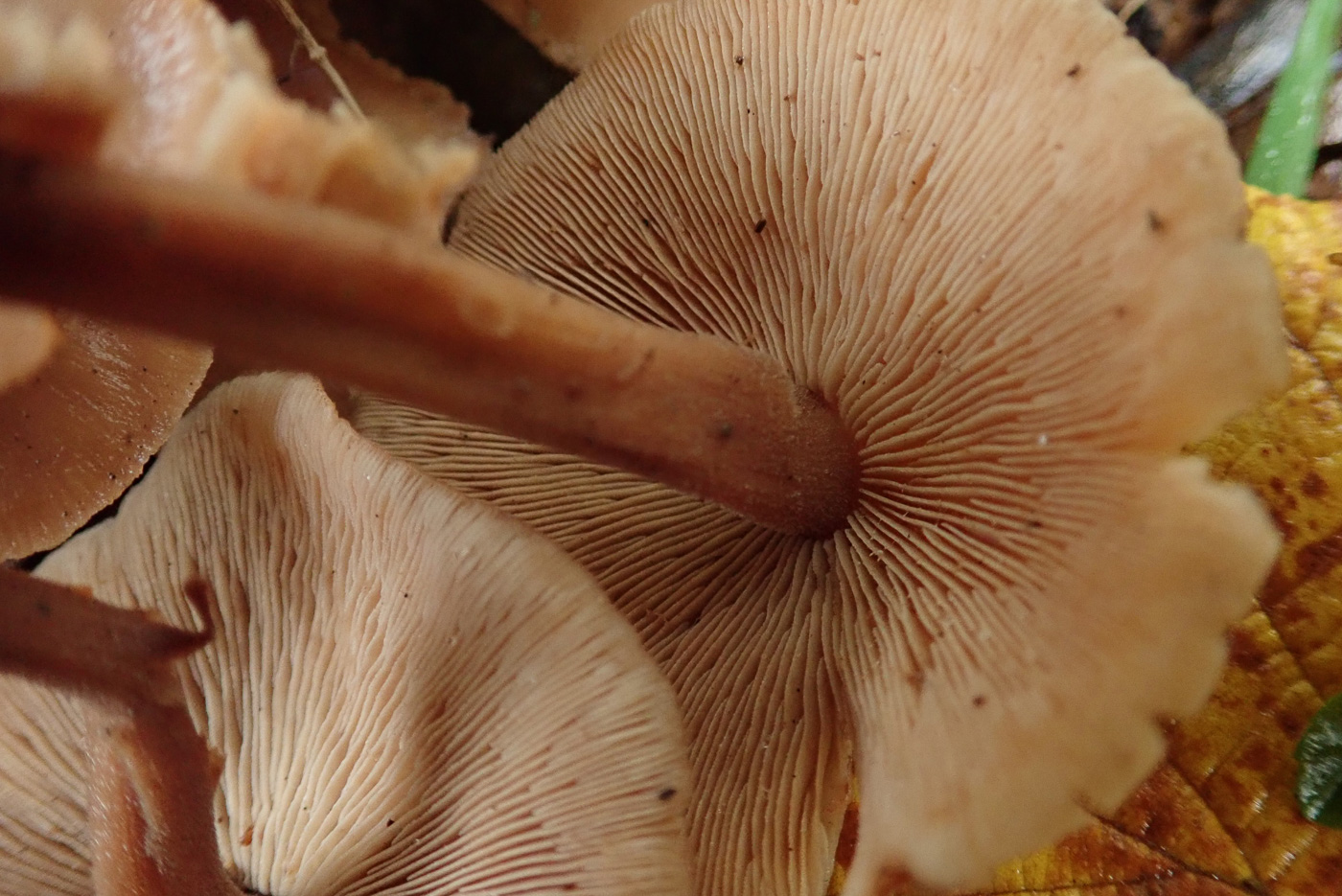
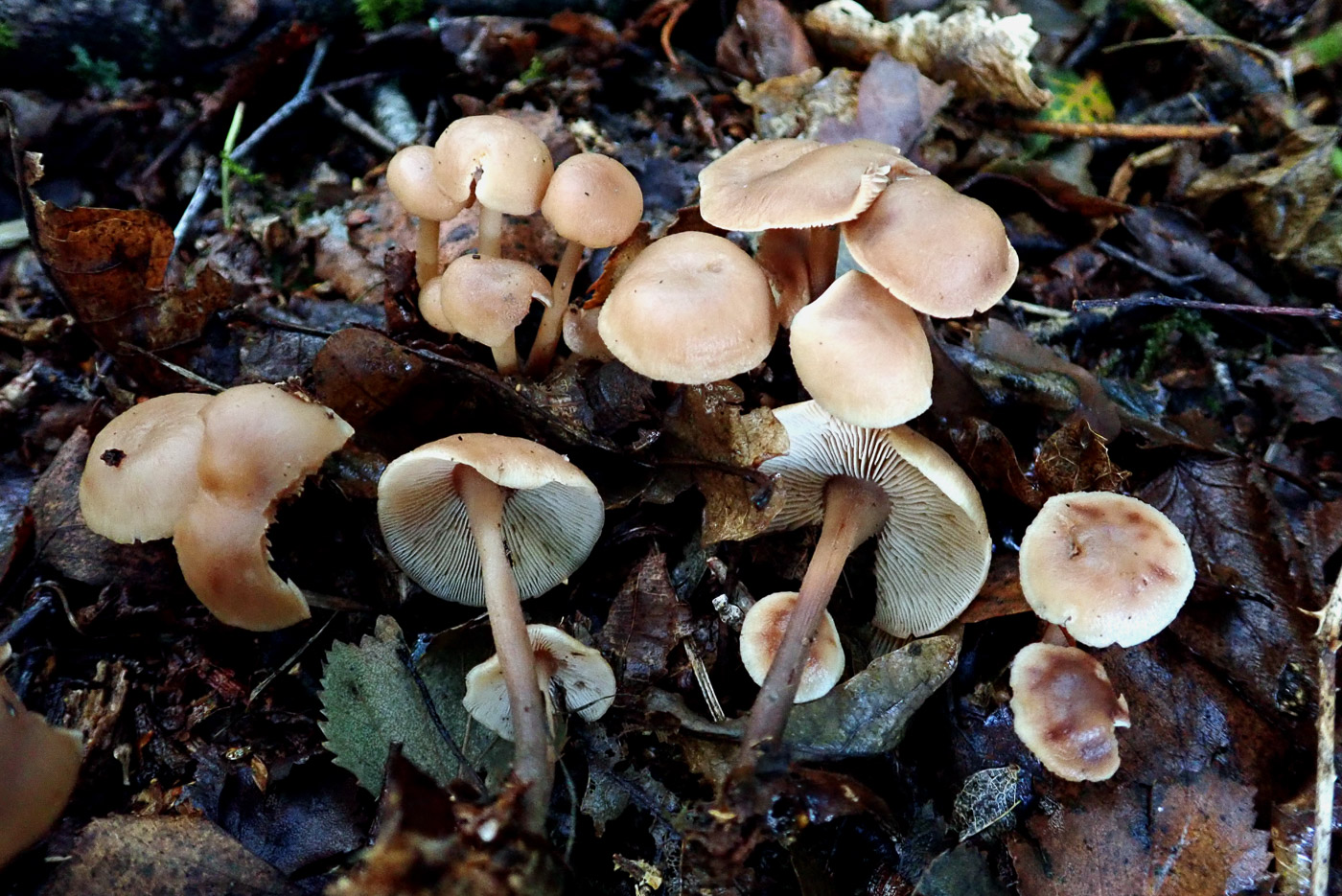
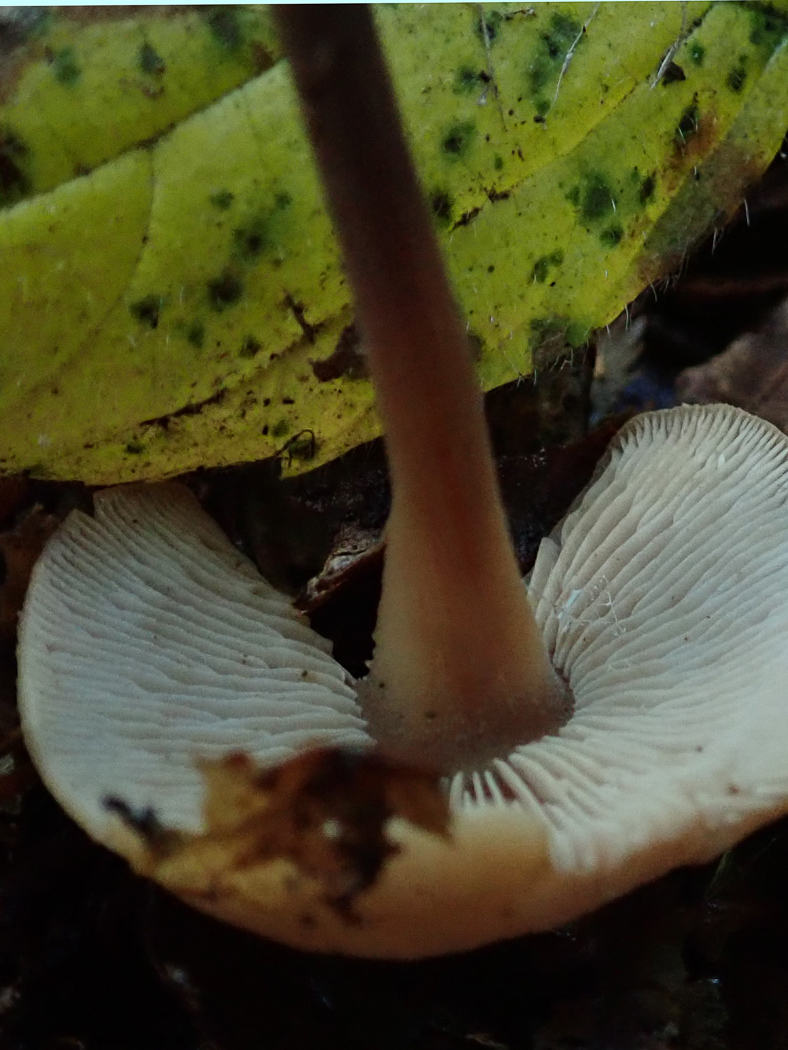
|
Gymnopus confluens (Clustered Toughshank) Oct 8, 2024. At Turville Heath Penny found this group at the base of a Pine though the species is probably more frequent in deciduous litter where it is very common. Features to note: the crowded pale gills and reddish stem which, however, is finely furry all over - this feature helping to separate it from the similar G. erythropus which has a shiny smooth red stem though is less frequent. Aug 4, 2023. In Hodgemoor Woods Penny spotted a perfect circle of fungi in the distance under Beech and went to investigate, discovering to her surprise that it was this species. Not known to form rings in this way, and new to Penny in this form, the species is common, often but not always in tight clumps and has very crowded gills and a finely velvety stem. See the Masterlist for plentiful examples. Jul 17, 2023. At Turville Heath Penny found this common woodland species just beginning to emerge under the Limes. The caps were still less than 1 cm across but the clustered habit, crowded gills and finely furry stem surface gave away its identity. Nov 23, 2022. At Turville Heath Penny at first found very little amongst the longish grass and thick rather soggy leaf deposit, but eventually was rewarded with a few bits and pieces. The larger specimen seen here was found first separately and not instantly recognised until the cluster and also the immature sspecimens were spotted nearby (seen in photo 2). In dry conditions when the species can be found in large clusters and the stems are obviously finely furry-hairy it is quite easy to recognise with its very crowded gills, but not so when growing singly as can happen (despite its common name) and when the wet stems look somewhat smooth as here. Nov 13, 2021. At Turville Heath under Birch Penny found several clusters of this quite common species, an LBJ but usually fairly easy to recognise through its clustered habit in litter and its very crowded gills. The stem has a fine covering of hairs also which separates it from the sometimes similar G. erythropus which has a smooth and distinctly red stem. See also dated Oct 5th. Oct 5, 2021. In longish grass under Birch in Turville Heath Penny found this cluster. Having the typical rather flexible rubbery texture of the genus (cap and stem), this particular quite common species can be recognised in the field by its very crowded gills (seen in photo 2) and (if viewed with a handlens) a pruinose stem - ie covered in very fine hairs. Sometimes mistaken for G. erythropus - another clustered Toughshank with quite crowded gills - the two can be separated by the stem surface: smooth in G. erythropus but hairy in G. confluens. Oct 27, 2020. Penny C. was surprised by the large cap size of this cluster of mature fruit bodies growing in Oak litter near Ibstone. Our previous photo (see Oct 01) is of much younger paler specimens with almost white gills, whereas today the caps were about 4 cm across and the gills were pinky-beige though still very crowded - a diagnostic feature of this species. Stems are typically grooved and finely velutinous (best seen with a handlens), not to be confused with the stem of G. erythropus which is also reddish below but is always shiny and smooth. Oct 1, 2020. This collection (previously in genus Collybia) was found growing under Oak at Turville Heath by Penny Cullington. A typical rather rubbery flexuouse Toughshank, it is quite common and similar to many other brown capped mushrooms growing in woodland litter until you turn one over and notice the very crowded pale gills and stem which is finely furry all over and gradually darker lower down (also often hollow). Its clustered habit is also typical though occasionally one finds singletons! (Note the detailed photo is not out of focus but might appear so because of the furry stem surface.) |
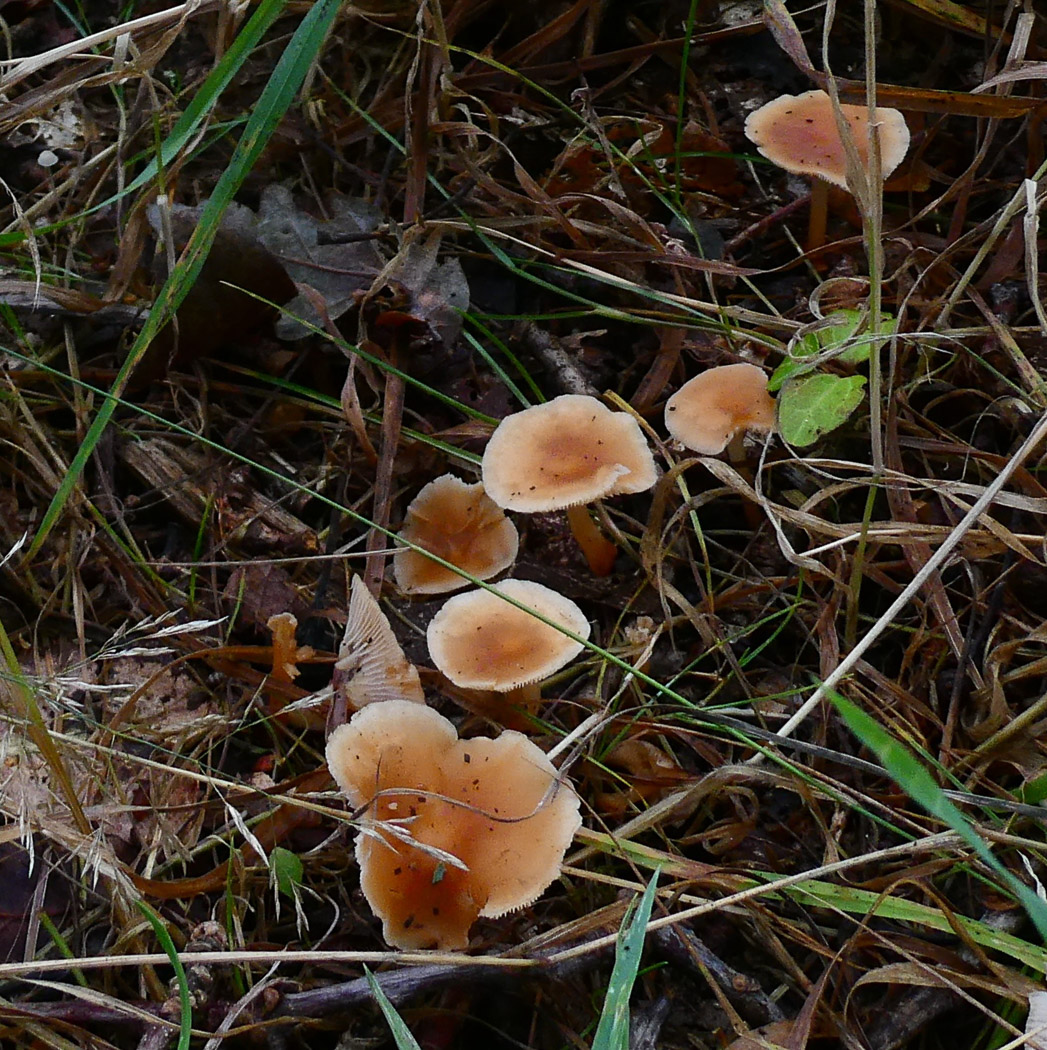
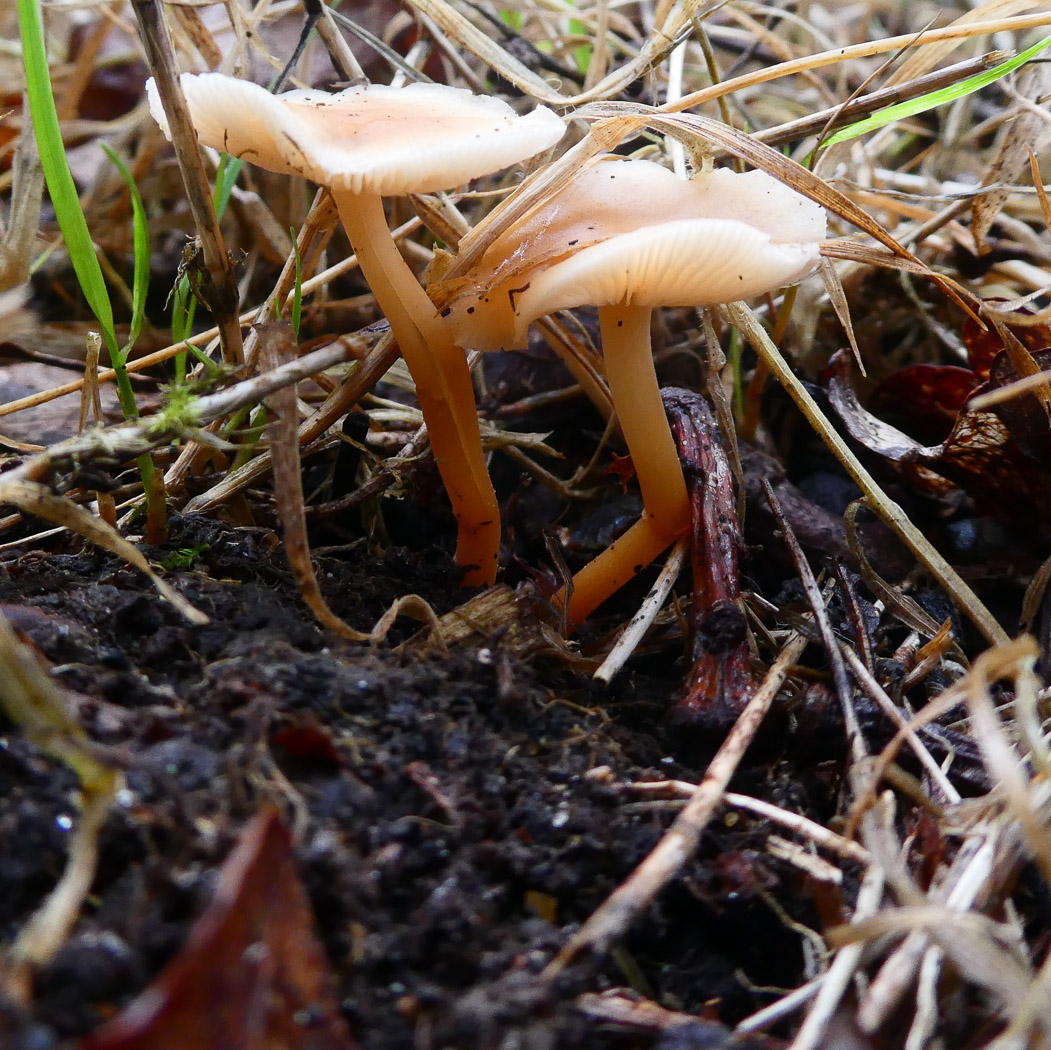
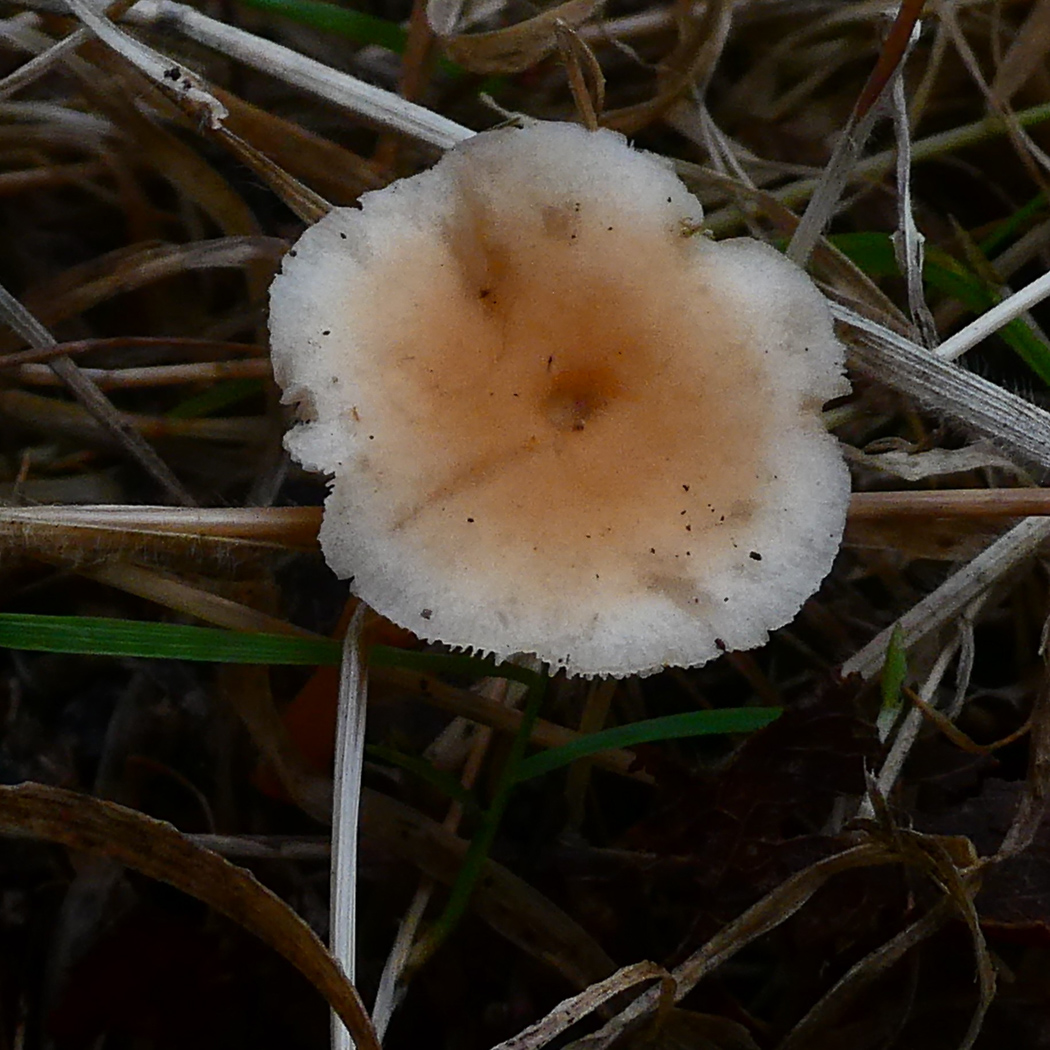
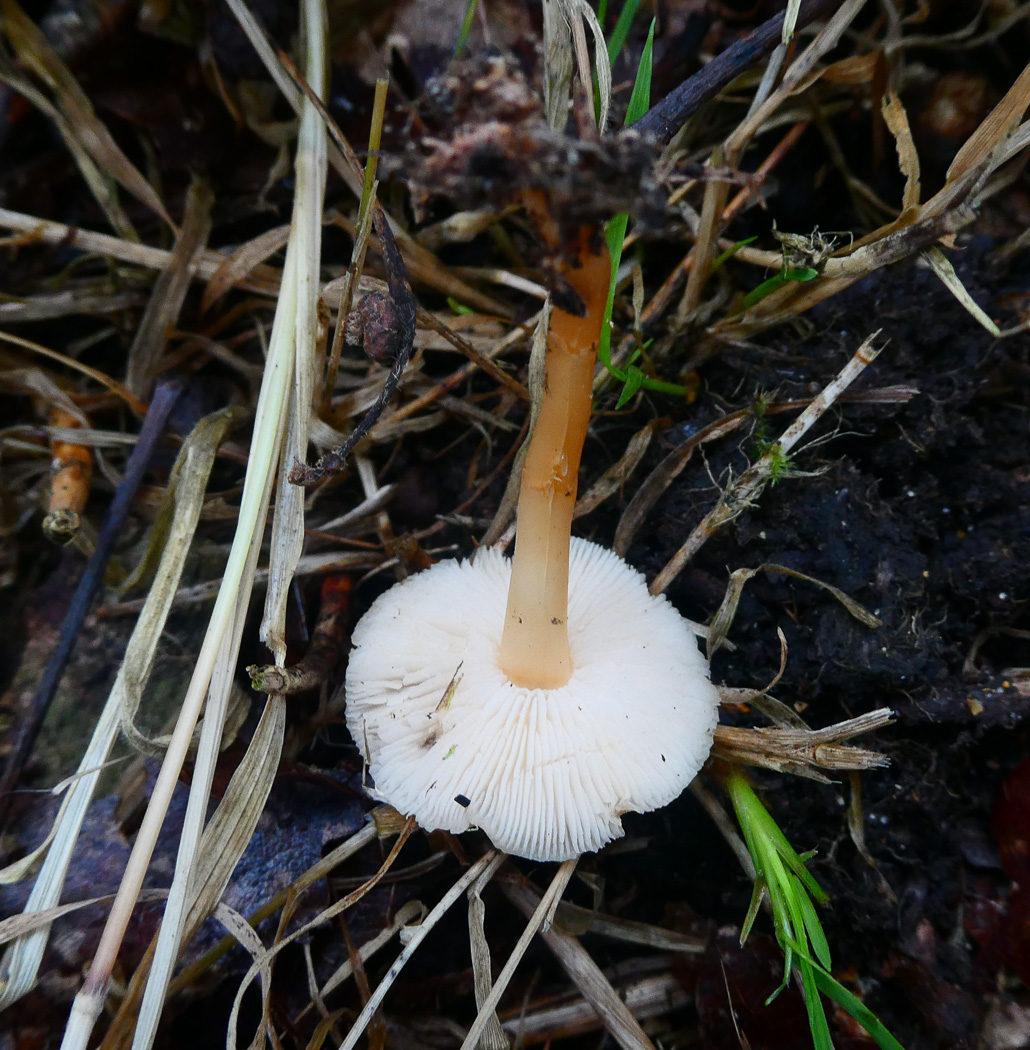 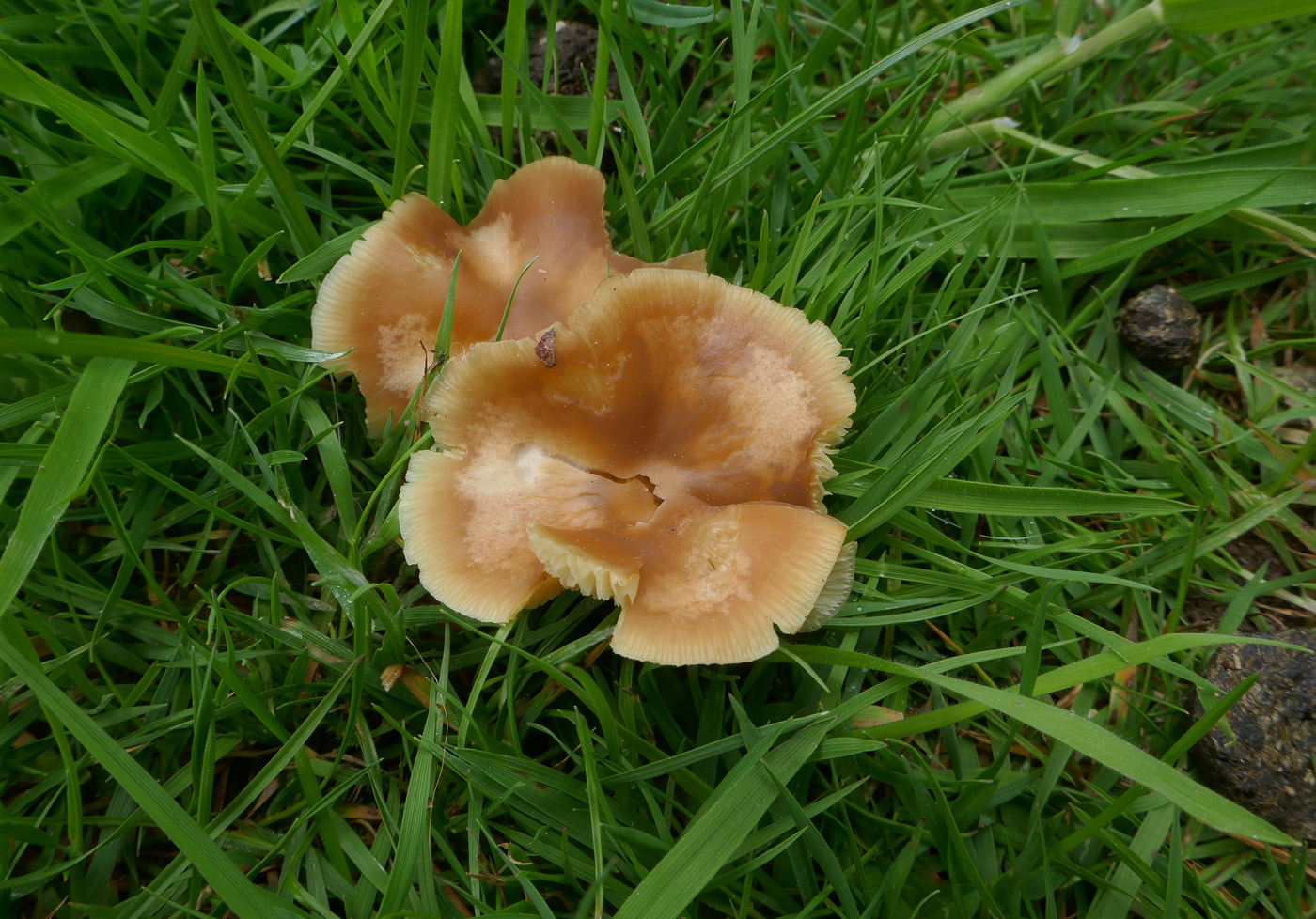  
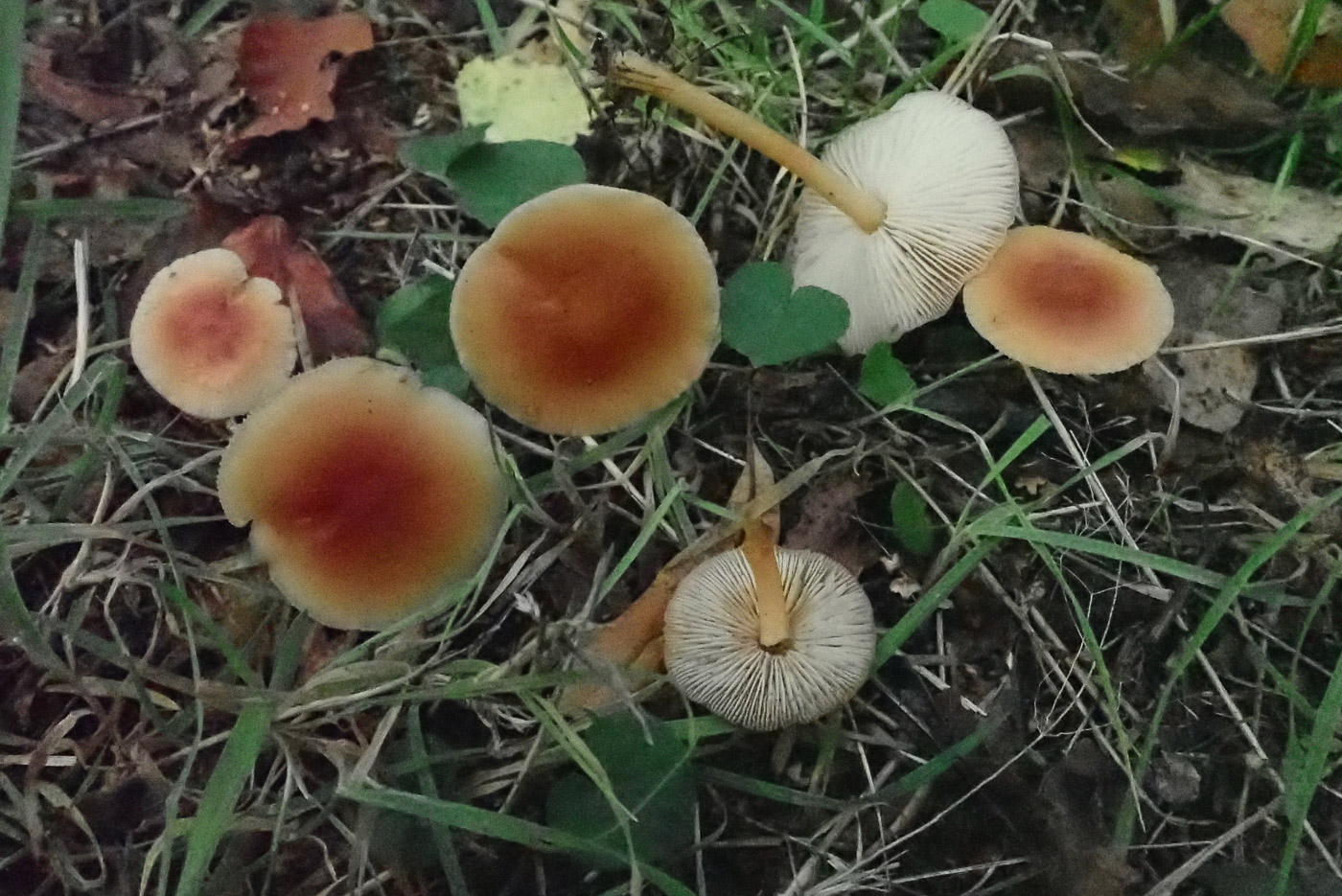
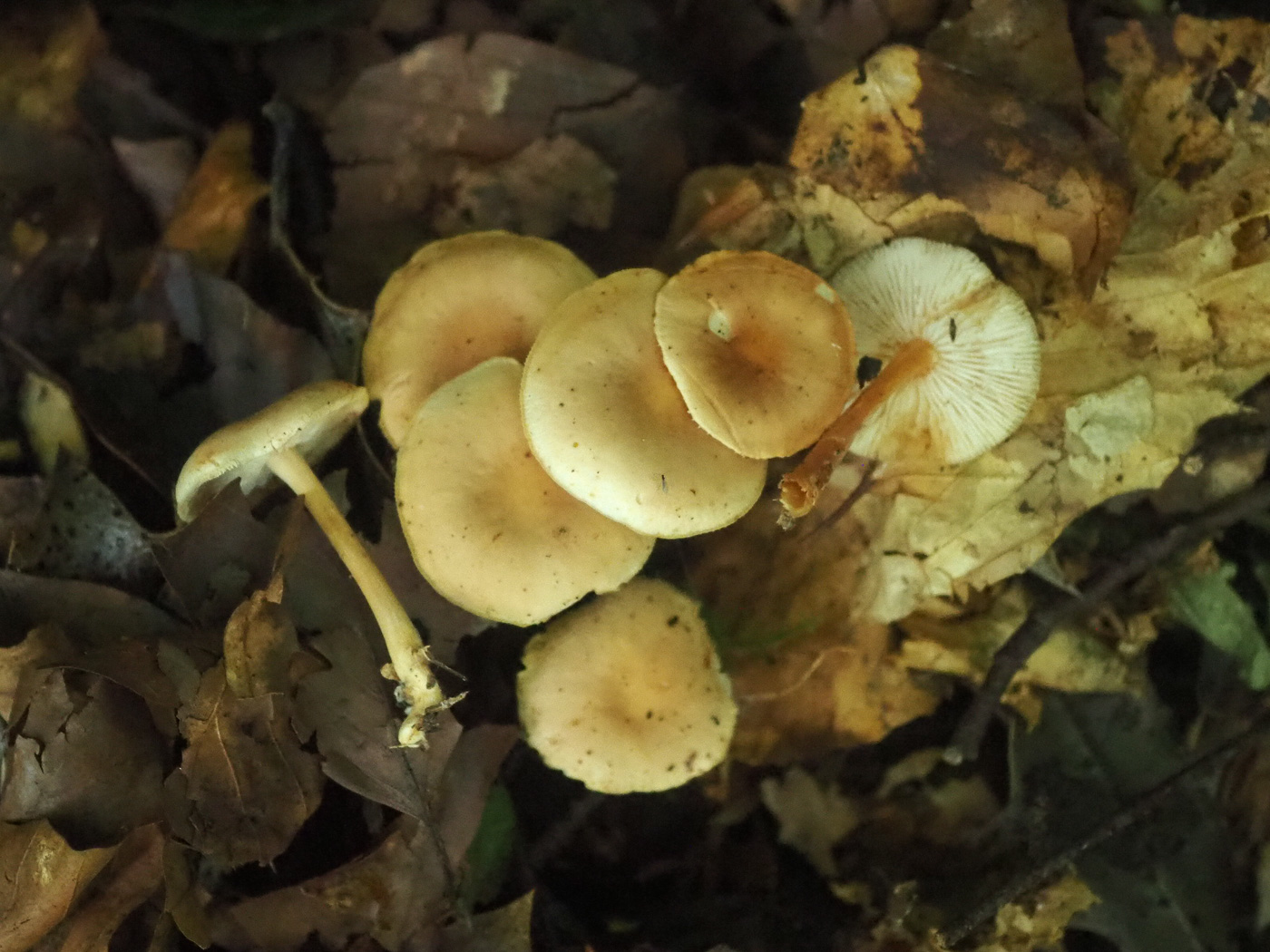
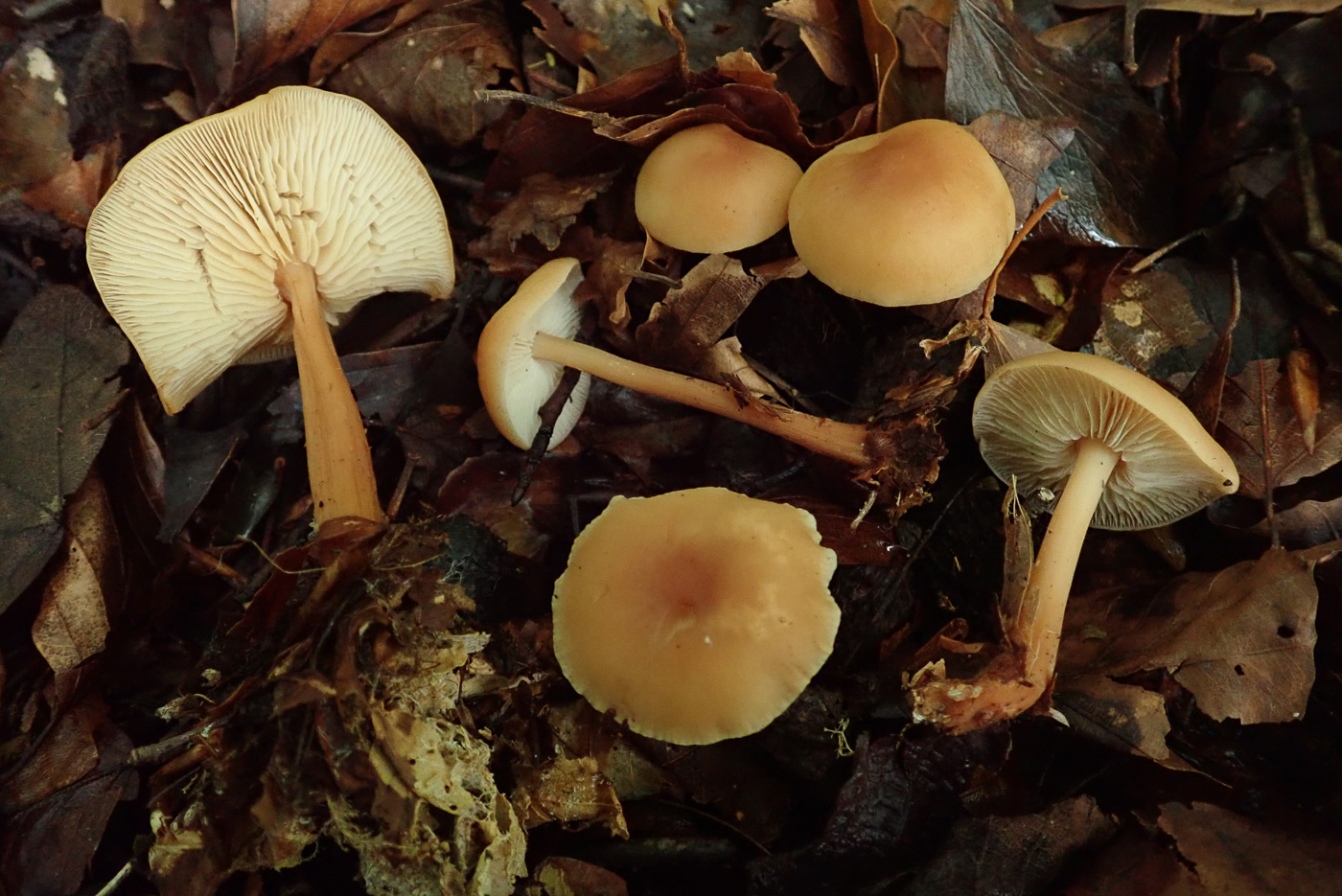
|
Gymnopus dryophilus (Russet Toughshank) Sep 9, 2024. At Stampwell Farm Jackie Ewan reports a few things beginning to appear now. This is one of them, the easiest Earthball to identify owing to its dirty yellow colour and tough hard scaly skin. It is often found under Oak. May 27, 2024. In a grassy paddock at Stampwell Farm Jackie Ewan spotted an early fruiting specimen of this very common mushroom - one that quite often appears in summer and earlier than other members of this genus, heralding the onset of the autumn season. It's still a bit early for that now, however! Sep 14, 2023. In woody litter in the Lime avenue at Turville Heath Penny found this cluster of a very common early autumn woodland species - one that often seems to confuse, however. The genus as a whole has a rubbery flexible texture and doesn't easily snap when twisted which is a useful pointer. The cap colour of this species can vary considerably and the paler central cap is probably the more typical colour. Jul 25, 2023. In Oak litter in Bernwood Forest Penny and Paul found a few clusters of this common early season litter feeder. The rich cap colour is notable in damp conditions though is sometimes much paler than see here. Like others in this genus it has a rubbery texture and the stem stays undamaged when twisted. Oct 5, 2021. In longish grass under Birch in Turville Heath Penny found this common species, one which often appears early in the autumn in woodland areas but making a late appearance this year. The genus as a whole has rather flexible rubbery texture, and there are several far less common species with caps a similar colour to this one, but when fresh and damp as here the caps displaying a paler outer half as seen here is enough to confirm its identity. Aug 13, 2021. In deciduous litter in Tinkers Wood John Catterson found several fruitbodies of this common and often early fruiting species of the woodland floor. The rusty cap and stem colour contrast well with its white gills and this together with its flexible texture usually make it recognisable in the field, though John went to the trouble of checking the spore shape and size to make sure he was correct. Sep 24, 2020. Previously in the genus Collybia, this very common species of the woodland floor was found by Penny Cullington in Mousells Wood. It is usually one of the first woodland mushrooms to appear in Autumn, often in large numbers, but has been conspicuous by its absence in recent weeks. It has a soft rather flexible feel to it, also stem is hollow. |
 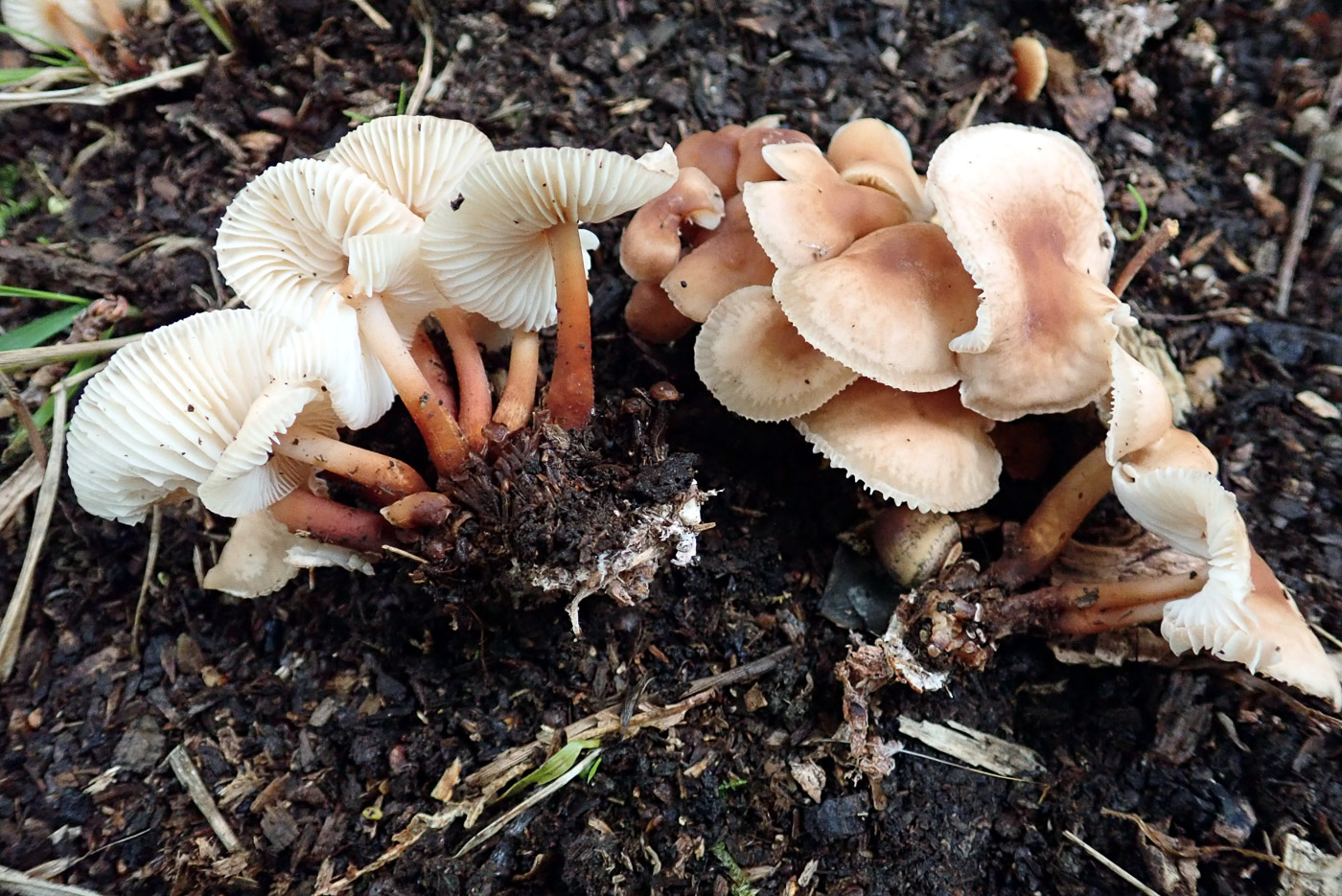
|
Gymnopus erythropus (Redleg Toughshank) Oct 8, 2023. New member Stuart Blackhurst wanted to know what this mushroom was, found growing in good numbers on his garden lawn in Burnham where woodchip had previously been laid. The shiny red stem is key to its identity though the cap colour can vary and fade much paler than seen here. Most often found in woodland litter, clearly the woodchip remains were sufficient for its needs here. Oct 6, 2020. This collection was growing in litter under Oak at Wotton Park Estate, found by Penny Cullington. A typical rather flexible rubbery Gymnopus species, the caps are pale, almost white, with a chestnut brown centre, the gills are cream to white, but the feature to note in the field is the stem. Shiny smooth, hollow and often grooved, the reddish colour towards the base contrast strongly with the rest of the fruit body. It also has a sweet smell. |
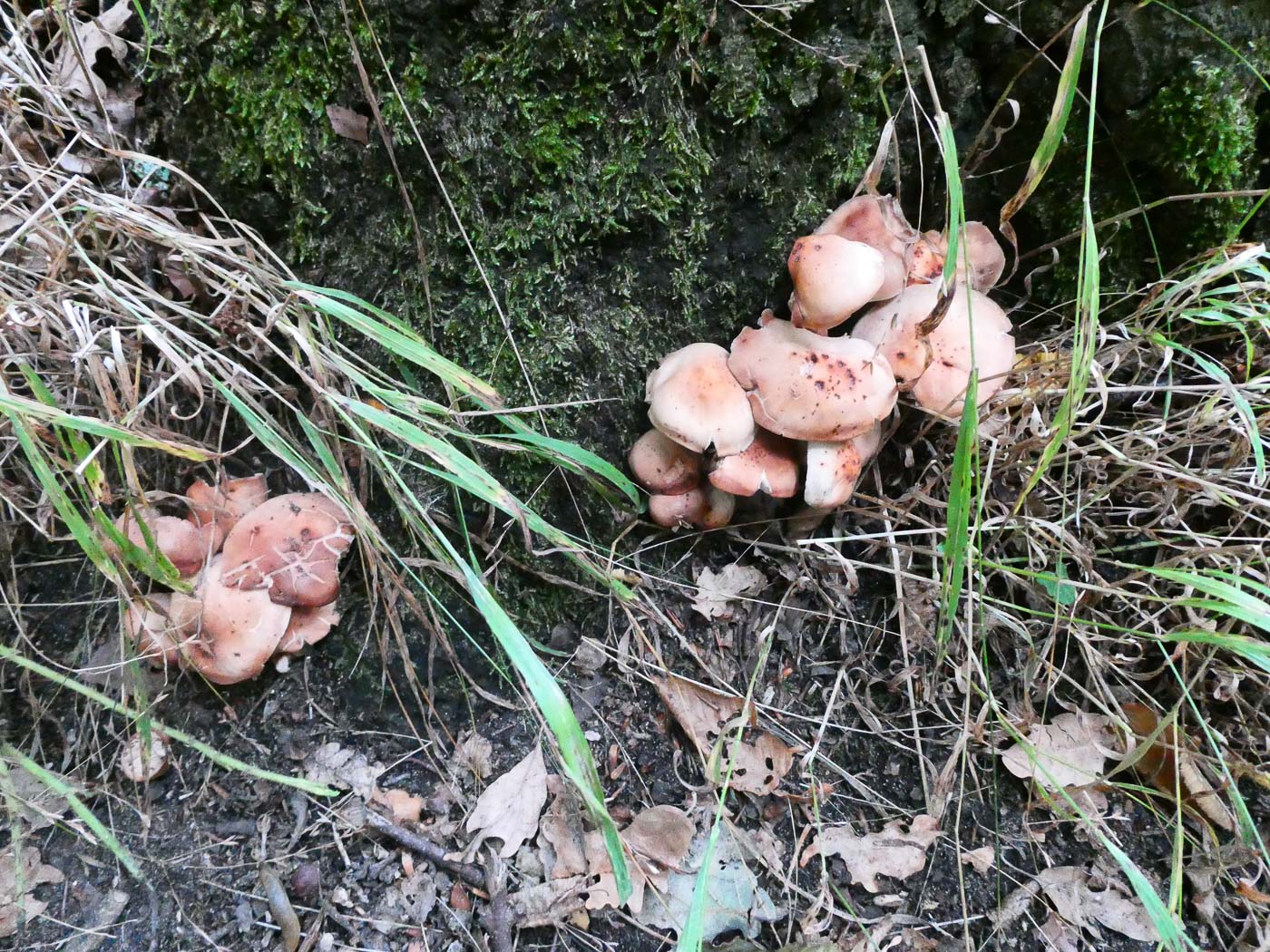
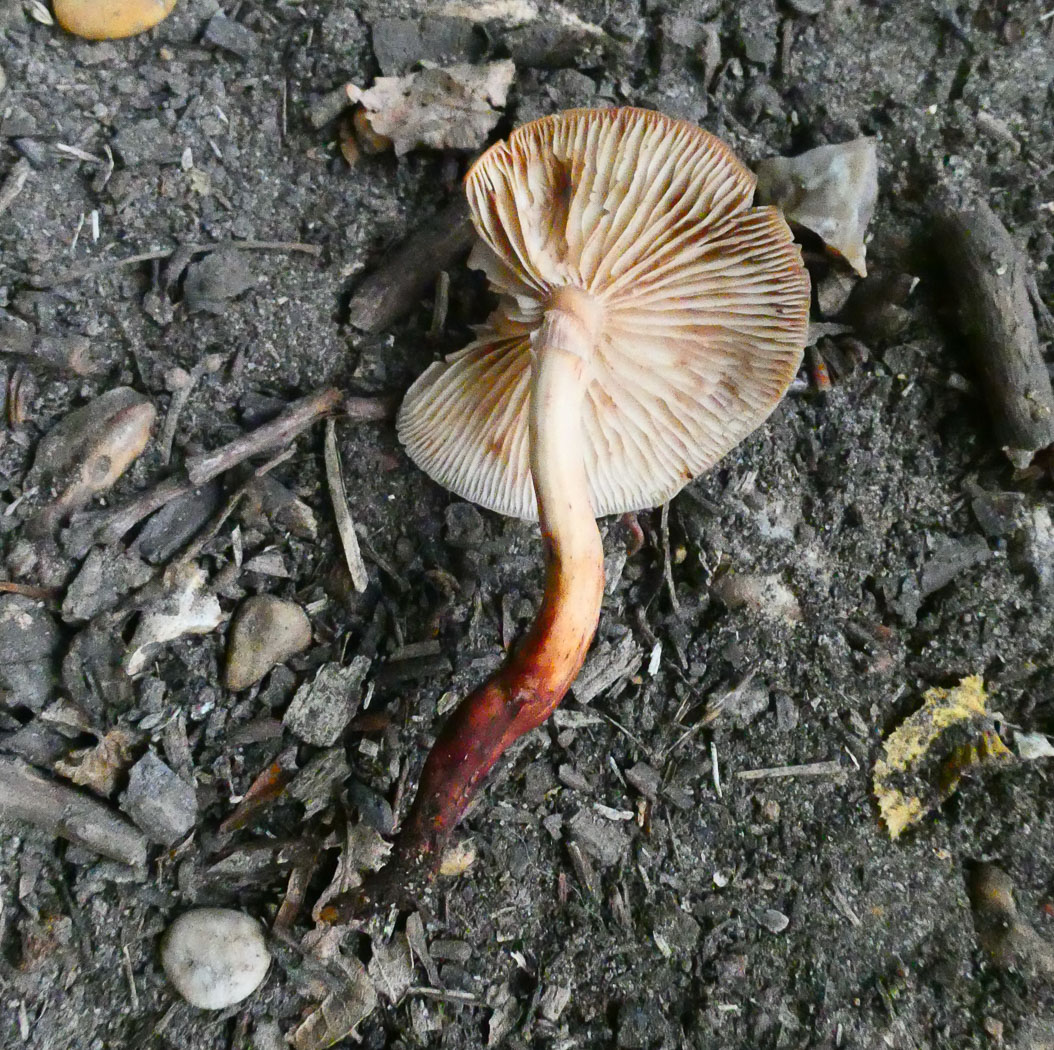 

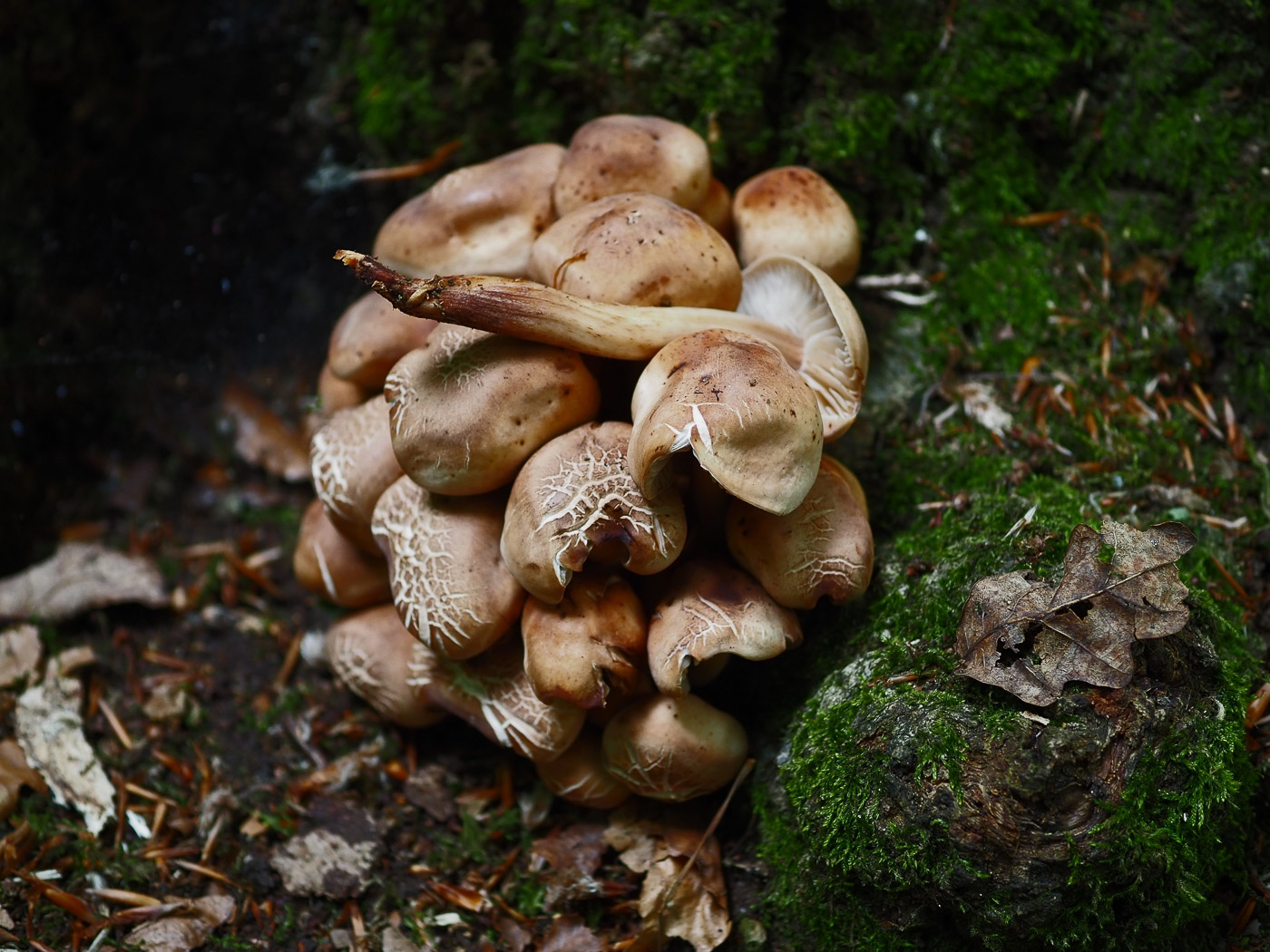
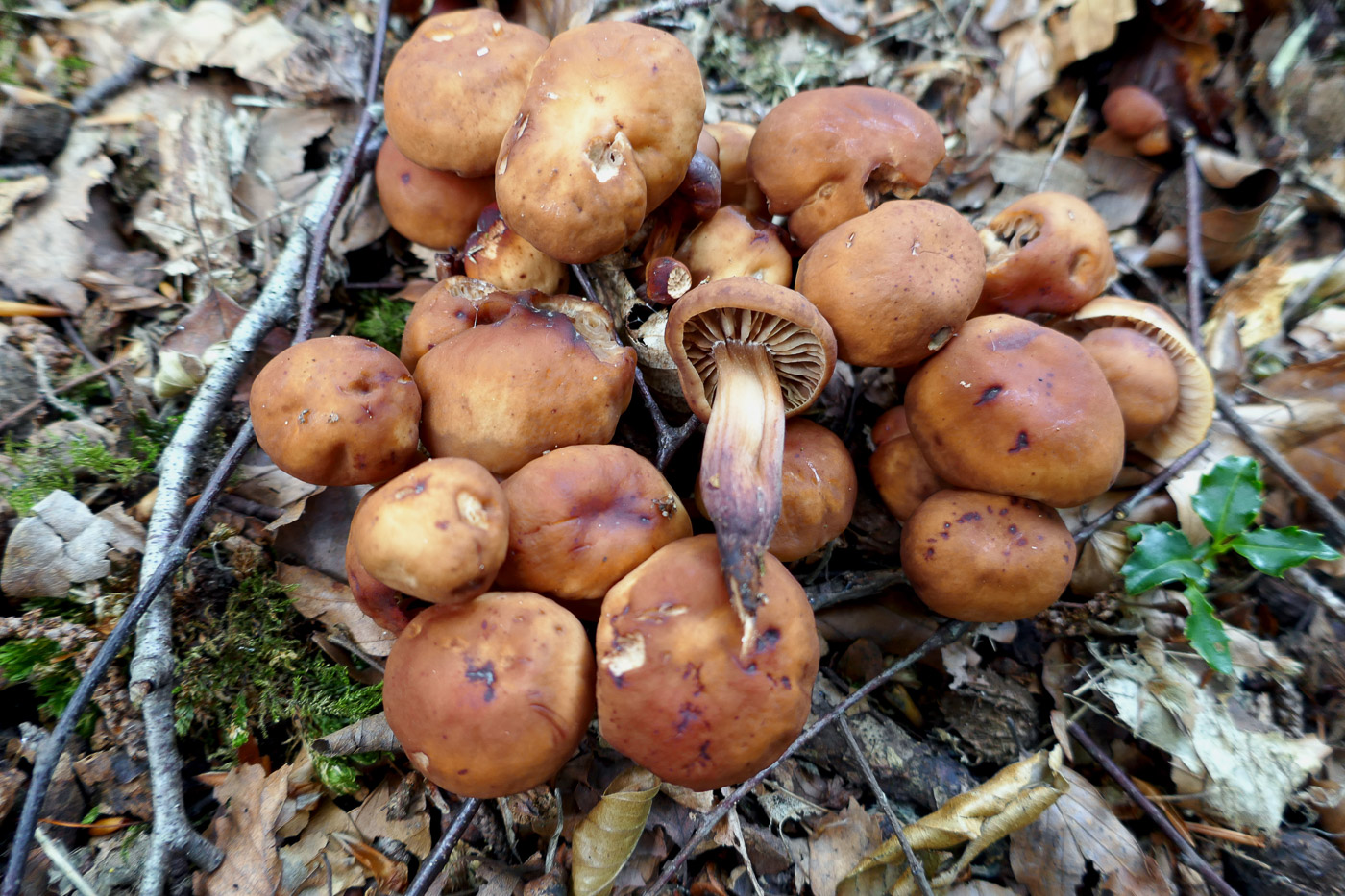
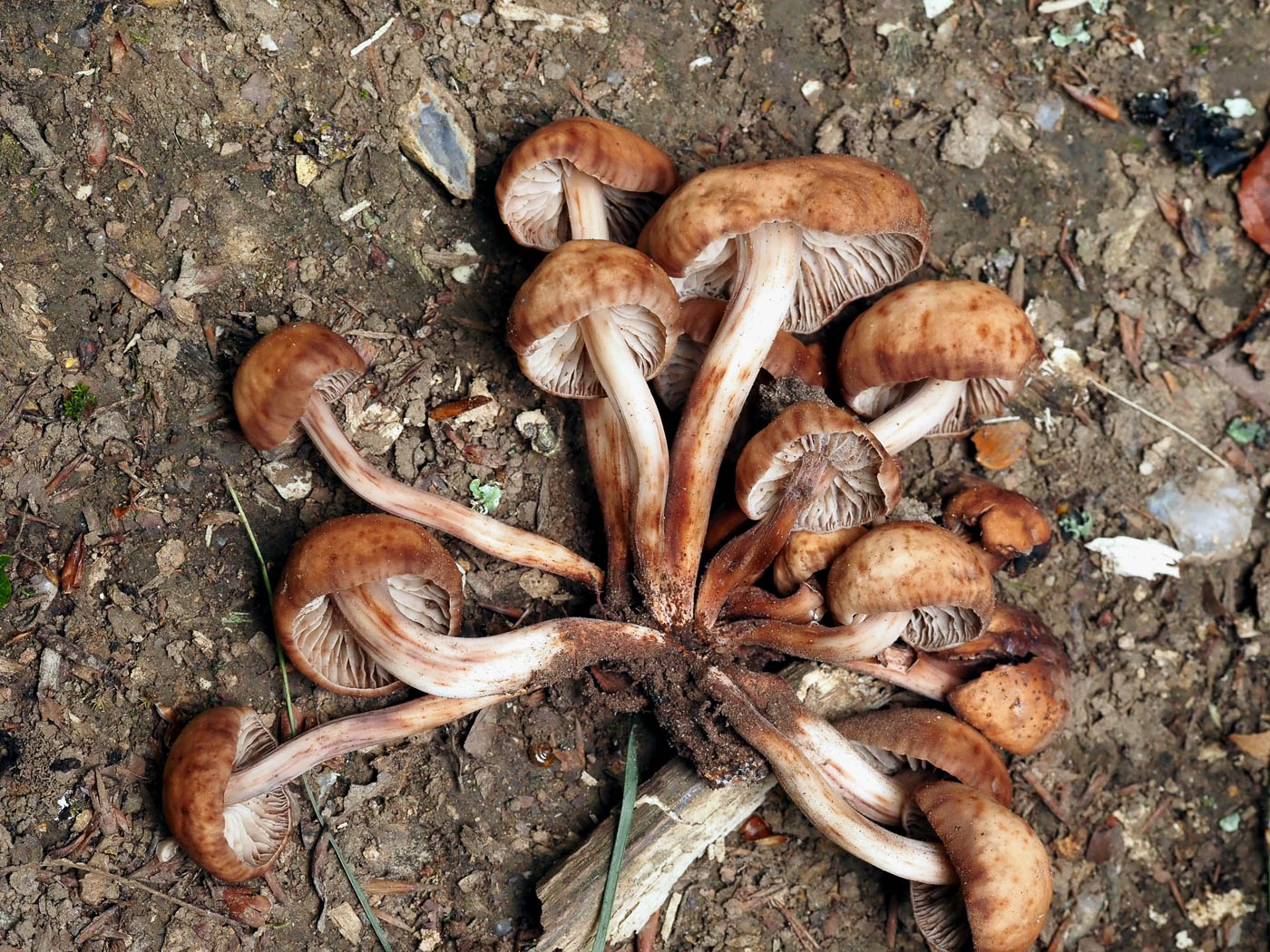 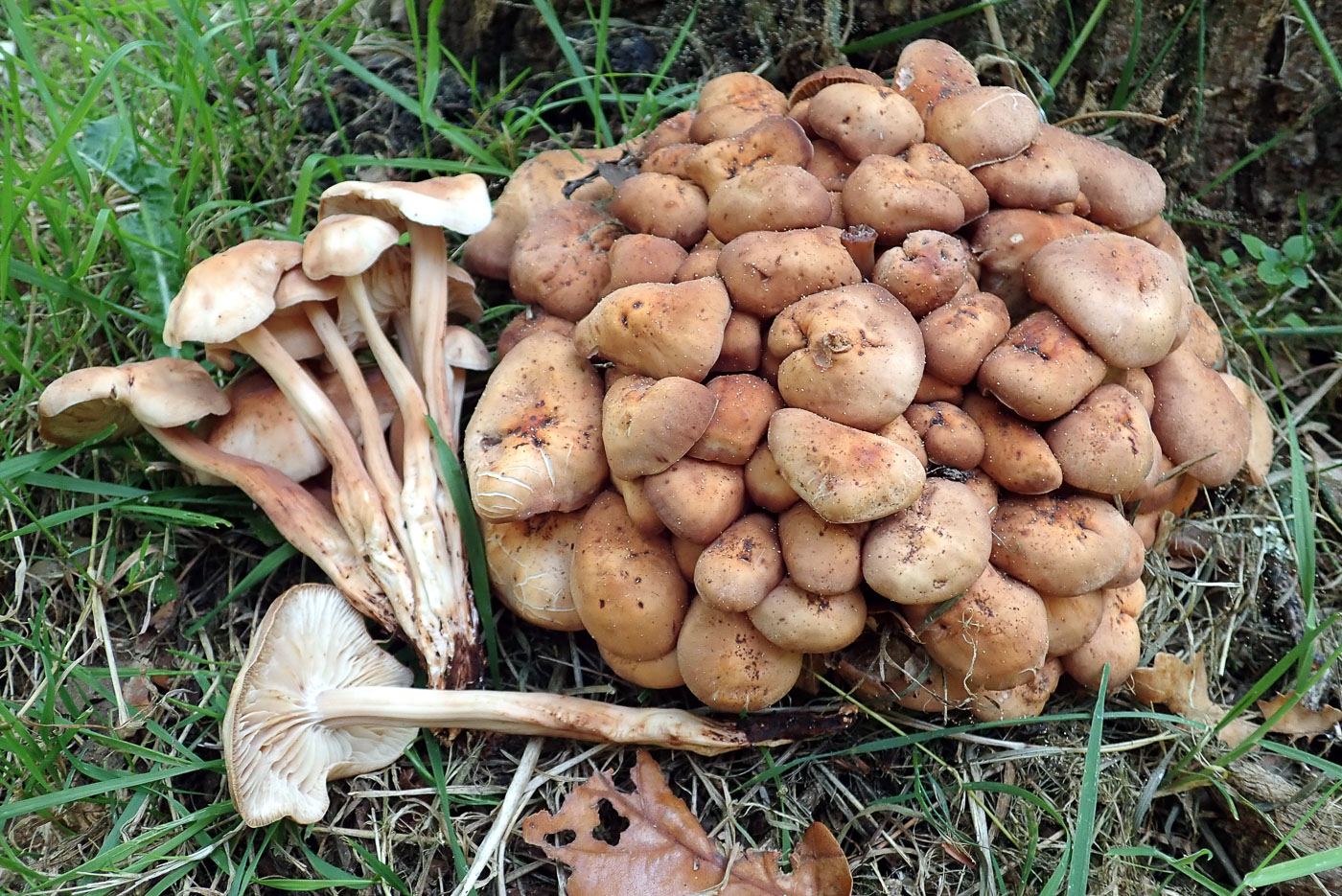
|
Gymnopus fusipes (Spindle Toughshank) Aug 14, 2024. In woodland near Chalfont St. Peter Jim Wills noticed this clustered species at the base of an Oak trunk. Though a common species and often an early fruiter, nothing has been very common so far this summer so finding anything worthy of a photo has been a challenge. Photo 2 shows its typical tapering stem base, often conjoined to its neighbour in this species and a useful clue, together with its flexible rubbery general texture, to its identity if in any doubt. Jul 7, 2023. At Burnham Beeches Penny spotted several tight clumps of this species at the base of mature Oaks. They were looking surprisingly fresh and had no doubt been triggered into action by the much needed significant rain in recent days. Note the rather fibrous ridged stems which typically fuse together at their base which tends to be darker with a reddish tinge as seen here. The species favours mature Oak but also occurs under Beech, always at or near the trunk base and often early in the season. Jul 11, 2022. At the base of a large Oak in Tinkers Wood John and Lesley Catterson noticed this typically tightly clustered clump. The species is not uncommon growing like this near to the base of mature Oak or Beech and often quite early in the season, and John has shown nicely here the white widely spaced gills and tapered rooting stem which fuses with its neighbours. Not so typical is the crazed cap surface caused no doubt by the recent warm dry conditions. Jul 9, 2021. At Stampwell Farm at the base of a mature Beech Jackie Ewan found this distinctive clustered species. Previously in the genus Collybia, the species occurs most frequently around the base of Oak in mature woodland but also with Beech and is typified by its tan coloured rounded cap, widely spaced pale gills and flexible stem which tapers strongly downwards, most frequently fusing into a tight clump. Photo 2 is of Claire Williams's collection from Downley Wood a couple of weeks later, showing the fusing stems well and also the typical rather blotchy brown caps. Sep 18, 2020. Better known as Collybia fusipes, this was fruiting in abundance at the base of Oaks in Hodgemoor Wood and found by Penny Cullington. It's not uncommon in mature woodlands and also occurs under Beech. The species name translated is a useful character, ie the stem bases tend to fuse together (as seen on the left here) and this character together with the fulvous brown caps and tightly clustered habit are the main clues to its identity. |
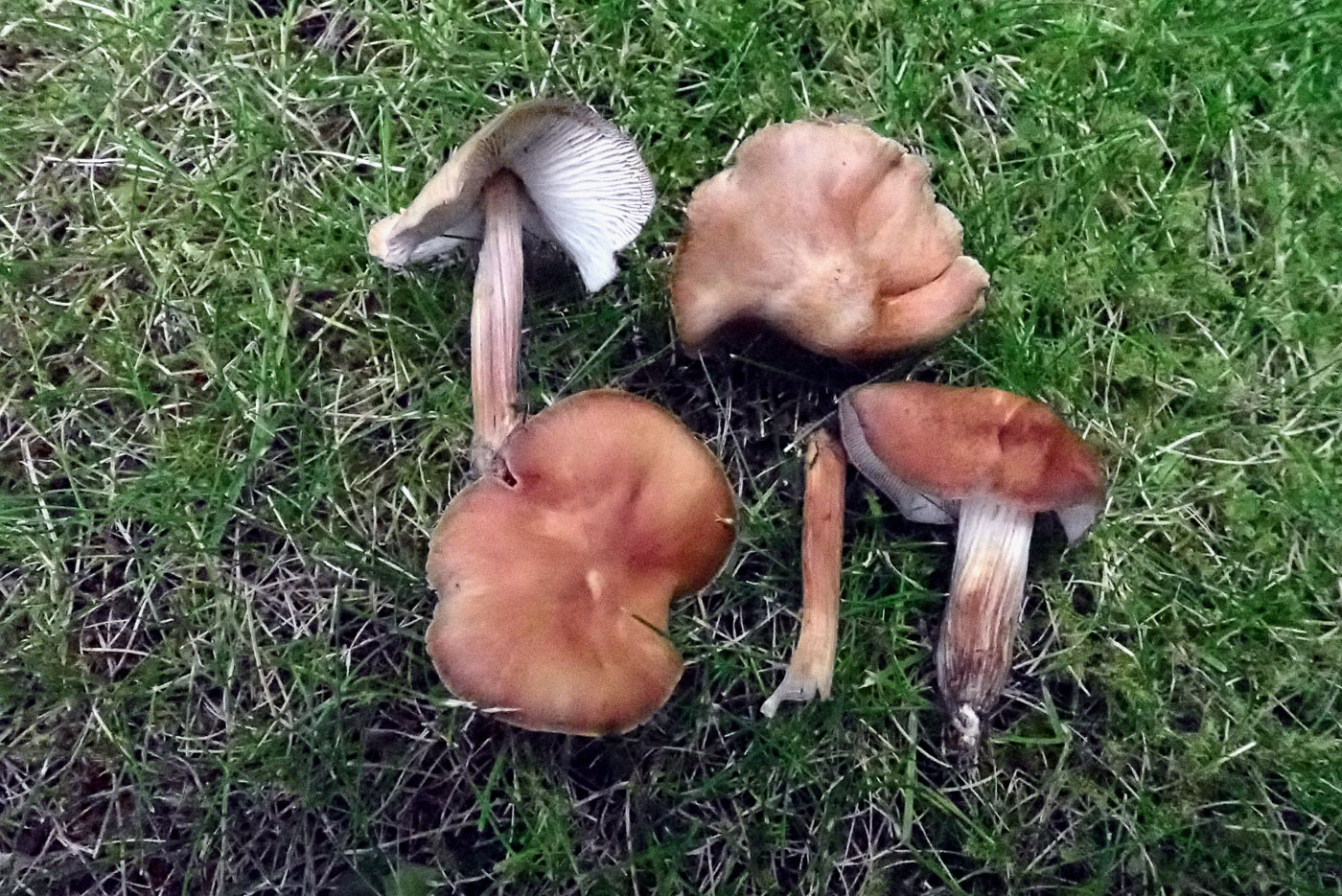
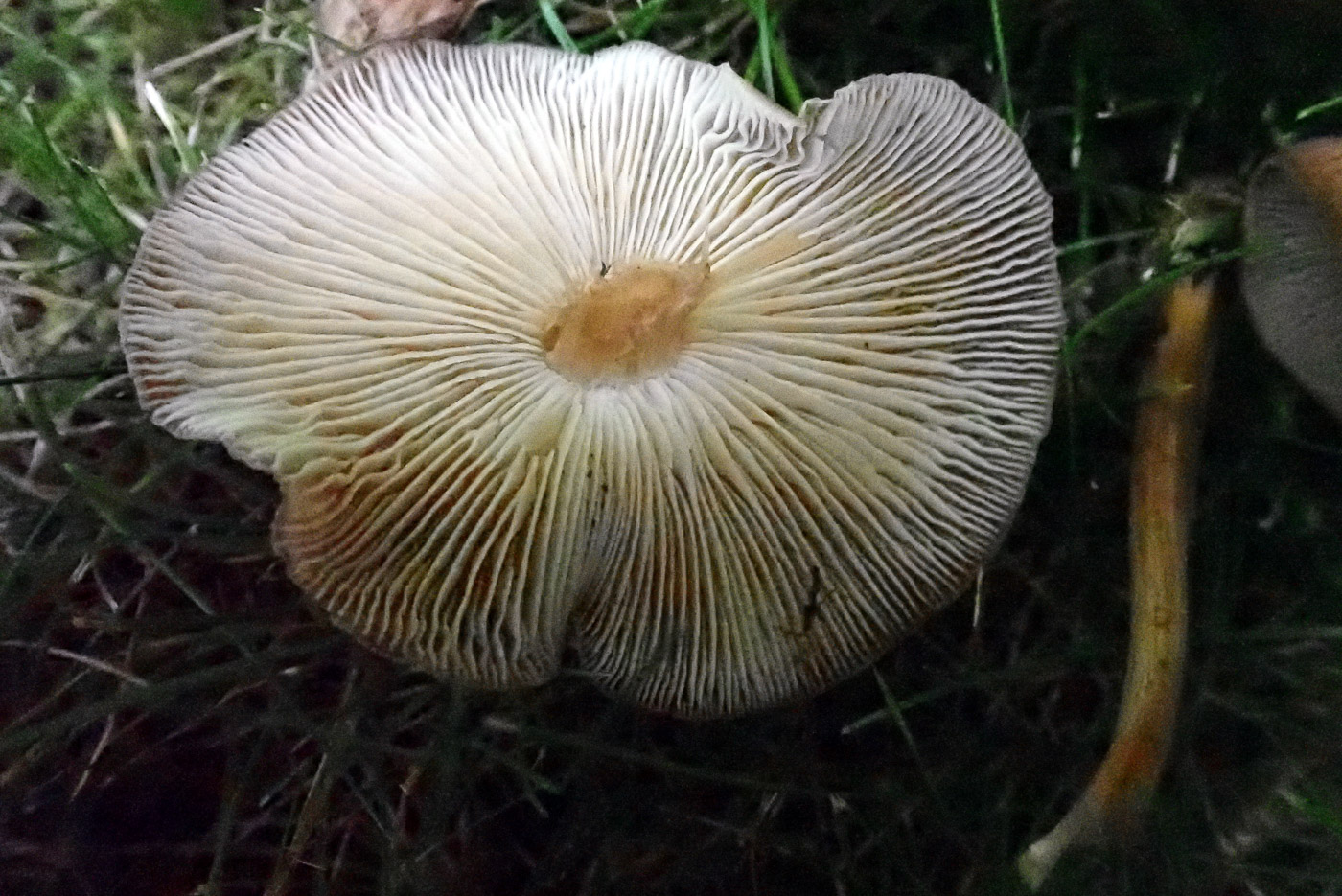 |
Gymnopus luxurians (a rare Toughshank with no common name) Jul 16, 2021. On a lawn in Stoke Poges Memorial Gardens when Penny was looking for early Waxcaps she came across a cluster of these brown capped mushrooms which rang no bell but which reminded her of the genus Gymnopus being somewhat flexible with crowded pale gills. At home she discovered this species which seemed to fit well including the microscopic characters but was not a name she knew, and on further investigation discovered it is an American species, possibly introduced here with only a handful of UK records, mostly from Kew Gardens in hothouses, also very rare in Europe. So this is new to the county and as the few British collections may not yet have been sequenced it may possibly prove to be different from the American species. It is now dropping a sporeprint and being dried with a view to getting it sequenced. |
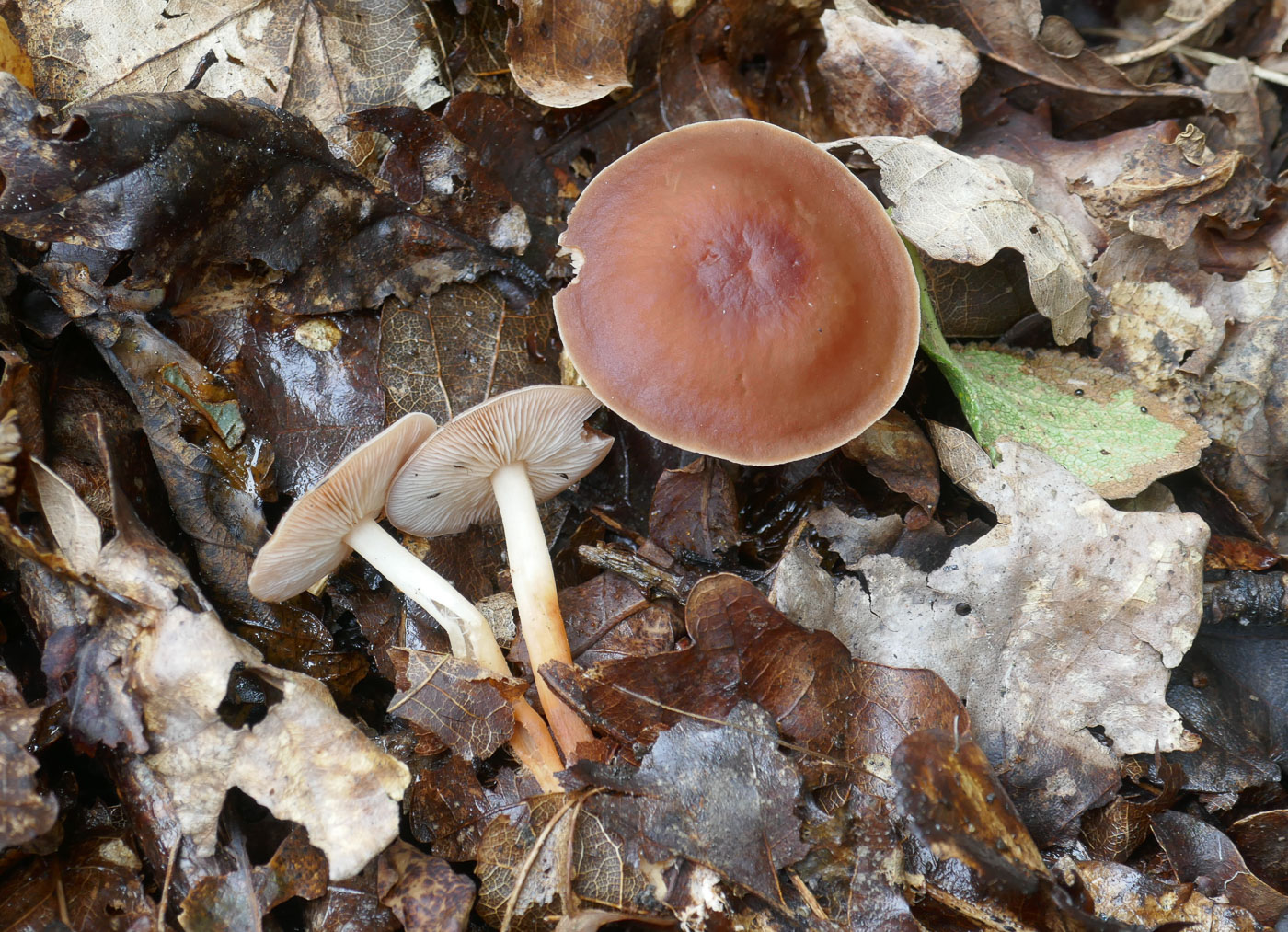 
 






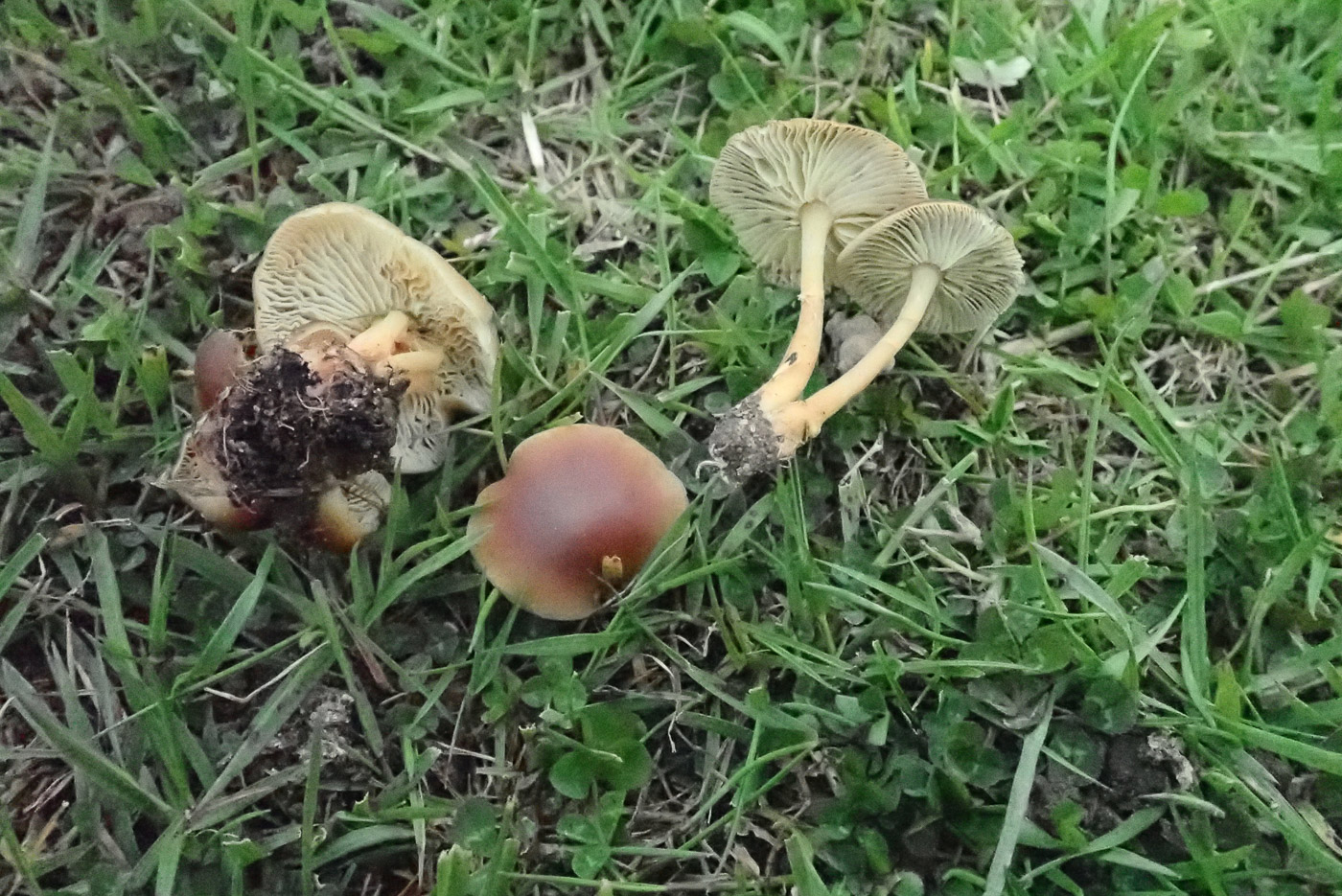
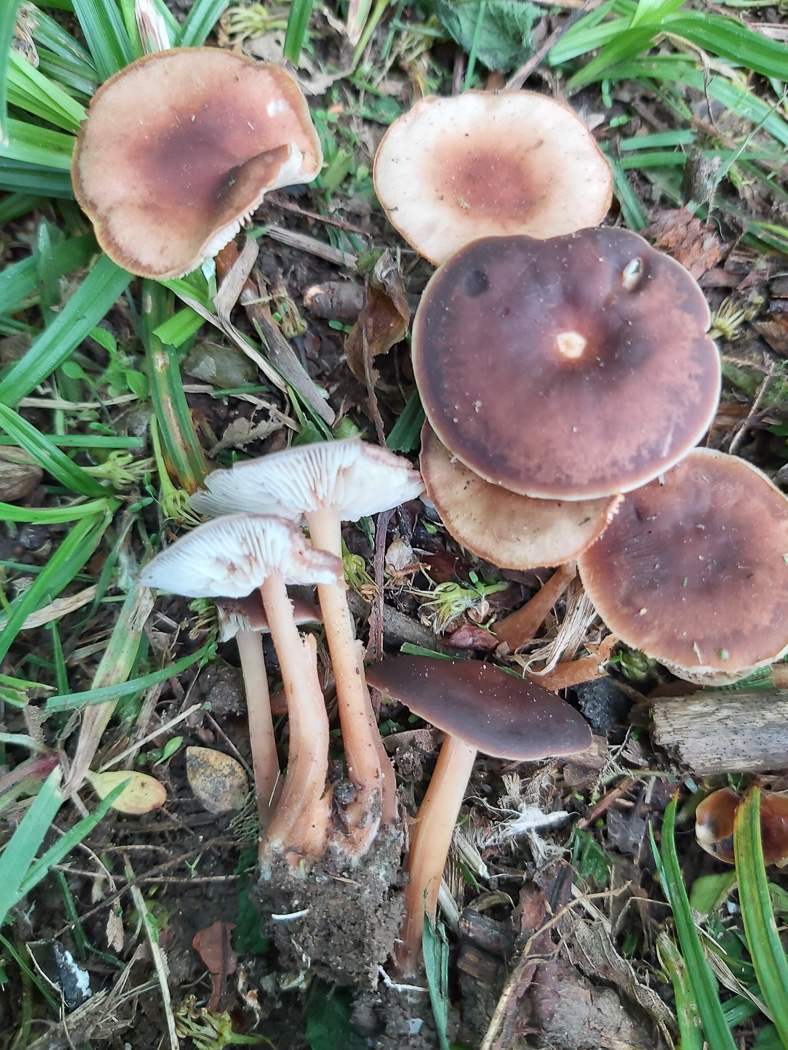 |
Gymnopus ocior (Spring Toughshank) Sep 9, 2024. This is another early season regular fruiter at Stampwell Farm, found by Jackie. We've had a couple of collections confirmed with sequencing because it is easy to confuse with the much more common G. dryophilus (Russet Toughshank) which despite its English name is usually less conspicuously russet than G. ocior! Apr 20, 2024. At Stampwell Farm this unusual Toughshank has appeared several times in the last few years and is often an early fruiter. Similar to the much more common G. dryophilus (Russet Toughshank) it has a more intensely coloured cap as can be seen here, also the gills tend to be yellow though this colour always seems reluctant to show well in photos! Jackie assures me the gills looked decidedly yellow here. We found a possible third lookalike species in the Burnham Beeches Mire on our midweek walk there a few days ago. See my report for a photo and further comment on the issues involved here. Aug 27, 2023. In Beech litter at Park Wood Ibstone Penny spotted just this one cluster and thought it looked different from the much more common though similar G. dryophilus (Russet Toughshank). The colour was darker and more intense with a pale rim around the edge and a sunken centre - all pointers to this species rather than G. dryophilus though microscopic features are extremely similar so did not help a great deal. When the gills are distinctly yellow as can happen in this species one can be sure, but this is not a constant feature. See the Masterlist for further collections. May 3, 2023. At Stampwell Farm Jackie Ewan found this rather unusual Toughshank growing amongst Bracken litter. Somewhat similar to G. dryophilus (Russet Toughshank) which is much more common but also tends to fruit early in the season, today's species had a much darker richer russet cap and the gills tend to have a yellow tint - sometimes markedly so but sometimes missing also as here. The two species are easily confused and unfortunately microscopic details are very similar and therefore not much help! Sep 5, 2022. At Stampwell Farm Jackie Ewan found a patch under oak with several fruitbodies dotted about - all clearly similar but some much paler, some with distinctly darker tones. Having found G. ocior at this site previously Penny feels fairly confident (but is not positive!) that these darker specimens are they, it also being a species we found the day before at King's Wood Tyler's Green when one example clearly had the give-away yellow gills (though this is not a constant feature). This is one for sequencing and these notes will be updated once confirmed (or otherwise!). May 25, 2021. On a visit to Stampwell Farm near Seer Green Penny was pleased to find this quite unusual Toughshank in soil in a grassy area. Very similar to the common G. dryophilus - one which fruits early in the main fruiting season - the species is distinguished in the field by the darker red-brown cap colour and the gill colour which has a marked yellow tinge, a feature which seems to develop a few hours after collection. We have about 10 previous records, made mostly between May and September, whereas the earliest months for our 250 or so records of G. dryophilus are from July / August. This fits with general descriptions which state that it tends to fruit earlier than G. dryophilus. Photo 2 from a grassy patch in Jordans Village was sent in two days later by Jesper Launder. |
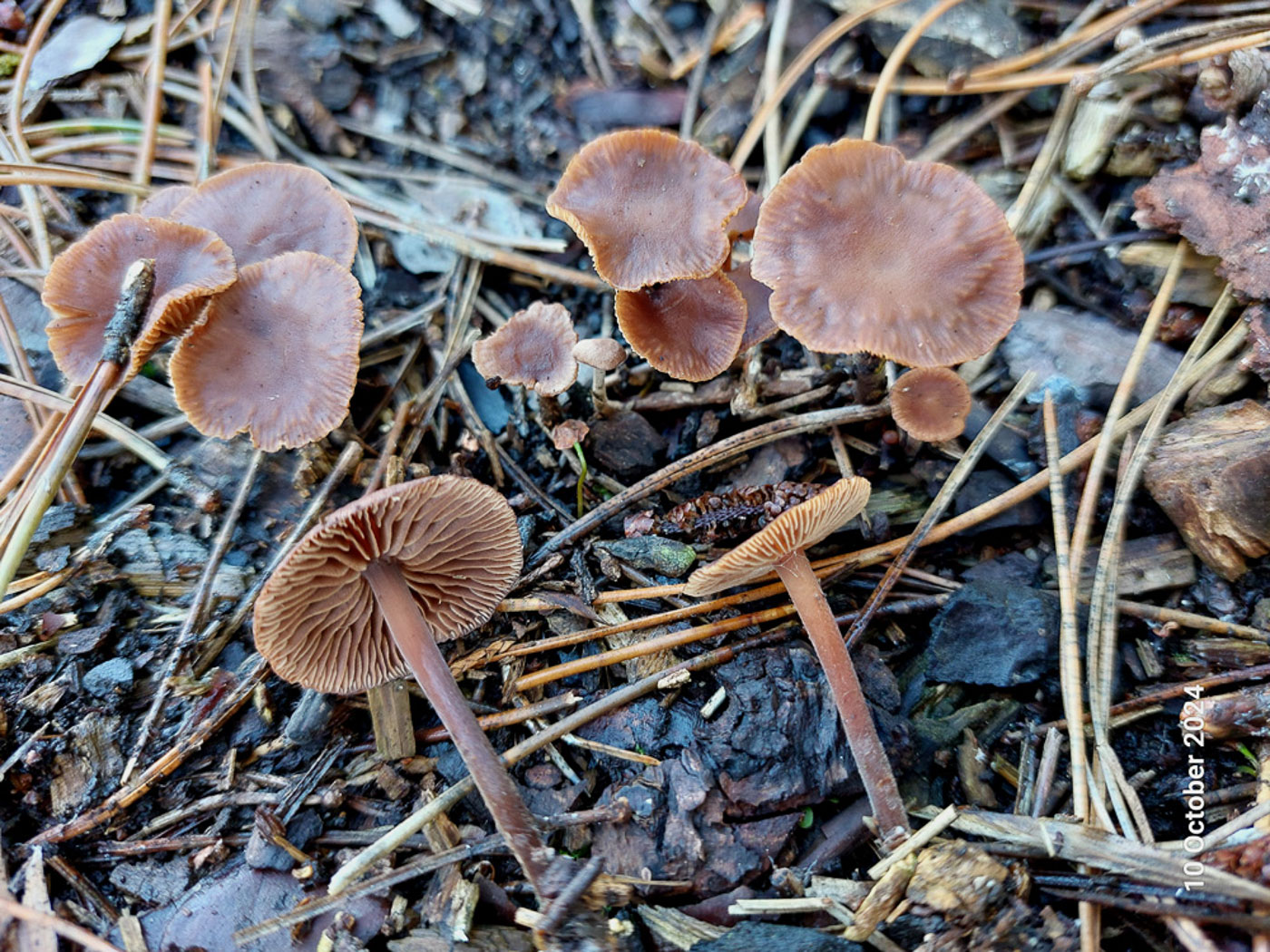 |
Gymnopus obscuroides (a Toughshank with no English name) Oct 10, 2024. In Beaconsfield Jesper Launder noticed this rather small and dark LBJ - a species of Gymnopus, and wondered if it might be G. fuscopurpureus which turns green where treated with KOH but is otherwise very similar to G. obscuroides. At home KOH proved negative, though there is a further very similar species which we find at Stoke Poges Memorial Gardens and now has been sequenced as Collybiopsis villosipes with very few UK records as yet. It would therefore be good to get a sample of this Toughshank sequenced, especially as the Collybiopsis is not included in available books such as the 4 Kibby volumes. See the Finds entry under that name for comparison. Previous finds |



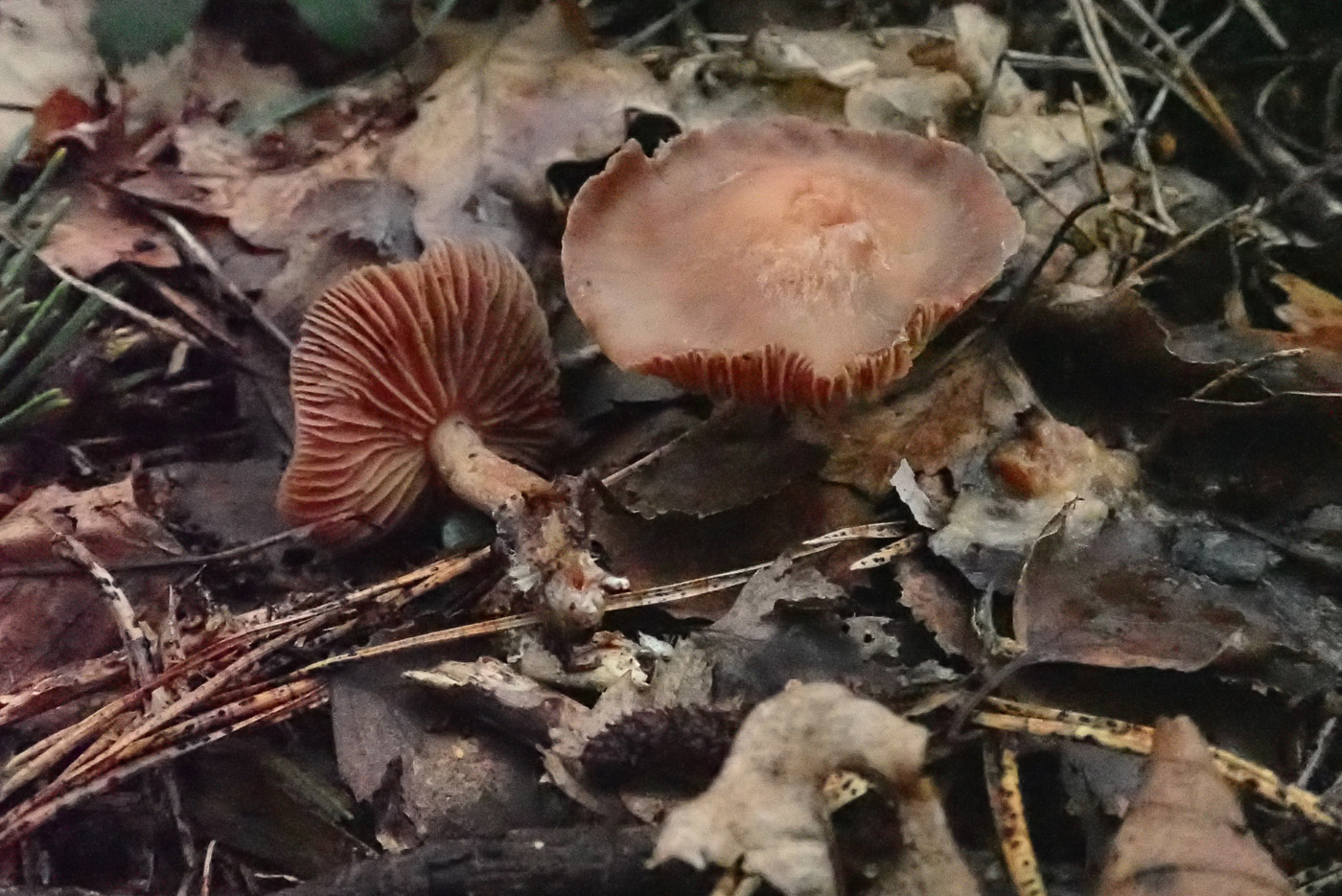
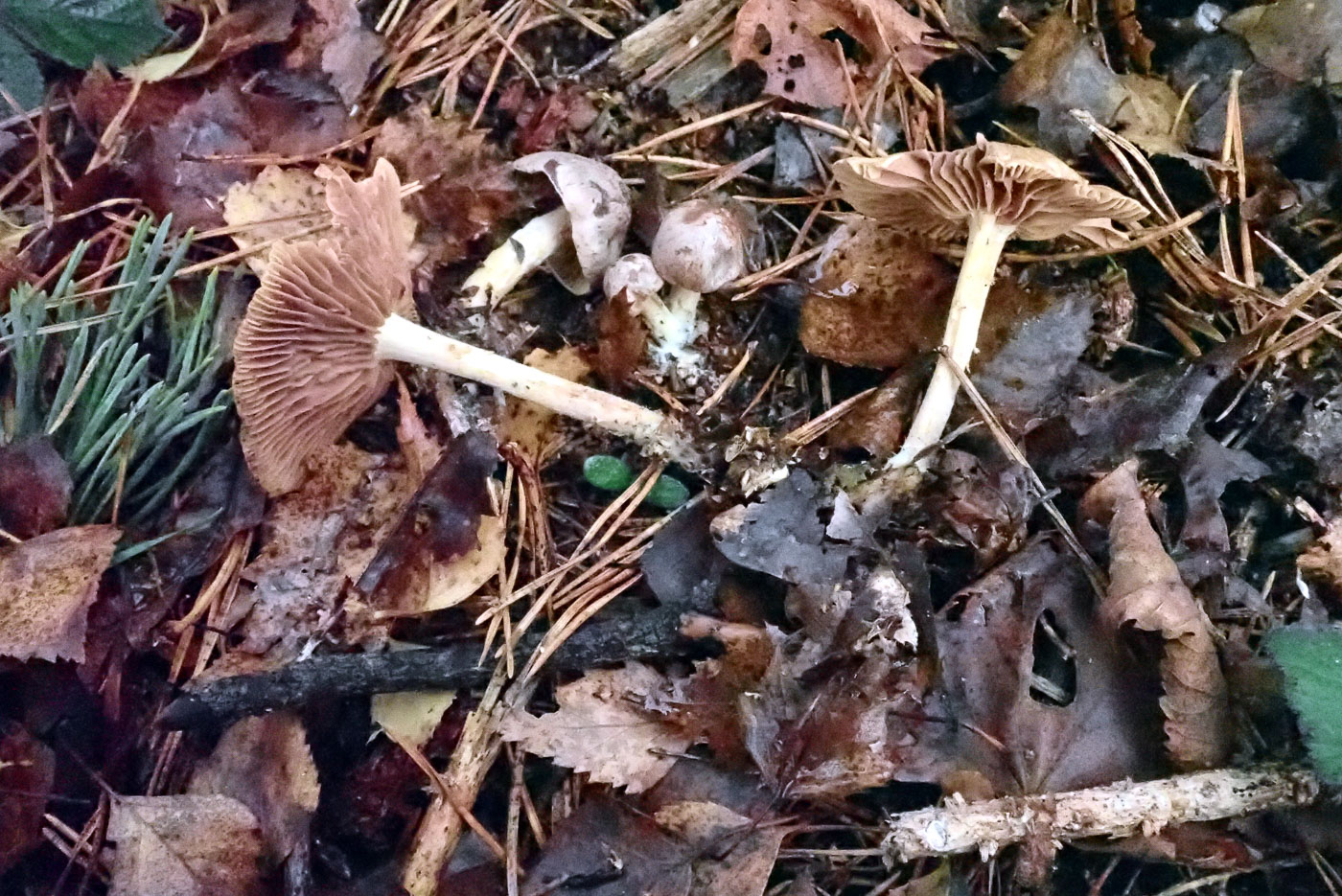
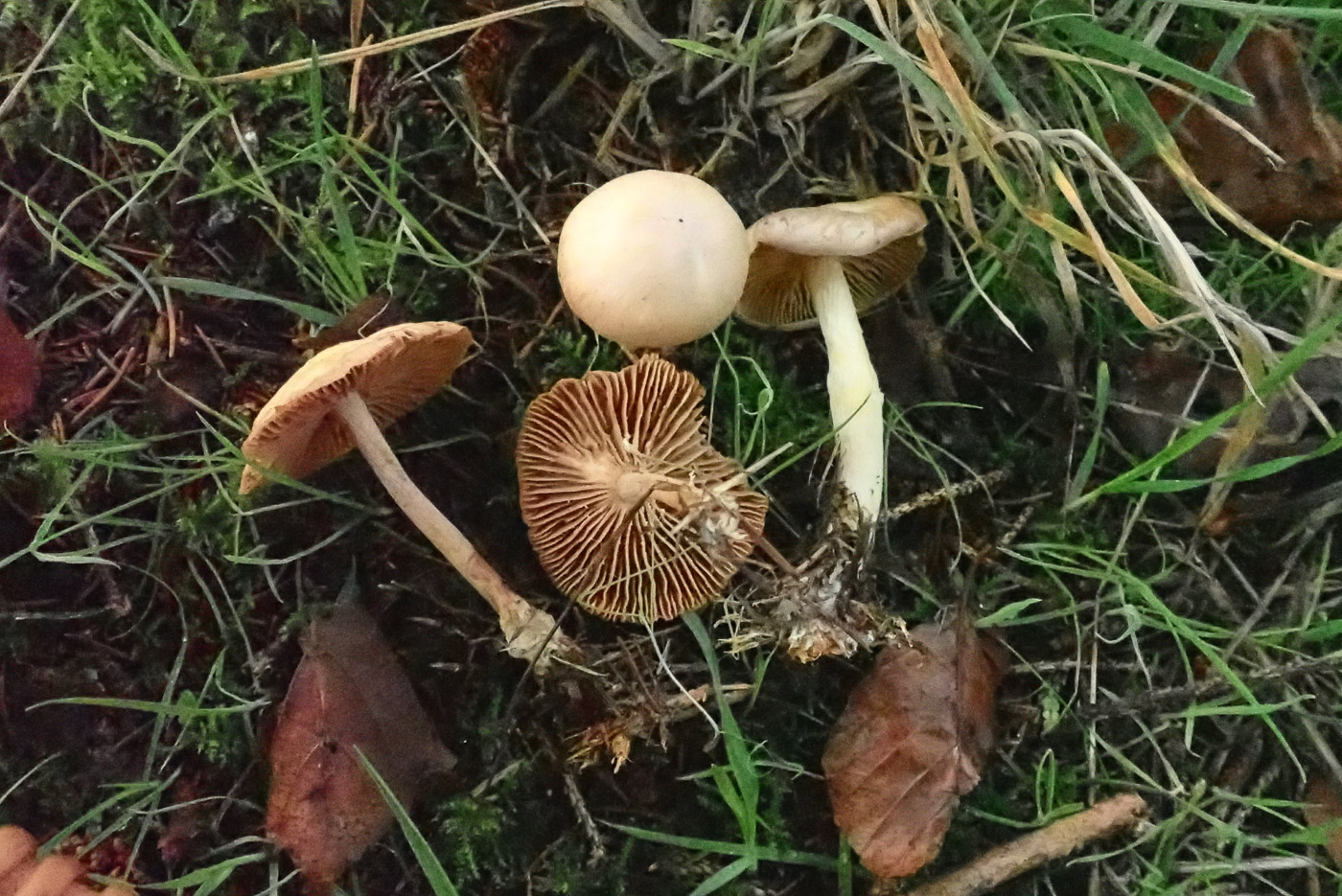
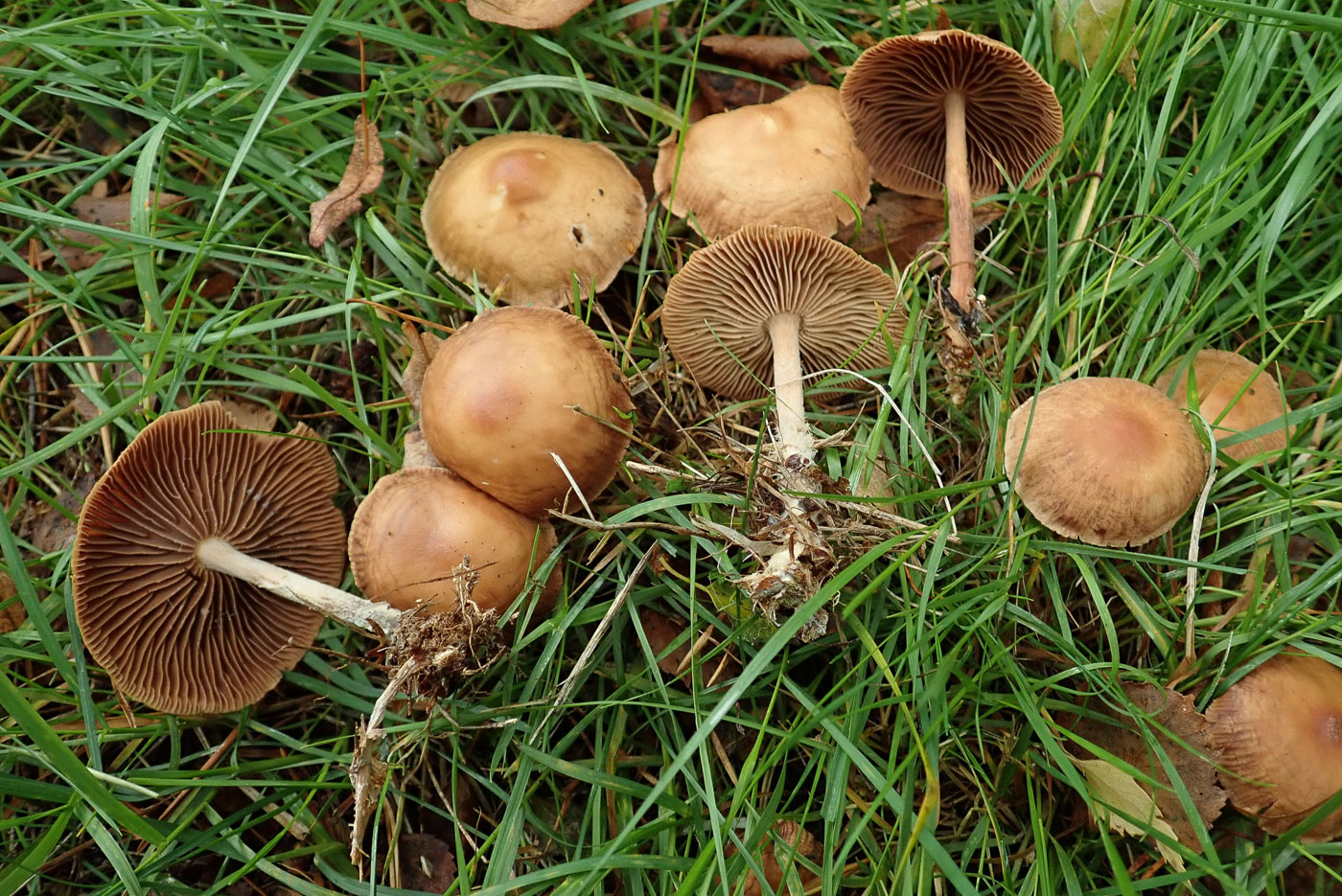
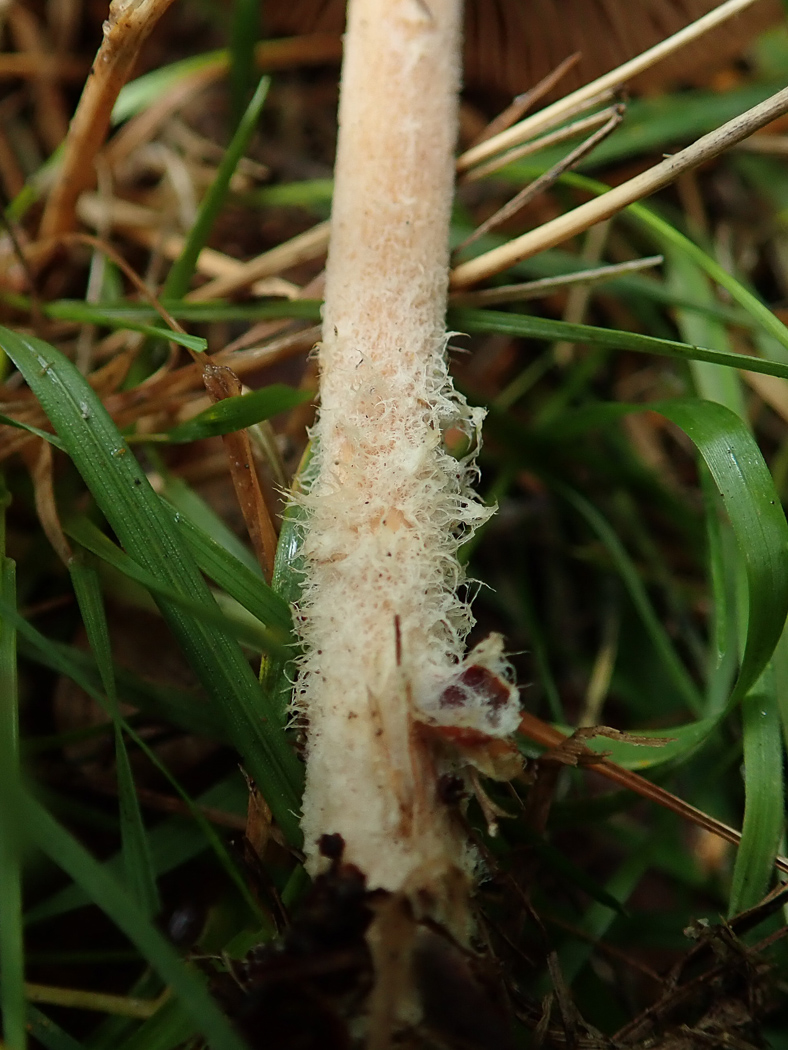
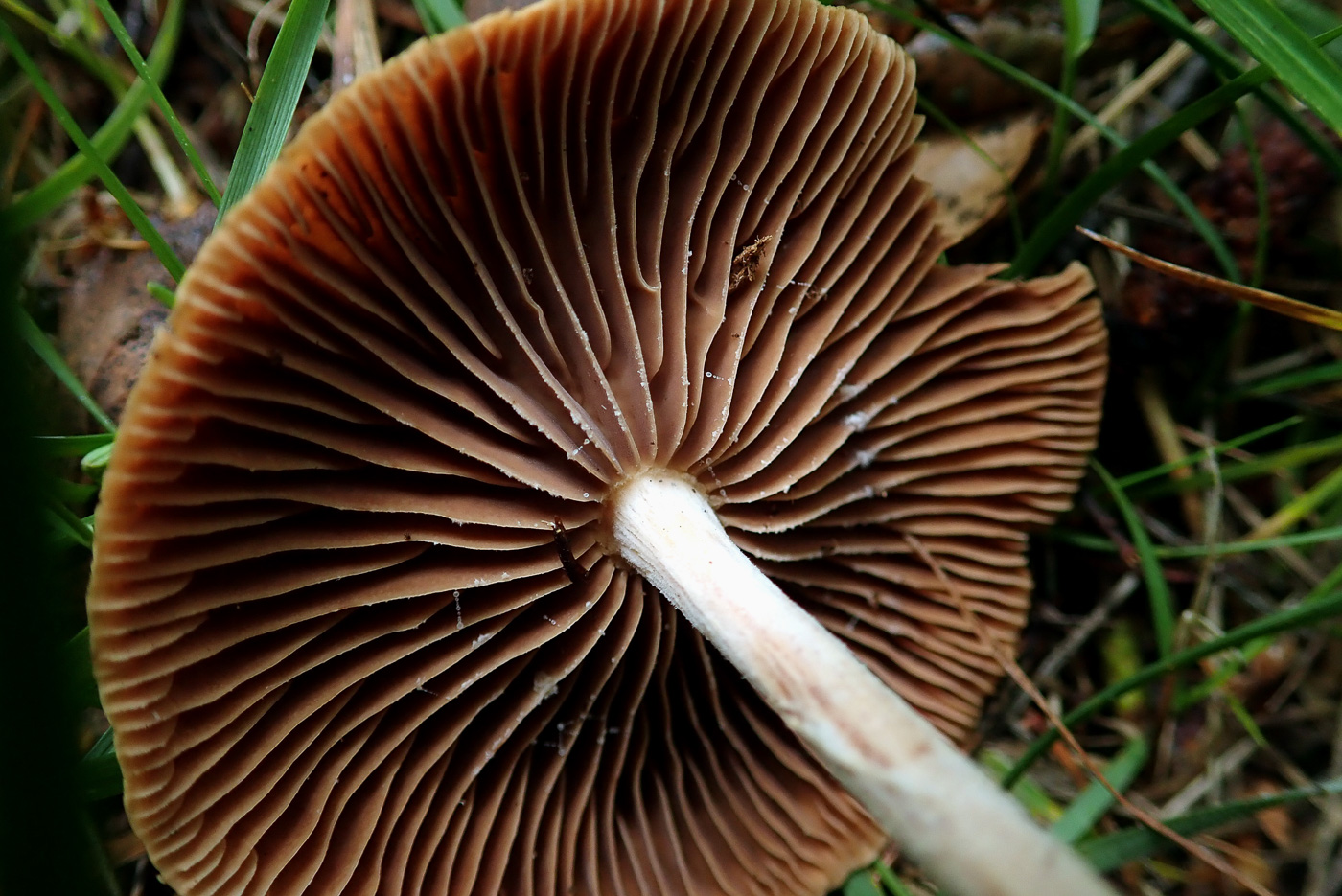
|
Gymnopus peronatus (Wood Woollyfoot) Jul 25, 2023. Under Oak and Spruce in Bernwood Forest Penny found this good sized cluster though they'd clearly been well nibbled by forest rodents. Common under both broadleaf and coniferous trees, this LBJ species often seems to cause confusion though the gills and stem are quite distinctive (photos 2 and 3). A useful clue is the 'woolly' stem base with litter debris often attached as here (peronate: with a woolly furry covering). Jan 1, 2022. At Turville Heath Penny found these two rather past-their-best specimens still fruiting under the same Pine where she took a previous photo. Nov 13, 2021. At Turville Heath Penny found two collections of this species, the first under Pine and the second under Spruce, though it can often be found fruiting in deciduous litter. This is another LBJ which can cause confusion in the field but is larger than other Gymnopus species with caps up to 6 cm across and widely spaced gills which can have a pinkish or yellowish tinge. The stem also tends to be yellow lower down where it develops pale hairs often with litter intertwined - hence its common name. Sep 30, 2020. Penny Cullington found this common species (previously in the genus Collybia) in grassy litter under mixed trees at Turville Heath. The brown caps up to about 4 cm across look like those of many other woodland mushrooms and it's not until the underside is revealed that one can recognise it. The first feature to note is the lower stem which is finely hairy and usually has debris adhering to the base, hence its common name. Note also the characteristic shape and colour of the gills. |

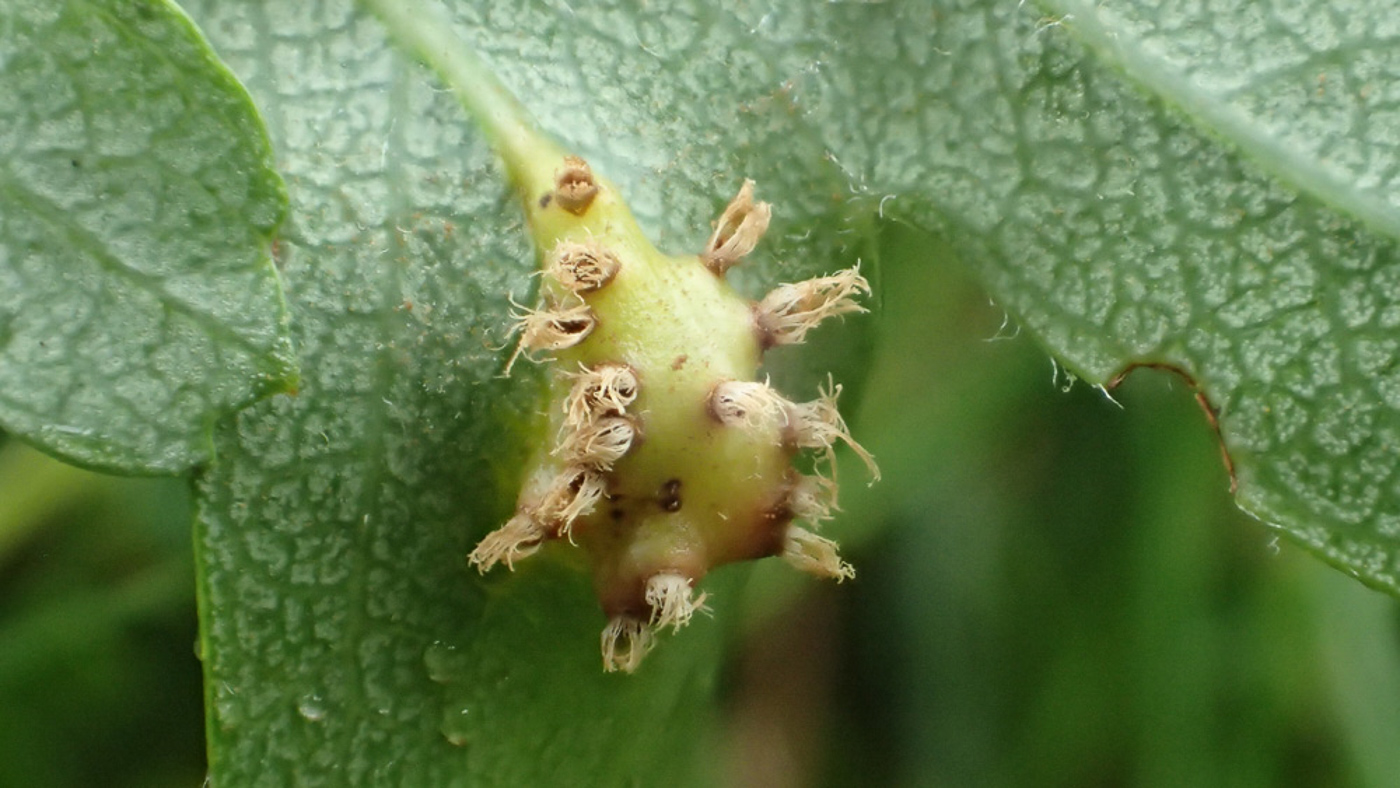 
 |
Gymnosporangium clavariiforme (Tongues of Fire) Jun 4, 2024. Having found examples of this unusual genus of rust the previous week (see the May 29th entry), Sarah Ebdon went searching at Grangelands, Pulpit Hill, to clarify her discoveries knowing that G. clavariiforme had been recorded here before. This site has both Juniper and Hawthorn - the two host trees needed for the species to thrive - in close proximity, and she was quickly rewarded with good examples on the Hawthorn leaves. We have just 4 previous county sites where it's been found previously, the majority from Grangelands as here. Jun 18, 2023. In Seer Green Jesper Launder noticed a Hawthorn bush with a few leaves showing these rusty marks and recognised these as the second stage of this particular rust species which needs two different host trees in fairly close proximity to form its life cycle. In Spring the 'telia' stage is found on Juniper and forms orange to yellow jellylike spikes (from which comes its common name). Later it forms these rusty patches on leaves of nearby Hawthorn, the underside of which (photo 2) develops the horn-shaped spikes seen here and which later become finely hairy and brown. We have very few sites where either stage of this Rust has been recorded (one being Pulpit Hill, another Bradenham Estate) and despite searching the prolific Juniper at Burnham Beeches this April we failed to find it there. Any sites where both Juniper and Hawthorn grow together are likely spots, however. This is a new entry for Finds. |

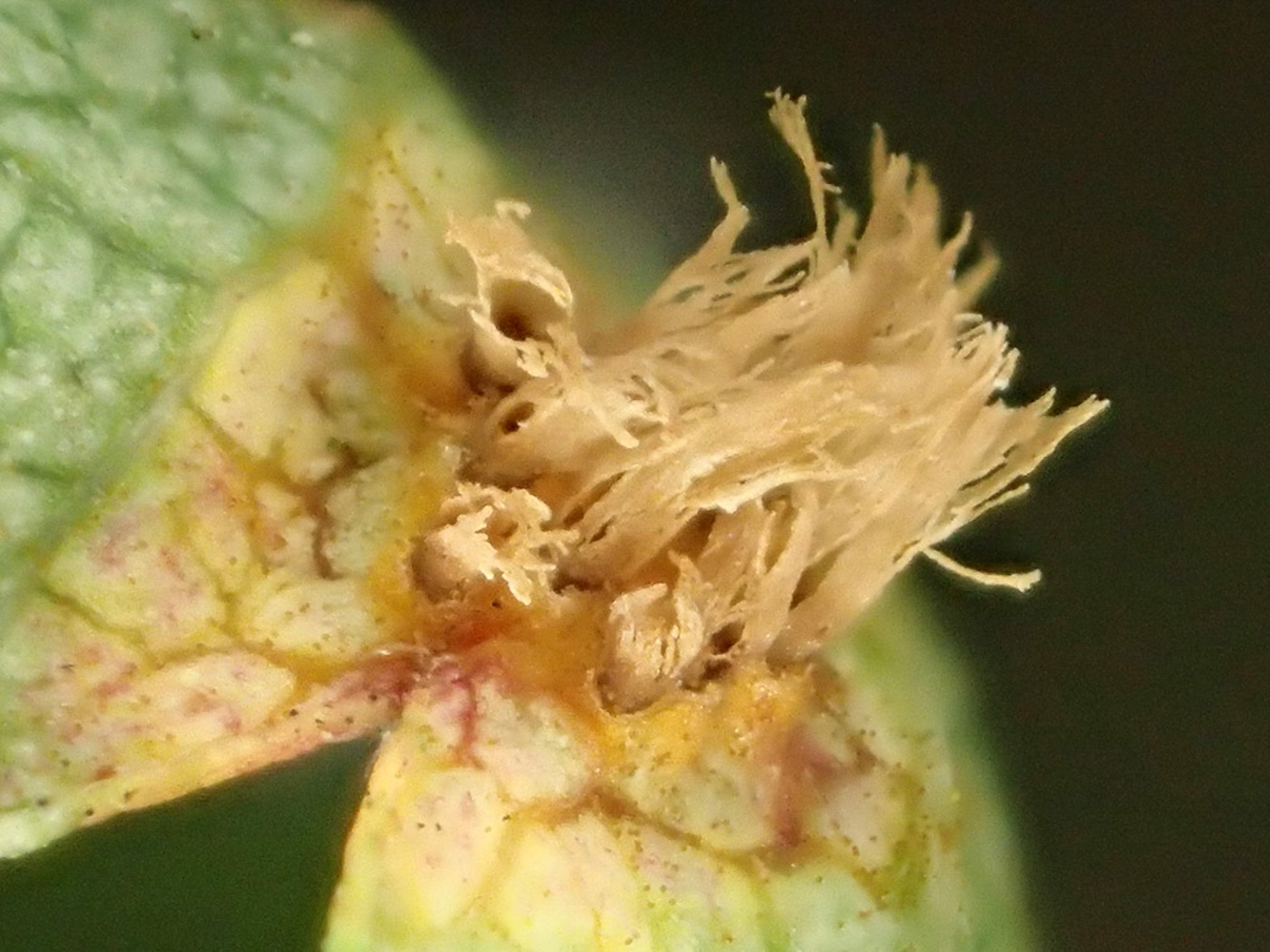 |
Gymnosporangium confusum (a rust with no common name) A few weeks earlier Sarah Ebdon noticed an early stage of this unusual species of rust on Hawthorn leaves in Hazlemere but was uncertain of a species ID - it being too immature. Returning today she found it at the aecial stage and the microscopy then pointed to G. confusum though she was not entirely convinced until finding yet another very similar species of Gymnosporangium at Pulpit Hill (see the G. clavariiforme entry on June 6th). Now able to compare the microscopy of these two, she can confirm this as G. confusum (its species name possibly reflecting its easy confusion with the commoner G. clavariforme). Both species need the same two host trees to complete their annual life cycle: first Juniper followed by Hawthorn. As she was unaware of any Juniper nearby today, Sarah then discovered that the hosts do not necessarily need to be close together though it no doubt helps if they are. This is a new record for the county. |
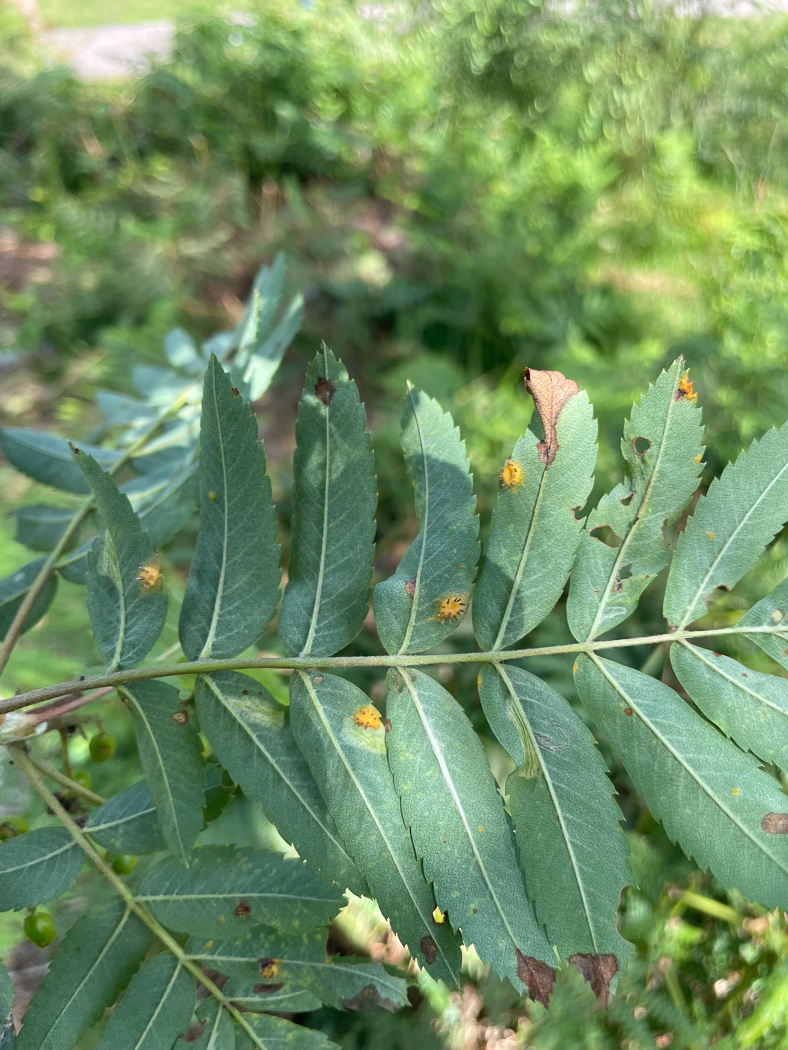
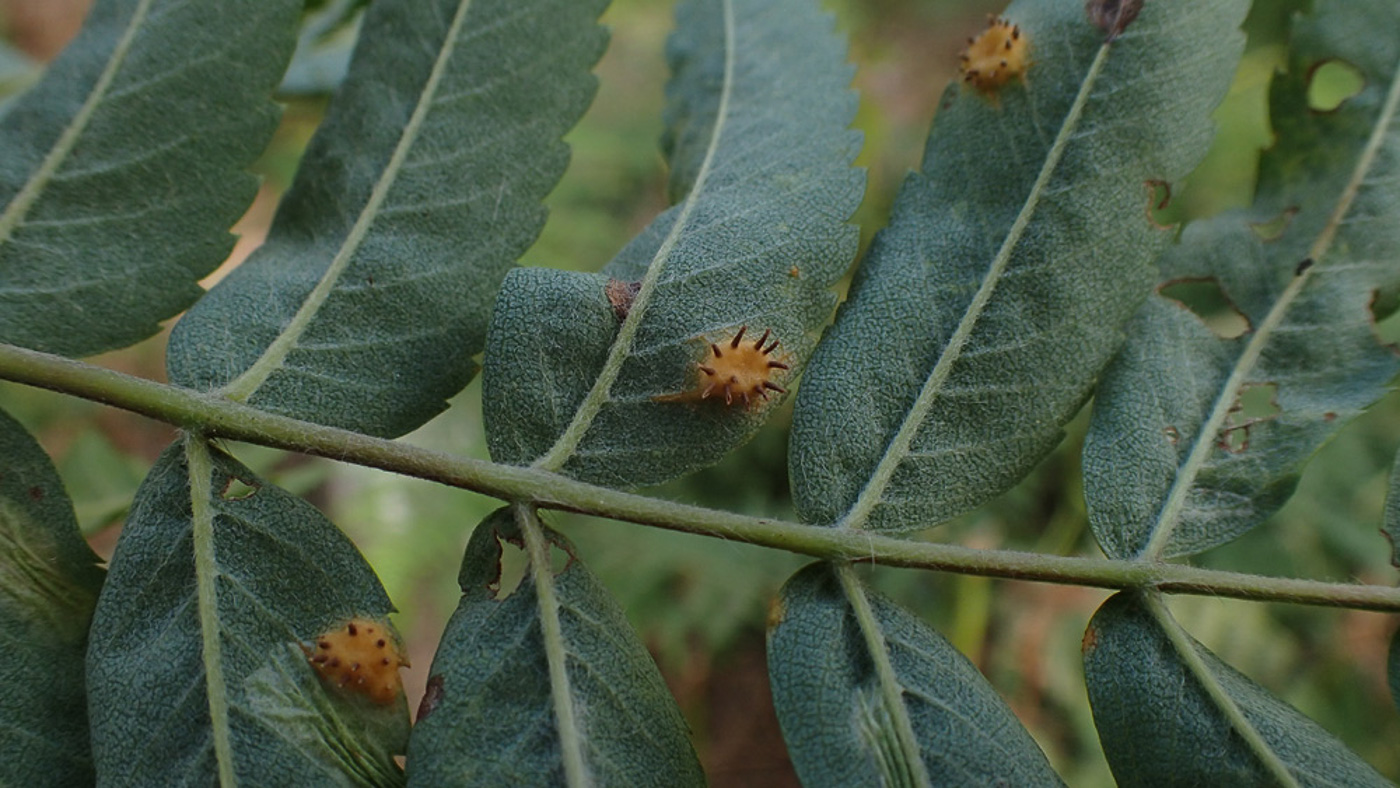
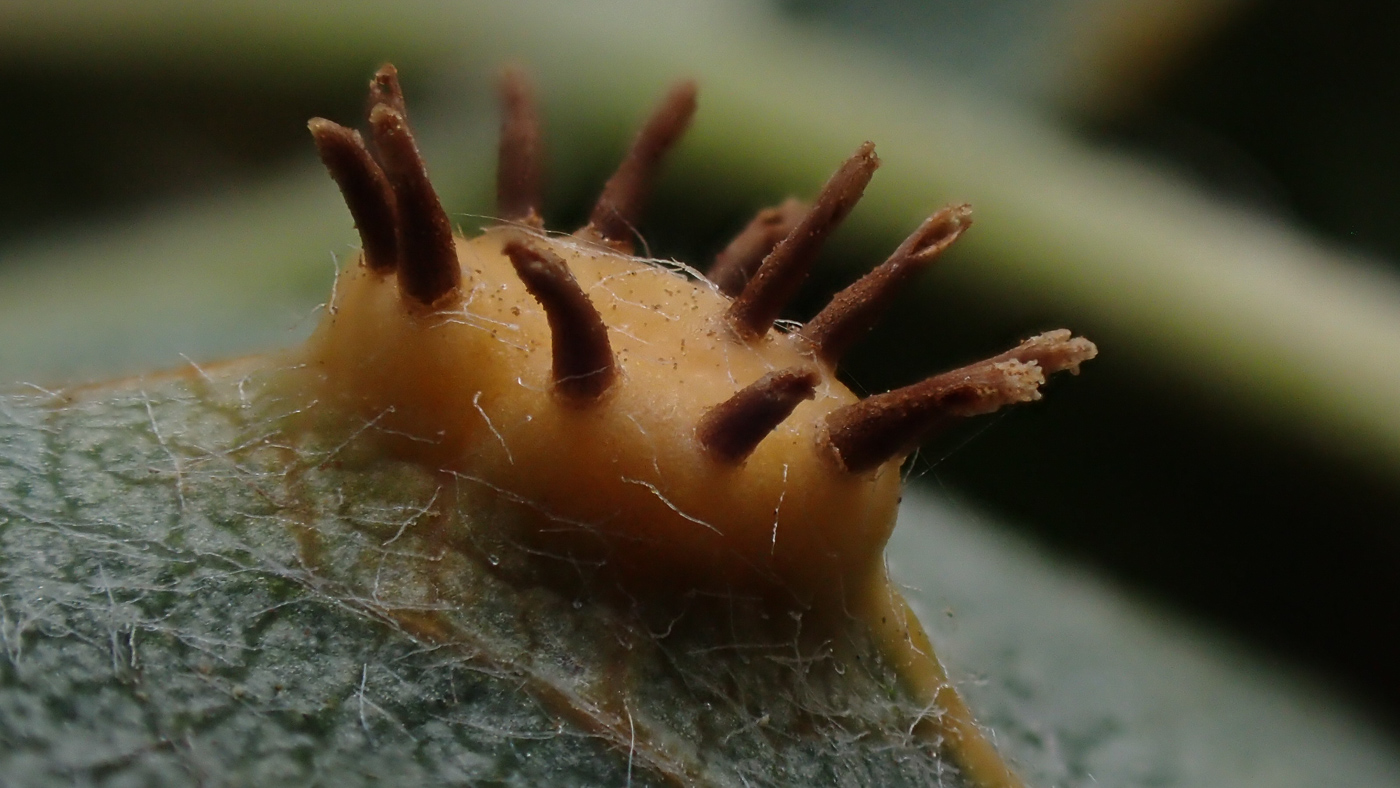 |
Gymnosporangium cornutum (Rowan Crown) Jun 18, 2024. Sarah Ebdon has been making something of a study of this genus recently, identifying various different species, though this one had been eluding her. She suspected she'd found it at Burnham Beeches on Juniper at the earlier 'telial' stage though it was dried up and shrivelled to nothing! So today she returned to look for the next 'aecial' stage which occurs (only) on Rowan. She was rewarded, finding plenty of examples displaying the typical curved 'horns' which give rise to its English name. The species is common in Scotland but much less so in England, in fact this is our first BFG database record though it has apparently been recorded at Burnham Beeches before. This find was a case of perseverance rewarded and is a new entry for Finds. |
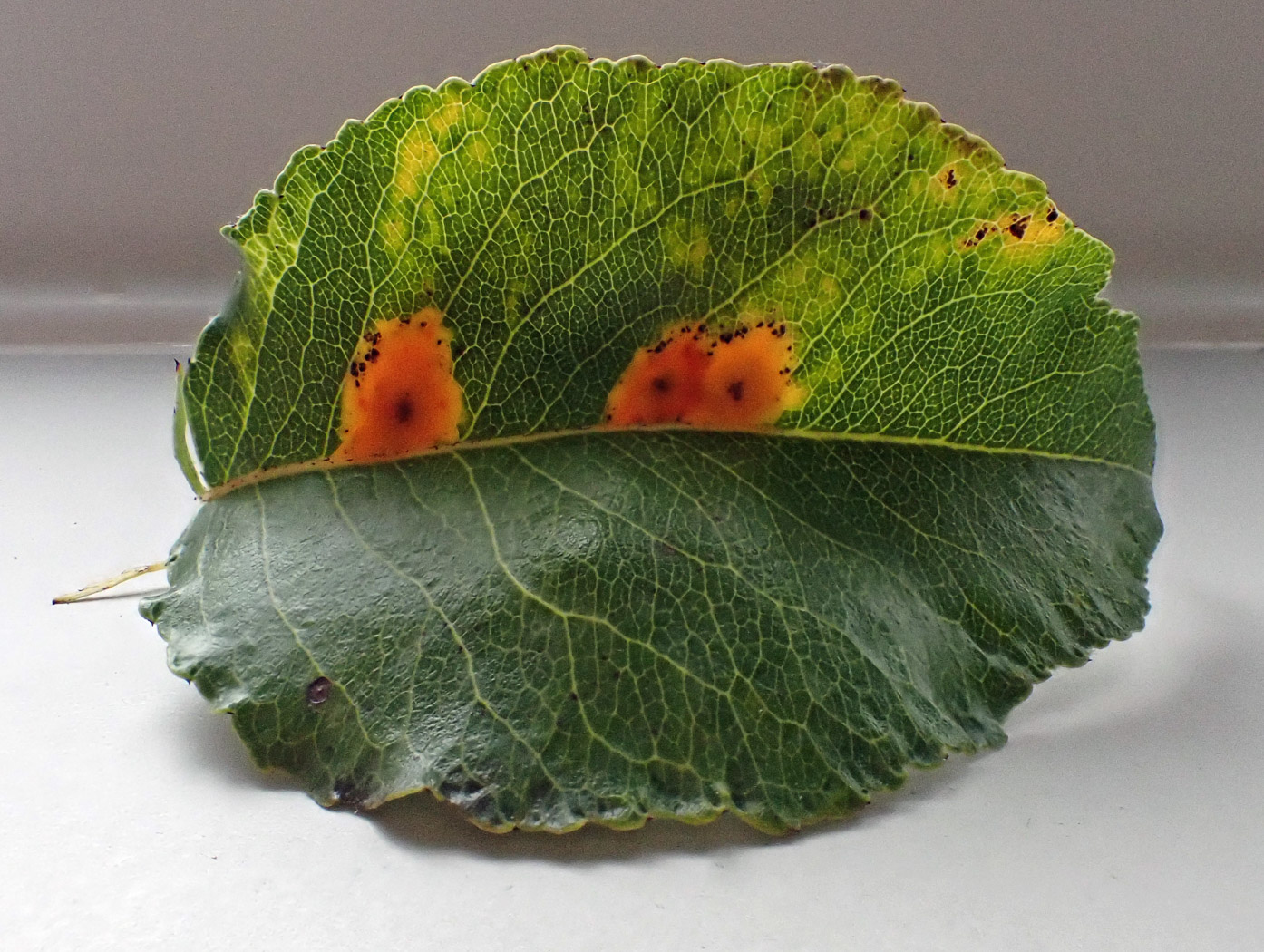
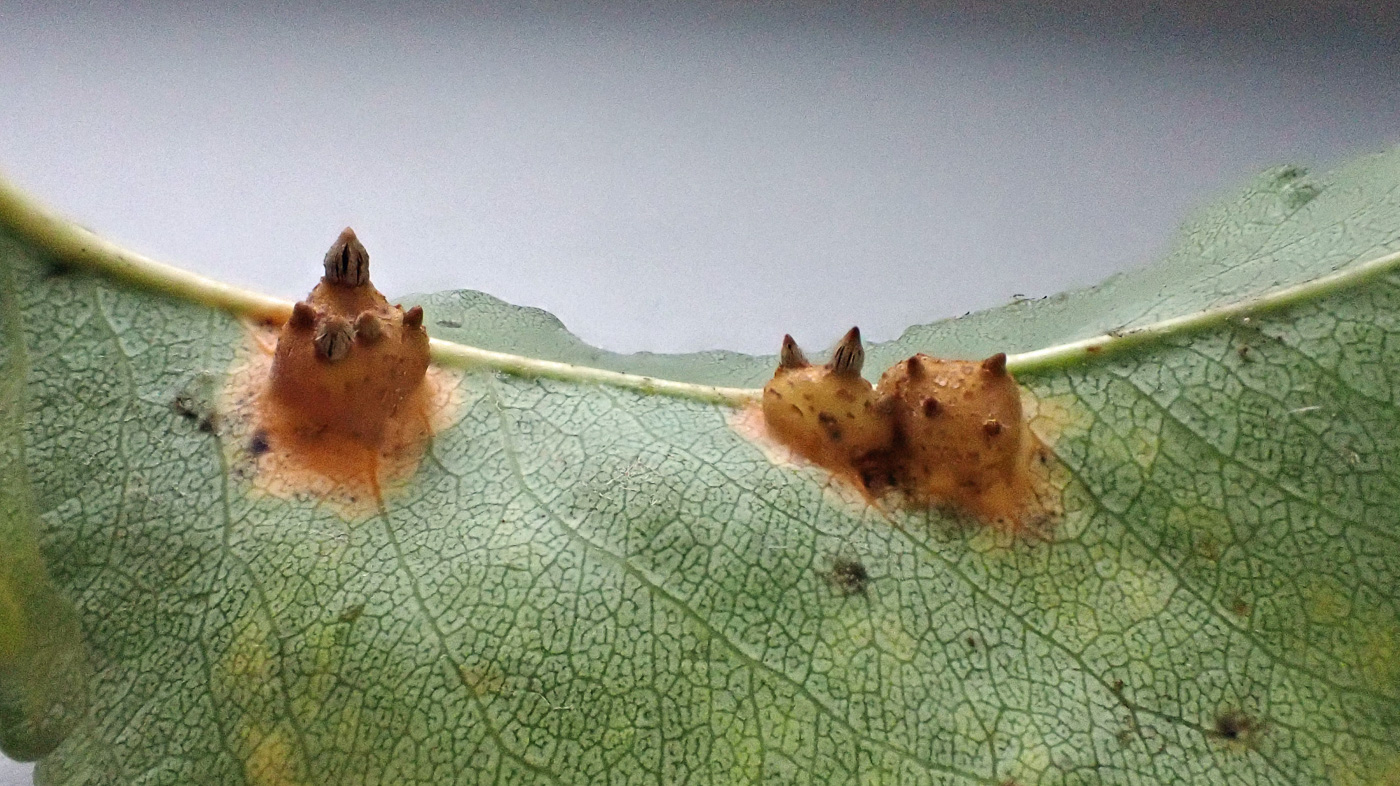 |
Gymnosporangium sabinae (Pear Rust) Sep 30, 2022. On the Pear tree in his garden in Walters Ash Neil Fletcher identified this rust - not rare but with only one previous county record, hence the green box here. Neil tells me that this rust fungus - in common with many others - has two hosts, the primary (telial) host is Juniperus (wild and cultivated junipers) and the secondary (aecial) host is Pyrus (wild and cultivated pears). So if you know of a local Pear tree now is the time to check the leaves before they fall and you may also find this interesting rust. |

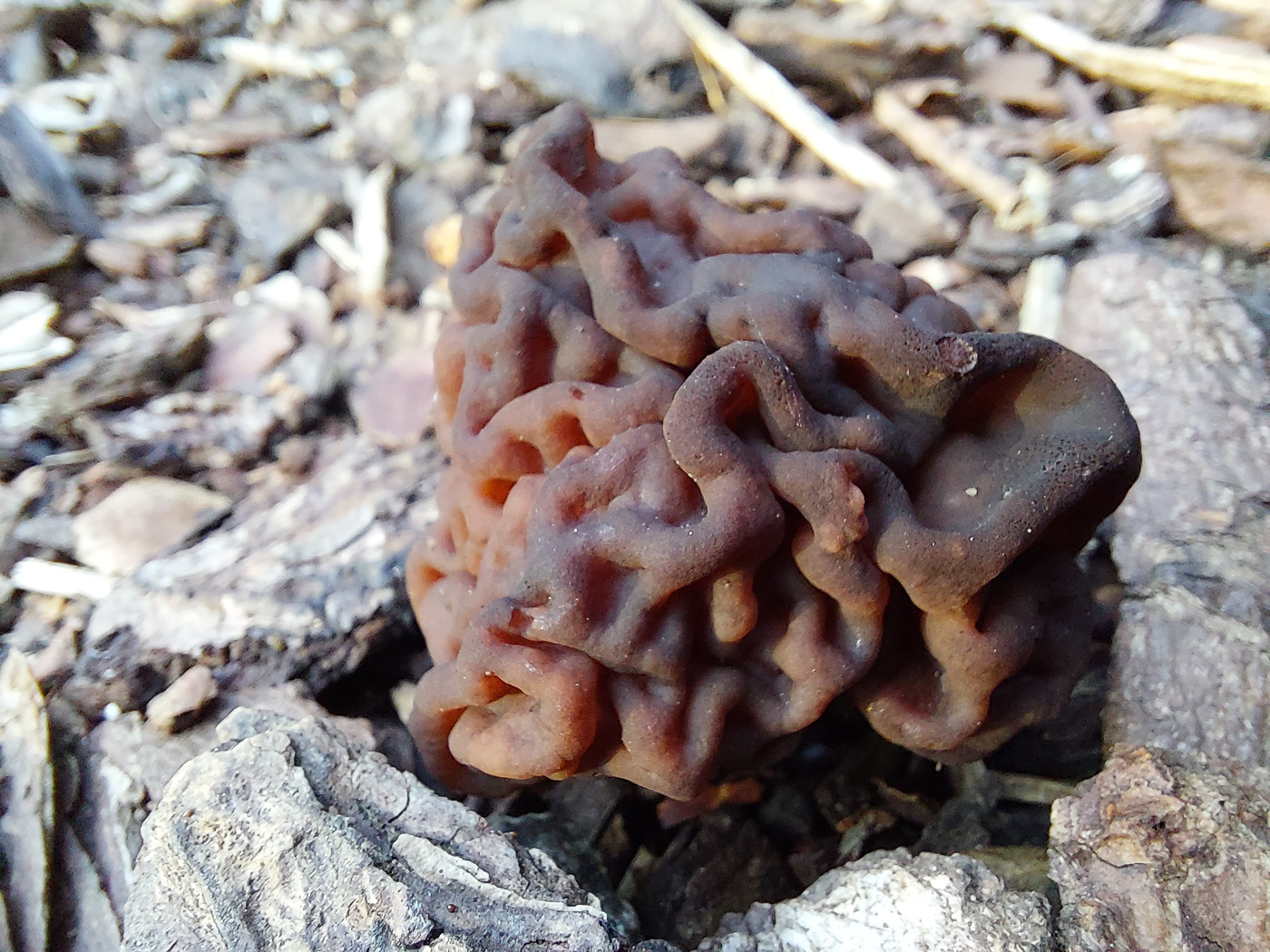  |
Gyromitra esculenta (False Morel) Mar 21, 2024. In Gerrards Cross Jesper Launder found two of these beauties in Pine mulch near some Pines. This distinctive springtime species is not related to the Morels though appearing somewhat similar - hence its English name - and unlike Morels should not be eaten despite its Latin species name indicating the opposite! Our only other records come from Wavendon Heath in the north of the county so this is a nice find and should also be present on Stoke Common amongst the Pines there. Mar 25, 2023. Justin Long paid a visit to Wavenden Heath where he's found this rare and interesting ascomycete before. This appears to be our only county site for the species which occurs in Spring in woody debris close to conifers. Despite its species name implying good edibility this is not the case and anyone on the lookout for Morels at this time should beware of collecting it in error the pot! This is another new entry for Finds where we now have photos of over 900 different species! |

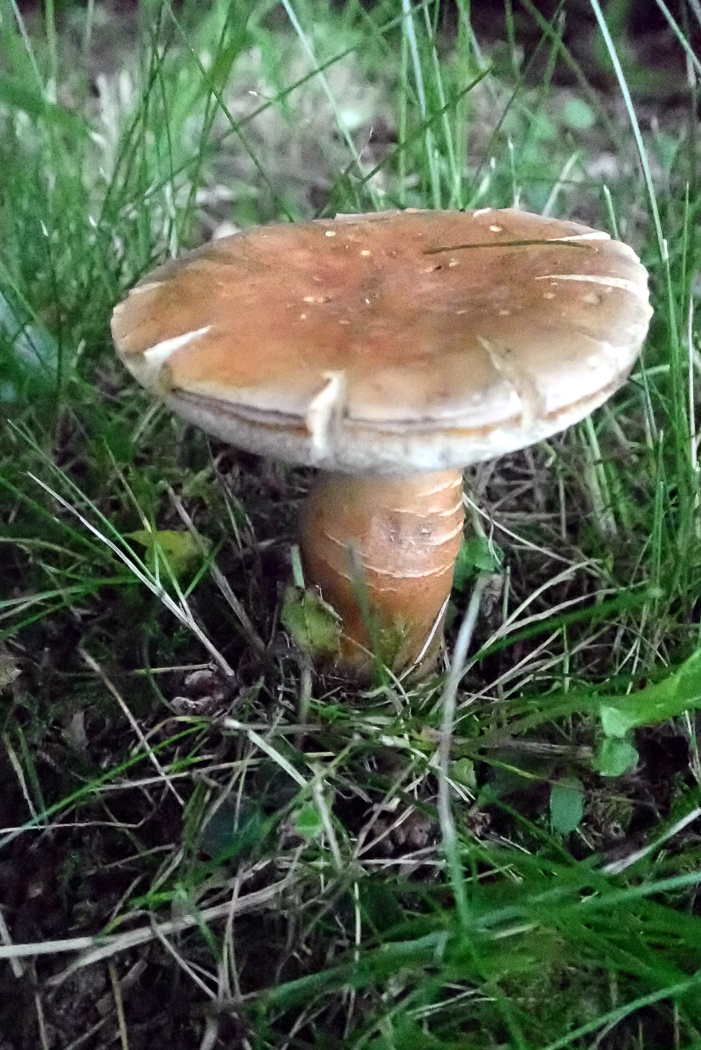
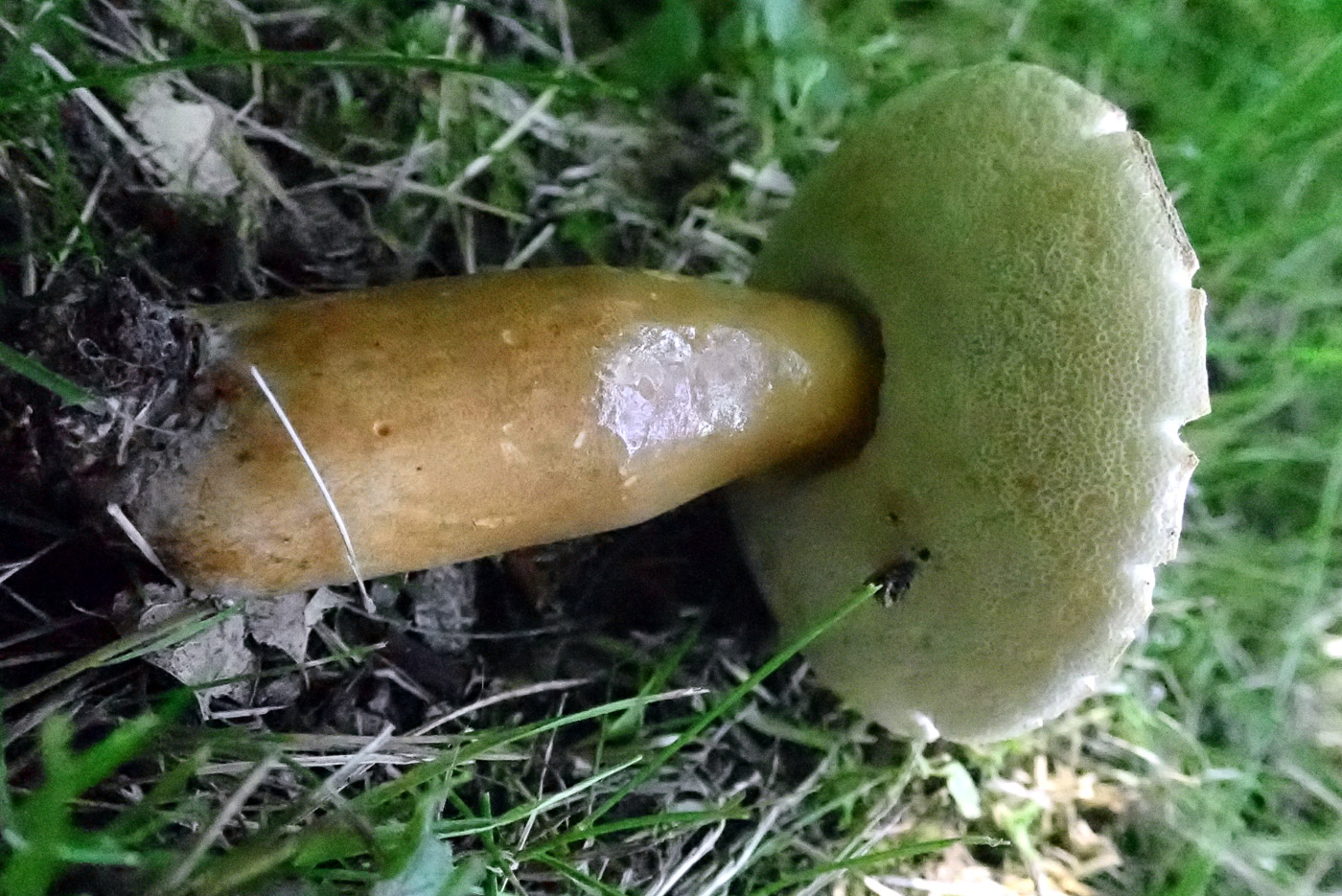
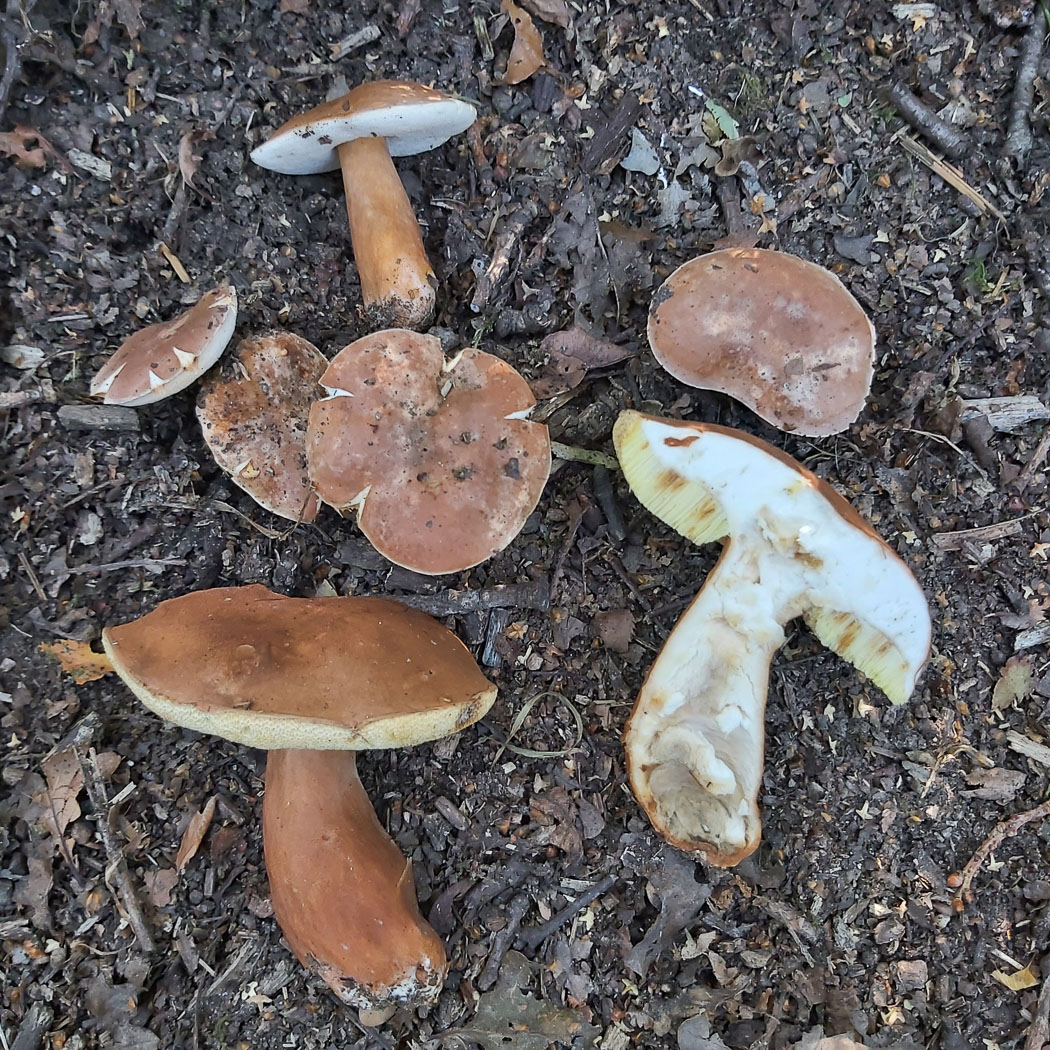
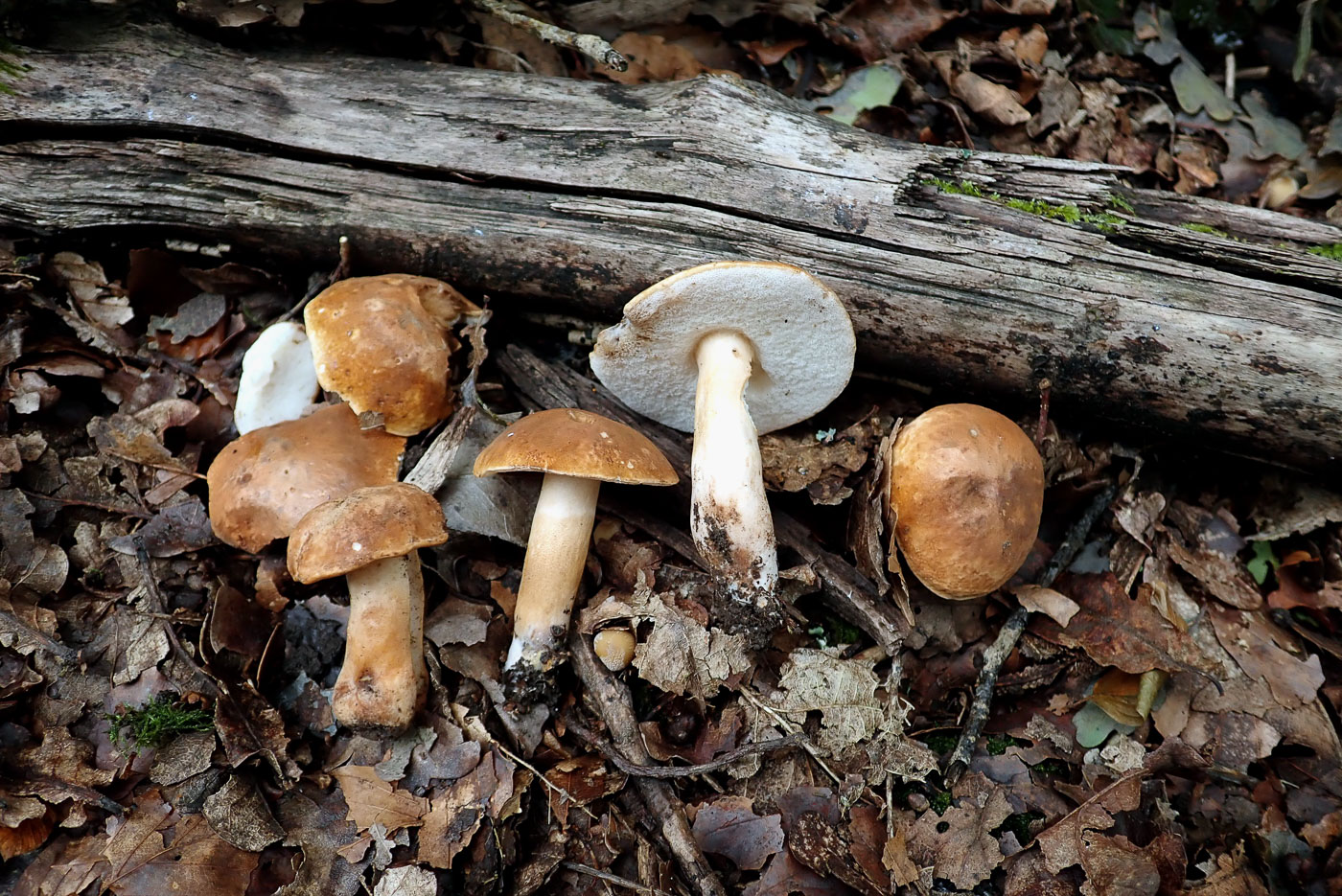
|
Gyroporus castaneus (Chestnut Bolete)
Oct 11, 2023. In Marlow Common under a large Oak Penny found a good collection of this attractive Bolete - an easy one to recognise from its chestnut brown cap and stem with contrasting white unstaining pores. It's not that common but Penny recalled find it in exactly this spot years ago. We've seen it a few time on our walks this season but this it the first image for Finds this year. Jul 16, 2021. At Stoke Poges Memorial Gardens in grass under Oak Penny found just a singleton of this occasional and distinctive species, an easy Bolete to recognise in the field having a chestnut cap and matching stem with contrasting off-white pores which don't turn blue when pressed. It occurs under mature Oak and Sweet Chestnut and develops hollows in the stem visible when sliced lengthways. (Penny tried this today but the whole stem was just a mass of maggots!) We have many records from Hodgemoor Woods and a few from elsewhere in the county but none previously found in July. Sep 20, 2020. Jesper Launder found this uncommon bolete under Oaks at Hodgemoor Wood where it occurs fairly regularly. It is one of the easiest boletes to recognise in the field, having a flattish, firm and smooth chestnut brown cap and a stem to match with pale whitish pores which don't blue when pressed. The stem tends to become hollow and if cut lengthways then shows cavities within. It occurs under Oak and Sweet Chestnut. Sep 4, 2020. An unusual bolete found by Penny Cullington at Naphill Common growing under Oak. The bright brown cap and stem with white pores which don't blue on bruising are good field characters. The only previous record for this site was back in 2001. |

